
UNCLASSIFIED
UNCLASSIFIED
Department of Defense
Fiscal Year (FY) 2024 Budget Estimates
March 2023
Defense Advanced Research Projects Agency
Defense-Wide Justification Book Volume 1 of 5
Research, Development, Test & Evaluation, Defense-Wide

UNCLASSIFIED
THIS PAGE INTENTIONALLY LEFT BLANK
UNCLASSIFIED

UNCLASSIFIED
Defense Advanced Research Projects Agency • Budget Estimates FY 2024 • RDT&E Program
UNCLASSIFIED
Table of Volumes
Defense Advanced Research Projects Agency............................................................................................................. Volume 1
Missile Defense Agency................................................................................................................................................... Volume 2
Office of the Secretary Of Defense................................................................................................................................. Volume 3
Creating Helpful Incentives To Produce Semi-Conductors (CHIPS) for America.......................................................Volume 3
Chemical and Biological Defense Program....................................................................................................................Volume 4
Defense Contract Audit Agency...................................................................................................................................... Volume 5
Defense Contract Management Agency......................................................................................................................... Volume 5
Defense Counterintelligence and Security Agency....................................................................................................... Volume 5
Defense Information Systems Agency............................................................................................................................Volume 5
Defense Logistics Agency................................................................................................................................................Volume 5
Defense Security Cooperation Agency...........................................................................................................................Volume 5
Defense Technical Information Center............................................................................................................................Volume 5
Defense Threat Reduction Agency..................................................................................................................................Volume 5
DoD Human Resources Activity...................................................................................................................................... Volume 5
Operational Test and Evaluation, Defense..................................................................................................................... Volume 5
Space Development Agency............................................................................................................................................ Volume 5
Volume 1 - i

UNCLASSIFIED
Defense Advanced Research Projects Agency • Budget Estimates FY 2024 • RDT&E Program
UNCLASSIFIED
The Joint Staff................................................................................................................................................................... Volume 5
United States Cyber Command....................................................................................................................................... Volume 5
United States Special Operations Command.................................................................................................................Volume 5
Washington Headquarters Services................................................................................................................................ Volume 5
Volume 1 - ii

UNCLASSIFIED
Defense Advanced Research Projects Agency • Budget Estimates FY 2024 • RDT&E Program
UNCLASSIFIED
Volume 1 Table of Contents
Comptroller Exhibit R-1.............................................................................................................................................. Volume 1 - v
Program Element Table of Contents (by Budget Activity then Line Item Number)...........................................Volume 1 - xvii
Program Element Table of Contents (Alphabetically by Program Element Title)...............................................Volume 1 - xix
Exhibit R-2s.................................................................................................................................................................. Volume 1 - 1
Volume 1 - iii

UNCLASSIFIED
THIS PAGE INTENTIONALLY LEFT BLANK
UNCLASSIFIED
Volume 1 - iv
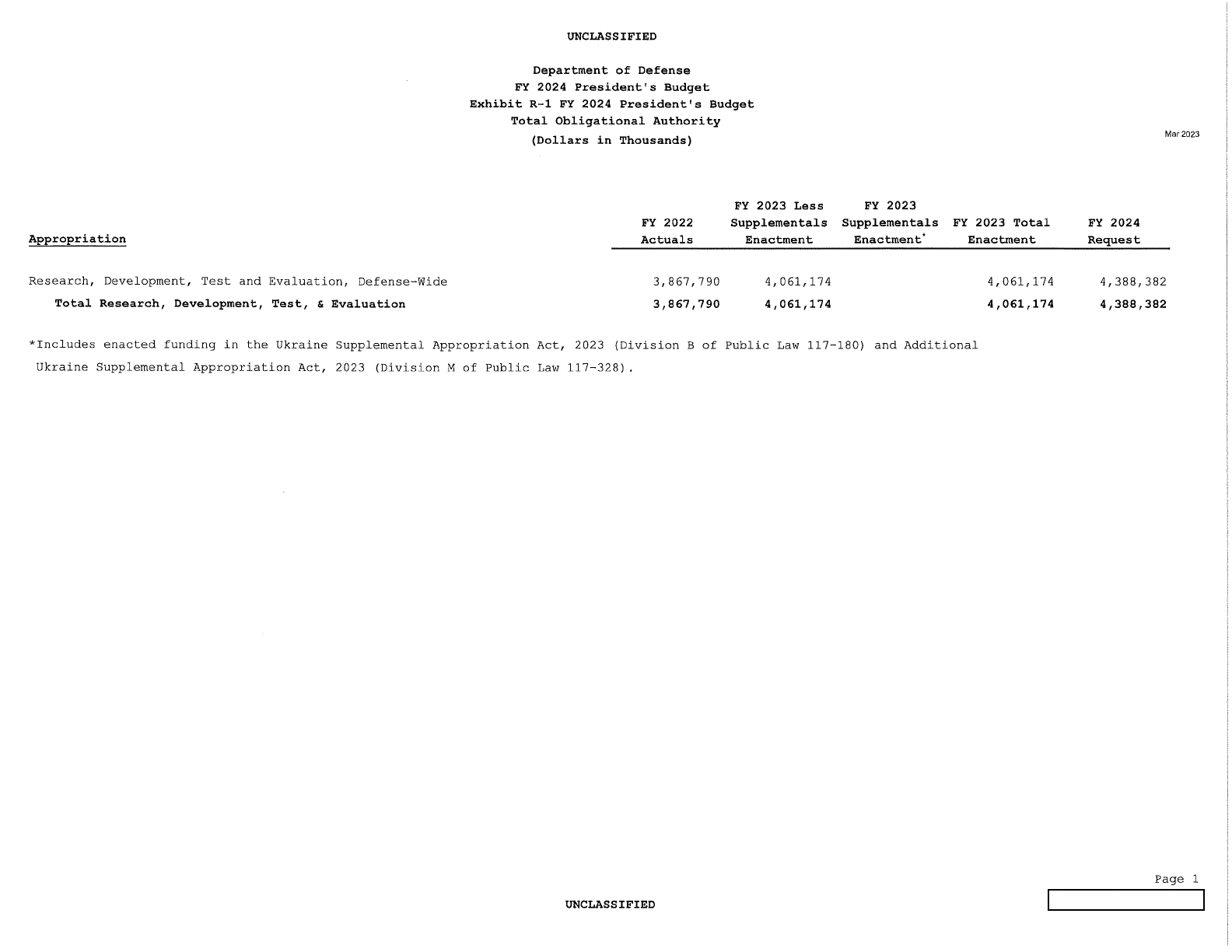
Volume 1 - v
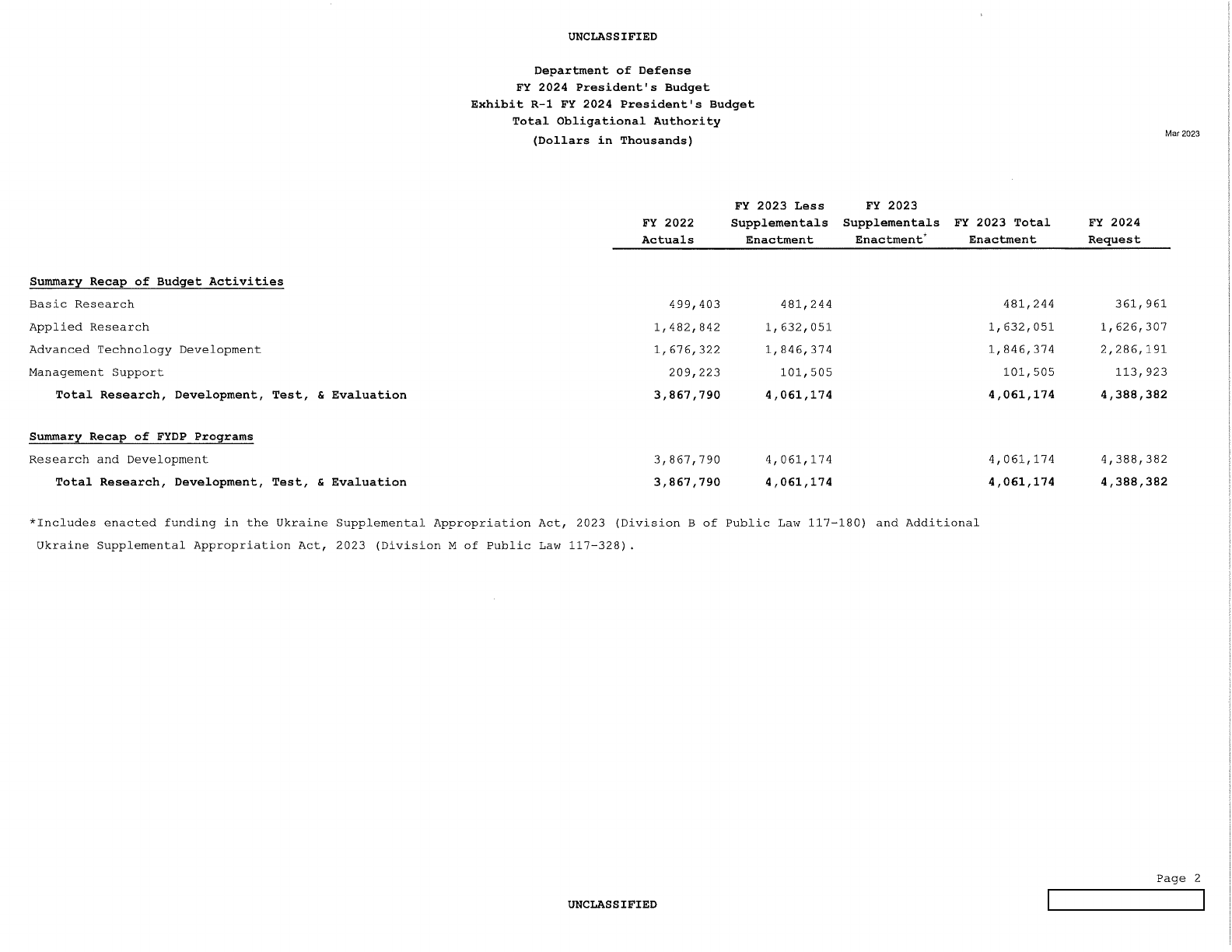
Volume 1 - vi
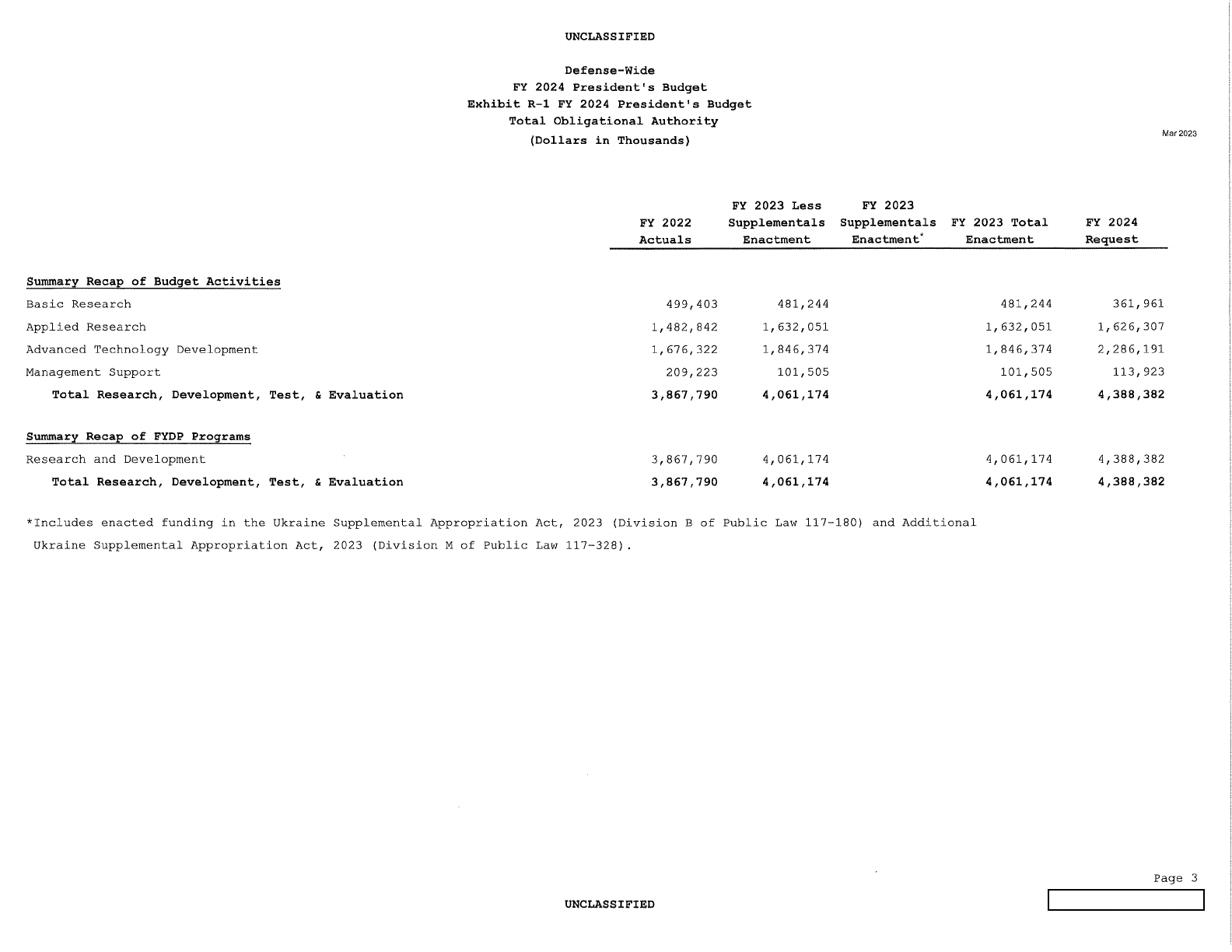
Volume 1 - vii
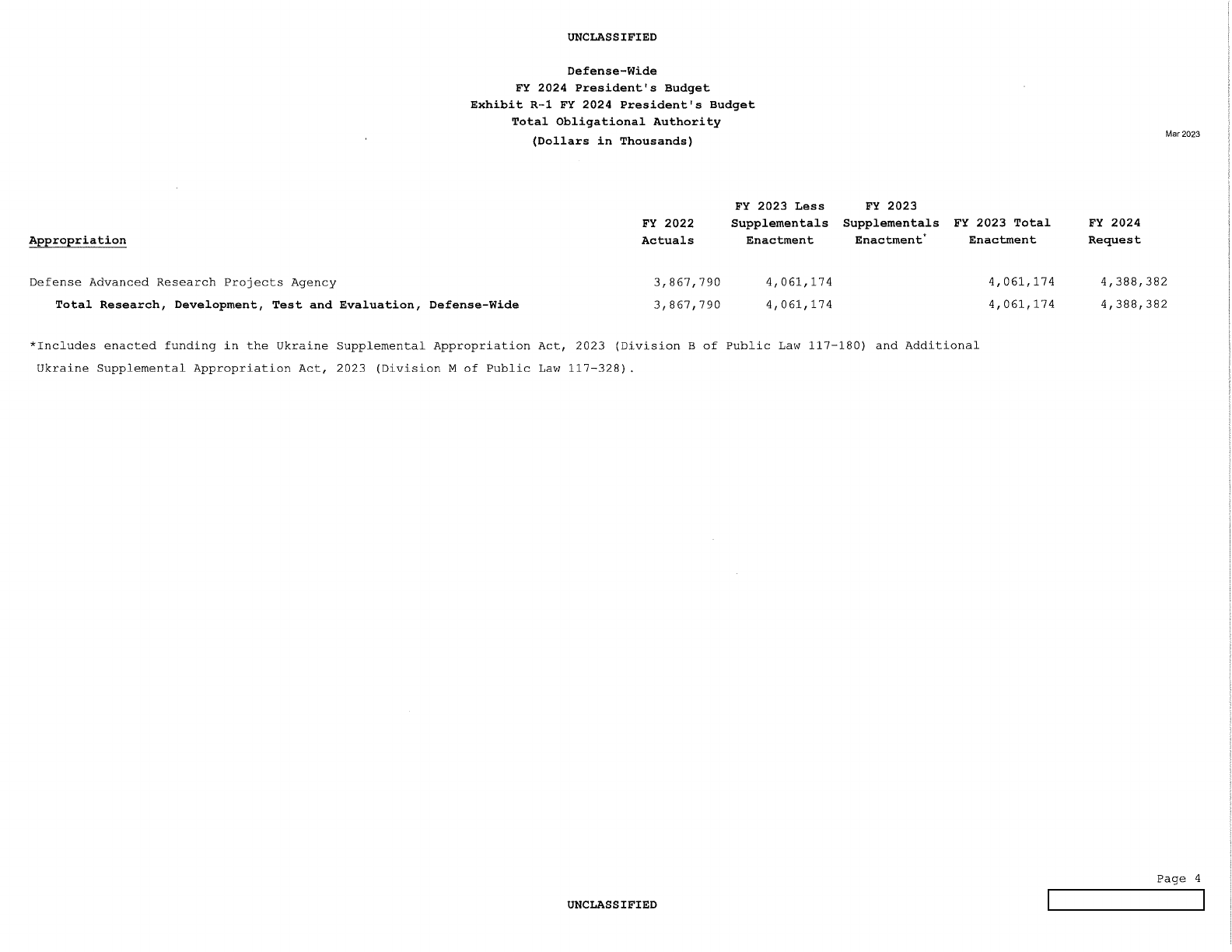
Volume 1 - viii
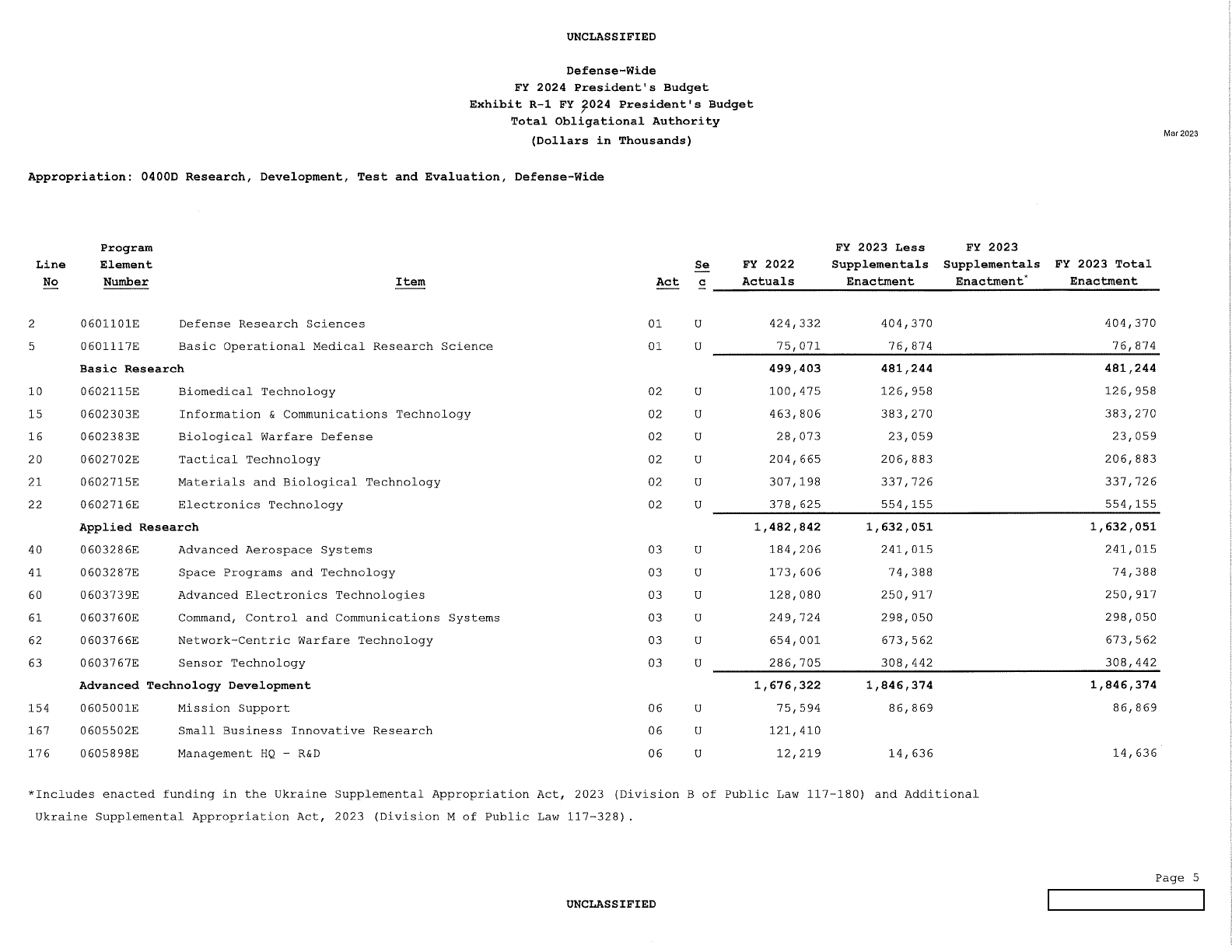
Volume 1 - ix
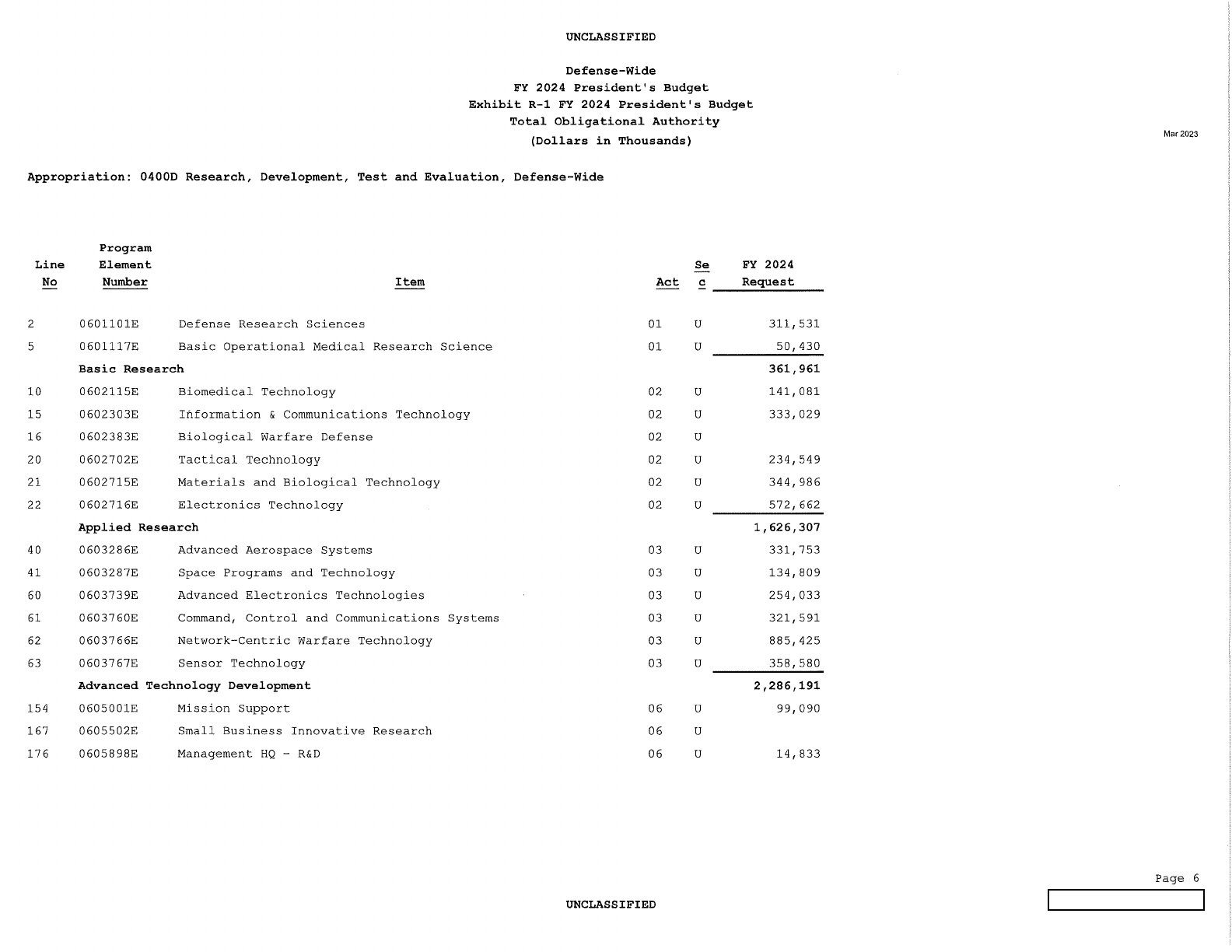
Volume 1 - x
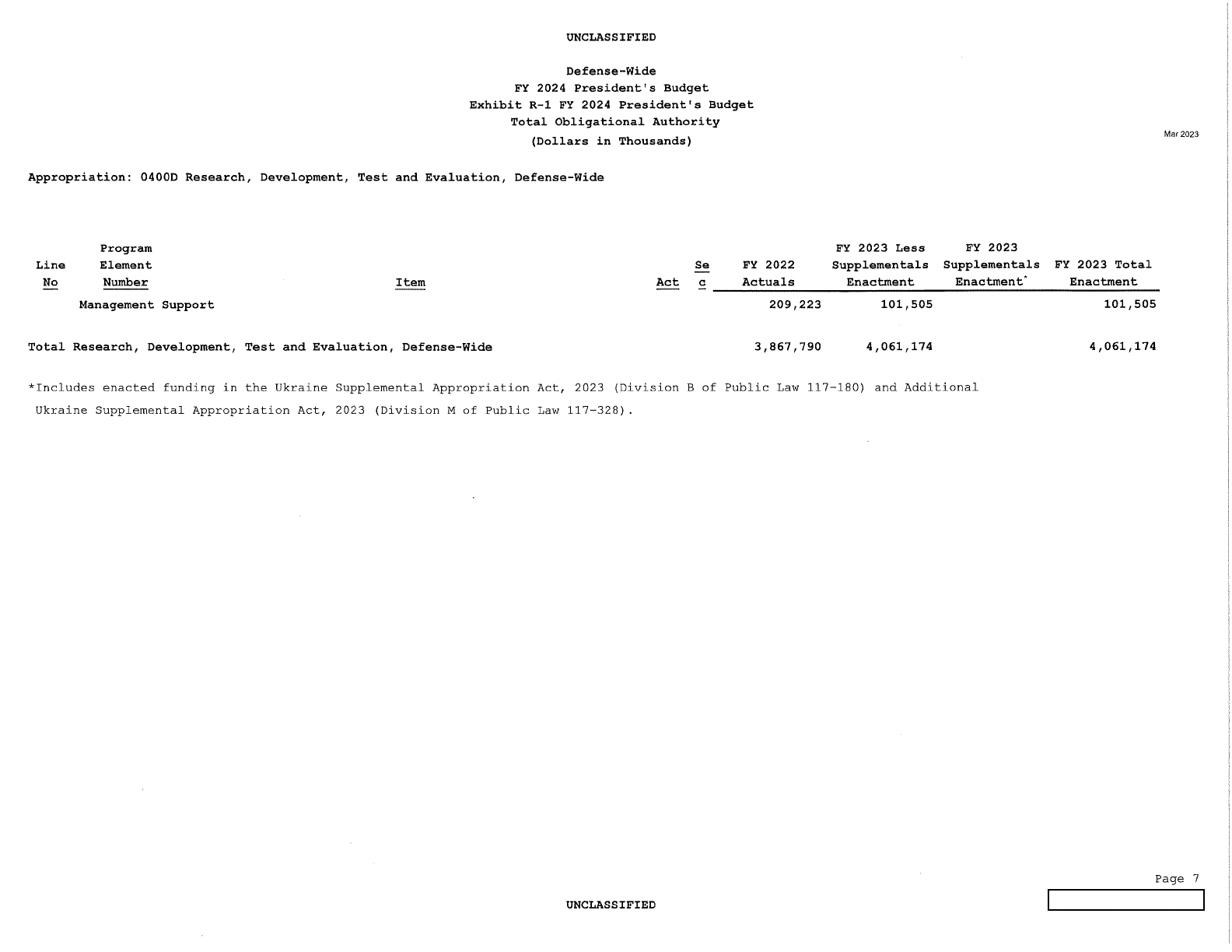
Volume 1 - xi
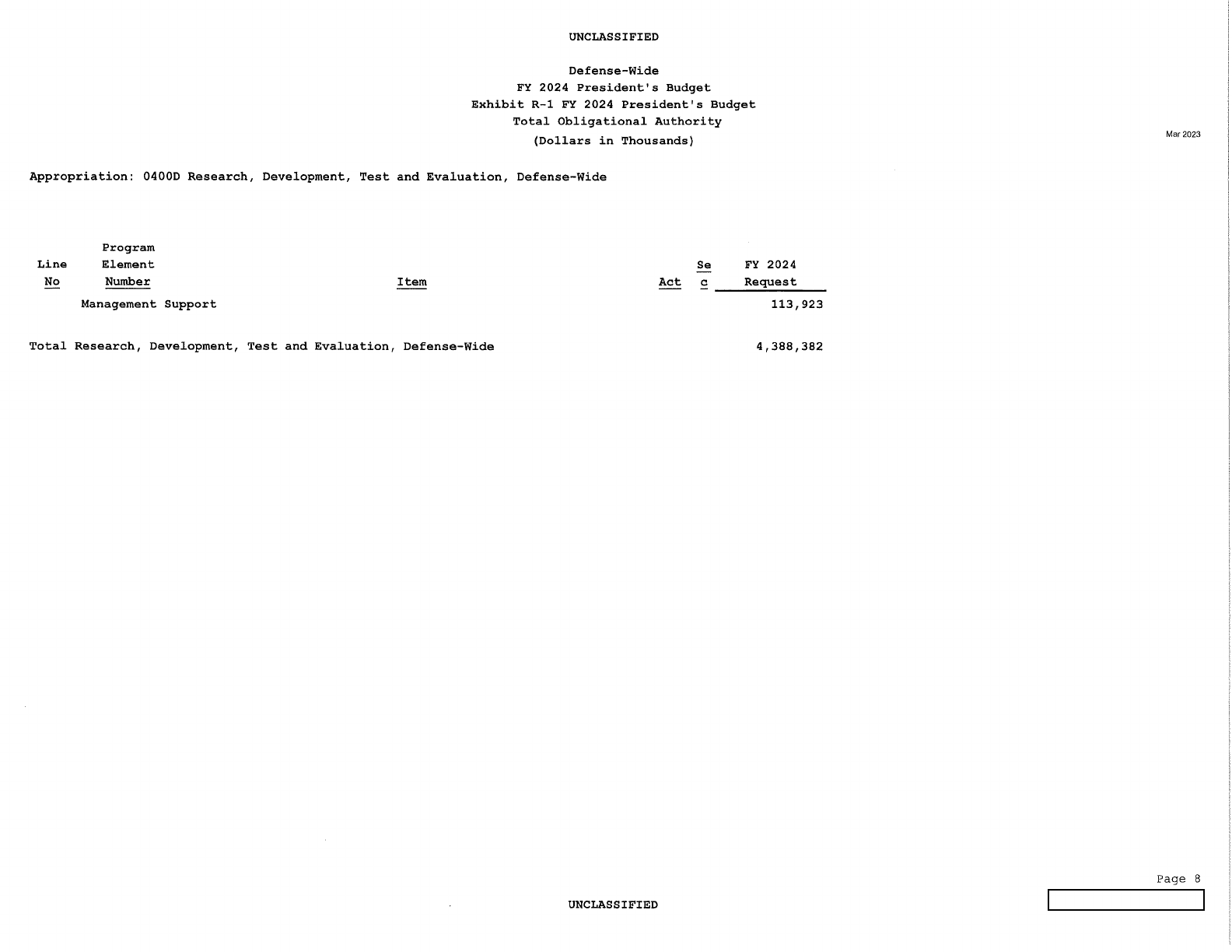
Volume 1 - xii
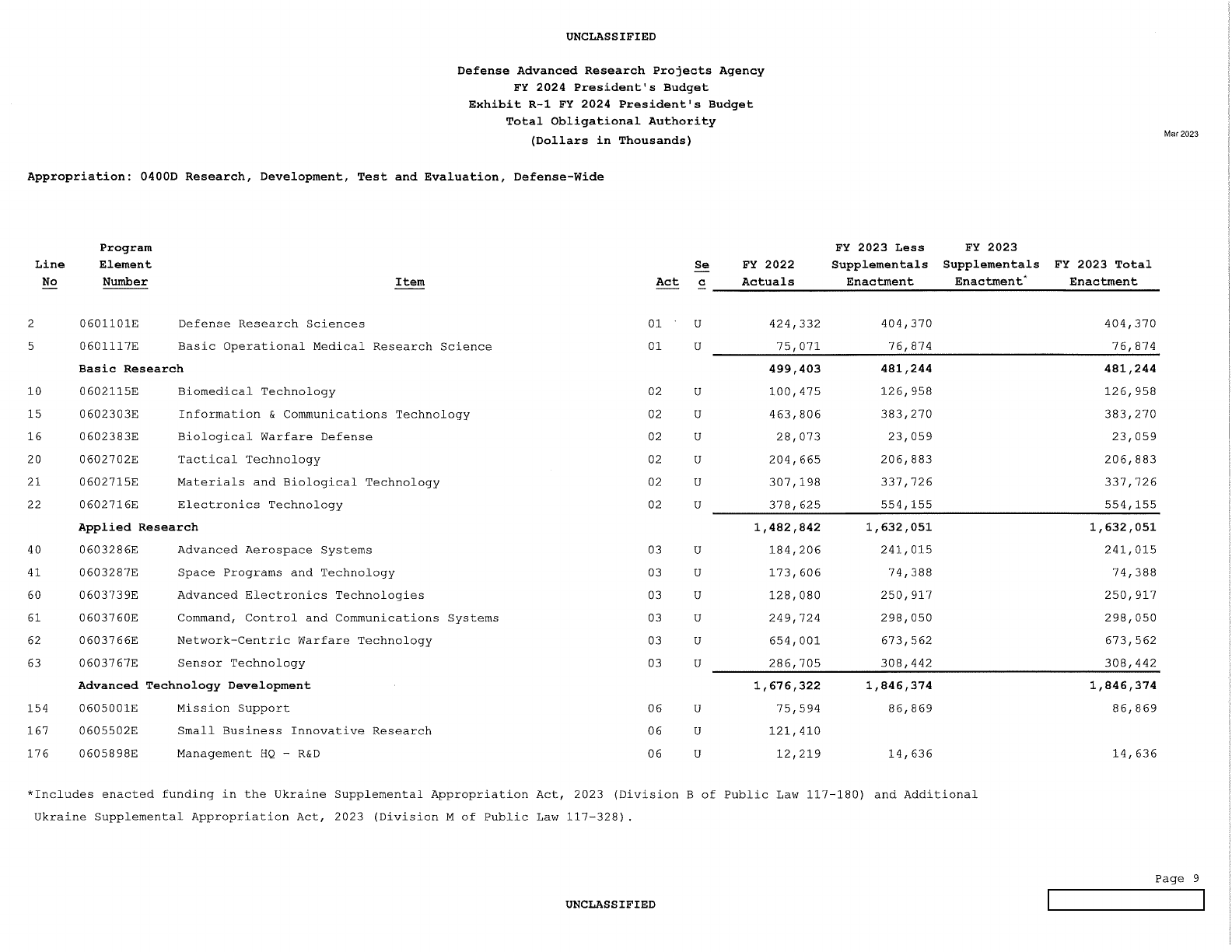
Volume 1 - xiii
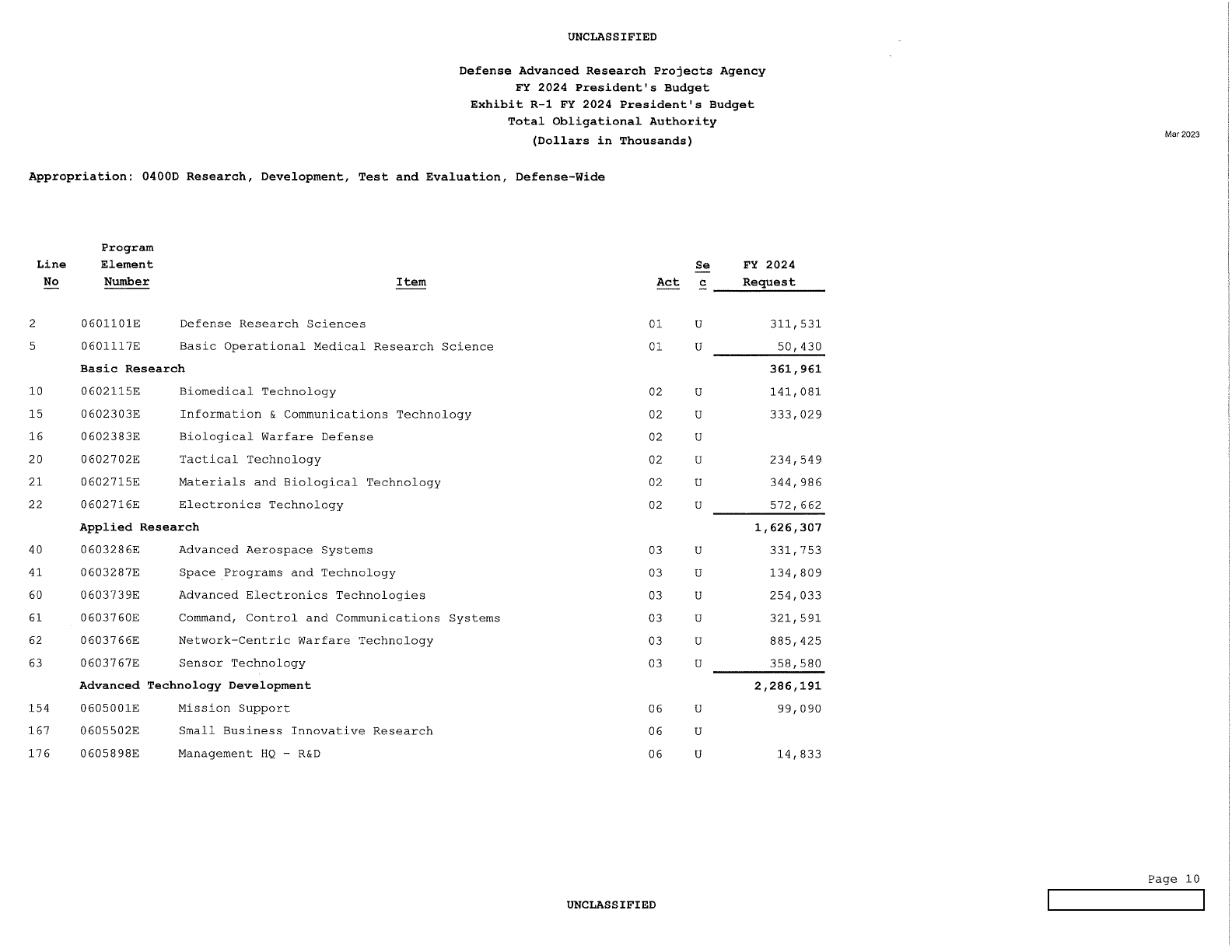
Volume 1 - xiv
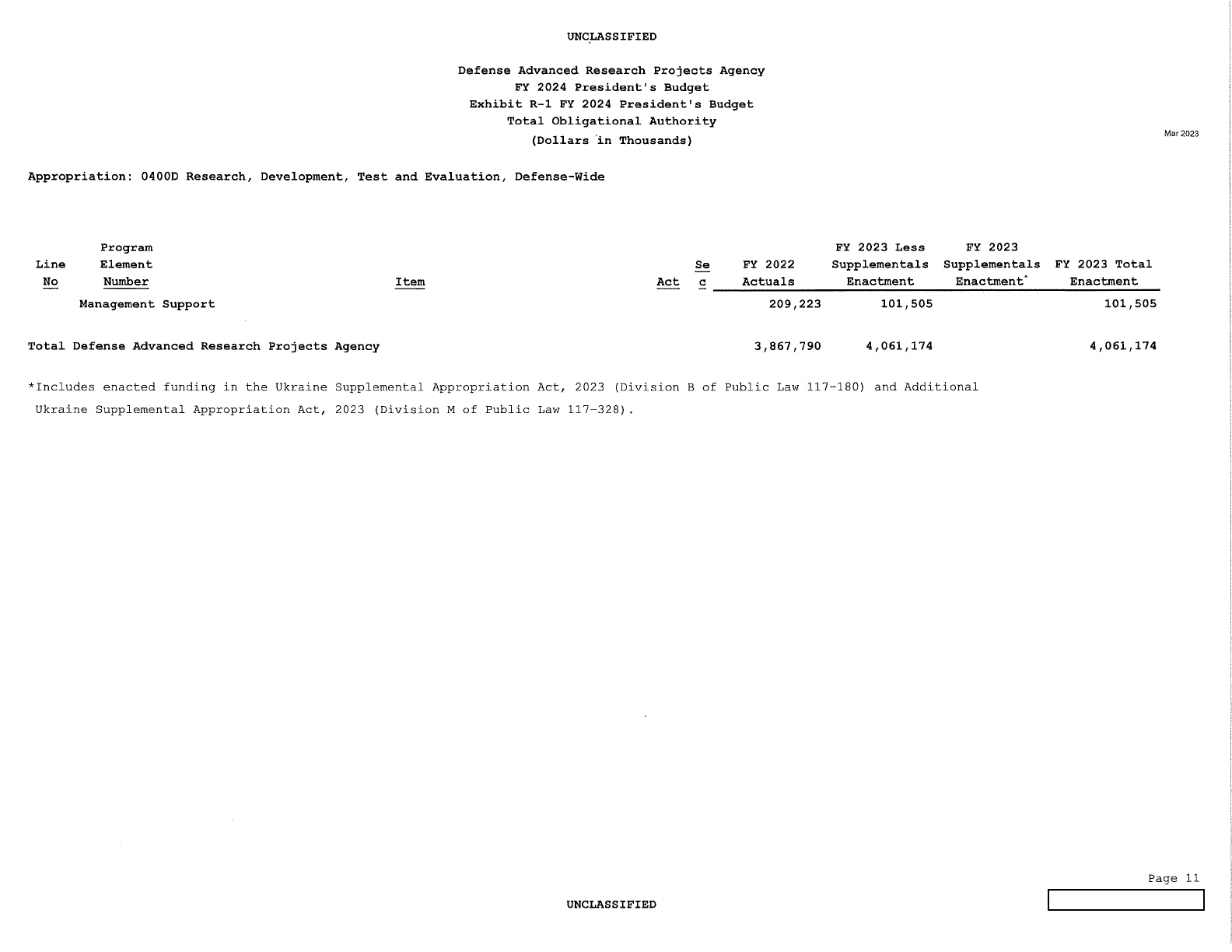
Volume 1 - xv
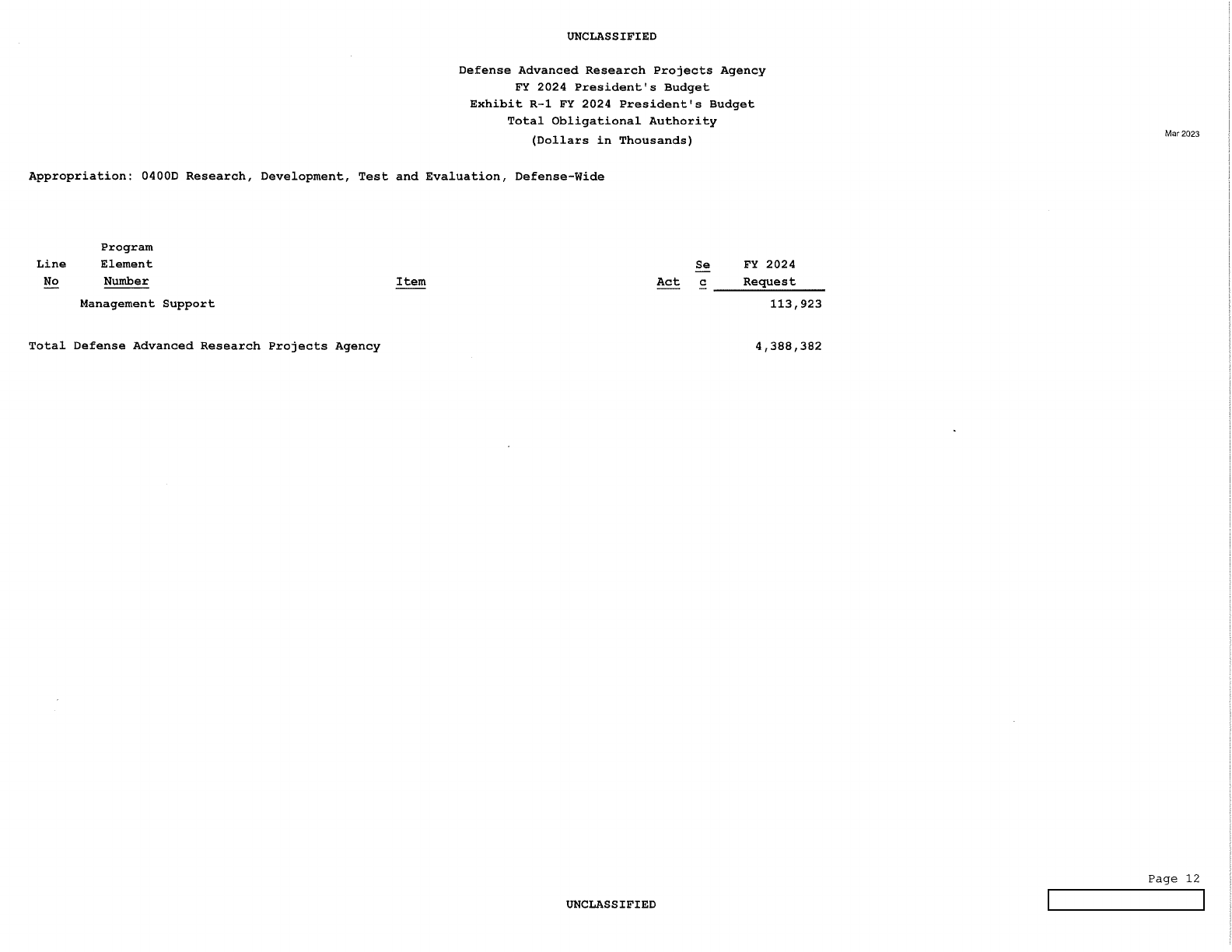
Volume 1 - xvi

UNCLASSIFIED
Defense Advanced Research Projects Agency • Budget Estimates FY 2024 • RDT&E Program
UNCLASSIFIED
Program Element Table of Contents (by Budget Activity then Line Item Number)
Appropriation 0400: Research, Development, Test & Evaluation, Defense-Wide
Line # Budget Activity Program Element Number Program Element Title Page
2 01 0601101E DEFENSE RESEARCH SCIENCES................................................................................... Volume 1 - 1
5 01 0601117E BASIC OPERATIONAL MEDICAL SCIENCE................................................................... Volume 1 - 35
Appropriation 0400: Research, Development, Test & Evaluation, Defense-Wide
Line # Budget Activity Program Element Number Program Element Title Page
10 02 0602115E BIOMEDICAL TECHNOLOGY.......................................................................................... Volume 1 - 43
15 02 0602303E INFORMATION & COMMUNICATIONS TECHNOLOGY..................................................Volume 1 - 53
16 02 0602383E BIOLOGICAL WARFARE DEFENSE................................................................................Volume 1 - 87
20 02 0602702E TACTICAL TECHNOLOGY............................................................................................... Volume 1 - 89
21 02 0602715E MATERIALS AND BIOLOGICAL TECHNOLOGY...........................................................Volume 1 - 113
22 02 0602716E ELECTRONICS TECHNOLOGY..................................................................................... Volume 1 - 135
Volume 1 - xvii

UNCLASSIFIED
Defense Advanced Research Projects Agency • Budget Estimates FY 2024 • RDT&E Program
UNCLASSIFIED
Appropriation 0400: Research, Development, Test & Evaluation, Defense-Wide
Line # Budget Activity Program Element Number Program Element Title Page
40 03 0603286E ADVANCED AEROSPACE SYSTEMS........................................................................... Volume 1 - 167
41 03 0603287E SPACE PROGRAMS AND TECHNOLOGY....................................................................Volume 1 - 177
60 03 0603739E ADVANCED ELECTRONICS TECHNOLOGIES.............................................................Volume 1 - 183
61 03 0603760E COMMAND, CONTROL AND COMMUNICATIONS SYSTEMS..................................... Volume 1 - 195
62 03 0603766E NETWORK-CENTRIC WARFARE TECHNOLOGY........................................................ Volume 1 - 209
63 03 0603767E SENSOR TECHNOLOGY............................................................................................... Volume 1 - 227
Appropriation 0400: Research, Development, Test & Evaluation, Defense-Wide
Line # Budget Activity Program Element Number Program Element Title Page
154 06 0605001E MISSION SUPPORT....................................................................................................... Volume 1 - 239
167 06 0605502E SMALL BUSINESS INNOVATION RESEARCH............................................................. Volume 1 - 241
176 06 0605898E MANAGEMENT HQ - R&D............................................................................................. Volume 1 - 245
Volume 1 - xviii

UNCLASSIFIED
Defense Advanced Research Projects Agency • Budget Estimates FY 2024 • RDT&E Program
UNCLASSIFIED
Program Element Table of Contents (Alphabetically by Program Element Title)
Program Element Title
Program Element
Number Line # BA Page
ADVANCED AEROSPACE SYSTEMS 0603286E 40 03...................................... Volume 1 - 167
ADVANCED ELECTRONICS TECHNOLOGIES 0603739E 60 03...................................... Volume 1 - 183
BASIC OPERATIONAL MEDICAL SCIENCE 0601117E 5 01........................................ Volume 1 - 35
BIOLOGICAL WARFARE DEFENSE 0602383E 16 02........................................ Volume 1 - 87
BIOMEDICAL TECHNOLOGY 0602115E 10 02........................................ Volume 1 - 43
COMMAND, CONTROL AND COMMUNICATIONS SYSTEMS 0603760E 61 03...................................... Volume 1 - 195
DEFENSE RESEARCH SCIENCES 0601101E 2 01..........................................Volume 1 - 1
ELECTRONICS TECHNOLOGY 0602716E 22 02...................................... Volume 1 - 135
INFORMATION & COMMUNICATIONS TECHNOLOGY 0602303E 15 02........................................ Volume 1 - 53
MANAGEMENT HQ - R&D 0605898E 176 06...................................... Volume 1 - 245
MATERIALS AND BIOLOGICAL TECHNOLOGY 0602715E 21 02...................................... Volume 1 - 113
MISSION SUPPORT 0605001E 154 06...................................... Volume 1 - 239
NETWORK-CENTRIC WARFARE TECHNOLOGY 0603766E 62 03...................................... Volume 1 - 209
SENSOR TECHNOLOGY 0603767E 63 03...................................... Volume 1 - 227
SMALL BUSINESS INNOVATION RESEARCH 0605502E 167 06...................................... Volume 1 - 241
SPACE PROGRAMS AND TECHNOLOGY 0603287E 41 03...................................... Volume 1 - 177
TACTICAL TECHNOLOGY 0602702E 20 02........................................ Volume 1 - 89
Volume 1 - xix

UNCLASSIFIED
THIS PAGE INTENTIONALLY LEFT BLANK
UNCLASSIFIED
Volume 1 - xx

UNCLASSIFIED
PE 0601101E: DEFENSE RESEARCH SCIENCES
UNCLASSIFIED
Defense Advanced Research Projects Agency Page 1 of 34 R-1 Line #2
Exhibit R-2, RDT&E Budget Item Justification: PB2024Defense Advanced Research Projects Agency
Date: March 2023
Appropriation/Budget Activity
0400: Research, Development, Test & Evaluation, Defense-Wide / BA 1: Basic
Research
R-1 Program Element (Number/Name)
PE 0601101E / DEFENSE RESEARCH SCIENCES
COST ($ in Millions)
Prior
Years FY 2022 FY 2023
FY 2024
Base
FY 2024
OCO
FY 2024
Total FY 2025 FY 2026 FY 2027 FY 2028
Cost To
Complete
Total
Cost
Total Program Element
- 424.332 404.370 311.531 - 311.531 358.978 396.651 429.334 462.789 - -
CCS-02: MATH AND
COMPUTER SCIENCES
- 273.345 231.916 179.433 - 179.433 202.697 244.776 265.979 294.634 - -
ES-01: ELECTRONIC
SCIENCES
- 12.926 17.645 12.854 - 12.854 22.678 30.682 32.410 37.410 - -
ES-02: BEYOND SCALING
SCIENCES
- 64.607 70.188 52.004 - 52.004 57.212 44.370 53.540 53.540 - -
MS-01: MATERIALS SCIENCES
- 41.860 53.356 62.934 - 62.934 69.018 69.200 69.782 69.582 - -
TRS-01: TRANSFORMATIVE
SCIENCES
- 31.594 31.265 4.306 - 4.306 7.373 7.623 7.623 7.623 - -
A. Mission Description and Budget Item Justification
The efforts described in this Program Element (PE) address the Basic Research associated with the Defense Research Sciences Program that provides the technical
foundation for long-term National Security enhancement through the discovery of new phenomena and the exploration of the potential of such phenomena for Defense
applications. This PE supports the scientific study and experimentation that is the basis for more advanced knowledge and understanding in information, electronic,
mathematical, computer, and materials sciences. This PE also supports innovation and robust transition planning in the technology cycle by working with entrepreneurs
to increase the likelihood that DARPA funded technologies take root in the U.S. and provide new capabilities for national defense.
The Math and Computer Sciences project supports scientific study and experimentation on new mathematical and computational algorithms, models, and mechanisms
in support of long-term national security objectives. Modern analytic and information technologies enable important new military capabilities and drive the productivity
gains essential to U.S. economic competitiveness. Conversely, new classes of threats, in particular threats that operate in or through the cyber and information domain,
put military systems, critical infrastructure, and the civilian economy at risk. This project aims to magnify these opportunities and mitigate these threats by leveraging
emerging mathematical and computational capabilities including artificial intelligence (AI), computational social science, machine learning and reasoning, data science,
quantum science, complex systems modeling and simulation, and theories of computation and programming. The basic research conducted under the Math and
Computer Sciences project will produce breakthroughs that enable new capabilities for national and homeland security.
The Electronic Sciences project is for basic exploration of electronic and optoelectronic devices, circuits, and processing concepts to meet the military's need for near
real-time information gathering, transmission, and processing. In seeking to continue the phenomenal advancement in microelectronics innovation that has characterized
the last few decades, the project will provide DoD with new, improved, or potentially revolutionary device options for accomplishing these critical functions. The resulting
technologies will help maintain knowledge of the enemy, communicate decisions based on that knowledge, and substantially improve the cost and performance of
military systems. Research areas include analog, mixed signal, and photonic circuitry for communications and other applications; alternative computer architectures;
Volume 1 - 1

UNCLASSIFIED
PE 0601101E: DEFENSE RESEARCH SCIENCES
UNCLASSIFIED
Defense Advanced Research Projects Agency Page 2 of 34 R-1 Line #2
Exhibit R-2, RDT&E Budget Item Justification: PB2024Defense Advanced Research Projects Agency
Date: March 2023
Appropriation/Budget Activity
0400: Research, Development, Test & Evaluation, Defense-Wide / BA 1: Basic
Research
R-1 Program Element (Number/Name)
PE 0601101E / DEFENSE RESEARCH SCIENCES
and magnetic components to reduce the size of Electromagnetic (EM) and sensing systems. Other research could support field-portable electronics with reduced power
requirements, and new approaches to nanometer-scale structures, molecules, and devices.
The Beyond Scaling Sciences project supports investigations into materials, devices, and architectures to provide continued improvements in electronics performance
with or without the benefit of Moore's Law (silicon transistor scaling). Within the next ten years, traditional scaling will start to encounter the fundamental physical limits
of silicon, requiring fresh approaches to new electronic systems. Over the short term, DoD will therefore need to unleash circuit specialization in order to maximize
the benefit of traditional silicon. Over the longer term, DoD and the nation will need to engage the computer, material, and mechanical sciences to explore electronics
improvements through new non-volatile memory devices that combine computation and memory, and new automated design tools using machine learning. Other
memory devices could also leverage an emerging understanding of the physics of magnetic states, electron spin properties, topological insulators, or phase-changing
materials. Additionally, new design and manufacturing advances for three-dimensional microelectronics integration will underpin continued performance improvements
as silicon transistor scaling plateaus. Beyond Scaling programs addressed fundamental exploration in each of these areas.
The Materials Sciences project provides the fundamental research that underpins the design, development, assembly, and optimization of advanced materials, devices,
and systems for DoD applications in areas such as robust diagnostics and therapeutics, novel energetic materials, and complex hybrid systems.
The Transformative Sciences project supports research and analysis that leverages converging technological forces and transformational trends in information-
intensive subareas of life sciences, data sciences, and manufacturing. Innovative technologies developed in this project will address multiple DoD challenges such as
identification of and adaptation to emerging threats, access to DoD relevant critical materials for manufacturing and warfighter readiness. Successful programs in this
project will integrate diverse disciplines and engineer complex biological systems to detect novel threat agents, accelerate warfighter injury recover, and develop new
platform materials and manufacturing processes.
B. Program Change Summary ($ in Millions)
FY 2022 FY 2023 FY 2024 Base FY 2024 OCO FY 2024 Total
Previous President's Budget 443.842 401.870 396.555 - 396.555
Current President's Budget 424.332 404.370 311.531 - 311.531
Total Adjustments -19.510 2.500 -85.024 - -85.024
• Congressional General Reductions 0.000 -10.500
• Congressional Directed Reductions 0.000 0.000
• Congressional Rescissions 0.000 0.000
• Congressional Adds 0.000 13.000
• Congressional Directed Transfers 0.000 0.000
• Reprogrammings -2.406 0.000
• SBIR/STTR Transfer -17.104 0.000
• TotalOtherAdjustments - - -85.024 - -85.024
Volume 1 - 2

UNCLASSIFIED
PE 0601101E: DEFENSE RESEARCH SCIENCES
UNCLASSIFIED
Defense Advanced Research Projects Agency Page 3 of 34 R-1 Line #2
Exhibit R-2, RDT&E Budget Item Justification: PB2024Defense Advanced Research Projects Agency
Date: March 2023
Appropriation/Budget Activity
0400: Research, Development, Test & Evaluation, Defense-Wide / BA 1: Basic
Research
R-1 Program Element (Number/Name)
PE 0601101E / DEFENSE RESEARCH SCIENCES
Congressional Add Details ($ in Millions, and Includes General Reductions)
FY 2022 FY 2023
Project: CCS-02: MATH AND COMPUTER SCIENCES
Congressional Add: AI Cyber Data Analytics (AI) - Congressional Add
10.000 -
Congressional Add: AI Cyber Data Analytics (Cyber) - Congressional Add
10.000 -
Congressional Add: AI Cyber Data Analytics (Data) - Congressional Add
10.000 -
Congressional Add: University Partnerships for AI Development - Congressional Add
- 9.000
Congressional Add: Advanced Predictive Analytics for Supply Chain Risk Management - Congressional Add
- 4.000
Congressional Add Subtotals for Project: CCS-02
30.000 13.000
Project: ES-02: BEYOND SCALING SCIENCES
Congressional Add: ERI 2.0 Congressional Add
20.000 -
Congressional Add Subtotals for Project: ES-02
20.000 -
Congressional Add Totals for all Projects
50.000 13.000
Change Summary Explanation
FY 2022: Decrease reflects SBIR/STTR transfer and reprogrammings.
FY 2023: Increase reflects Congressional adds for Advanced Predictive Analytics for Supply Chain Risk Management and University Partnerships for AI
Development offset by a Congressional reduction to Reduce Carryover.
FY 2024: Decrease reflects completion of several basic research programs in FY 2023 including Safe Documents (SafeDocs), Learning with Less Labeling
(LwLL), Ultra-Wide Bandgap Semiconductors (UWBG), Guaranteed Architectures for Physical Security (GAPS) and Biology for Security (BIOSEC) as well as a
shift from development and testing to demonstration and evaluation activities in the Foundational Artificial Intelligence (AI) Science, Guaranteeing AI Robustness
against Deception (GARD), Machine Common Sense (MCS) and Rapid Healing for Warfighter Injuries programs.
Volume 1 - 3

UNCLASSIFIED
PE 0601101E: DEFENSE RESEARCH SCIENCES
UNCLASSIFIED
Defense Advanced Research Projects Agency Page 4 of 34 R-1 Line #2
Exhibit R-2A, RDT&E Project Justification: PB2024Defense Advanced Research Projects Agency
Date: March 2023
Appropriation/Budget Activity
0400 / 1
R-1 Program Element (Number/Name)
PE 0601101E / DEFENSE RESEARCH SCI
ENCES
Project (Number/Name)
CCS-02 / MATH AND COMPUTER
SCIENCES
COST ($ in Millions)
Prior
Years FY 2022 FY 2023
FY 2024
Base
FY 2024
OCO
FY 2024
Total FY 2025 FY 2026 FY 2027 FY 2028
Cost To
Complete
Total
Cost
CCS-02: MATH AND
COMPUTER SCIENCES
- 273.345 231.916 179.433 - 179.433 202.697 244.776 265.979 294.634 - -
A. Mission Description and Budget Item Justification
The Math and Computer Sciences project supports scientific study and experimentation on new mathematical and computational algorithms, models, and mechanisms
in support of long-term national security objectives. Modern analytic and information technologies enable important new military capabilities and drive the productivity
gains essential to U.S. economic competitiveness. Conversely, new classes of threats, in particular threats that operate in or through the cyber and information domain,
put military systems, critical infrastructure, and the civilian economy at risk. This project aims to magnify these opportunities and mitigate these threats by leveraging
emerging mathematical and computational capabilities including artificial intelligence (AI), computational social science, machine learning and reasoning, data science,
quantum science, complex systems modeling and simulation, and theories of computation and programming. The basic research conducted under the Math and
Computer Sciences project will produce breakthroughs that enable new capabilities for national and homeland security.
B. Accomplishments/Planned Programs ($ in Millions)
FY 2022 FY 2023 FY 2024
Title: Foundational Artificial Intelligence (AI) Science
Description: The Foundational Artificial Intelligence (AI) Science thrust is developing a fundamental scientific basis for
understanding and quantifying performance expectations and limits of AI technologies. Current AI technologies are challenged
in handling uncertainty and incompleteness of training protocols and data. This has prevented the successful integration of AI
technology into many transformative DoD applications. To address these limitations, the Foundational AI Science thrust will focus
on the development of new learning architectures that enhance AI systems' ability to handle uncertainty, reduce vulnerabilities,
and improve robustness for DoD AI systems. One focus area of this thrust is the ability to detect and accommodate novelty - i.e.,
violations of implicit or explicit assumptions - in AI applications. Another focus area is the development of a model framework for
quantifying performance expectations and limits of AI systems as trusted human partners and collaborators. A third focus area is
the development of new tools and methodologies that enable AI approaches for accelerated scientific discovery. The technology
advances achieved under the Foundational AI Science thrust will ultimately remove technical barriers to exploiting AI technologies
for scientific discovery, human-AI collaboration, accommodating novelties, and other DoD relevant applications.
FY 2023 Plans:
- Demonstrate fully autonomous, closed-loop feedback between experimental platforms and AI models to facilitate process
optimization and inverse molecular design.
- Identify molecular design domains of greatest applicability for developed AI models and data representations.
- Design baseline computational approaches for quantifying the alignment of an algorithmic decision maker with a reference
group of human decision makers.
69.550 37.692 28.771
Volume 1 - 4

UNCLASSIFIED
PE 0601101E: DEFENSE RESEARCH SCIENCES
UNCLASSIFIED
Defense Advanced Research Projects Agency Page 5 of 34 R-1 Line #2
Exhibit R-2A, RDT&E Project Justification: PB2024Defense Advanced Research Projects Agency
Date: March 2023
Appropriation/Budget Activity
0400 / 1
R-1 Program Element (Number/Name)
PE 0601101E / DEFENSE RESEARCH SCI
ENCES
Project (Number/Name)
CCS-02 / MATH AND COMPUTER
SCIENCES
B. Accomplishments/Planned Programs ($ in Millions)
FY 2022 FY 2023 FY 2024
- Extend novelty generators and novelty-robust AI techniques to create and identify rapidly and respond appropriately to new
environments, goals, and events.
- Demonstrate and evaluate novelty generators and novelty-robust AI techniques compared to non-robust methods performing on
known tasks incorporating new rules, goals, and events.
- Develop techniques for quantifying the uniqueness and stability of functions learned over manifolds, and formulate approaches
for using these techniques to address issues related to adversarial, explainable, and trustworthy AI.
- Further refine hybrid artificial intelligence (AI) models of climate processes, and explore their advantages over conventional
models for rapid scenario analysis as well as for global and regional predictions.
- Apply and evaluate model performance against simulated climate intervention approaches.
- Develop AI negotiation agents for multi-party interaction environments that include untrustworthy partnerships and dynamic
goals.
- Extend signature approaches for information deception tools in text, audio, and image generation to support additional machine
learning attack attribution capabilities.
- Identify scenarios, collect and analyze historical online and offline influence campaign pathways, and learn pathway models and
patterns.
- Develop foundational AI science, advance the state of the art in AI engineering, and create human-machine teaming
approaches that support trustworthy AI for mission- and safety-critical domains.
FY 2024 Plans:
- Evaluate algorithmic decision maker's ability to align with a reference group of human decision makers, and validate baseline
computational approaches for quantifying the measurement of alignment and the impact of alignment on trust of algorithmic
decision makers.
- Continue to develop foundational AI science, advance the state of the art in AI engineering, and create human-machine teaming
approaches that support trustworthy AI for mission- and safety-critical domains.
FY 2023 to FY 2024 Increase/Decrease Statement:
The FY 2024 decrease reflects a shift in focus from technology demonstrations to algorithm evaluation for follow-on efforts.
Title: Young Faculty Award (YFA)
Description: The goal of the Young Faculty Award (YFA) program is to encourage junior faculty at universities and their
equivalent at non-profit science and technology research institutions to participate in sponsored research programs that will
augment capabilities for future defense systems. This program focuses on cutting-edge technologies for greatly enhancing
microsystems technologies, biological technologies, and defense sciences. The long-term goal for this program is to develop the
next generation of scientists, engineers, and mathematicians in key disciplines who will focus a significant portion of their careers
on DoD and national security issues. The aim is for YFA recipients to receive deep interactions with DARPA program managers,
17.000 17.000 17.000
Volume 1 - 5

UNCLASSIFIED
PE 0601101E: DEFENSE RESEARCH SCIENCES
UNCLASSIFIED
Defense Advanced Research Projects Agency Page 6 of 34 R-1 Line #2
Exhibit R-2A, RDT&E Project Justification: PB2024Defense Advanced Research Projects Agency
Date: March 2023
Appropriation/Budget Activity
0400 / 1
R-1 Program Element (Number/Name)
PE 0601101E / DEFENSE RESEARCH SCI
ENCES
Project (Number/Name)
CCS-02 / MATH AND COMPUTER
SCIENCES
B. Accomplishments/Planned Programs ($ in Millions)
FY 2022 FY 2023 FY 2024
programs, performers, and the user community. Current activities include research in fifteen topic areas spanning from Machine
Learning and Many Body Physics, to Wideband Transmitter-Antenna Interfaces and Multi-Scale Models of Infectious Disease
Dynamics. A key aspect of the YFA program is DARPA-sponsored military visits; all YFA Principal Investigators are expected to
participate in one or more military site visits to help them better understand DoD needs.
FY 2023 Plans:
- Award new FY 2023 grants for new two-year research efforts across YFA topic areas, establishing a new set of appropriate
scientific approaches to solve current DoD challenges.
- Continue FY 2022 research on new concepts for microsystem, biological, strategic, and tactical technologies; information
innovation; and defense sciences by exercising second year funding and by providing continued mentorship by program
managers.
- Award Director's Fellowships for top FY 2021 participants to refine technology further and align to DoD needs.
FY 2024 Plans:
- Award FY 2024 grants for new two-year research efforts across YFA topic areas, establishing a new set of scientific approaches
to solve current DoD challenges.
- Continue FY 2023 research on new concepts for microsystem, biological, strategic, and tactical technologies; information
innovation; and defense sciences by exercising second year funding and by providing continued mentorship by program
managers.
- Award Director's Fellowships for top FY 2022 participants to refine technology further and align to DoD needs.
Title: Alternative Computing
Description: The Alternative Computing thrust is exploring and developing new computational primitives for modeling and
simulating complex systems. Despite decades of rapid advancement in electronic computing, there remain important national
security relevant challenge problems that do not lend themselves to achieving tractable solutions under size, weight, and
power (SWaP) constrained conditions. For example, simulation of complex nonlinear phenomena such as turbulence, fluid
flow, and plasma dynamics can be challenging even using currently available high-power computing resources. Building on
technologies developed under the Advanced Tools for Modeling and Simulation thrust, also in this PE/Project, the goal of the
Alternative Computing thrust is to develop novel architectural and algorithmic approaches to enable fast and accurate simulations
for problems that are practically intractable using electronic computers. Approaches considered under this thrust include the
following: (1) analog computing substrates for efficiently simulating systems governed by complex non-linear phenomena; (2)
multi-functional spin-based devices for scalable, efficient neuromorphic computing; (3) computing approaches that exploit the
capacity of nonlinear systems to simulate nonlinear dynamical systems; and (4) quantum enabled optimization of complex
systems.
28.000 28.000 20.000
Volume 1 - 6

UNCLASSIFIED
PE 0601101E: DEFENSE RESEARCH SCIENCES
UNCLASSIFIED
Defense Advanced Research Projects Agency Page 7 of 34 R-1 Line #2
Exhibit R-2A, RDT&E Project Justification: PB2024Defense Advanced Research Projects Agency
Date: March 2023
Appropriation/Budget Activity
0400 / 1
R-1 Program Element (Number/Name)
PE 0601101E / DEFENSE RESEARCH SCI
ENCES
Project (Number/Name)
CCS-02 / MATH AND COMPUTER
SCIENCES
B. Accomplishments/Planned Programs ($ in Millions)
FY 2022 FY 2023 FY 2024
FY 2023 Plans:
- Experimentally demonstrate quantum optimization algorithms for combinatorial optimization problems for larger problem sizes.
- Perform benchmarking of quantum optimization algorithms against the best classical method.
- Select specific problems to focus on when developing hardware agnostic benchmarks for quantum information processing
performance, prioritizing problems with the potential for transformational impact.
- Identify core enabling mathematical operations underlying each of the selected hardware agnostic quantum benchmarks.
- Establish initial hardware resource estimates for quantum computers that would be needed to solve specific problems with the
potential for transformational impact.
- Field and evaluate a closed-loop, verified, geographically dispersed network with operational nodes at multiple sites.
FY 2024 Plans:
- Create predictive and scalable benchmarks for quantifying the utility of quantum computers.
- Calculate the hardware resources necessary to achieve key utility thresholds using quantum computers to solve
transformational problems.
- Perform benchmarking of quantum optimization algorithms against the best classical method to demonstrate and quantify
quantum advantage.
FY 2023 to FY 2024 Increase/Decrease Statement:
The FY 2024 decrease reflects a shift in focus from design and fabrication to validation and verification.
Title: Perceptually-Enabled Task Guidance (PTG)
Description: The Perceptually-Enabled Task Guidance (PTG) program is developing artificial intelligence (AI) technology that
guides users in the performance of a wide range of cognitively challenging physical tasks. PTG leverages recent advances in
machine perception, automated reasoning, and augmented reality. The program connects perception to reasoning and reasoning
to augmented reality (AR) so as to create personalized, real-time feedback and contextualized assistance. To connect perception
and reasoning, PTG develops AI technologies for (1) perceptual grounding, to create a shared vocabulary for perception and
reasoning, and (2) perceptual attention, to select important information from large volumes of perceptual data. To connect
reasoning with AR, PTG develops AI technologies for (3) knowledge transfer, to derive task models from instructions intended
for humans, and (4) user modeling, to determine if, when, and how to best convey task information to the user. Together, PTG
technologies will lay the foundation for perceptually-enabled guidance and a qualitatively new type of AI device that enables
mechanics, medics, and other military specialists to perform physical tasks within and beyond their skillsets with greater accuracy
and efficiency.
FY 2023 Plans:
12.234 20.300 17.500
Volume 1 - 7

UNCLASSIFIED
PE 0601101E: DEFENSE RESEARCH SCIENCES
UNCLASSIFIED
Defense Advanced Research Projects Agency Page 8 of 34 R-1 Line #2
Exhibit R-2A, RDT&E Project Justification: PB2024Defense Advanced Research Projects Agency
Date: March 2023
Appropriation/Budget Activity
0400 / 1
R-1 Program Element (Number/Name)
PE 0601101E / DEFENSE RESEARCH SCI
ENCES
Project (Number/Name)
CCS-02 / MATH AND COMPUTER
SCIENCES
B. Accomplishments/Planned Programs ($ in Millions)
FY 2022 FY 2023 FY 2024
- Develop approaches for perceptual grounding as required for perceptually-enabled intelligent agents capable of learning how to
recognize task-related terms for objects, actions, and settings.
- Devise new techniques for combining visual and audio examples scraped from multimedia knowledge sources and transferring
them into task models, and for inferring model visual and audio properties from the properties of related model classes.
- Develop knowledge transfer approaches for taking the knowledge in human-oriented task instructions such as checklists,
procedure manuals, and training materials and representing that knowledge in machine-processable form.
- Initiate integration of perceptual grounding, perceptual attention, knowledge transfer, and user modeling technologies and
demonstrate and evaluate prototypes on a surrogate task use case and on a military task defined in collaboration with military
stakeholders.
FY 2024 Plans:
- Integrate perceptual, reasoning, and augmented reality technology with technologies for knowledge transfer, perceptual
grounding, and perceptual attention.
- Develop demonstration scenarios for interactive technology and military user communication in the context of answering
questions while the technology monitors users performing tasks.
- Develop technologies to address user modeling of individuals performing tasks in multiple military use cases.
- Perform assessments of task completion and user acceptance of the integrated technologies in the completion of tasks from
application domains defined in collaboration with military stakeholders.
FY 2023 to FY 2024 Increase/Decrease Statement:
The FY 2024 decrease reflects ramping down of development and integration of perceptually-enabled intelligent agents, and
emphasis shifting to demonstration and assessment of the technology on military task use cases.
Title: Knowledge Management at Scale
Description: The Knowledge Management at Scale thrust is focused on the development of knowledge management tools that
can efficiently capture, analyze and reason with expertise, experience and data. The technology development under this thrust
will help address a critical need for assimilating and preserving critical national security knowledge and expertise that is currently
being lost due to attrition and other factors. Specific objectives include the following: 1) effective, trustworthy, and easily accepted
approaches for domain agnostic knowledge acquisition at scale; 2) capabilities to identify correlations or hidden factors relating
to knowledge acquired from different sources; and 3) techniques for incorporating domain models and other data sources for
more extensive reasoning-based applications. Example approaches towards achieving these objectives include identifying and
demonstrating robust knowledge acquisition tools, exploiting Artificial Intelligence (AI) techniques to establish a framework for
knowledge analysis and causal reasoning, and developing automation tools that effectively elicit and impart acquired knowledge
via user friendly interfaces.
12.061 17.300 16.000
Volume 1 - 8

UNCLASSIFIED
PE 0601101E: DEFENSE RESEARCH SCIENCES
UNCLASSIFIED
Defense Advanced Research Projects Agency Page 9 of 34 R-1 Line #2
Exhibit R-2A, RDT&E Project Justification: PB2024Defense Advanced Research Projects Agency
Date: March 2023
Appropriation/Budget Activity
0400 / 1
R-1 Program Element (Number/Name)
PE 0601101E / DEFENSE RESEARCH SCI
ENCES
Project (Number/Name)
CCS-02 / MATH AND COMPUTER
SCIENCES
B. Accomplishments/Planned Programs ($ in Millions)
FY 2022 FY 2023 FY 2024
FY 2023 Plans:
- Extend novel AI tools capable of recognizing and representing implicit and explicit context of human tasks to scale to large
organizations and diverse tasks.
- Incorporate audio/video as input modalities into novel AI-based knowledge management tools.
FY 2024 Plans:
- Evaluate novel AI knowledge management tools in common domain of potential military interest.
- Incorporate personal sensor input modality into novel AI tools.
- Extend novel AI knowledge management tools to scale to individuals in organizations.
FY 2023 to FY 2024 Increase/Decrease Statement:
The FY 2024 decrease reflects a shift from technology development to explorations of application spaces and evaluation.
Title: Advanced Tools for Modeling and Simulation
Description: The Advanced Tools for Modeling and Simulation thrust is developing foundational mathematical, computational,
and multi-physics theories, approaches, and tools to better represent, quantify, and model complex DoD systems from multimodal
data analysis through part/system design and fabrication. One focus area of this thrust is developing a unified mathematical
framework to enable better visualization and analysis of massive, complex data sets. Rigorous mathematical theories are also
being developed to address uncertainty in the modeling and design of complex multi-scale physical and engineering systems,
incorporating capabilities to handle noisy data and model uncertainty that are well beyond the scope of current capabilities. Other
work in this thrust focuses on developing the mathematical and computational tools required to generate and better manage the
enormous complexity of design, ultimately allowing designers to more easily discover non-intuitive (yet realizable) designs that
fully leverage new materials and advanced manufacturing approaches now available. Outcomes from this thrust will improve the
speed and accuracy of modeling and simulation, as well as enable management of complexity across DoD devices, parts, and
systems. Another focus area of this thrust is multi-physics models for predicting behavior and non-intuitive failure pathways for
complex, dynamic physical systems.
FY 2023 Plans:
- Investigate new mathematics and computation tools to enable the discovery of transformations that make complex physical/
engineering problems more tractable.
FY 2024 Plans:
- Investigate the development of machine learning to generate transformations from large data sets and determine the limits of
such transformations.
3.000 3.000 5.000
Volume 1 - 9

UNCLASSIFIED
PE 0601101E: DEFENSE RESEARCH SCIENCES
UNCLASSIFIED
Defense Advanced Research Projects Agency Page 10 of 34 R-1 Line #2
Exhibit R-2A, RDT&E Project Justification: PB2024Defense Advanced Research Projects Agency
Date: March 2023
Appropriation/Budget Activity
0400 / 1
R-1 Program Element (Number/Name)
PE 0601101E / DEFENSE RESEARCH SCI
ENCES
Project (Number/Name)
CCS-02 / MATH AND COMPUTER
SCIENCES
B. Accomplishments/Planned Programs ($ in Millions)
FY 2022 FY 2023 FY 2024
- Explore combining machine learning with existing symbol manipulation approaches to develop digital engineering and scientific
computing tools for complex designs.
FY 2023 to FY 2024 Increase/Decrease Statement:
The FY 2024 increase reflects a shift from initial technology investigations to new tool exploration and development.
Title: Artificial Social Intelligence for Successful Teams (ASIST)
Description: The Artificial Social Intelligence for Successful Teams (ASIST) program is developing intelligent software agents that
can create shared mental models to enable effective teaming with humans. Theory of mind and the ability to create shared mental
models are key elements of human social intelligence. Together these capabilities enable human collaboration and teamwork at
all scales, whether the setting is a playing field or a military mission. The ASIST program aims to develop technologies to enable
machines to exhibit similar capabilities for collaboration and teamwork with humans, capabilities which can be termed artificial
social intelligence. These include the capability to infer the goals and situational knowledge of human partners, to predict what
human partners will need, and to formulate context-aware actions having high value to team outcomes. The ASIST program is
developing proof-of-concept software agents that demonstrate a machine theory of mind and the capability to participate with
humans in an effective team by representing and helping to maintain shared mental models. ASIST aims to provide the basis for
machines that can participate effectively with humans on tasks where teamwork is required.
FY 2023 Plans:
- Develop and demonstrate computational agents that understand human social intelligence in a team context, can predict what is
needed by partners, and intervene as an effective coach.
- Develop agents able to handle perturbations in task, team, mission, and environment as needed for fast adaptation and team
resilience.
- Conduct experiments in multiple virtual testbed environments to demonstrate generalization across domains and relevance to
DoD missions.
FY 2024 Plans:
- Demonstrate socially intelligent agents capable of partnering with complex teams comprising individuals with specialized skills in
support of a selected use case.
- Provide open access to datasets, testbed, and agent prototypes for continued development by human-machine teaming
researchers and transition technology to military labs for experimentation on additional use cases.
FY 2023 to FY 2024 Increase/Decrease Statement:
15.000 12.800 11.000
Volume 1 - 10

UNCLASSIFIED
PE 0601101E: DEFENSE RESEARCH SCIENCES
UNCLASSIFIED
Defense Advanced Research Projects Agency Page 11 of 34 R-1 Line #2
Exhibit R-2A, RDT&E Project Justification: PB2024Defense Advanced Research Projects Agency
Date: March 2023
Appropriation/Budget Activity
0400 / 1
R-1 Program Element (Number/Name)
PE 0601101E / DEFENSE RESEARCH SCI
ENCES
Project (Number/Name)
CCS-02 / MATH AND COMPUTER
SCIENCES
B. Accomplishments/Planned Programs ($ in Millions)
FY 2022 FY 2023 FY 2024
The FY 2024 decrease reflects ramping down of work to develop agents with artificial social intelligence and focus shifting to
technology demonstration and transition.
Title: Guaranteeing AI Robustness against Deception (GARD)
Description: The Guaranteeing AI Robustness against Deception (GARD) program is developing techniques to defend against
deception and other adversarial attacks on machine learning (ML) and artificial intelligence (AI) systems. GARD addresses the
need to defend against deception attacks, whereby an adversary inputs engineered data into an ML system intending to cause
the system to produce erroneous results. Deception attacks can enable adversaries to take control of autonomous systems, alter
conclusions of ML-based decision support applications, and compromise tools and systems that rely on ML and AI technologies.
Current techniques for defending ML and AI have proven brittle due to a focus on individual attack methods and weak methods for
testing and evaluation. The GARD program is developing techniques that address the current limitations of defenses and produce
ML and AI systems suitable for use in adversarial environments. The GARD program is also developing theory regarding potential
fundamental limits on achievable ML robustness.
FY 2023 Plans:
- Develop and validate measures of adversary costs and enhance AI/ML defense methods to impose asymmetric costs on the
adversary.
- Develop human-on-the-loop defense techniques that enable the early identification of digital evasion attacks on AI-enabled
systems.
- Demonstrate model training methods that reduce AI/ML vulnerability to data poisoning.
- Extend evaluation framework to support simulation environments and test physically plausible threat models of interest to
potential DoD and U.S. Government transition partners.
FY 2024 Plans:
- Extend adversarial AI techniques to federated learning systems.
- Extend evaluation framework to support assessment of AI/ML defenses against multi-modal imaging attacks, audio speech
recognition poisoning attacks, and federated learning poisoning attacks.
- Demonstrate and transition AI/ML defense technology to DoD and U.S. Government transition partners.
FY 2023 to FY 2024 Increase/Decrease Statement:
The FY 2024 decrease reflects ramping down of work to develop techniques to defend against attacks on AI/ML systems and
focus shifting to demonstration and transition of technology.
17.500 21.500 12.000
Title: Human Social Systems 15.000 14.000 7.000
Volume 1 - 11

UNCLASSIFIED
PE 0601101E: DEFENSE RESEARCH SCIENCES
UNCLASSIFIED
Defense Advanced Research Projects Agency Page 12 of 34 R-1 Line #2
Exhibit R-2A, RDT&E Project Justification: PB2024Defense Advanced Research Projects Agency
Date: March 2023
Appropriation/Budget Activity
0400 / 1
R-1 Program Element (Number/Name)
PE 0601101E / DEFENSE RESEARCH SCI
ENCES
Project (Number/Name)
CCS-02 / MATH AND COMPUTER
SCIENCES
B. Accomplishments/Planned Programs ($ in Millions)
FY 2022 FY 2023 FY 2024
Description: The social and behavioral sciences provide essential theories and models that can enable deeper understanding
of human social/behavioral systems relevant to national security such as mental health, humanitarian aid, disaster relief, and
stability support missions, as well as tactical, operational, strategic, and policy-level decision-making across the DoD. However,
current limitations to the speed, scalability, and reproducibility of empirical social science research continue to hamper its practical
use by the DoD. Additionally, current social behavioral models often fail to accurately interpret social behaviors because they do
not sufficiently capture diversity of context. The Human Social Systems thrust will address these limitations by focusing on the
following technical challenges: (1) developing and validating new methods, models and tools to perform rigorous, reproducible
experimental research at scales necessary to understand emergent properties of human social/behavioral systems; (2) identifying
methods to better characterize and quantify properties, dynamics, and behaviors of different social/behavioral systems to
enable better and more confident forecasting of changes in such systems, particularly when under stress; (3) developing
an understanding of the complex effect of context and incorporating these effects into models; and (4) developing strategic
forecasting and operational decision aiding capabilities that account for local contextual and cultural factors to assess the likely
effectiveness of and/or responses to actions within an Area of Operations. This research thrust will provide DoD with new, reliable
strategies to better understand and respond to social/behavioral system issues at multiple scales (from small group to cities and/or
regions) and will significantly improve DoD stabilization, deterrence, and/or gray zone mission outcomes.
FY 2023 Plans:
- Test the accuracy of causal models of regional socioeconomic systems derived from collective local understandings for
predicting event outcomes compared to the current state of practice.
- Evaluate the efficiency of methodologies for developing causal models of regional socioeconomic systems derived from
collective local understanding compared to the current state of practice.
- Continue to demonstrate that mechanisms developed for engaging local populations are compatible with local infrastructure and
generate sufficient quality data to generate predictive causal models.
- Explore development of a new mechanistic understanding of mental health for transdiagnostic treatment.
FY 2024 Plans:
- Test the accuracy of causal models of regional socioeconomic systems derived from collective local understandings for
predicting event outcomes compared to the current state of practice in new locations to test generalizability of methods.
- Evaluate the efficiency of methodologies for developing causal models of regional socioeconomic systems derived from
collective local understanding compared to the current state of practice in new locations to test generalizability of methods.
- Continue to demonstrate that mechanisms developed for engaging local populations are compatible with local infrastructure and
generate sufficient quality data to generate predictive causal models in new locations to test generalizability of methods.
FY 2023 to FY 2024 Increase/Decrease Statement:
Volume 1 - 12

UNCLASSIFIED
PE 0601101E: DEFENSE RESEARCH SCIENCES
UNCLASSIFIED
Defense Advanced Research Projects Agency Page 13 of 34 R-1 Line #2
Exhibit R-2A, RDT&E Project Justification: PB2024Defense Advanced Research Projects Agency
Date: March 2023
Appropriation/Budget Activity
0400 / 1
R-1 Program Element (Number/Name)
PE 0601101E / DEFENSE RESEARCH SCI
ENCES
Project (Number/Name)
CCS-02 / MATH AND COMPUTER
SCIENCES
B. Accomplishments/Planned Programs ($ in Millions)
FY 2022 FY 2023 FY 2024
The FY 2024 decrease reflects a shift from development to demonstration.
Title: Machine Common Sense (MCS)
Description: The Machine Common Sense (MCS) program is exploring approaches to enable common-sense reasoning by
machines. Recent advances in machine learning have resulted in new artificial intelligence (AI) capabilities in areas such as
image recognition, task-focused natural language processing, and strategy games such as Chess, Go, and Poker. In all of these
application domains, the machine reasoning is narrow and highly specialized, and the machine must be carefully trained or
programmed for every situation. This program addresses the challenge of general machine reasoning on par with common sense
human cognition. MCS is developing computational models that mimic core systems of human cognitive development that are
grounded in perceptual, motor, and memory modalities; a simulated interaction and learning environment to support machine
manipulation of grounded concept models; and common-sense knowledge repositories to support AI system development. AI
systems that are capable of human-like reasoning will be able to behave more appropriately in unforeseen situations and to learn
with reduced requirements for training data.
FY 2023 Plans:
- Develop agent models focused on understanding other agent intentions and demonstrate intentional agent reasoning.
- Augment cognitive models with expanded experience learning capabilities and enable self-evaluation modes for scenarios that
require agent sensemaking, human-machine collaboration, and knowledge transfer.
- Create evaluation techniques for generative question-answering for common-sense reasoning tasks and extend commonsense
reasoning capabilities to utilize cross-modal (text, image, video) data to improve performance.
- Extend the simulation environment to support modeling and performance assessment for environments with complexity, noise,
and novelty.
FY 2024 Plans:
- Use the simulation environment to assess capability on benchmark common sense challenge problem suites in environments
exhibiting high complexity, noise, and novelty.
FY 2023 to FY 2024 Increase/Decrease Statement:
The FY 2024 decrease reflects ramping down of efforts to develop machine common sense technologies and the simulation
environment, and focus shifting to evaluation on benchmark common sense challenge problem suites.
18.000 19.000 6.962
Title: Pipelined Reasoning of Verifiers Enabling Robust Systems (PROVERS)
Description: The Pipelined Reasoning of Verifiers Enabling Robust Systems (PROVERS) program is creating scalable
mathematically based technologies, tools, and practices to achieve continuous reasoning about complex systems that can
support software development pipelines. These mathematically based techniques, or formal methods, enable rigorous modeling,
- 8.000 17.200
Volume 1 - 13

UNCLASSIFIED
PE 0601101E: DEFENSE RESEARCH SCIENCES
UNCLASSIFIED
Defense Advanced Research Projects Agency Page 14 of 34 R-1 Line #2
Exhibit R-2A, RDT&E Project Justification: PB2024Defense Advanced Research Projects Agency
Date: March 2023
Appropriation/Budget Activity
0400 / 1
R-1 Program Element (Number/Name)
PE 0601101E / DEFENSE RESEARCH SCI
ENCES
Project (Number/Name)
CCS-02 / MATH AND COMPUTER
SCIENCES
B. Accomplishments/Planned Programs ($ in Millions)
FY 2022 FY 2023 FY 2024
reasoning, and proving diverse properties of software code or design models, for example, the absence of a specific type of defect
or security vulnerability. PROVERS integrates formal methods into a modern incremental and iterative development process by
running tools at each code commit and delivering results to developers when they can most effectively remediate discovered
issues. To achieve this, PROVERS is focusing on creating and sustaining a body of evidence that can co-evolve with the system
under change to support continuous assessment and ensure that the system remains free of identified categories of defects and
security vulnerabilities through its lifetime. Key PROVERS objectives include enabling proof maintenance and repair capabilities
at a cost that is proportionate to code change; integration of formal methods with code, properties, and proofs in a single workflow
that reduces human involvement; providing improved explanations to facilitate proof repair; and automating formal methods-
based software analysis to support software developers that are not formal methods experts. PROVERS technologies will facilitate
the agile development and continuous improvement of mission-critical software systems that meet the high security and quality
standards required by the DoD.
FY 2023 Plans:
- Develop tools and data management techniques appropriate for pipelined software development processes that support
incremental proof maintenance and repair.
- Identify candidate mission-critical software applications and systems for controlled formal-methods-based experiments to
quantify the improvements in development productivity and system security.
FY 2024 Plans:
- Develop and demonstrate formal methods approaches, tools, and data management techniques integrated in pipelined software
development processes and quantify the costs related to adding formal methods-based assurances in development workflows.
- Implement mathematical approaches for proof engineering at scale and demonstrate efficiency and quality of outputs within
existing and modified workflows.
- Collaborate with DoD stakeholders on controlled formal-methods-based experiments on selected mission-critical software
systems to quantify the improvements in development productivity and system security.
FY 2023 to FY 2024 Increase/Decrease Statement:
The FY 2024 increase reflects scaling up efforts to develop mathematical approaches for proof engineering at scale and
techniques and tools for continuous reasoning about complex systems that can support software development pipelines.
Title: Environment-driven Conceptual Learning (ECOLE)
Description: The Environment-driven Conceptual Learning (ECOLE) program, addressing basic research challenges identified
in the Accelerating AI thrust (PE 0602303E, Project IT-04), will create AI agents capable of continually learning from linguistic
and visual input to enable human-machine collaborative analysis of image, video, and multimedia documents during time-
sensitive, mission-critical DoD analytic tasks, where reliability and robustness are essential. ECOLE will transform current machine
- 6.000 14.000
Volume 1 - 14

UNCLASSIFIED
PE 0601101E: DEFENSE RESEARCH SCIENCES
UNCLASSIFIED
Defense Advanced Research Projects Agency Page 15 of 34 R-1 Line #2
Exhibit R-2A, RDT&E Project Justification: PB2024Defense Advanced Research Projects Agency
Date: March 2023
Appropriation/Budget Activity
0400 / 1
R-1 Program Element (Number/Name)
PE 0601101E / DEFENSE RESEARCH SCI
ENCES
Project (Number/Name)
CCS-02 / MATH AND COMPUTER
SCIENCES
B. Accomplishments/Planned Programs ($ in Millions)
FY 2022 FY 2023 FY 2024
learning approaches by developing algorithms that can identify, represent, and ground the attributes that form the symbolic and
contextual model for a particular object or activity through interactive learning with a human analyst. Knowledge of attributes and
affordances, learned dynamically from data encountered within an analytic workflow, will enable joint reasoning with a human
partner. This acquired knowledge will also enable the machine to recognize when an observed object or activity is novel, rather
than misclassifying the newly observed object or action as a member of a previously-learned class, and readily learn a new
symbolic representation through interaction with its human partner.
FY 2023 Plans:
- Explore alternative means for automated discovery of distinguishing features among objects and activities.
- Devise approaches for utilizing interactions among objects and actions to understand affordances.
FY 2024 Plans:
- Formulate initial AI agents capable of continually learning from language and vision to enable human-machine collaborative
analysis of image, video, and multimedia documents.
- Develop initial algorithms that identify, represent, and ground novel attributes that form the symbolic and contextual model for a
particular object or activity through interactive learning with a human analyst.
- Initiate development of a suite of collaborative human-machine image analysis challenge problems based on inputs from
potential transition partners in the defense and intelligence communities.
FY 2023 to FY 2024 Increase/Decrease Statement:
The FY 2024 increase reflects scaling up of efforts to create techniques to identify, represent, and ground novel attributes through
human-machine collaborative analysis and to develop a suite of analytic challenge problems of interest to the DoD and IC.
Title: Modular Meta-cognition (ModMetaCog)
Description: The Modular Meta-cognition (ModMetaCog) program aims to develop machine introspection technologies that
enable AI systems to analyze and explain their behavior and improve their performance. Current AI systems sometimes work well
in the lab but then perform poorly in the field where they operate as part of larger systems that behave unpredictably and/or when
they encounter situations not anticipated during training. ModMetaCog will develop and apply recent results in AI/ML saliency
and explainability to create introspection capabilities for AI systems, in effect wrapping a second AI system around the original
system. The second AI system acts to analyze and explain the behavior of the first, identify anomalies and potential problems,
and either acts to make changes to the first system to fix the problem or to communicate its findings to a human operator for
action. ModMetaCog will develop both basic theory of meta-cognition and prototype introspection modules for specific types of AI
problems, such as classification, detection, control, and others. ModMetaCog will create machine introspection technologies that
enable AI/ML systems to identify when they are performing poorly and to improve their performance when required.
- - 7.000
Volume 1 - 15

UNCLASSIFIED
PE 0601101E: DEFENSE RESEARCH SCIENCES
UNCLASSIFIED
Defense Advanced Research Projects Agency Page 16 of 34 R-1 Line #2
Exhibit R-2A, RDT&E Project Justification: PB2024Defense Advanced Research Projects Agency
Date: March 2023
Appropriation/Budget Activity
0400 / 1
R-1 Program Element (Number/Name)
PE 0601101E / DEFENSE RESEARCH SCI
ENCES
Project (Number/Name)
CCS-02 / MATH AND COMPUTER
SCIENCES
B. Accomplishments/Planned Programs ($ in Millions)
FY 2022 FY 2023 FY 2024
FY 2024 Plans:
- Formulate flexible modular meta-cognition architectures applicable to broad classes of AI and machine learning systems.
- Initiate development of meta-cognition modules for diverse problem types such as classification, detection, control, and others.
- Initiate development of a simulation test-bed to generate data for meta-cognition experimentation and evaluation on multiple AI
problem types.
FY 2023 to FY 2024 Increase/Decrease Statement:
The FY 2024 increase reflects program initiation.
Title: Safe Documents (SafeDocs)
Description: The Safe Documents (SafeDocs) program is developing software technologies that constrain syntactic complexity
in data exchange formats and improve the capability to reject invalid and maliciously crafted data in electronic documents and
streaming data. The high complexity and unmanaged evolution of electronic document formats and streaming data protocols
greatly increase the computational attack surface. The SafeDocs program is rationalizing existing data exchange formats
significant to the defense mission with attention to compatibility, and advancing the state of the art in the security of document and
data format parsers. SafeDocs advances will enable automated code verification, assure that the conditions of data validity are
enforced, and secure documents and streaming data.
FY 2023 Plans:
- Refine, improve, and validate the software parser prototypes for enterprise features relevant to both commercial and military
systems.
- Scale the test corpus to the size representative of a large enterprise and test the parsers for usability, predictability, and stability.
- Refine and harden the technology to meet transition partner requirements and coordinate with industry and other stakeholders
to standardize the simplified safe formats.
FY 2023 to FY 2024 Increase/Decrease Statement:
The FY 2024 decrease reflects program completion.
12.500 8.000 -
Title: Learning with Less Labeling (LwLL)
Description: The Learning with Less Labeling (LwLL) program is developing technology to greatly reduce the amount of labeled
data required to train machine learning (ML) systems. In supervised ML, a system learns through the use of labeled training
examples to recognize and categorize attributes of images, text, or speech. Humans provide these training-data examples to
ML systems and, with enough labeled data, it is generally possible to build useful models. Obtaining large amounts of labeled
data can be costly, particularly for national security applications. LwLL is addressing this problem by creating ML algorithms that
learn and adapt more efficiently than current ML approaches, formally deriving the limits of machine learning and adaptation,
12.500 6.324 -
Volume 1 - 16

UNCLASSIFIED
PE 0601101E: DEFENSE RESEARCH SCIENCES
UNCLASSIFIED
Defense Advanced Research Projects Agency Page 17 of 34 R-1 Line #2
Exhibit R-2A, RDT&E Project Justification: PB2024Defense Advanced Research Projects Agency
Date: March 2023
Appropriation/Budget Activity
0400 / 1
R-1 Program Element (Number/Name)
PE 0601101E / DEFENSE RESEARCH SCI
ENCES
Project (Number/Name)
CCS-02 / MATH AND COMPUTER
SCIENCES
B. Accomplishments/Planned Programs ($ in Millions)
FY 2022 FY 2023 FY 2024
and training with a combination of labeled and unlabeled data. LwLL aims to create ML systems that are easier to train for use in
variable, unpredictable, real-world environments where training data is costly or sparse.
FY 2023 Plans:
- Demonstrate capabilities of the LwLL tools in specific DoD relevant applications such as object identification, activity recognition,
and target recognition, as well as adapting a trained model to a new set of conditions.
FY 2023 to FY 2024 Increase/Decrease Statement:
The FY 2024 decrease reflects program completion.
Title: Agile Artificial Intelligence (AgAI)
Description: The Agile Artificial Intelligence (AgAI) program sought to create the capability to rapidly stand-up AI in domains
important to national security. In many significant domains with potentially urgent mission needs, labeled data may be sparse and
costly to acquire, sensors and other data sources may be rapidly evolving in their capabilities, and requirements for reliability and
traceability may be significant. Building on emerging technical opportunities in machine learning and symbolic reasoning, AgAI
developed scientific and technological foundations for the agile creation and evolution of AI-based capabilities. Emerging technical
areas that are critical to AgAI include explicit domain models, harmonization of statistical and symbolic approaches, hybridization
of multiple AI methods with techniques including game theory and optimization, and meta-cognition to support rapid improvement
of the AI capabilities themselves.
5.000 - -
Title: World Modelers
Description: The World Modelers program created explanatory models for complex natural and human-mediated systems
at regional and global scales. Because of macro-economic interdependence, widespread consequences can result from the
disruption of natural resources, supply chains, and production systems. World Modelers capabilities focused on regional and
global systems with the goal of generating timely indications and warnings. Water and food security application domains were of
particular interest, as persistent drought may cause crops to fail, leading to migration and regional conflicts. The World Modelers
program developed techniques for automating the creation, maintenance, and validation of large-scale integrated models using
publicly available news and analyst reports as a structuring mechanism, and government and commercial data as quantitative
inputs.
6.000 - -
Accomplishments/Planned Programs Subtotals
243.345 218.916 179.433
FY 2022 FY 2023
Congressional Add: AI Cyber Data Analytics (AI) - Congressional Add 10.000 -
Volume 1 - 17

UNCLASSIFIED
PE 0601101E: DEFENSE RESEARCH SCIENCES
UNCLASSIFIED
Defense Advanced Research Projects Agency Page 18 of 34 R-1 Line #2
Exhibit R-2A, RDT&E Project Justification: PB2024Defense Advanced Research Projects Agency
Date: March 2023
Appropriation/Budget Activity
0400 / 1
R-1 Program Element (Number/Name)
PE 0601101E / DEFENSE RESEARCH SCI
ENCES
Project (Number/Name)
CCS-02 / MATH AND COMPUTER
SCIENCES
FY 2022 FY 2023
FY 2022 Accomplishments: - Explored approaches for supplementing AI systems with introspective meta-
cognition capabilities that analyze, explain, and improve their learning behavior.
- Developed improved algorithms and training strategies for machine learning systems and human-machine
teaming.
- Devised sim-to-real robotics training schemes to expand beyond machine proprioception to enable vision,
grasping, and life-long adaptation capabilities.
- Explored approaches for automated testing and identification of vulnerabilities with explainable breakdown for
decision makers.
- Extended user models for the mechanics use case to include what the user knows in context, what the user is
doing, and the user's attentional state.
Congressional Add: AI Cyber Data Analytics (Cyber) - Congressional Add
FY 2022 Accomplishments: - Extended techniques to provide verifiable, machine-readable linkages to
descriptive text and a prototype framework for compiling dual machine and human-accessible hypertext content.
- Formulated approaches for enhanced situational awareness of compromise for multi-component computing
systems.
- Developed capabilities to detect anomalous software engineering practices and development activities as a
means for open-source software assurance.
10.000 -
Congressional Add: AI Cyber Data Analytics (Data) - Congressional Add
FY 2022 Accomplishments: - Explored architectural modeling approaches for trusted information flows and
integrity assurance of augmented reality systems in data-intensive and mission-critical environments.
- Extended data description language techniques to enable the automated generation of arbitrary documents in
specified formats and of polyglot files.
- Formulated approaches to train negotiation agents on large, diverse datasets to reveal how data availability
and accuracy can impact the agent's performance.
- Enhanced the user interface to provide expanded access to a diverse array of data, models, and tools that
facilitate understanding of risks and opportunities.
10.000 -
Congressional Add: University Partnerships for AI Development - Congressional Add
FY 2023 Plans: - Initiate University Partnerships for AI Development.
- 9.000
Congressional Add: Advanced Predictive Analytics for Supply Chain Risk Management - Congressional Add - 4.000
Volume 1 - 18

UNCLASSIFIED
PE 0601101E: DEFENSE RESEARCH SCIENCES
UNCLASSIFIED
Defense Advanced Research Projects Agency Page 19 of 34 R-1 Line #2
Exhibit R-2A, RDT&E Project Justification: PB2024Defense Advanced Research Projects Agency
Date: March 2023
Appropriation/Budget Activity
0400 / 1
R-1 Program Element (Number/Name)
PE 0601101E / DEFENSE RESEARCH SCI
ENCES
Project (Number/Name)
CCS-02 / MATH AND COMPUTER
SCIENCES
FY 2022 FY 2023
FY 2023 Plans: - Initiate advanced predictive analytics for supply chain risk management.
Congressional Adds Subtotals
30.000 13.000
C. Other Program Funding Summary ($ in Millions)
N/A
Remarks
D. Acquisition Strategy
N/A
Volume 1 - 19

UNCLASSIFIED
PE 0601101E: DEFENSE RESEARCH SCIENCES
UNCLASSIFIED
Defense Advanced Research Projects Agency Page 20 of 34 R-1 Line #2
Exhibit R-2A, RDT&E Project Justification: PB2024Defense Advanced Research Projects Agency
Date: March 2023
Appropriation/Budget Activity
0400 / 1
R-1 Program Element (Number/Name)
PE 0601101E / DEFENSE RESEARCH SCI
ENCES
Project (Number/Name)
ES-01 / ELECTRONIC SCIENCES
COST ($ in Millions)
Prior
Years FY 2022 FY 2023
FY 2024
Base
FY 2024
OCO
FY 2024
Total FY 2025 FY 2026 FY 2027 FY 2028
Cost To
Complete
Total
Cost
ES-01: ELECTRONIC
SCIENCES
- 12.926 17.645 12.854 - 12.854 22.678 30.682 32.410 37.410 - -
A. Mission Description and Budget Item Justification
The Electronic Sciences project is for basic exploration of electronic and optoelectronic devices, circuits, and processing concepts to meet the military's need for near
real-time information gathering, transmission, and processing. In seeking to continue the phenomenal advancement in microelectronics innovation that has characterized
the last few decades, the project will provide DoD with new, improved, or potentially revolutionary device options for accomplishing these critical functions. The resulting
technologies will help maintain knowledge of the enemy, communicate decisions based on that knowledge, and substantially improve the cost and performance of
military systems. Research areas include analog, mixed signal, and photonic circuitry for communications and other applications; alternative computer architectures;
and magnetic components to reduce the size of Electromagnetic (EM) and sensing systems. Other research could support field-portable electronics with reduced power
requirements, and new approaches to nanometer-scale structures, molecules, and devices.
B. Accomplishments/Planned Programs ($ in Millions)
FY 2022 FY 2023 FY 2024
Title: Atomic-Photonic Integration (A-PhI)
Description: The Atomic-Photonic Integration (A-PhI) program is reducing the size, weight, and power of atomic clocks
and gyroscopes for position, navigation, and timing (PNT) applications through the development of integrated photonics.
Specifically, A-PhI will demonstrate that a compact photonic integrated chip can replace the optical assembly for trapped atomic
gyroscopes and clocks without degrading the performance of the device. PNT is a critical resource for all DoD missions such
as communications, navigation, reconnaissance, and electronic warfare. While PNT needs usually are met by using the global
positioning system (GPS), GPS signals are vulnerable to disruption and a fallback from GPS is essential. In the absence of GPS,
tactical-grade clocks and tactical/navigation grade inertial measurement units (IMUs) currently can provide GPS-like accuracy
only for the short term, and longer-term GPS independent strategies are highly desirable. A-PhI will enable long-term GPS
independence and enable better-than-GPS PNT accuracy for short durations.
FY 2023 Plans:
- Further improve atom trap gyroscope sensitivity.
- Demonstrate an atomic clock physics package meeting size, frequency stability, and phase noise metrics.
- Initiate research into other reference frequency sources, such as sub-millimeter wave oscillators, with the potential to achieve
atomic clock-level accuracy, precision, and stability.
- Perform trade study on fundamental performance of quantum cascade lasers.
FY 2024 Plans:
- Test integrated photonics-based atomic clock by referencing to civilian and military time standards.
8.000 9.000 8.854
Volume 1 - 20

UNCLASSIFIED
PE 0601101E: DEFENSE RESEARCH SCIENCES
UNCLASSIFIED
Defense Advanced Research Projects Agency Page 21 of 34 R-1 Line #2
Exhibit R-2A, RDT&E Project Justification: PB2024Defense Advanced Research Projects Agency
Date: March 2023
Appropriation/Budget Activity
0400 / 1
R-1 Program Element (Number/Name)
PE 0601101E / DEFENSE RESEARCH SCI
ENCES
Project (Number/Name)
ES-01 / ELECTRONIC SCIENCES
B. Accomplishments/Planned Programs ($ in Millions)
FY 2022 FY 2023 FY 2024
- Demonstrate a trapped atom gyroscope with single measurement angle rate resolution and scale factor exceeding commercial
gyroscopes.
FY 2023 to FY 2024 Increase/Decrease Statement:
The FY 2024 decrease reflects minor program repricing.
Title: Robust Protection for Electronic Systems (ROPES)
Description: The Robust Protection for Electronic Systems (ROPES) program will develop and mature ultra-wide bandgap
(UWBG) materials and devices to achieve robust, high-power operation and fast switching speed required to protect sensitive RF
electronics in harsh environments. ROPES will address the key technical challenges that limit the performance of conventional
diodes and switches. These challenges include demonstrating materials and device architectures capable of simultaneous
high current operation and low leakage current under high electric field, and simultaneously achieving low device resistance
and capacitance resulting in fast switching speed. To be successful, ROPES will leverage advances in UWBG materials and
innovative device architectures to enable high power, high speed, and low loss switches. ROPES will support multiple DoD
platforms and arrays by enabling high-power (kilowatt class), low-loss front end receiver protect circuitry, as well as high voltage
(10 kilovolt class), low-loss switches required for future electric ship power systems. This program has applied research efforts
funded in PE 0602716E, Project ELT-01.
FY 2024 Plans:
- Develop growth techniques for UWBG materials such as aluminum nitride, diamond, cubic boron nitride or gallium oxide,
demonstrating device-grade material quality with low defectivity and control of dopants.
- Fabricate UWBG test structures to characterize and optimize material properties and quantify dopant concentration and material
defectivity.
- Develop approaches to create low resistance ohmic contacts required to minimize device resistance and loss.
- Develop atomistic models that incorporate electrical, thermal, and mechanical properties of UWBG materials and device
structures enabling accurate, multi-physics co-design.
FY 2023 to FY 2024 Increase/Decrease Statement:
The FY 2024 increase reflects program initiation.
- - 4.000
Title: Ultra-Wide Bandgap Semiconductors (UWBG)
Description: The Ultra-Wide Bandgap Semiconductors (UWBG) program seeks to develop an entirely new class of
semiconductor materials that will offer performance breakthroughs for a range of applications when compared to existing
compound semiconductors. The electrical bandgap of a material determines breakdown voltage, intrinsic charge carrier density,
and color (wavelength) of light emission, and also impacts the maximum output power and operating frequency of a transistor
4.926 8.645 -
Volume 1 - 21

UNCLASSIFIED
PE 0601101E: DEFENSE RESEARCH SCIENCES
UNCLASSIFIED
Defense Advanced Research Projects Agency Page 22 of 34 R-1 Line #2
Exhibit R-2A, RDT&E Project Justification: PB2024Defense Advanced Research Projects Agency
Date: March 2023
Appropriation/Budget Activity
0400 / 1
R-1 Program Element (Number/Name)
PE 0601101E / DEFENSE RESEARCH SCI
ENCES
Project (Number/Name)
ES-01 / ELECTRONIC SCIENCES
B. Accomplishments/Planned Programs ($ in Millions)
FY 2022 FY 2023 FY 2024
made from the material. Consequently, ultra-wide bandgap materials have considerable interest for the DoD due to the high
operating temperatures, currents, voltages, and frequencies often required by emerging high power, agile Radio Frequency
(RF) sources for radar, communications, directed energy, and electronic warfare. This program will overcome the fundamental
materials and device challenges, such as low-defect substrates, heteroepitaxial material growth, and high-concentration p-type
and n-type doping, that currently prevent implementation of UWBG materials into power, RF, and optoelectronic devices and
systems.
FY 2023 Plans:
- Characterize low-energy heterogeneous epitaxially-grown UWBG devices.
- Experimentally verify theoretical models of high-energy performance and avalanche breakdown in UWBG materials.
- Analyze expected benefits of UWBG-enabled RF systems for radar, communications, directed energy, and electronic warfare
applications.
FY 2023 to FY 2024 Increase/Decrease Statement:
The FY 2024 decrease reflects program completion.
Accomplishments/Planned Programs Subtotals
12.926 17.645 12.854
C. Other Program Funding Summary ($ in Millions)
N/A
Remarks
D. Acquisition Strategy
N/A
Volume 1 - 22

UNCLASSIFIED
PE 0601101E: DEFENSE RESEARCH SCIENCES
UNCLASSIFIED
Defense Advanced Research Projects Agency Page 23 of 34 R-1 Line #2
Exhibit R-2A, RDT&E Project Justification: PB2024Defense Advanced Research Projects Agency
Date: March 2023
Appropriation/Budget Activity
0400 / 1
R-1 Program Element (Number/Name)
PE 0601101E / DEFENSE RESEARCH SCI
ENCES
Project (Number/Name)
ES-02 / BEYOND SCALING SCIENCES
COST ($ in Millions)
Prior
Years FY 2022 FY 2023
FY 2024
Base
FY 2024
OCO
FY 2024
Total FY 2025 FY 2026 FY 2027 FY 2028
Cost To
Complete
Total
Cost
ES-02: BEYOND SCALING
SCIENCES
- 64.607 70.188 52.004 - 52.004 57.212 44.370 53.540 53.540 - -
A. Mission Description and Budget Item Justification
The Beyond Scaling Sciences project supports investigations into materials, devices, and architectures to provide continued improvements in electronics performance
with or without the benefit of Moore's Law (silicon transistor scaling). Within the next ten years, traditional scaling will start to encounter the fundamental physical limits
of silicon, requiring fresh approaches to new electronic systems. Over the short term, DoD will therefore need to unleash circuit specialization in order to maximize
the benefit of traditional silicon. Over the longer term, DoD and the nation will need to engage the computer, material, and mechanical sciences to explore electronics
improvements through new non-volatile memory devices that combine computation and memory, and new automated design tools using machine learning. Other
memory devices could also leverage an emerging understanding of the physics of magnetic states, electron spin properties, topological insulators, or phase-changing
materials. Additionally, new design and manufacturing advances for three-dimensional microelectronics integration will underpin continued performance improvements
as silicon transistor scaling plateaus. Beyond Scaling programs addressed fundamental exploration in each of these areas.
B. Accomplishments/Planned Programs ($ in Millions)
FY 2022 FY 2023 FY 2024
Title: Low Temperature Logic Technology (LTLT)
Description: The Low Temperature Logic Technology (LTLT) program will exploit the unique device and material performance
characteristics of state-of-the-art silicon transistors at cryogenic temperatures. Current silicon transistors are performance and
power limited when operating at room temperature or higher. This program removes these limitations through modifying the
design of existing silicon transistors to optimize their performance at cryogenic temperatures. These devices will be compatible
with current complementary metal-oxide-semiconductor (CMOS) fabrication process flows and will offer significant increases
in performance and power efficiency over room temperature devices. This program has applied research efforts funded in PE
0602716E, Project ELT-02.
FY 2023 Plans:
- Perform initial design of low temperature transistors, memory, and interconnects for low temperature circuits.
- Refine simulations of transistor, memory, and interconnect performance at low temperature.
FY 2024 Plans:
- Fabricate optimized transistors and generate compact device models.
- Demonstrate compact, low power memory cells and experimentally show their performance at low temperature.
FY 2023 to FY 2024 Increase/Decrease Statement:
The FY 2024 decrease reflects a shift from initial design to demonstration of low power memory cells.
4.000 13.188 4.004
Title: Next Generation Microelectronics - Advanced Manufacturing Science - 20.000 16.000
Volume 1 - 23

UNCLASSIFIED
PE 0601101E: DEFENSE RESEARCH SCIENCES
UNCLASSIFIED
Defense Advanced Research Projects Agency Page 24 of 34 R-1 Line #2
Exhibit R-2A, RDT&E Project Justification: PB2024Defense Advanced Research Projects Agency
Date: March 2023
Appropriation/Budget Activity
0400 / 1
R-1 Program Element (Number/Name)
PE 0601101E / DEFENSE RESEARCH SCI
ENCES
Project (Number/Name)
ES-02 / BEYOND SCALING SCIENCES
B. Accomplishments/Planned Programs ($ in Millions)
FY 2022 FY 2023 FY 2024
Description: Next Generation Microelectronics - Advanced Manufacturing Science addresses the fundamental science of
advanced design, fabrication, packaging, assembly, and testing for complex microsystems. This area also addresses leveraging
the underlying device physics of novel material systems to enable electronics that operate in extreme environments, such as
environments with high voltage, high current, high temperature, low temperature, and radiation exposure. This effort will build
upon a fundamental understanding of the materials, interconnects, and device technologies to enable the design, assembly,
testing, and digital emulation of three-dimensional heterogeneous integration (3DHI) in microsystems, and their use in both
standard and extreme environments. The physics of interfaces between similar and dissimilar materials and the ability to
characterize and reduce defect densities will be critical to the future of 3DHI approaches. In addition, the physics of electron
transport, photon transport, and heat dissipation are key areas of study. Materials advances and metrology that improve the
reliability of heterogeneously integrated microsystems will be addressed, including those that enable high current density for
power delivery. Applied research related to this effort is funded within PE 0602716E, Project ELT-02.
FY 2023 Plans:
- Investigate electrical characterization techniques and metrology for three-dimensionally interconnected microsystems and
thermally hardened microsystems.
- Identify the surface and interface physics to allow precisely aligned, high-density interconnects for digital components.
- Explore novel materials and material systems to extend temperature operation range and to improved management of thermal
interfaces, leveraging artificial intelligence (AI) and additive manufacturing.
FY 2024 Plans:
- Evaluate candidate electrical characterization techniques and metrology for representative three-dimensionally interconnected
microsystems and thermally hardened microsystems.
- Perform initial experiments to create precisely aligned, high-density interconnects for digital components.
- Characterize candidate novel materials and material systems to extend temperature operation range and to improved
management of thermal interfaces, leveraging artificial intelligence (AI) and additive manufacturing.
- Evaluate advanced additive manufacturing techniques including aerosol ink jet printing, nano-composite materials, and selective
etching for use in 3DHI electronics.
FY 2023 to FY 2024 Increase/Decrease Statement:
The decrease in FY 2024 reflects shifting from a large set of candidate materials and techniques to the evaluation and
characterization of a narrower set of materials and techniques.
Title: Compartmentalization and Privilege Management (CPM)
Description: The Compartmentalization and Privilege Management (CPM) program will develop new system frameworks,
architectures, and tooling to provide fine grained, least privileged, compartmentalization that enables prevention and containment
- - 6.000
Volume 1 - 24

UNCLASSIFIED
PE 0601101E: DEFENSE RESEARCH SCIENCES
UNCLASSIFIED
Defense Advanced Research Projects Agency Page 25 of 34 R-1 Line #2
Exhibit R-2A, RDT&E Project Justification: PB2024Defense Advanced Research Projects Agency
Date: March 2023
Appropriation/Budget Activity
0400 / 1
R-1 Program Element (Number/Name)
PE 0601101E / DEFENSE RESEARCH SCI
ENCES
Project (Number/Name)
ES-02 / BEYOND SCALING SCIENCES
B. Accomplishments/Planned Programs ($ in Millions)
FY 2022 FY 2023 FY 2024
of cyber attacks. Today's information systems are structured around a monolithic core (the kernel) that operates within a single
protection domain at a single high privilege level. This monolithic kernel contains many separate components, but because
there are no protection boundaries between these components, a single compromise anywhere in the system allows attackers
effectively unlimited access through an extended sequence of exploits and steps of privilege escalation and lateral motion. CPM
will develop technologies and tools to automatically compartmentalize large legacy software systems, and processor architectures
and system software that enforce a compartment and privilege level regime. CPM tools and architectures will prevent initial
penetrations from propagating into successful cyber attacks.
FY 2024 Plans:
- Formulate approaches and initiate development of a suite of tools to automatically compartmentalize legacy code and manage
privilege levels.
- Initiate development of processor architectures and system software that enforce a compartment and privilege level regime with
low overhead.
- Initiate development of a library of attack campaign test cases for quantifying compartmentalization effectiveness and overhead,
and select DoD systems on which to demonstrate attack containment.
FY 2023 to FY 2024 Increase/Decrease Statement:
The FY 2024 increase reflects program initiation.
Title: Joint University Microelectronics Program (JUMP)
Description: The Joint University Microelectronics Program (JUMP) was a government-industry joint research program to
explore computing, sensing, communication, and data storage innovations for applications beyond the 2030 horizon. The
program recognized that the densely interconnected microsystems of the future would be built through the use of groundbreaking
materials, revolutionary devices, advanced architectures, and unconventional computing. Therefore, JUMP sponsored academic
research teams focused on related key technology areas that would impact future DoD capabilities and national security. The
JUMP program not only pushed fundamental technology research but also established long-range microelectronic research
themes with greater emphasis on end-application and systems-level computation. By discovering the science underlying new
technologies and overcoming engineering challenges, JUMP enabled DoD applications to exploit the entire electromagnetic
spectrum from radio frequency (RF) to terahertz (THz) and to employ both distributed and centralized computing with embedded
intelligence and memory.
18.000 - -
Title: Joint University Microelectronics Program 2.0 (JUMP 2.0)
Description: The Joint University Microelectronics Program 2.0 (JUMP 2.0) program will develop and demonstrate innovative
next-generation microelectronics technologies through public-private partnership with universities, the defense industrial base,
- 26.000 26.000
Volume 1 - 25

UNCLASSIFIED
PE 0601101E: DEFENSE RESEARCH SCIENCES
UNCLASSIFIED
Defense Advanced Research Projects Agency Page 26 of 34 R-1 Line #2
Exhibit R-2A, RDT&E Project Justification: PB2024Defense Advanced Research Projects Agency
Date: March 2023
Appropriation/Budget Activity
0400 / 1
R-1 Program Element (Number/Name)
PE 0601101E / DEFENSE RESEARCH SCI
ENCES
Project (Number/Name)
ES-02 / BEYOND SCALING SCIENCES
B. Accomplishments/Planned Programs ($ in Millions)
FY 2022 FY 2023 FY 2024
and the semiconductor industry. The JUMP 2.0 program addresses the grand technical challenges of our increasingly connected
world that must be overcome including: the need for innovation in analog hardware, increasing demand for more memory and
data storage, the imbalance between data generation and communication capacity, the emerging security vulnerabilities in highly-
interconnected Artificial Intelligence systems, and the unsustainable growth in energy demands for computing. Therefore, the
JUMP 2.0 program sponsors academic research teams focused on related key technology areas that will not only impact future
defense and national security capabilities but also strengthen U.S. leadership in information and communication technology. The
JUMP 2.0 program will push fundamental technology research themes in cognition, communications, sensing to action, computing
and processing, memory and storage, integration and packaging, and high-performance energy efficient devices to enable key
disruptive advances in microelectronic technology.
FY 2023 Plans:
- Launch university research teams to study technical areas with long-term impacts to government and industry.
- Explore high-performance energy-efficient materials, devices, and advanced monolithic and heterogeneous integration
technology.
- Investigate cognition, communications, sensing to action, intelligent memory, and distributed computing concepts.
FY 2024 Plans:
- Develop emerging materials, devices, and integration and packaging technologies for future microsystems.
- Establish concepts for next-generation artificial intelligence, efficient communication, intelligent storage, novel sensing-to-action,
and distributed computing architectures.
Title: Guaranteed Architectures for Physical Security (GAPS)
Description: The Guaranteed Architectures for Physical Security (GAPS) program is developing hardware security and software
architectures with provable security interfaces. These interfaces will physically isolate high-risk transactions during both system
design and system build, and will ensure that such protections are enforced at run-time. GAPS will reduce the inherent complexity
through the development of hardware and software that is open, extendible, and compatible with size, weight, and power-
constrained environments to enable security across DoD and commercial systems. The program will substantially lower the
barrier to safely enabling high-risk transactions, thus allowing for fast computer-to-computer transactions, physical spatial isolation
reducing the need for unreliable software partitioning solutions, and more complex missions without putting sensitive data at risk.
This program has applied research efforts funded in PE 0602716E, Project ELT-02.
FY 2023 Plans:
- Demonstrate integration of provably-secure hardware into multi-level security architecture.
6.000 11.000 -
Volume 1 - 26

UNCLASSIFIED
PE 0601101E: DEFENSE RESEARCH SCIENCES
UNCLASSIFIED
Defense Advanced Research Projects Agency Page 27 of 34 R-1 Line #2
Exhibit R-2A, RDT&E Project Justification: PB2024Defense Advanced Research Projects Agency
Date: March 2023
Appropriation/Budget Activity
0400 / 1
R-1 Program Element (Number/Name)
PE 0601101E / DEFENSE RESEARCH SCI
ENCES
Project (Number/Name)
ES-02 / BEYOND SCALING SCIENCES
B. Accomplishments/Planned Programs ($ in Millions)
FY 2022 FY 2023 FY 2024
- Perform initial testing of integrated provably-secure hardware.
FY 2023 to FY 2024 Increase/Decrease Statement:
The FY 2024 decrease reflects program completion.
Title: Beyond Scaling - Materials
Description: The Beyond Scaling - Materials program investigated new materials to support next-generation logic and memory
components. The program pursued potential enhancements in electronics that do not rely on Moore's Law, i.e., silicon transistor
scaling, including research into new materials and into the implications of those materials at the device, algorithm, and packaging
levels. These basic explorations included novel mechanisms for computation based on inherent material properties and innovative
processes to vertically integrate these materials with others to realize superior computational mechanisms. Applied research for
this program was funded within PE 0602716E, Project ELT-02.
5.000 - -
Title: Beyond Scaling - Architectures and Designs
Description: The Beyond Scaling - Architectures and Designs program investigated circuit architectures and design tools at both
the integrated circuit and board level to provide enhanced performance and security with or without the benefit of continued silicon
transistors scaling (Moore's Law). This program investigated the potential for lowering the barriers to designing specialized circuits
and to incorporating privacy and security protections. Approaches included the use of machine learning and automated design
tools to program specialized hardware blocks, integrating them into existing designs, and deploying them in complex systems.
This program also supported a new DoD capability to create secure and specialized hardware that does not depend on continued
improvements in silicon transistors. Applied research for this program was funded within PE 0602716E, Project ELT-02.
6.645 - -
Title: Lifelong Learning Machines (L2M)
Description: The Lifelong Learning Machines (L2M) program researched and developed fundamentally new machine learning
mechanisms, enabling machines that learn continuously as they operate. L2M pursued learning approaches inspired by biological
systems, which continuously learn and improve their skills without losing previous knowledge. L2M explored network structures
that improved performance by processing new data seen in the field, learned new tasks without forgetting previous tasks,
and incorporated context into their understanding of the environment. These capabilities will impact a broad array of military
applications that require processing and understanding data in real-time, often have limited data sets for training, and must be
deployed in environments where unpredictable events may occur.
4.962 - -
Accomplishments/Planned Programs Subtotals
44.607 70.188 52.004
Volume 1 - 27

UNCLASSIFIED
PE 0601101E: DEFENSE RESEARCH SCIENCES
UNCLASSIFIED
Defense Advanced Research Projects Agency Page 28 of 34 R-1 Line #2
Exhibit R-2A, RDT&E Project Justification: PB2024Defense Advanced Research Projects Agency
Date: March 2023
Appropriation/Budget Activity
0400 / 1
R-1 Program Element (Number/Name)
PE 0601101E / DEFENSE RESEARCH SCI
ENCES
Project (Number/Name)
ES-02 / BEYOND SCALING SCIENCES
FY 2022 FY 2023
Congressional Add: ERI 2.0 Congressional Add
FY 2022 Accomplishments: - Initiated development of new material systems to extend temperature operation
range for thermally-hardened and high-reliability microsystems.
- Initiated development of new materials for three-dimensional heterogeneous integration (3DHI) photonics.
- Identified new materials and structures for passive components for 3DHI power modules.
- Developed novel materials for reducing losses in vertical high frequency interconnects for 3DHI microsystems.
20.000 -
Congressional Adds Subtotals
20.000 -
C. Other Program Funding Summary ($ in Millions)
N/A
Remarks
D. Acquisition Strategy
N/A
Volume 1 - 28

UNCLASSIFIED
PE 0601101E: DEFENSE RESEARCH SCIENCES
UNCLASSIFIED
Defense Advanced Research Projects Agency Page 29 of 34 R-1 Line #2
Exhibit R-2A, RDT&E Project Justification: PB2024Defense Advanced Research Projects Agency
Date: March 2023
Appropriation/Budget Activity
0400 / 1
R-1 Program Element (Number/Name)
PE 0601101E / DEFENSE RESEARCH SCI
ENCES
Project (Number/Name)
MS-01 / MATERIALS SCIENCES
COST ($ in Millions)
Prior
Years FY 2022 FY 2023
FY 2024
Base
FY 2024
OCO
FY 2024
Total FY 2025 FY 2026 FY 2027 FY 2028
Cost To
Complete
Total
Cost
MS-01: MATERIALS SCIENCES
- 41.860 53.356 62.934 - 62.934 69.018 69.200 69.782 69.582 - -
A. Mission Description and Budget Item Justification
The Materials Sciences project provides the fundamental research that underpins the design, development, assembly, and optimization of advanced materials, devices,
and systems for DoD applications in areas such as robust diagnostics and therapeutics, novel energetic materials, and complex hybrid systems.
B. Accomplishments/Planned Programs ($ in Millions)
FY 2022 FY 2023 FY 2024
Title: Fundamental Limits
Description: Understanding the Fundamental Limits (i.e., achievable boundaries) of scientific principles, processes and
technologies is critical to better anticipate technological surprise for our adversaries and ourselves. This thrust explores
boundaries across fields such as physics, chemistry, mathematics, biology, and engineering to address critical questions for
national security, addressing foundational theory and approaches that include, for example, the fundamental limitations of optical
technologies, potential implications for basic biology on national security, and the ability for modeling and simulation to provide a
better understanding of complex systems.
FY 2023 Plans:
- Complete development of new multimodal whole-of-atmosphere sensors to identify atmospheric transient disturbances
produced by meteorological and geophysical sources.
- Demonstrate using the atmosphere as a sensor to discover sources of transient disturbances in real-world conditions relevant to
national security.
- Identify DoD relevant applications for room temperature, vapor cell-based electric and magnetic field sensors and quantum
atom-light interfaces.
- Continue to improve sensitivity of atomic vapor-based electric and magnetic field sensors.
- Continue to increase the atom-photon interaction strength and quantum coherence of vapor-based quantum devices.
- Commence modeling of high energy particle accelerator structures and particle source targets.
- Explore capabilities and applications of hybrid quantum/classical computational systems.
- Develop table-top Quantum Simulators to generate predictive governing models for complex systems.
FY 2024 Plans:
- Initial demonstration of compact, highly-sensitive atomic vapor-based electric and magnetic field sensor devices.
- Initial demonstration of compact vapor-based quantum device with high atom-photon interaction strength and quantum
coherence.
20.760 27.356 36.934
Volume 1 - 29

UNCLASSIFIED
PE 0601101E: DEFENSE RESEARCH SCIENCES
UNCLASSIFIED
Defense Advanced Research Projects Agency Page 30 of 34 R-1 Line #2
Exhibit R-2A, RDT&E Project Justification: PB2024Defense Advanced Research Projects Agency
Date: March 2023
Appropriation/Budget Activity
0400 / 1
R-1 Program Element (Number/Name)
PE 0601101E / DEFENSE RESEARCH SCI
ENCES
Project (Number/Name)
MS-01 / MATERIALS SCIENCES
B. Accomplishments/Planned Programs ($ in Millions)
FY 2022 FY 2023 FY 2024
- Perform an engineering analysis of atomic vapor benchtop devices to provide a blueprint for future fieldable systems tailored to
DoD applications.
- Complete initial modeling of high energy particle accelerator structures and particle source targets.
- Define system requirements for compact and directional particle sources.
- Analyze the needed fidelity in data and modeling and simulation to improve understanding of the behavior of the geosphere.
- Begin development of new modeling and simulation tools for determining the atmospheric changes that could perturb climate
and weather.
- Develop the theoretical framework for transport of spin polarized electrons.
- Initiate efforts to develop techniques to control chemical reaction pathways.
FY 2023 to FY 2024 Increase/Decrease Statement:
The FY 2024 increase reflects a shift from component development and integration to system demonstration and refinement.
Title: Molecular Systems and Materials Assembly
Description: The Molecular Systems and Materials Assembly thrust is exploring new approaches for the synthesis, assembly,
characterization and application of molecules and materials for a variety of DoD applications from the atomic to the product scale.
Ultimately, materials and methods developed in this thrust will support a wide range of DoD applications that will leverage novel
materials to extend the range, duration, and capabilities of DoD systems and the warfighter. Through control of the arrangement,
interactions, and assembly of atoms and molecules, new materials and manufacturing processes are being developed to address
long-standing challenges in supply chains, logistics, and sustainment while simultaneously enhancing the warfighter's capabilities
on the battlefield. Efforts in this thrust range from fundamental science to better understand the chemistry and physics related to
each application, to developing means to utilize such capabilities in future test systems and prototype devices.
FY 2023 Plans:
- Discover or design novel materials and materials architectures that can self-regulate morphology in electrochemical interfaces.
- Assess system-level persistence improvements in solid-state batteries such as (number of charge/recharge cycles) due to
morphology regulation.
- Assess material systems improvements for corrosion resistant materials such as galvanic corrosion and corrosion fatigue due to
morphology regulation.
- Initiate efforts to achieve simultaneous production of four human macronutrients in microbial food.
- Initiate efforts to demonstrate integration of all component processes required to produce microbial food in the field.
- Initiate effort to demonstrate the ability to flavor microbial food.
- Develop techniques for the precision control of electron and proton flow to carbon and nitrogen for military provisioning at point
of need.
18.000 26.000 26.000
Volume 1 - 30

UNCLASSIFIED
PE 0601101E: DEFENSE RESEARCH SCIENCES
UNCLASSIFIED
Defense Advanced Research Projects Agency Page 31 of 34 R-1 Line #2
Exhibit R-2A, RDT&E Project Justification: PB2024Defense Advanced Research Projects Agency
Date: March 2023
Appropriation/Budget Activity
0400 / 1
R-1 Program Element (Number/Name)
PE 0601101E / DEFENSE RESEARCH SCI
ENCES
Project (Number/Name)
MS-01 / MATERIALS SCIENCES
B. Accomplishments/Planned Programs ($ in Millions)
FY 2022 FY 2023 FY 2024
- Provide initial proof-of-concept for rare earth element and strategic mineral production approaches that provide foundations
for economical, efficient, low-waste approaches that yield high purity single species from domestic sources and could easily be
scaled up beyond laboratory scale.
FY 2024 Plans:
- Predict evolution of morphology and local gradients in electrochemical interfaces.
- Demonstrate persistence improvements in solid-state laboratory scale battery test samples due to solid/solid morphogenic
interfaces.
- Demonstrate higher fatigue strength of test samples with morphogenic solid/liquid and solid/vapor interfaces in a corrosive
environment.
- Achieve simultaneous production of four human macronutrients in microbial food and initiate efforts to produce macro- and
micro- nutrients in desired ratios.
- Demonstrate, on a benchtop, each of the essential processes required to produce microbial food in the field and initiate efforts to
reduce system size, weight, and power.
- Demonstrate ability to flavor microbial food and initiate efforts to produce multiple flavors and formats.
Title: Basic Photon Science
Description: The Basic Photon Science thrust examined the fundamental science of photons and their interactions in integrated
devices for potential DoD-applications such as communications, signal processing, spectroscopic sensing and imaging. Research
efforts explored development of a complex theoretical framework for maximum information extraction from complex scenes to
guide development of new imaging technologies. Work in this thrust established the first-principles limits of photon detector
performance in a variety of detector technologies enabling better, more sensitive detectors.
3.100 - -
Accomplishments/Planned Programs Subtotals
41.860 53.356 62.934
C. Other Program Funding Summary ($ in Millions)
N/A
Remarks
D. Acquisition Strategy
N/A
Volume 1 - 31

UNCLASSIFIED
PE 0601101E: DEFENSE RESEARCH SCIENCES
UNCLASSIFIED
Defense Advanced Research Projects Agency Page 32 of 34 R-1 Line #2
Exhibit R-2A, RDT&E Project Justification: PB2024Defense Advanced Research Projects Agency
Date: March 2023
Appropriation/Budget Activity
0400 / 1
R-1 Program Element (Number/Name)
PE 0601101E / DEFENSE RESEARCH SCI
ENCES
Project (Number/Name)
TRS-01 / TRANSFORMATIVE SCIENCES
COST ($ in Millions)
Prior
Years FY 2022 FY 2023
FY 2024
Base
FY 2024
OCO
FY 2024
Total FY 2025 FY 2026 FY 2027 FY 2028
Cost To
Complete
Total
Cost
TRS-01: TRANSFORMATIVE
SCIENCES
- 31.594 31.265 4.306 - 4.306 7.373 7.623 7.623 7.623 - -
A. Mission Description and Budget Item Justification
The Transformative Sciences project focuses on research and analysis that leverages converging technological forces and transformational trends in information-
intensive subareas of life sciences, data sciences, and manufacturing. Innovative technologies developed in this project will address multiple DoD challenges such
as identification of and adaptation to emerging threats, access to DoD relevant critical materials for manufacturing and warfighter readiness. Successful programs in
this project will integrate diverse disciplines and engineer complex biological systems to detect novel threat agents, accelerate warfighter injury recovery, and develop
new platform materials and manufacturing processes. This Project also supports innovation and robust transition planning in the technology cycle by working with
entrepreneurs to increase the likelihood that DARPA-funded technologies take root in the U.S. and provide new capabilities for national defense.
B. Accomplishments/Planned Programs ($ in Millions)
FY 2022 FY 2023 FY 2024
Title: Rapid Healing for Warfighter Injuries
Description: The Rapid Healing for Warfighter Injuries effort is addressing the DoD need for improving warfighter recovery from
injury by developing technologies that can accelerate the restoration and repair of complex wounds. This program will develop
approaches that combine high-resolution biosensors to track the healing process in real-time with bioactuators to stimulate
restoration where and when needed. The primary challenge to achieving this is the lack of a closed-loop interface that can
manipulate highly complex signaling pathways in wounds and the developmental interdependencies that scale from cell to tissue.
The program will develop new methods to convert dense multi-modal information into the body's native repair processes, and will
leverage artificial intelligence to guide the delivery of the signals necessary for healing. Advances from this program will produce
bioactuators that can release diverse stimuli with high spatial and temporal resolution, and biosensors that provide the requisite in
situ measurement to guide the healing process.
FY 2023 Plans:
- Integrate sensors and actuators for one physiological wound healing process into a single platform.
- Demonstrate closed-loop control over at least one physiological wound healing process.
- Demonstrate that predictions made by the machine-learning algorithms occur at therapy-relevant time scales without sacrificing
accuracy.
- Initiate independent verification and validation (IV&V) of in vivo biocompatibility of integrated systems.
- Demonstrate improved wound healing for two stages of wound healing.
FY 2024 Plans:
- Integrate sensors and actuators for all required physiological processes into a single platform.
15.902 20.421 2.970
Volume 1 - 32

UNCLASSIFIED
PE 0601101E: DEFENSE RESEARCH SCIENCES
UNCLASSIFIED
Defense Advanced Research Projects Agency Page 33 of 34 R-1 Line #2
Exhibit R-2A, RDT&E Project Justification: PB2024Defense Advanced Research Projects Agency
Date: March 2023
Appropriation/Budget Activity
0400 / 1
R-1 Program Element (Number/Name)
PE 0601101E / DEFENSE RESEARCH SCI
ENCES
Project (Number/Name)
TRS-01 / TRANSFORMATIVE SCIENCES
B. Accomplishments/Planned Programs ($ in Millions)
FY 2022 FY 2023 FY 2024
- Demonstrate that the integrated system can fully heal wounds in half the time relative to current state of art or reduce
deleterious effects of normal healing in vivo.
- Demonstrate that the algorithmic model predicts the wound stage with at least 90% accuracy.
- Initiate studies of gastrointestinal influence on synthesis and repair function of the skeletal and muscular systems.
FY 2023 to FY 2024 Increase/Decrease Statement:
The FY 2024 decrease reflects the completion of individual component development and testing activities in FY 2023 to focus on
final system integration and demonstrations in FY 2024.
Title: Engineering Functional Materials with Biology*
Description: *Formerly Engineered Living Materials (ELM)
The Engineering Functional Materials with Biology program is pursuing new approaches to engineer complex biological systems
for enhanced capabilities and functional materials to improve military infrastructure design and logistics, sensors, and platforms.
Complex biological materials and systems have unique properties (e.g., controlled porosity, high strength-to-weight ratios, tunable
magnetic and optical properties, etc.) not only because of the inherent biological components but also because of how those
components are assembled together from microscopic to macroscopic scales. Engineering biology tools and techniques are
now at a stage to improve the production, organization, and function of biomaterial systems for a variety of expanded capabilities,
including those that can help DoD address supply chain challenges. This program is conducting research to enable information-
driven assembly of hierarchical biological systems for materials as well as alternate approaches for the production of critical
molecules and materials. Advances in this program will impact: next-generation material design for optical and electronic
applications; military approaches to infrastructure design in austere environments; as well as established methods for the
manufacture and maintenance of military platforms.
FY 2023 Plans:
- Demonstrate methods for alternate approaches to identify, engineer, and biomanufacture molecules in austere environments.
- Initiate modeling to predict the feasibility, logistics, and economics of biomanufacturing in austere environments.
- Engineer biological systems that predictably control the composition, size, and architecture of rare earth element (REE)-
containing nanoparticles that exhibit optical and magnetic properties.
FY 2024 Plans:
- Characterize biological manufacturing approaches for increased performance of microbes in austere environments.
- Refine models to predict the feasibility, logistics, and economics of biomanufacturing in austere environments based on
experimental biological data.
5.990 4.309 1.336
Volume 1 - 33

UNCLASSIFIED
PE 0601101E: DEFENSE RESEARCH SCIENCES
UNCLASSIFIED
Defense Advanced Research Projects Agency Page 34 of 34 R-1 Line #2
Exhibit R-2A, RDT&E Project Justification: PB2024Defense Advanced Research Projects Agency
Date: March 2023
Appropriation/Budget Activity
0400 / 1
R-1 Program Element (Number/Name)
PE 0601101E / DEFENSE RESEARCH SCI
ENCES
Project (Number/Name)
TRS-01 / TRANSFORMATIVE SCIENCES
B. Accomplishments/Planned Programs ($ in Millions)
FY 2022 FY 2023 FY 2024
- Demonstrate fabrication of multiple REE-containing magnetic or optically active nanoparticles using a tunable biogenic method
that offers benefits over conventional chemical approaches.
FY 2023 to FY 2024 Increase/Decrease Statement:
The FY 2024 decrease reflects reduction in biomanufacturing and engineering efforts to focus on characterization and model
refinement.
Title: Biology for Security (BIOSEC)
Description: The Biology for Security (BIOSEC) program seeks to investigate novel approaches to address the DoD need for
rapid detection of unknown and/or emerging biological threats from state actors or violent extremist organizations (VEOs). This
program will investigate approaches for identifying pathogens based on specific behaviors, or phenotypes, such as niche finding
or cell toxicity. Unlike current methods, which rely on a priori knowledge of the pathogen and cannot detect or otherwise analyze
unknown threats, this approach will handle scenarios involving engineered or undiscovered bacterial pathogens that do not have
known hallmarks. Advances in this area will produce a completely new capability to assess the emergence of pathogens and to
detect pathogens that have been specifically engineered to evade detection by traditional methods. Resulting systems may be
used to alert deployed military personnel operating around the world to new biothreats, or in response to a U.S.-based discovery,
outbreak, or pandemic.
FY 2023 Plans:
- Demonstrate integrated platforms that identify pathogens from unknown consortia.
- Transition technology to U.S. government partners tasked with preventing or responding to pathogen outbreaks.
FY 2023 to FY 2024 Increase/Decrease Statement:
The FY 2024 decrease reflects program completion.
9.702 6.535 -
Accomplishments/Planned Programs Subtotals
31.594 31.265 4.306
C. Other Program Funding Summary ($ in Millions)
N/A
Remarks
D. Acquisition Strategy
N/A
Volume 1 - 34

UNCLASSIFIED
PE 0601117E: BASIC OPERATIONAL MEDICAL SCIENCE
UNCLASSIFIED
Defense Advanced Research Projects Agency Page 1 of 8 R-1 Line #5
Exhibit R-2, RDT&E Budget Item Justification: PB2024Defense Advanced Research Projects Agency
Date: March 2023
Appropriation/Budget Activity
0400: Research, Development, Test & Evaluation, Defense-Wide / BA 1: Basic
Research
R-1 Program Element (Number/Name)
PE 0601117E / BASIC OPERATIONAL MEDICAL SCIENCE
COST ($ in Millions)
Prior
Years FY 2022 FY 2023
FY 2024
Base
FY 2024
OCO
FY 2024
Total FY 2025 FY 2026 FY 2027 FY 2028
Cost To
Complete
Total
Cost
Total Program Element
- 75.071 76.874 50.430 - 50.430 58.058 69.169 67.752 74.426 - -
MED-01: BASIC OPERATIONAL
MEDICAL SCIENCE
- 75.071 76.874 50.430 - 50.430 58.058 69.169 67.752 74.426 - -
A. Mission Description and Budget Item Justification
The Basic Operational Medical Science Program Element (PE) will explore and develop basic research in medical-related information and technology leading to
fundamental discoveries, tools, and applications critical to overcoming DoD challenges. This PE will address the Department's identified warfighter medical care related
to prevention and treatment of infectious disease, real-time healthcare interventions of acute and chronic illness and injury, and interventions for improved warfighter
resilience and performance against operational stressors. This PE also supports innovation and robust transition planning in the technology cycle by working with
entrepreneurs to increase the likelihood that DARPA-funded technologies take root in the U.S. and provide new capabilities for national defense.
B. Program Change Summary ($ in Millions)
FY 2022 FY 2023 FY 2024 Base FY 2024 OCO FY 2024 Total
Previous President's Budget 77.518 80.874 67.204 - 67.204
Current President's Budget 75.071 76.874 50.430 - 50.430
Total Adjustments -2.447 -4.000 -16.774 - -16.774
• Congressional General Reductions 0.000 -4.000
• Congressional Directed Reductions 0.000 0.000
• Congressional Rescissions 0.000 0.000
• Congressional Adds 0.000 0.000
• Congressional Directed Transfers 0.000 0.000
• Reprogrammings 0.000 0.000
• SBIR/STTR Transfer -2.447 0.000
• TotalOtherAdjustments - - -16.774 - -16.774
Congressional Add Details ($ in Millions, and Includes General Reductions)
FY 2022 FY 2023
Project: MED-01: BASIC OPERATIONAL MEDICAL SCIENCE
Congressional Add: Novel Analytical and Empirical Approaches for Prediction and Monitoring of Disease Transmission -
Congressional Add
1.500 -
Congressional Add Subtotals for Project: MED-01
1.500 -
Congressional Add Totals for all Projects
1.500 -
Volume 1 - 35

UNCLASSIFIED
PE 0601117E: BASIC OPERATIONAL MEDICAL SCIENCE
UNCLASSIFIED
Defense Advanced Research Projects Agency Page 2 of 8 R-1 Line #5
Exhibit R-2, RDT&E Budget Item Justification: PB2024Defense Advanced Research Projects Agency
Date: March 2023
Appropriation/Budget Activity
0400: Research, Development, Test & Evaluation, Defense-Wide / BA 1: Basic
Research
R-1 Program Element (Number/Name)
PE 0601117E / BASIC OPERATIONAL MEDICAL SCIENCE
Change Summary Explanation
FY 2022: Decrease reflects SBIR/STTR transfer.
FY 2023: Decrease reflects a Congressional reduction for Prior Year Underexecution.
FY 2024: Decrease reflects completion of the Outpacing Infectious Disease, Preventing the Emergence of Disease (PED) and Early Battlefield Interventions
(EBI) programs in FY 2023.
C. Accomplishments/Planned Programs ($ in Millions)
FY 2022 FY 2023 FY 2024
Title: Physiological Overmatch
Description: Warfighters operate under extreme physiological conditions, sometimes with limited resources and manpower,
and must acclimate quickly to changing operational needs. The Physiological Overmatch program is investigating innovative
approaches to allow the warfighter to adapt rapidly to operational challenges during deployment by developing novel detection
and treatment systems. The program will initiate work in aiding the deployed soldier's ability to defend against biological
pathogens, resist fatigue, combat sleep deprivation, receive adequate nutrition and hydration, and maintain a high capacity for
teaming and operational synchronization. This program will seek to understand the biological mechanisms of fatigue, and teaming
to enable improvements to warfighter health and operational performance. Advances in engineered cells, bioelectronics, and
cellular feedback circuits will be investigated to provide controlled, in vivo release of therapies as needed by the warfighter. This
approach represents a significant enhancement to warfighter performance by providing protection and resilience from variables
that impact operational readiness.
FY 2023 Plans:
- Demonstrate localization of the carrier device within a realistic model, such as phantom tissue.
- Validate that a beneficial biomolecule can be delivered in vivo.
- Confirm biocompatibility of the carrier device for at least 30 days in a large animal model.
- Develop a prototype sensor for tracking circadian rhythm.
- Assess stability of volatile organic compounds (VOCs) in breath samples stored for >12 hours.
- Explore experimental approaches to assess physiological factors contributing to the impact of sleep loss on health and
performance.
FY 2024 Plans:
- Confirm that the carrier device remains active and localized for at least 60 days in vivo.
- Develop secure software to signal therapy activation in vivo.
- Demonstrate decontamination of five bacterial pathogens in vivo.
- Begin data collection to assess the contribution of gut-derived biomolecules and metabolites in regulating sleep and arousal
states.
16.754 16.695 14.922
Volume 1 - 36

UNCLASSIFIED
PE 0601117E: BASIC OPERATIONAL MEDICAL SCIENCE
UNCLASSIFIED
Defense Advanced Research Projects Agency Page 3 of 8 R-1 Line #5
Exhibit R-2, RDT&E Budget Item Justification: PB2024Defense Advanced Research Projects Agency
Date: March 2023
Appropriation/Budget Activity
0400: Research, Development, Test & Evaluation, Defense-Wide / BA 1: Basic
Research
R-1 Program Element (Number/Name)
PE 0601117E / BASIC OPERATIONAL MEDICAL SCIENCE
C. Accomplishments/Planned Programs ($ in Millions)
FY 2022 FY 2023 FY 2024
- Identify neurophysiological biomarkers of team coordination and synchrony.
FY 2023 to FY 2024 Increase/Decrease Statement:
The FY 2024 decrease reflects finalization of the integrated carrier design in preparation for the clinical studies.
Title: Combatting Anti-Microbial Resistant Pathogens
Description: The Combatting Anti-Microbial Resistant Pathogens program is investigating fundamental methods for using
preexisting host machinery as a technology to create medical countermeasures that degrade or deactivate pathogen targets.
The DoD has long recognized the warfighter's outsized risk of exposure to biological threat agents and to infectious disease,
including the increasing prevalence of antimicrobial-resistant (AMR) organisms that are ranked as a Tier 1 threat to the U.S.
military. Similarly, the danger posed by bacterial biothreats persists with few countermeasures available. Key advances expected
from this research include identifying methods to discover and develop new classes of therapeutics for AMR bacteria, bacterial
biothreats, and other DoD-relevant diseases and threats. These approaches represent a significant departure from conventional
therapeutics, which typically rely on a limited number of small molecules with a narrow set of targets and mechanism of action.
Advances in this area may be applied to the mitigation of known, new, and emerging diseases that impact military readiness and
pose a global health threat.
FY 2023 Plans:
- Investigate the ability of chimeric molecules to inhibit DoD-relevant pathogen threats in vitro.
- Demonstrate generalizable therapeutic candidate discovery and optimization approaches.
- Develop chimeric molecules showing specificity and efficacy against DoD-relevant pathogen threats in cell culture.
- Define mechanisms of degradation for targets captured using chimeric medical countermeasures.
- Refine rapid drug identification and screening approaches for degradation or deactivation of novel pathogen targets.
FY 2024 Plans:
- Demonstrate in vivo safety and specificity of chimeric-molecule-based medical countermeasures against selected pathogens.
- Demonstrate chimeric molecules with greater than five-times the efficacy of state-of-the-art treatment against selected
pathogens.
- Demonstrate rapidly formulated and assembled chimeric molecules with greater than five-times the efficacy of state-of-the-art
treatment against pathogens.
- Develop up to four novel chimeric countermeasures for full optimization and potential Investigational New Drug (IND) application
submission.
FY 2023 to FY 2024 Increase/Decrease Statement:
15.388 14.375 9.423
Volume 1 - 37

UNCLASSIFIED
PE 0601117E: BASIC OPERATIONAL MEDICAL SCIENCE
UNCLASSIFIED
Defense Advanced Research Projects Agency Page 4 of 8 R-1 Line #5
Exhibit R-2, RDT&E Budget Item Justification: PB2024Defense Advanced Research Projects Agency
Date: March 2023
Appropriation/Budget Activity
0400: Research, Development, Test & Evaluation, Defense-Wide / BA 1: Basic
Research
R-1 Program Element (Number/Name)
PE 0601117E / BASIC OPERATIONAL MEDICAL SCIENCE
C. Accomplishments/Planned Programs ($ in Millions)
FY 2022 FY 2023 FY 2024
The FY 2024 decrease reflects the completion of discovery efforts and movement towards optimization and validation of selected
approaches.
Title: Improved Interventions
Description: The Improved Interventions program seeks to develop novel pharmacological interventions to quickly and
holistically optimize the performance of the healthy warfighter and improve treatment of the injured warfighter. The status quo for
pharmacological intervention is one drug, one target, which often has many undesirable side effects. This program will create a
platform to develop pharmacological interventions capable of modulating multiple targets within biological systems of the body,
which will reduce side effects and promote safety. Research will focus on the integration of novel bioinformatics approaches, and
new chemical synthesis methods to treat the system in order to achieve desired physiological effects. Progress in this area will
lead to new pharmacological discovery and design principles that will lead to interventions that can be used to augment physical
fitness training and maintenance for military populations, and novel battlefield-ready anesthetics to safely treat and support
battlefield causalities.
FY 2023 Plans:
- Analyze drug combination effects and compare to single drug therapy.
- Optimize novel multi-target drugs for activity based on response profiles.
- Identify protein targets and synthesize drugs in less than 60 days.
- Use biological model systems to validate multi-target drug actions for therapeutic use.
FY 2024 Plans:
- Demonstrate that the optimized novel multi-target drug has greater effectiveness than standard of care.
- Determine therapeutic index (i.e., toxic dose/effective dose) of the novel multi-target drug.
- Characterize pharmacokinetic properties of the novel multi-target drugs.
- Begin Investigational New Drug (IND) enabling preclinical studies for pharmacology and toxicology.
- Establish methods to evaluate neural circuitry underlying the desired state of anesthesia.
FY 2023 to FY 2024 Increase/Decrease Statement:
The FY 2024 decrease reflects late-stage platform validation and a decrease in early-stage discovery work.
15.122 15.912 6.461
Title: Assessing Immune Memory (AIM)
Description: Warfighter defense against pathogens is reliant on multiple vaccinations administered repeatedly to maintain
effective protection. Building upon initial discoveries and technology development under the Outpacing Infectious Disease
program, the Assessing Immune Memory (AIM) program will seek to increase the longevity of infectious disease protection in
warfighters by establishing tools that can be employed in new prophylactic development pipelines. Specifically, this program will
- 11.757 12.124
Volume 1 - 38

UNCLASSIFIED
PE 0601117E: BASIC OPERATIONAL MEDICAL SCIENCE
UNCLASSIFIED
Defense Advanced Research Projects Agency Page 5 of 8 R-1 Line #5
Exhibit R-2, RDT&E Budget Item Justification: PB2024Defense Advanced Research Projects Agency
Date: March 2023
Appropriation/Budget Activity
0400: Research, Development, Test & Evaluation, Defense-Wide / BA 1: Basic
Research
R-1 Program Element (Number/Name)
PE 0601117E / BASIC OPERATIONAL MEDICAL SCIENCE
C. Accomplishments/Planned Programs ($ in Millions)
FY 2022 FY 2023 FY 2024
develop a research and evaluation (R&E) tool to predict vaccine duration through the understanding of critical host factors and
immune responses. Further, the tool will evaluate prophylaxis candidates and leverage effective modalities for delivery against
emerging, re-emerging, or entirely unknown pathogens. Advances in this program will enable the DoD to increase the number of
effective and long-lasting vaccines for warfighters, ensuring broader and consistent immunity in field-forward environments.
FY 2023 Plans:
- Initiate studies to uncover host mechanisms that lead to the production of long-lasting immune memory cells after antigen
presentation.
- Determine immune system challenge and appropriate biological model for profiling approaches.
- Initiate characterization of established immune responses to selected antigens.
- Begin to collect and compare molecular profiles of stimulated immune response.
- Begin developing computational frameworks required for analyzing large collections of molecular and phenotypic data.
FY 2024 Plans:
- Collect molecular profiles at early and late timepoints following vaccine challenge in relevant biological models.
- Define cell and molecular features that correlate with vaccines that provide observably long immune protection.
- Perform single cell molecular analyses to categorize cell-type identifiers that contribute to immune memory.
- Begin to integrate data to develop a roadmap for immune memory.
FY 2023 to FY 2024 Increase/Decrease Statement:
The FY 2024 increase reflects minor program repricing.
Title: Preventing Blood Stream Infections in Warfighters After Trauma
Description: Bloodstream infections (BSI) are a significant source of morbidity in service members that sustain combat-related
injuries. Trauma temporarily degrades the efficacy of the host immune system thereby increasing the risk of life-threating
opportunistic infections from fungi and bacteria that enter into the blood. If unchecked, bloodborne fungi and bacteria lead to
debilitating conditions such as invasive fungal infections (IFI), sepsis, and shock. The Preventing Blood Stream Infections in
Warfighters After Trauma program will develop a systems-level approach to design particles that prevent BSI in warfighters that
suffer trauma from blast. Prophylactic systems circulating in the blood will be developed to bind infectious particles in the blood
early and label pathogens for clearance; and deliver drugs to destroy pathogens and/or restore healthy physiology. Ultimately this
program will develop novel technologies that will protect service members from morbidity and mortality associated with BSI.
FY 2024 Plans:
- Initiate development of carriers that can circulate in the bloodstream for up to three days.
- Evaluate the binding affinity of pathogen-agnostic recognition sequences to different types of fungi and bacteria.
- - 7.500
Volume 1 - 39

UNCLASSIFIED
PE 0601117E: BASIC OPERATIONAL MEDICAL SCIENCE
UNCLASSIFIED
Defense Advanced Research Projects Agency Page 6 of 8 R-1 Line #5
Exhibit R-2, RDT&E Budget Item Justification: PB2024Defense Advanced Research Projects Agency
Date: March 2023
Appropriation/Budget Activity
0400: Research, Development, Test & Evaluation, Defense-Wide / BA 1: Basic
Research
R-1 Program Element (Number/Name)
PE 0601117E / BASIC OPERATIONAL MEDICAL SCIENCE
C. Accomplishments/Planned Programs ($ in Millions)
FY 2022 FY 2023 FY 2024
- Measure the ability for newly designed prophylactic to bind, clear, and destroy target pathogens.
FY 2023 to FY 2024 Increase/Decrease Statement:
The FY 2024 increase reflects program initiation.
Title: Outpacing Infectious Disease
Description: Military readiness and national security depend on the health and well-being of military service members.
Unfortunately, today's antivirals and vaccines are often circumvented by fast-mutating viruses that evolve to develop drug
resistance. Military service members often deploy to areas with such diseases that require new protective measures to maintain
readiness. The Outpacing Infectious Disease program is investigating fundamental methods for using biology as a technology to
create adaptive therapeutic response mechanisms to outpace viral diseases such as enabling co-evolution and co-transmission
of newly developed therapeutics to ultimately outcompete the pathogen. Key advances expected from this research include
identifying methods to discover and develop new classes of dynamic therapeutics for fast-mutating viruses. Additionally,
methodologies to predict the duration of immune protection are being explored. This approach represents a significant departure
from conventional antiviral therapies, which typically rely on static solutions and continuous re-formulation and re-development in
attempt to keep pace with emerging strains and disease variants. Advances in this area may be applied to the mitigation of known,
new, or emerging diseases that impact military readiness and pose a national security risk as a potential pandemic.
FY 2023 Plans:
- Submit Investigational New Drug (IND) package for clinical trials for therapeutic interfering particles (TIPs).
- Complete current Good Manufacturing Practice (cGMP) production of TIPs for clinical trial.
- Initiate clinical safety trial for TIPs.
FY 2023 to FY 2024 Increase/Decrease Statement:
The FY 2024 decrease reflects program completion.
6.889 2.501 -
Title: Preventing the Emergence of Disease (PED)
Description: Many emerging infectious disease outbreaks have origins in animal reservoirs and occur in areas where DoD
personnel are deployed, putting them at high risk of endemic and emerging diseases. The Preventing the Emergence of Disease
(PED) program is investigating how animal pathogens are transmitted to humans and exploring novel approaches to prevent
these events. Tools such as detailed molecular analysis and bioinformatics will be leveraged. Researchers will develop models
to quantify the probability of pathogen disease transmission from animals to humans. Promising intervention approaches will be
developed to prevent viral species jumps from animal reservoirs to humans. Predicting such jumps is a key capability to mitigating
outbreaks originating in animal reservoirs.
FY 2023 Plans:
4.882 2.716 -
Volume 1 - 40

UNCLASSIFIED
PE 0601117E: BASIC OPERATIONAL MEDICAL SCIENCE
UNCLASSIFIED
Defense Advanced Research Projects Agency Page 7 of 8 R-1 Line #5
Exhibit R-2, RDT&E Budget Item Justification: PB2024Defense Advanced Research Projects Agency
Date: March 2023
Appropriation/Budget Activity
0400: Research, Development, Test & Evaluation, Defense-Wide / BA 1: Basic
Research
R-1 Program Element (Number/Name)
PE 0601117E / BASIC OPERATIONAL MEDICAL SCIENCE
C. Accomplishments/Planned Programs ($ in Millions)
FY 2022 FY 2023 FY 2024
- Demonstrate vaccine stability and efficacy via Independent Verification and Validation (IV&V).
- Validate phylodynamic and multi-scale modeling for multiple host species and diseases.
FY 2023 to FY 2024 Increase/Decrease Statement:
The FY 2024 decrease reflects program completion.
Title: Early Battlefield Interventions (EBI)
Description: The Early Battlefield Interventions (EBI) program is exploring new methods to slow and limit damage caused by
acute trauma, injury, and bloodstream infection often suffered by warfighters under far-forward conditions. Research efforts
will apply advances in molecular and cellular biology, cell signaling, and biomaterials to develop new tools to alter the time
course of pathological processes and prevent bloodstream infections in warfighters that suffer trauma. This tactic is a departure
from traditional therapeutic approaches that seek to control symptoms associated with active infections or innate physiological
responses to tissue trauma. Therapeutics will be developed to rapidly detect infections following trauma and deliver therapeutics
to restore healthy physiology. Advances in this area may be applied to the development of both prophylactic and therapeutic
medical countermeasures to forward-deployed service members.
FY 2023 Plans:
- Demonstrate biostasis induction at observable and molecular levels in complex, multicellular biological systems.
- Evaluate the time course of biostasis induction and reversibility in multicellular systems.
- Detail mechanisms underlying biostasis, as well as potential negative effects (e.g., toxicity, DNA damage, etc.) in multicellular
biological systems.
FY 2023 to FY 2024 Increase/Decrease Statement:
The FY 2024 decrease reflects program completion.
14.536 12.918 -
Accomplishments/Planned Programs Subtotals
73.571 76.874 50.430
FY 2022 FY 2023
Congressional Add: Novel Analytical and Empirical Approaches for Prediction and Monitoring of Disease
Transmission - Congressional Add
FY 2022 Accomplishments: - Initiated research in novel analytical and empirical approaches for prediction and
monitoring of disease transmission.
1.500 -
Congressional Adds Subtotals
1.500 -
Volume 1 - 41

UNCLASSIFIED
PE 0601117E: BASIC OPERATIONAL MEDICAL SCIENCE
UNCLASSIFIED
Defense Advanced Research Projects Agency Page 8 of 8 R-1 Line #5
Exhibit R-2, RDT&E Budget Item Justification: PB2024Defense Advanced Research Projects Agency
Date: March 2023
Appropriation/Budget Activity
0400: Research, Development, Test & Evaluation, Defense-Wide / BA 1: Basic
Research
R-1 Program Element (Number/Name)
PE 0601117E / BASIC OPERATIONAL MEDICAL SCIENCE
D. Other Program Funding Summary ($ in Millions)
N/A
Remarks
E. Acquisition Strategy
N/A
Volume 1 - 42

UNCLASSIFIED
PE 0602115E: BIOMEDICAL TECHNOLOGY
UNCLASSIFIED
Defense Advanced Research Projects Agency Page 1 of 10 R-1 Line #10
Exhibit R-2, RDT&E Budget Item Justification: PB2024Defense Advanced Research Projects Agency
Date: March 2023
Appropriation/Budget Activity
0400: Research, Development, Test & Evaluation, Defense-Wide / BA 2:
Applied Research
R-1 Program Element (Number/Name)
PE 0602115E / BIOMEDICAL TECHNOLOGY
COST ($ in Millions)
Prior
Years FY 2022 FY 2023
FY 2024
Base
FY 2024
OCO
FY 2024
Total FY 2025 FY 2026 FY 2027 FY 2028
Cost To
Complete
Total
Cost
Total Program Element
- 100.475 126.958 141.081 - 141.081 167.205 151.215 151.066 151.066 - -
BT-01: BIOMEDICAL
TECHNOLOGY
- 100.475 126.958 141.081 - 141.081 167.205 151.215 151.066 151.066 - -
A. Mission Description and Budget Item Justification
This Biomedical Technology Program Element (PE) focuses on applied research for medical related technologies that will maintain warfighter health and performance
before, during, or after operations. Successful technologies within this Program Element will maintain warfighter health against emerging threats through novel biothreat
detection, rapid medical countermeasure identification and development, and distributed production of effective therapeutics. In-theater, warfighter health will be
maintained through the development of field-relevant technologies such as reliable and accessible critical medical resources, novel detection and protection capabilities
for traumatic brain injury, and rapid, effective triage of battlefield injuries. Technologies are also being developed to provide new capabilities for warfighter recovery from
sustained injury including, but not limited to, spinal cord injury or hearing loss. Additionally, this PE will improve warfighter readiness by characterizing and assaying
physical and cognitive performance to drive data-driven awareness. This PE also supports innovation and robust transition planning in the technology cycle by working
with entrepreneurs to increase the likelihood that DARPA-funded technologies take root in the U.S. and provide new capabilities for national defense.
B. Program Change Summary ($ in Millions)
FY 2022 FY 2023 FY 2024 Base FY 2024 OCO FY 2024 Total
Previous President's Budget 108.698 106.958 120.671 - 120.671
Current President's Budget 100.475 126.958 141.081 - 141.081
Total Adjustments -8.223 20.000 20.410 - 20.410
• Congressional General Reductions 0.000 0.000
• Congressional Directed Reductions 0.000 0.000
• Congressional Rescissions 0.000 0.000
• Congressional Adds 0.000 20.000
• Congressional Directed Transfers 0.000 0.000
• Reprogrammings -4.684 0.000
• SBIR/STTR Transfer -3.539 0.000
• TotalOtherAdjustments - - 20.410 - 20.410
Congressional Add Details ($ in Millions, and Includes General Reductions)
FY 2022 FY 2023
Project: BT-01: BIOMEDICAL TECHNOLOGY
Congressional Add: Prophylactic Medical Countermeasure for Acute Radiation Syndrome - Congressional Add
- 20.000
Congressional Add Subtotals for Project: BT-01
- 20.000
Volume 1 - 43

UNCLASSIFIED
PE 0602115E: BIOMEDICAL TECHNOLOGY
UNCLASSIFIED
Defense Advanced Research Projects Agency Page 2 of 10 R-1 Line #10
Exhibit R-2, RDT&E Budget Item Justification: PB2024Defense Advanced Research Projects Agency
Date: March 2023
Appropriation/Budget Activity
0400: Research, Development, Test & Evaluation, Defense-Wide / BA 2:
Applied Research
R-1 Program Element (Number/Name)
PE 0602115E / BIOMEDICAL TECHNOLOGY
Congressional Add Details ($ in Millions, and Includes General Reductions)
FY 2022 FY 2023
Congressional Add Totals for all Projects
- 20.000
Change Summary Explanation
FY 2022: Decrease reflects SBIR/STTR transfer and reprogrammings.
FY 2023: Increase reflects a Congressional add for Prophylactic Medical Countermeasure for Acute Radiation Syndrome.
FY 2024: Increase reflects initiation of the Correction of Hearing Disorders program as well as the scaling up of efforts in the Rapid Battlefield Triage program.
C. Accomplishments/Planned Programs ($ in Millions)
FY 2022 FY 2023 FY 2024
Title: Neural Signal Interfaces and Applications (NSIA)
Description: As part of their daily duties, many military personnel must handle large volumes of data and interact with complex
systems. These tasks could be made less difficult with advanced neurotechnology platforms, but all such devices currently
require invasive surgery to implement. The Neural Signal Interfaces and Applications (NSIA) program is developing non-invasive
neurotechnologies that are able to interface with the nervous system with high resolution and precision without surgery. NSIA
is utilizing recent advances to transduce neural signals through tissue. Resulting technologies will restore function in wounded
warriors.
FY 2023 Plans:
- Conduct studies to collect safety data to enable regulatory approval for clinical system evaluations.
- Submit safety evaluation data and documentation to request regulatory approval for further system evaluations.
- Conduct refined tests evaluating control of multiple outputs in real-time.
- Conduct refined tests evaluating reception of multiple channels of information in real-time.
FY 2024 Plans:
- Evaluate impact of environmental factors (e.g., location, ambient noise) on system performance.
- Assess performance when using multiple brain regions to generate outputs.
- Assess performance when sending multiple channels of information to multiple brain regions.
FY 2023 to FY 2024 Increase/Decrease Statement:
The FY 2024 decrease reflects minor program repricing.
16.205 9.716 9.231
Title: Forensic Indicators of Threat Exposure (FITE)
Description: The DoD responds to a variety of chemical, biological and radiological threats around the globe that require
protective medical countermeasures to ensure force health protection and warfighter readiness. The Forensic Indicators of
Threat Exposure (FITE) program is developing a field-deployable resource to reveal an individual's exposure history to chemical,
biological and radiological threats by characterizing epigenetic signatures in an individual's genome. The program will create the
14.403 5.251 5.510
Volume 1 - 44

UNCLASSIFIED
PE 0602115E: BIOMEDICAL TECHNOLOGY
UNCLASSIFIED
Defense Advanced Research Projects Agency Page 3 of 10 R-1 Line #10
Exhibit R-2, RDT&E Budget Item Justification: PB2024Defense Advanced Research Projects Agency
Date: March 2023
Appropriation/Budget Activity
0400: Research, Development, Test & Evaluation, Defense-Wide / BA 2:
Applied Research
R-1 Program Element (Number/Name)
PE 0602115E / BIOMEDICAL TECHNOLOGY
C. Accomplishments/Planned Programs ($ in Millions)
FY 2022 FY 2023 FY 2024
framework for modular technology capable of performing forensic or diagnostic analysis using epigenetic information to provide
high specificity of the type of exposure and when it occurred. This novel capability could serve as a field-forward forensic tool for
use by the DoD to assist in Chemical, Biological, Radiological, and Nuclear (CBRN) threat detection and response. FITE will also
evolve new medical countermeasure (MCM) modalities against chemical and biological threat exposures from bench science to
translational science that will advance these modalities into clinical use for the warfighter.
FY 2023 Plans:
- Finalize development of human exposure signatures based on collected samples.
- Assess the ability to distinguish viral from bacterial host-based epigenetic signatures in clinical samples.
- Assess the ability to identify time since exposure or acute infection from collected samples.
- Finalize analytical methods to increase sensitivity and specificity for validated human exposure signatures.
- Perform tests on platform prototype for module integration and workflow implementation in militarily relevant, field forward
settings.
- Assess ability of field forward device to analyze epigenetic signatures with optimum sensitivity and specificity from biological
samples in the field.
FY 2024 Plans:
- Investigate of targeted delivery of medical countermeasures to specific tissues/cell types.
- Initiate animal model development for testing of new medical countermeasure paradigms.
- Initiate characterization of immune system responses to novel medical countermeasures in animal models.
FY 2023 to FY 2024 Increase/Decrease Statement:
The FY 2024 increase reflects minor program repricing.
Title: Improved Personnel Placement (IPP)
Description: The Improved Personnel Placement (IPP) program aims to improve force lethality and overmatch by identifying
candidates for specialized military roles and developing assays to determine physical/cognitive states in order to maximize
performance and resilience, while minimizing attrition. IPP will study the relationships between genotype and phenotype to
identify and measure biomarkers for unique physical, cognitive, and behavioral traits associated with a broad spectrum of military
specialties. The program will link these phenotypic traits to underlying biological gene expression circuits driving performance.
This knowledge will help individualize training and provide novel measures of physical/cognitive states for specialized roles, while
providing training cadres greater precision for identifying the correct candidates without bias. Measuring an individual's biological
system will ensure that they achieve their maximum potential while facilitating readiness and resilience for the DoD.
FY 2023 Plans:
18.089 14.971 15.629
Volume 1 - 45

UNCLASSIFIED
PE 0602115E: BIOMEDICAL TECHNOLOGY
UNCLASSIFIED
Defense Advanced Research Projects Agency Page 4 of 10 R-1 Line #10
Exhibit R-2, RDT&E Budget Item Justification: PB2024Defense Advanced Research Projects Agency
Date: March 2023
Appropriation/Budget Activity
0400: Research, Development, Test & Evaluation, Defense-Wide / BA 2:
Applied Research
R-1 Program Element (Number/Name)
PE 0602115E / BIOMEDICAL TECHNOLOGY
C. Accomplishments/Planned Programs ($ in Millions)
FY 2022 FY 2023 FY 2024
- Finalize and implement protocols for measuring phenotypic traits and biological features.
- Demonstrate validated phenotypic and biological measurements linked to elite performance.
- Automate data acquisition and computational tools used to perform in silico analysis of phenotypic and biological features.
- Research biomarkers that correlate with high-performing physical/cognitive states and identify tasks to be used as proxies for
performance in real-world deployment settings.
FY 2024 Plans:
- Generate a preliminary list of published molecular biomarkers indicative of readiness as targets for molecular sensor
development.
- Begin development of sensor modalities for molecular biomarkers known to be indicative of readiness and associated with
physical tasks.
- Initiate evaluation of preliminary models for predicting physical task readiness.
- Prepare for a demonstration of sensor outputs and model results within a militarily relevant cohort.
FY 2023 to FY 2024 Increase/Decrease Statement:
The FY 2024 increase reflects minor program repricing.
Title: Deployable Medical Countermeasures for Warfighter Readiness
Description: Maintaining robust protection and treatment against infectious disease threats during stabilization operations (e.g.,
Humanitarian and Disaster Relief [HADR]) requires rapid drug discovery and reducing manufacturing and supply chain burdens.
A major limitation of our current response to emerging biological and chemical threats is the lack of immediate availability of ideal
medical countermeasures (MCMs) for rapid response, which includes high quality nucleic acid templates for MCM manufacturing.
These nucleic acids are also critical for R&D applications ranging from synthetic biology to the testing and development of
medical countermeasures. Current DNA production capabilities are limited to less than a handful of US-based manufacturers;
it takes weeks to months to produce adequate quality and quantity of DNA at these manufacturing sites and ship them to
downstream partners. The Deployable Medical Countermeasures for Warfighter Readiness program aims to develop an on-
demand deployable platform to manufacture nucleic acid drugs safely at scale, in short timeframes. The platform will be comprised
of a fully contained system capable of selectively manufacturing relevant doses of current Good Manufacturing Process (cGMP)
grade nucleic acid therapeutics at or near the point of care. This effort will also develop high quality gene-length DNA for research
and development. This on-demand platform will enable countermeasures capable of combating novel threats, allowing a small
force to prevent regional outbreaks from becoming global emergencies.
FY 2023 Plans:
- Determine the most effective methods for nucleic acid synthesis.
- Demonstrate assembly and amplification of nucleic acids using breadboard instrumentation and large-scale amplification.
21.168 20.133 27.007
Volume 1 - 46

UNCLASSIFIED
PE 0602115E: BIOMEDICAL TECHNOLOGY
UNCLASSIFIED
Defense Advanced Research Projects Agency Page 5 of 10 R-1 Line #10
Exhibit R-2, RDT&E Budget Item Justification: PB2024Defense Advanced Research Projects Agency
Date: March 2023
Appropriation/Budget Activity
0400: Research, Development, Test & Evaluation, Defense-Wide / BA 2:
Applied Research
R-1 Program Element (Number/Name)
PE 0602115E / BIOMEDICAL TECHNOLOGY
C. Accomplishments/Planned Programs ($ in Millions)
FY 2022 FY 2023 FY 2024
- Select final formulation characteristics and production process for suitable medical countermeasure safety, efficacy, and
stability.
- Select full panel of in-line analytical methods.
- Initiate development of an integrated alpha prototype instrument for messenger RNA (mRNA) synthesis and purification.
- Develop methods for DNA synthesis and assembly with low error rates.
FY 2024 Plans:
- Demonstrate an evolved, integrated and automated process for production and formulation of mRNA.
- Demonstrate integrated automation of mRNA quality analytical methods.
- Initiate design of mRNA instrument beta prototype.
- Develop schematics for integration of modules for nucleic acid synthesis, purification, and analysis into a DNA instrument alpha
prototype system.
FY 2023 to FY 2024 Increase/Decrease Statement:
The FY 2024 increase reflects expanded investment in technology to develop an integrated instrument for synthesis of DNA
molecules for research and development applications as well as medical countermeasures.
Title: Bridging the Gap after Spinal Cord Injury
Description: The Bridging the Gap after Spinal Cord Injury program is developing and integrating technologies to heal and
restore function associated with spinal cord injuries. This program will significantly advance treatment technologies by developing
implantable, adaptive devices to address different stages of spinal cord injury (acute, sub-acute, and chronic). For early phases
of injury, this program will develop technologies for real-time biomarker tracking and delivery of therapies to stabilize or rebuild
nerve connections at the injury site. For final phase of injury, the Bridging the Gap after Spinal Cord Injury program will develop
and integrate a network of devices deployed across the body to effectively create a synthetic nervous system and "bridge the
gap" of the spinal cord injury to restore function and sensory feedback. The Bridging the Gap after Spinal Cord Injury program will
dramatically improve the quality of life for wounded warfighters and veterans suffering from spinal cord injuries.
FY 2023 Plans:
- Improve device design and performance features based on results from prototype testing.
- Integrate risk mitigation strategies for nervous system access to aid functional restoration.
- Initiate studies in an animal model to establish safety of prototype devices and therapies to meet regulatory requirements.
- Initiate efficacy experiments in an animal model for the integrated system of systems to mitigate spinal cord injury.
FY 2024 Plans:
- Evaluate safety of devices, subsystems and algorithms in vivo.
- Assess efficacy of the injury mitigation systems in vivo.
10.724 12.016 17.815
Volume 1 - 47

UNCLASSIFIED
PE 0602115E: BIOMEDICAL TECHNOLOGY
UNCLASSIFIED
Defense Advanced Research Projects Agency Page 6 of 10 R-1 Line #10
Exhibit R-2, RDT&E Budget Item Justification: PB2024Defense Advanced Research Projects Agency
Date: March 2023
Appropriation/Budget Activity
0400: Research, Development, Test & Evaluation, Defense-Wide / BA 2:
Applied Research
R-1 Program Element (Number/Name)
PE 0602115E / BIOMEDICAL TECHNOLOGY
C. Accomplishments/Planned Programs ($ in Millions)
FY 2022 FY 2023 FY 2024
- Initiate experiments to establish implanted device longevity and compatibility with imaging systems.
- Improve risk mitigation strategies for the complete system and initiate regulatory body engagement.
FY 2023 to FY 2024 Increase/Decrease Statement:
The FY 2024 increase reflects the cost of demonstrating the efficacy of spinal cord injury subsystems in multiple large animal
models.
Title: Distributed Access to Critical Biotherapeutics for Warfighters
Description: The goal of the Distributed Access to Critical Biotherapeutics for Warfighters program is to ensure DoD access to
critical medical countermeasures (MCMs) by establishing the foundational technologies needed for fully distributable, on-demand
manufacturing of protein-based MCMs and critical reagents. To achieve this, investments will be made in technologies that
enable immediate, high-yield synthesis of bioactive protein MCMs. This technology will allow the DoD to rapidly secure access to
therapeutic proteins and to enzymes needed for nucleic-acid based MCM synthesis without reliance on complex supply chains or
slow development cycles.
FY 2023 Plans:
- Determine the yield of multiple classes of protein-based MCMs or reagents using novel production platforms.
- Establish baseline lead time to protein production using the novel production platforms.
- Establish a process that adds one type of protein modification to enhance the quality of the protein-based MCM.
- Determine ability of novel biological platform to produce therapeutic proteins that are equivalent to state of the art in terms of
functionality and quality.
FY 2024 Plans:
- Identify effectors that increase protein expression yields.
- Develop novel bioreactors for protein production in a cell free system.
- Demonstrate the addition of modifications to proteins produced in a cell free system.
- Conduct a capability demonstration to validate the production of a medical countermeasure at a yield relevant to operational
timeframes.
FY 2023 to FY 2024 Increase/Decrease Statement:
The FY 2024 increase reflects minor program repricing.
8.809 10.020 10.520
Title: Next-Generation Combat Casualty Care
Description: The Next-Generation Combat Casualty Care program will develop advances in critical efforts to preserve warfighter
life and well-being in the battlefields of the future. This research will directly address a leading cause of potentially preventable
battlefield casualties by investigating new approaches for developing whole blood substitutes for traumatic injury that can be
7.245 10.733 11.260
Volume 1 - 48

UNCLASSIFIED
PE 0602115E: BIOMEDICAL TECHNOLOGY
UNCLASSIFIED
Defense Advanced Research Projects Agency Page 7 of 10 R-1 Line #10
Exhibit R-2, RDT&E Budget Item Justification: PB2024Defense Advanced Research Projects Agency
Date: March 2023
Appropriation/Budget Activity
0400: Research, Development, Test & Evaluation, Defense-Wide / BA 2:
Applied Research
R-1 Program Element (Number/Name)
PE 0602115E / BIOMEDICAL TECHNOLOGY
C. Accomplishments/Planned Programs ($ in Millions)
FY 2022 FY 2023 FY 2024
deployed on the battlefield in far forward settings. Additional potential uses apply to disaster relief, mass casualty events, and
stabilization missions. Advances within this program will ensure that the U.S. remains able to care for service members in peer
and near-peer conflict by addressing gaps in combat casualty care.
FY 2023 Plans:
- Initiate efficacy assessments of therapeutic formulations against hemorrhage using in vitro models.
- Initiate safety and efficacy demonstrations of stabilized products using in vitro models.
- Provide initial proof-of-concept for stabilization and manufacturing approach of products.
- Prepare for initial in vivo studies to demonstrate efficacy against hemorrhage.
FY 2024 Plans:
- Initiate efficacy and safety assessments of therapeutic formulations against hemorrhage using animal models.
- Test stability over operationally important temperature ranges using in vitro models.
- Provide initial proof-of-concept for scaled-up manufacturing of products.
- Prepare for in vivo studies to demonstrate efficacy in complex trauma models.
FY 2023 to FY 2024 Increase/Decrease Statement:
The FY 2024 increase reflects minor program repricing.
Title: Rapid Battlefield Triage
Description: The Rapid Battlefield Triage program will advance capabilities to quickly triage warfighters requiring urgent life-
saving medical intervention and enable medical resources to provide an appropriate response in current and future battlefields.
Today, triage at point-of-injury is limited by subjective assessments, tools that are manually intensive, and physiological signatures
with little diagnostic and prognostic value. This program will build on recent biomarker discoveries and innovations in sensing
platforms to develop field-portable technologies that support triage in the most challenging operational environments. By
optimizing allocation of scarce medical resources and scaling to multiple casualties, these devices will help far-forward units
maximize their fighting strength against adversaries that inflict large numbers of casualties and constrain evacuation to advanced
medical facilities.
FY 2023 Plans:
- Initiate development of trauma database to support injury signature development and validation.
- Begin to investigate novel physiological signatures of injury type and severity.
- Begin to develop algorithms to clean and process sensor data.
- Correlate physiological signatures of injury and severity with sensor outputs.
- 8.907 20.111
Volume 1 - 49

UNCLASSIFIED
PE 0602115E: BIOMEDICAL TECHNOLOGY
UNCLASSIFIED
Defense Advanced Research Projects Agency Page 8 of 10 R-1 Line #10
Exhibit R-2, RDT&E Budget Item Justification: PB2024Defense Advanced Research Projects Agency
Date: March 2023
Appropriation/Budget Activity
0400: Research, Development, Test & Evaluation, Defense-Wide / BA 2:
Applied Research
R-1 Program Element (Number/Name)
PE 0602115E / BIOMEDICAL TECHNOLOGY
C. Accomplishments/Planned Programs ($ in Millions)
FY 2022 FY 2023 FY 2024
- Develop experimental models to test sensor technologies.
FY 2024 Plans:
- Expand database of trauma signatures with additional sensor modalities.
- Evaluate novel physiological signatures of injury type and severity.
- Begin to evaluate approaches for stand-off capture of injury signature by semi-autonomous systems.
- Begin to evaluate field-portable triage solutions in challenge competitions.
FY 2023 to FY 2024 Increase/Decrease Statement:
The FY 2024 increase reflects initiating stand-off capture of physiological data and processing to identify injury signatures in real
world simulations.
Title: Neurological Assessment and Protection from Brain Injury*
Description: * Formerly Neuroprotection from Brain Injury
Building upon technologies discovered under the Restoring Cognitive Capability program (budgeted in PE 0602715E, Project
MBT-02), the Neurological Assessment and Protection from Brain Injury program will transform our current detection and
protection strategies against traumatic brain injury (TBI), such as injury from blast exposure. This program will develop multi-
sensory fieldable TBI assessment tools and prophylactic countermeasures to prevent severe brain injury. Current available tools
in far forward operating environments for these injuries are lacking especially those that effectively discriminate between mild- and
medium-level trauma. These novel technologies will change the paradigm for treatment of TBI by preventing injury rather than
attempting to reverse or repair it.
FY 2023 Plans:
- Establish study designs, testing infrastructure, and standards compatible with FDA regulatory guidance for blast models and
countermeasure development.
- Evaluate biological events immediately following TBI.
- Identify candidate biological events that can be targeted for developing protective or immediate treatment countermeasures.
FY 2024 Plans:
- Investigate approaches to deliver countermeasures with high temporal, and spatial precision.
- Identify candidate molecular pathways to develop countermeasures.
- Link the first biological events to downstream cellular or molecular cascades known to result in cognitive, psychological, or
behavioral symptoms of TBI in vivo.
- 9.761 15.609
Volume 1 - 50

UNCLASSIFIED
PE 0602115E: BIOMEDICAL TECHNOLOGY
UNCLASSIFIED
Defense Advanced Research Projects Agency Page 9 of 10 R-1 Line #10
Exhibit R-2, RDT&E Budget Item Justification: PB2024Defense Advanced Research Projects Agency
Date: March 2023
Appropriation/Budget Activity
0400: Research, Development, Test & Evaluation, Defense-Wide / BA 2:
Applied Research
R-1 Program Element (Number/Name)
PE 0602115E / BIOMEDICAL TECHNOLOGY
C. Accomplishments/Planned Programs ($ in Millions)
FY 2022 FY 2023 FY 2024
- Initiate platform design for TBI assessment tools and protective or immediate treatment countermeasures.
FY 2023 to FY 2024 Increase/Decrease Statement:
The FY 2024 increase reflects scaling up of research activities to initiate assessment of countermeasure platform development.
Title: Correction of Hearing Disorders
Description: Hearing loss, ringing in the ears, and other hearing disorders are complex conditions that affect millions of service
members and veterans. The Correction of Hearing Disorders program will create a new class of devices and therapies for hearing
disorders. These novel treatments will be developed as a platform technology--integrated, modular, reliable, and adaptable to a
patient's particular condition. Research in this area will improve function for service members and veterans with hearing disorders.
FY 2024 Plans:
- Evaluate models of hearing information processing that will guide development of treatments.
- Evaluate novel biocompatible nanomaterials and tissue engineering approaches to image and restore auditory function.
- Assess efficacy of electronic and biological systems approaches to restore processing of auditory information in the inner ear.
- Initiate development of plans for modular, integrated auditory function restoration.
FY 2023 to FY 2024 Increase/Decrease Statement:
The FY 2024 increase reflects program initiation.
- - 8.389
Title: Pandemic Prevention
Description: Military personnel are deployed all over the world for traditional operations that can involve exposure to endemic
infectious disease, and are often specifically called upon in response to emerging or re-emerging disease outbreaks with
pandemic potential (e.g., Ebola). In both instances, the DoD needs effective countermeasures to protect its deployed forces and
maintain warfighter readiness. The Pandemic Prevention program is focusing on novel methods to accelerate countermeasure
discovery, pre-clinical testing, and manufacturing. This program seeks to advance and integrate newly developed approaches
including bioinformatics assessment of genetic sequencing and nucleic acid-based vaccines and to address technology
bottlenecks associated with each stage of medical countermeasure development. Additional research will investigate new
methods improving the manufacturability, distribution, and delivery of novel therapeutics. Pandemic Prevention will enable an
integrated therapeutic development platform that leverages state-of-the-art technologies to prevent disease outbreaks.
FY 2023 Plans:
- Investigate novel mRNA formulations for increased stability of the formulated mRNA product.
- Initiate pre-clinical studies to facilitate a Phase I clinical study of an antibody product that binds and neutralizes more than one
target.
3.832 5.450 -
Volume 1 - 51

UNCLASSIFIED
PE 0602115E: BIOMEDICAL TECHNOLOGY
UNCLASSIFIED
Defense Advanced Research Projects Agency Page 10 of 10 R-1 Line #10
Exhibit R-2, RDT&E Budget Item Justification: PB2024Defense Advanced Research Projects Agency
Date: March 2023
Appropriation/Budget Activity
0400: Research, Development, Test & Evaluation, Defense-Wide / BA 2:
Applied Research
R-1 Program Element (Number/Name)
PE 0602115E / BIOMEDICAL TECHNOLOGY
C. Accomplishments/Planned Programs ($ in Millions)
FY 2022 FY 2023 FY 2024
- Complete clinical monitoring of patients in a Phase I gene-encoded antibody clinical safety study.
FY 2023 to FY 2024 Increase/Decrease Statement:
The FY 2024 decrease reflects program completion.
Accomplishments/Planned Programs Subtotals
100.475 106.958 141.081
FY 2022 FY 2023
Congressional Add: Prophylactic Medical Countermeasure for Acute Radiation Syndrome - Congressional Add
FY 2023 Plans: - Initiate research for prophylactic medical countermeasure for acute radiation syndrome.
- 20.000
Congressional Adds Subtotals
- 20.000
D. Other Program Funding Summary ($ in Millions)
N/A
Remarks
E. Acquisition Strategy
N/A
Volume 1 - 52

UNCLASSIFIED
PE 0602303E: INFORMATION & COMMUNICATIONS TECHNOLOGY
UNCLASSIFIED
Defense Advanced Research Projects Agency Page 1 of 33 R-1 Line #15
Exhibit R-2, RDT&E Budget Item Justification: PB2024Defense Advanced Research Projects Agency
Date: March 2023
Appropriation/Budget Activity
0400: Research, Development, Test & Evaluation, Defense-Wide / BA 2:
Applied Research
R-1 Program Element (Number/Name)
PE 0602303E / INFORMATION & COMMUNICATIONS TECHNOLOGY
COST ($ in Millions)
Prior
Years FY 2022 FY 2023
FY 2024
Base
FY 2024
OCO
FY 2024
Total FY 2025 FY 2026 FY 2027 FY 2028
Cost To
Complete
Total
Cost
Total Program Element
- 463.806 383.270 333.029 - 333.029 399.233 393.917 399.742 401.742 - -
IT-02: HIGH PRODUCTIVITY,
HIGH-PERFORMANCE
RESPONSIVE
ARCHITECTURES
- 27.000 11.250 15.000 - 15.000 18.750 15.000 15.000 0.000 - -
IT-03: CYBER SECURITY
- 242.359 183.786 167.459 - 167.459 222.698 199.752 171.440 175.353 - -
IT-04: ARTIFICIAL
INTELLIGENCE AND HUMAN-
MACHINE SYMBIOSIS
- 194.447 188.234 150.570 - 150.570 157.785 179.165 213.302 226.389 - -
A. Mission Description and Budget Item Justification
The efforts described in this Program Element (PE) address the Applied Research associated with the Information and Communications Technology Program that is
directed toward the application of advanced, innovative computing systems and communications technologies. This PE also supports innovation and robust transition
planning in the technology cycle by working with entrepreneurs to increase the likelihood that DARPA funded technologies take root in the U.S. and provide new
capabilities for national defense.
The High Productivity, High-Performance Responsive Architectures project focuses on developing the computer hardware and associated software technologies
required for future computationally- and data-intensive national security applications. Powerful new approaches are needed to manage the rapid growth in available
sensor data, to leverage advances in machine learning, artificial intelligence, and quantum computing, and to maintain the security of DoD information systems. The
project therefore aims not only to create new computing platforms to include quantum technology, but also to efficiently extract information out of large and chaotic
data sets with embedded and low-size, weight, and power systems. Advances in these areas will allow for DoD electronic systems to collaboratively manage scarce
resources, such as the electromagnetic spectrum, and to adapt to new requirements and situations. Further, the resulting technologies, by being accessible to a wide
range of application developers, will support new, sustainable computing systems for a broad spectrum of scientific and engineering applications.
The Cyber Security project is developing the computing, networking, and cyber security technologies required to protect DoD, U.S. government, and U.S. civilian
information, information infrastructure, and mission-critical information systems. Information technologies enable important existing and new military capabilities and
drive the productivity gains essential to U.S. industry. Meanwhile, cyber threats grow in sophistication and number, and put sensitive data, classified computer programs,
mission-critical information systems, and U.S. economic competitiveness at risk. The technologies developed in this project will enhance the resilience of information
systems to current and emerging cyber threats, enable broad situational awareness of the cyber domain, and provide the basis for accurate, calibrated, and safe cyber
response.
Volume 1 - 53

UNCLASSIFIED
PE 0602303E: INFORMATION & COMMUNICATIONS TECHNOLOGY
UNCLASSIFIED
Defense Advanced Research Projects Agency Page 2 of 33 R-1 Line #15
Exhibit R-2, RDT&E Budget Item Justification: PB2024Defense Advanced Research Projects Agency
Date: March 2023
Appropriation/Budget Activity
0400: Research, Development, Test & Evaluation, Defense-Wide / BA 2:
Applied Research
R-1 Program Element (Number/Name)
PE 0602303E / INFORMATION & COMMUNICATIONS TECHNOLOGY
The Artificial Intelligence and Human-Machine Symbiosis project develops technologies to enable machines to function not only as tools that facilitate human action, but
also as trustworthy partners to human operators. Of particular interest are systems that can understand human language, extract information, and reliably categorize
content contained in diverse media; answer questions, reach conclusions, and propose explanations; and learn, reason, and apply knowledge gained through
experience to respond intelligently to new and unforeseen events. Enabling computing systems with such human-like intelligence is now of critical importance because
the tempo of military operations in emerging domains exceeds that at which unaided humans can orient, understand, and act. The technologies developed in this project
will enable warfighters to make better decisions in complex, time-critical, battlefield environments; intelligence analysts to make sense of massive, incomplete, and
contradictory information; software developers and certifiers to design, implement, evaluate, and accredit cyber-physical systems and other complex software-reliant
systems with greater efficiency and confidence; and unmanned systems and semi-autonomous agents to perform critical missions in contested physical and virtual
environments safely and reliably.
B. Program Change Summary ($ in Millions)
FY 2022 FY 2023 FY 2024 Base FY 2024 OCO FY 2024 Total
Previous President's Budget 480.363 388.270 377.426 - 377.426
Current President's Budget 463.806 383.270 333.029 - 333.029
Total Adjustments -16.557 -5.000 -44.397 - -44.397
• Congressional General Reductions 0.000 -5.000
• Congressional Directed Reductions 0.000 0.000
• Congressional Rescissions 0.000 0.000
• Congressional Adds 0.000 0.000
• Congressional Directed Transfers 0.000 0.000
• Reprogrammings -1.168 0.000
• SBIR/STTR Transfer -15.389 0.000
• TotalOtherAdjustments - - -44.397 - -44.397
Congressional Add Details ($ in Millions, and Includes General Reductions)
FY 2022 FY 2023
Project: IT-02: HIGH PRODUCTIVITY, HIGH-PERFORMANCE RESPONSIVE ARCHITECTURES
Congressional Add: Quantum Computing Acceleration - Congressional Add
25.000 -
Congressional Add Subtotals for Project: IT-02
25.000 -
Project: IT-03: CYBER SECURITY
Congressional Add: AI Cyber Data Analytics (Cyber) - Congressional Add
15.000 -
Congressional Add Subtotals for Project: IT-03
15.000 -
Project: IT-04: ARTIFICIAL INTELLIGENCE AND HUMAN-MACHINE SYMBIOSIS
Congressional Add: AI Cyber Data Analytics (AI) - Congressional Add
10.000 -
Volume 1 - 54

UNCLASSIFIED
PE 0602303E: INFORMATION & COMMUNICATIONS TECHNOLOGY
UNCLASSIFIED
Defense Advanced Research Projects Agency Page 3 of 33 R-1 Line #15
Exhibit R-2, RDT&E Budget Item Justification: PB2024Defense Advanced Research Projects Agency
Date: March 2023
Appropriation/Budget Activity
0400: Research, Development, Test & Evaluation, Defense-Wide / BA 2:
Applied Research
R-1 Program Element (Number/Name)
PE 0602303E / INFORMATION & COMMUNICATIONS TECHNOLOGY
Congressional Add Details ($ in Millions, and Includes General Reductions)
FY 2022 FY 2023
Congressional Add Subtotals for Project: IT-04
10.000 -
Congressional Add Totals for all Projects
50.000 -
Change Summary Explanation
FY 2022: Decrease reflects SBIR/STTR transfer and reprogrammings.
FY 2023: Decrease reflects a Congressional reduction for Prior Year Underexecution.
FY 2024: Decrease reflects completion of the Resilient Anonymous Communication for Everyone (RACE), Active Interpretation of Disparate Alternatives (AIDA),
Memory Optimization (MemOp), Cyber-Hunting at Scale (CHASE), Computers and Humans Exploring Software Security (CHESS) and Searchlight programs
in FY 2023, and a shift from development to evaluation activites in the Securing Information for Encrypted Verification and Evaluation (SIEVE) and Knowledge-
directed Artificial Intelligence Reasoning Over Schemas (KAIROS) programs.
Volume 1 - 55

UNCLASSIFIED
PE 0602303E: INFORMATION & COMMUNICATIONS TECHNOLOGY
UNCLASSIFIED
Defense Advanced Research Projects Agency Page 4 of 33 R-1 Line #15
Exhibit R-2A, RDT&E Project Justification: PB2024Defense Advanced Research Projects Agency
Date: March 2023
Appropriation/Budget Activity
0400 / 2
R-1 Program Element (Number/Name)
PE 0602303E / INFORMATION & COMM
UNICATIONS TECHNOLOGY
Project (Number/Name)
IT-02 / HIGH PRODUCTIVITY, HIGH-
PERFORMANCE RESPONSIVE
ARCHITECTURES
COST ($ in Millions)
Prior
Years FY 2022 FY 2023
FY 2024
Base
FY 2024
OCO
FY 2024
Total FY 2025 FY 2026 FY 2027 FY 2028
Cost To
Complete
Total
Cost
IT-02: HIGH PRODUCTIVITY,
HIGH-PERFORMANCE
RESPONSIVE
ARCHITECTURES
- 27.000 11.250 15.000 - 15.000 18.750 15.000 15.000 0.000 - -
A. Mission Description and Budget Item Justification
The High Productivity, High-Performance Responsive Architectures project focuses on developing the computer hardware and associated software technologies
required for future computationally- and data-intensive national security applications. Powerful new approaches are needed to manage the rapid growth in available
sensor data, to leverage advances in machine learning, artificial intelligence, and quantum computing, and to maintain the security of DoD information systems. The
project therefore aims not only to create new computing platforms to include quantum technology, but also to efficiently extract information out of large and chaotic
data sets with embedded and low-size, weight, and power systems. Advances in these areas will allow for DoD electronic systems to collaboratively manage scarce
resources, such as the electromagnetic spectrum, and to adapt to new requirements and situations. Further, the resulting technologies, by being accessible to a wide
range of application developers, will support new, sustainable computing systems for a broad spectrum of scientific and engineering applications.
B. Accomplishments/Planned Programs ($ in Millions)
FY 2022 FY 2023 FY 2024
Title: Underexplored Systems for Utility-Scale Quantum Computing (US2QC)
Description: It has been credibly hypothesized - but not proven - that a fault-tolerant quantum computer of sufficient size would
revolutionize multiple commercial industries and scientific disciplines. Quantum computers are shown to have transformative
potential for critical problems facing the United States, it is in the Government's interest to foster and accelerate commercial
progress towards a truly useful, "utility-scale" quantum computer. Initiated under Alternative Computing to both reduce strategic
risk and realize transformative opportunity, the US2QC thrust will (1) evaluate disruptive designs for utility-scale, fault-tolerant
quantum computers, specifically, systems that can be constructed in less than 10 years; (2) demonstrate each of the enabling
sub-systems and components for these designs; and (3) construct a prototype fault-tolerant quantum computer that demonstrates
that utility-scale design is viable.
FY 2023 Plans:
- Continue evaluating system engineering point designs for at least one approach to building a fault-tolerant quantum computer.
- Continue development of a testing and evaluation framework to determine if a fault-tolerant quantum computer can succeed
within a near-term timeframe.
2.000 11.250 15.000
Volume 1 - 56

UNCLASSIFIED
PE 0602303E: INFORMATION & COMMUNICATIONS TECHNOLOGY
UNCLASSIFIED
Defense Advanced Research Projects Agency Page 5 of 33 R-1 Line #15
Exhibit R-2A, RDT&E Project Justification: PB2024Defense Advanced Research Projects Agency
Date: March 2023
Appropriation/Budget Activity
0400 / 2
R-1 Program Element (Number/Name)
PE 0602303E / INFORMATION & COMM
UNICATIONS TECHNOLOGY
Project (Number/Name)
IT-02 / HIGH PRODUCTIVITY, HIGH-
PERFORMANCE RESPONSIVE
ARCHITECTURES
B. Accomplishments/Planned Programs ($ in Millions)
FY 2022 FY 2023 FY 2024
- Create a testing and evaluation framework for the critical components and sub-systems required to achieve utility-scale
quantum computing within a near-term timeframe.
FY 2024 Plans:
- Implement initial test and evaluation plans designed to verify and validate component and sub-systems required to achieve
utility-scale quantum computing within a near-term timeframe.
- Implement initial test and evaluation plans to verify and validate the quantum architecture underpinning a fault-tolerant quantum
computer.
FY 2023 to FY 2024 Increase/Decrease Statement:
The FY2024 increase reflects a shift from initial research to test plan implementation.
Accomplishments/Planned Programs Subtotals
2.000 11.250 15.000
FY 2022 FY 2023
Congressional Add: Quantum Computing Acceleration - Congressional Add
FY 2022 Accomplishments: - Accelerated efforts to verify and validate at least one approach to fault-tolerant
quantum computing.
- Initiated efforts to create a testing and evaluation framework to evaluate system designs for approaches to
building a fault-tolerant quantum computer within the near-term.
- Initiated government-driven applications exploration for utility-scale quantum computing, with the eventual goal
of developing better metrics for verification and validation.
25.000 -
Congressional Adds Subtotals
25.000 -
C. Other Program Funding Summary ($ in Millions)
N/A
Remarks
D. Acquisition Strategy
N/A
Volume 1 - 57

UNCLASSIFIED
PE 0602303E: INFORMATION & COMMUNICATIONS TECHNOLOGY
UNCLASSIFIED
Defense Advanced Research Projects Agency Page 6 of 33 R-1 Line #15
Exhibit R-2A, RDT&E Project Justification: PB2024Defense Advanced Research Projects Agency
Date: March 2023
Appropriation/Budget Activity
0400 / 2
R-1 Program Element (Number/Name)
PE 0602303E / INFORMATION & COMM
UNICATIONS TECHNOLOGY
Project (Number/Name)
IT-03 / CYBER SECURITY
COST ($ in Millions)
Prior
Years FY 2022 FY 2023
FY 2024
Base
FY 2024
OCO
FY 2024
Total FY 2025 FY 2026 FY 2027 FY 2028
Cost To
Complete
Total
Cost
IT-03: CYBER SECURITY
- 242.359 183.786 167.459 - 167.459 222.698 199.752 171.440 175.353 - -
A. Mission Description and Budget Item Justification
The Cyber Security project is developing the computing, networking, and cyber security technologies required to protect DoD, U.S. Government, and U.S. civilian
information, information infrastructure, and mission-critical information systems. Information technologies enable important existing and new military capabilities, and
drive the productivity gains essential to U.S. industry. Meanwhile, cyber threats grow in sophistication and number, and put sensitive data, classified computer programs,
mission-critical information systems, and U.S. economic competitiveness at risk. The technologies developed in this project will enhance the resilience of information
systems to current and emerging cyber threats, enable broad situational awareness of the cyber domain, and provide the basis for accurate, calibrated, and safe cyber
response.
B. Accomplishments/Planned Programs ($ in Millions)
FY 2022 FY 2023 FY 2024
Title: Open, Programmable, Secure 5G (OPS-5G)
Description: The Open, Programmable, Secure 5G (OPS-5G) program is developing open source, 5G network software
that ensures security and stimulates innovation in mobile wireless hardware. Current trends in mobile wireless technology
development are unfavorable in that the U.S. and allies are increasingly dependent on proprietary technologies offered by foreign
suppliers. OPS-5G will develop standards-compliant software for 5G mobile wireless networks that is open source, programmable,
and secure by design. The availability of open-source software for 5G will have the additional benefit of opening the mobile
wireless hardware market to new participants, stimulating innovation and competition. The OPS-5G program aims to move the
mobile wireless market off its current model of opaque, proprietary, and vertically-integrated technology provided by a small
number of dominant vendors to a more robust model with increased transparency and open-source technology created by a
diverse ecosystem of academic and commercial software and hardware developers. OPS-5G will be coordinated with existing
open-source 5G efforts and U.S. Government, DoD, and industry stakeholders.
FY 2023 Plans:
- Develop and evaluate security architectures capable of defending Internet of Things (loT) class devices with low size, weight,
and power characteristics.
- Scale programmability-based network defenses to handle large-scale distributed denial of service attacks, deploy, and evaluate
security architectures on multiple DoD sites.
- Demonstrate secure voice call capabilities over untrusted network nodes to commercial vendors and service providers, the DoD,
and other U.S. Government stakeholders.
20.000 22.300 21.500
Volume 1 - 58

UNCLASSIFIED
PE 0602303E: INFORMATION & COMMUNICATIONS TECHNOLOGY
UNCLASSIFIED
Defense Advanced Research Projects Agency Page 7 of 33 R-1 Line #15
Exhibit R-2A, RDT&E Project Justification: PB2024Defense Advanced Research Projects Agency
Date: March 2023
Appropriation/Budget Activity
0400 / 2
R-1 Program Element (Number/Name)
PE 0602303E / INFORMATION & COMM
UNICATIONS TECHNOLOGY
Project (Number/Name)
IT-03 / CYBER SECURITY
B. Accomplishments/Planned Programs ($ in Millions)
FY 2022 FY 2023 FY 2024
- Test and validate integrated information protection techniques suitable for current and future mobile wireless systems to support
DoD operational security needs.
FY 2024 Plans:
- Extend security architectures capable of defending IoT-class devices while minimizing power requirements.
- Incorporate formally verified code in programmable switches to augment the security of network defenses.
- Develop an operationally relevant network stack and demonstrate secure 5G core networking at DoD installations for multiple
use cases.
- Deploy technologies in commercially available user equipment and a U.S. mobile network operator.
FY 2023 to FY 2024 Increase/Decrease Statement:
The FY 2024 decrease reflects the shift from development and implementation of 5G network security technologies to
demonstration and evaluation of these technologies in collaboration with industry, DoD, and U.S. Government stakeholders.
Title: Program Analysis for Capability Excellence (PACE)
Description: The Program Analysis for Capability Excellence (PACE) program is developing tools and techniques to
autonomously identify adversary compromise of software, mitigate negative effects of adversary capabilities, and restore the
integrity of compromised software. PACE enables rapid, autonomous response to cyber attacks without using source code or
requiring recompilation.
FY 2023 Plans:
- Develop a prototype autonomous system to identify and mitigate software compromise for a range of systems of increasing
complexity.
- Demonstrate and evaluate the capabilities of the prototype autonomous system by increasing the scale of software under attack
and the sophistication of the simulated attacker.
- Assess autonomous system performance against real-world attacks, including both automated adversaries and human experts.
FY 2024 Plans:
- Demonstrate the versatility of the system by increasing the complexity of the software under attack and the sophistication of the
simulated attacker.
- Assess autonomous system performance against real-world attacks, including both automated adversaries and human experts.
- Collaborate with transition partners to improve and further develop systems to identify and mitigate software compromise that
align with user needs.
FY 2023 to FY 2024 Increase/Decrease Statement:
16.000 22.000 17.360
Volume 1 - 59

UNCLASSIFIED
PE 0602303E: INFORMATION & COMMUNICATIONS TECHNOLOGY
UNCLASSIFIED
Defense Advanced Research Projects Agency Page 8 of 33 R-1 Line #15
Exhibit R-2A, RDT&E Project Justification: PB2024Defense Advanced Research Projects Agency
Date: March 2023
Appropriation/Budget Activity
0400 / 2
R-1 Program Element (Number/Name)
PE 0602303E / INFORMATION & COMM
UNICATIONS TECHNOLOGY
Project (Number/Name)
IT-03 / CYBER SECURITY
B. Accomplishments/Planned Programs ($ in Millions)
FY 2022 FY 2023 FY 2024
The FY 2024 decrease reflects the shift from development of techniques for autonomously identifying and mitigating compromise
to demonstration and assessment of these techniques.
Title: Verified Security and Performance Enhancement of Large Legacy Software (V-SPELLS)
Description: The Verified Security and Performance Enhancement of Large Legacy Software (V-SPELLS) program is creating
methods and tools to recover succinct models of domain data abstractions and logic from source code, add enhancements to
the models, and convert them to performant new component implementations verified to be compatible and secure. DoD has a
critical need for replacing or reworking components of existing software with more secure and more performant code, including
cases where a key performance or security benefit comes from moving parts of the software to new hardware, such as utilizing
hardware accelerators, isolation enclaves, offload processors, and distributed computation. However, at present, enhancing
legacy software components faces high risk that the new software will not be fully compatible with the existing larger environment.
Moreover, verified software is currently written from scratch, starting with a formal specification, rather than incrementally added to
a system as provably compatible enhancements. V-SPELLS will address these problems by combining novel concepts in verified
programming with recent developments in domain specific languages (DSLs) and systems architecture. V-SPELLS aims to enable
piecewise, compatible-by-construction improvement of software components in legacy DoD systems, providing incremental
software (re)engineering the benefits of formal software verification currently available only to clean-slate development efforts.
FY 2023 Plans:
- Refine automated techniques for decomposing legacy code into functional modules with domain data structure and operation
definitions, enabling safe replacement and enhancement of targeted components with high-level DSL code.
- Integrate development environment for convergent DSL programming with decomposition tools that automate program
understanding and downstream compilation tools that produce executable artifacts.
- Demonstrate utility by replacing a component in a large legacy distributed system.
- Apply tools to DoD legacy components in order to enhance security and performance while ensuring compositional correctness
and safety.
FY 2024 Plans:
- Extend user interface to enable inference of specifications most relevant to component domains and most useful for verification
goals.
- Develop additional analysis and synthesis passes to increase the percentage of legacy code that can be enhanced by the tools.
- Develop connections between component interface models and architectural modeling tools to facilitate adoption by developers.
- Demonstrate the enhancement of software components for a platform representative of DoD needs.
14.750 18.000 18.000
Title: Hardening Development Toolchains Against Emergent Execution Engines (HARDEN) 5.000 11.000 15.500
Volume 1 - 60

UNCLASSIFIED
PE 0602303E: INFORMATION & COMMUNICATIONS TECHNOLOGY
UNCLASSIFIED
Defense Advanced Research Projects Agency Page 9 of 33 R-1 Line #15
Exhibit R-2A, RDT&E Project Justification: PB2024Defense Advanced Research Projects Agency
Date: March 2023
Appropriation/Budget Activity
0400 / 2
R-1 Program Element (Number/Name)
PE 0602303E / INFORMATION & COMM
UNICATIONS TECHNOLOGY
Project (Number/Name)
IT-03 / CYBER SECURITY
B. Accomplishments/Planned Programs ($ in Millions)
FY 2022 FY 2023 FY 2024
Description: The Hardening Development Toolchains Against Emergent Execution Engines (HARDEN) program is developing
techniques and tools to anticipate, isolate, and mitigate emergent system behaviors and thereby improve security of complex
integrated software. Today's software development toolchains and testing methodologies provide very limited means for reasoning
about adversarial reuse of code as written and designed. This results in unwitting creation of stable, reliable patterns of emergent
behaviors within systems that adversaries can reuse in attacks. The HARDEN approach to preventing adversarial code reuse is
to create techniques, tools, metadata, and instrumentation for reasoning about emergent execution at all stages of the software
development life cycle (SDLC), and for flagging code segments and design patterns where there is high potential for adversarial
reuse and emergent execution. To assess their utility, HARDEN technologies will be applied to critical system elements such
as bootloaders and to integrated software systems. If successful, the technologies developed by HARDEN will facilitate efficient
mitigation of complex code-reuse and emergent-execution vulnerabilities at early SDLC stages, and provide the stronger roots-of-
trust required by zero-trust architectures and high-assurance integrated military software systems.
FY 2023 Plans:
- Develop models and mitigations for composable emergent behaviors and for the reliable chaining of exploit primitives even
where the effects of any single behavior or flaw are reduced by security mitigations.
- Explore automated techniques for identifying implementations that are likely to result in composable emergent behaviors, and
for suggesting transformations of implementations that, while semantically equivalent, mitigate emergent composability and
thereby disrupt exploit programming.
- Initiate application of concepts and techniques to critical system elements such as bootloaders and high-assurance integrated
military software systems with the goal of demonstrating the capability to mitigate complex code-reuse/emergent-execution
vulnerabilities at early SDLC stages.
FY 2024 Plans:
- Refine tools involving formal methods and hardware inference engines for reasoning about emergent behaviors and mitigating
against exploit programming to scale from component-level analysis to subsystems.
- Formalize description languages to construct models of emergent execution including operational exploits and to facilitate usage
by non-formal modeling experts.
- Establish an initial Development, Security, and Operations (DevSecOps)-enabled infrastructure and associated workflow to
enable integration and facilitate flow from modeling to tooling.
- Perform initial evaluation of the effectiveness and accuracy of tools, employing methods such as white-box testing and reverse
engineering.
FY 2023 to FY 2024 Increase/Decrease Statement:
Volume 1 - 61

UNCLASSIFIED
PE 0602303E: INFORMATION & COMMUNICATIONS TECHNOLOGY
UNCLASSIFIED
Defense Advanced Research Projects Agency Page 10 of 33 R-1 Line #15
Exhibit R-2A, RDT&E Project Justification: PB2024Defense Advanced Research Projects Agency
Date: March 2023
Appropriation/Budget Activity
0400 / 2
R-1 Program Element (Number/Name)
PE 0602303E / INFORMATION & COMM
UNICATIONS TECHNOLOGY
Project (Number/Name)
IT-03 / CYBER SECURITY
B. Accomplishments/Planned Programs ($ in Millions)
FY 2022 FY 2023 FY 2024
The FY 2024 increase reflects expanded development of techniques to mitigate emergent behaviors and initiation of efforts to
evaluate the effectiveness of the tools in mitigating code-reuse and emergent-execution vulnerabilities.
Title: Assured Micropatching (AMP)
Description: The Assured Micropatching (AMP) program is developing technologies to enable the rapid production of targeted
micropatches to repair legacy program binaries with strong guarantees. At present, the emergency patching of legacy software,
even if all relevant information is available, creates too much uncertainty and takes far too long to validate, leaving critical systems
with known flaws vulnerable to adversary attack. AMP will create the capability to analyze, modify, and fix legacy software in
binary form even when the original source code and/or build process is not fully available. The AMP technical approach involves
automatic discovery of known vulnerable components, goal-driven decompilation to isolate and analyze the vulnerable binary
components, and minimal-change patching and recompilation to rebuild affected binaries with strong guarantees that the patch
will not impair the functions of the system. The technologies developed by AMP aim to enable cyber defenders to quickly and
accurately patch legacy binaries in the deployed software systems upon which our military depends.
FY 2023 Plans:
- Enable and demonstrate the automatic patching of vulnerabilities where exploitation does not involve memory corruption.
- Improve and optimize the existing intermediate representations and optimize the location of the provided patch within the
original binary.
- Conduct a challenge event demonstrating patching of a real-time control device currently in use in a cyber physical system.
FY 2024 Plans:
- Update micropatch positioning and verifiability adjustments for challenge platforms and patch types.
- Demonstrate the automatic patching of vulnerabilities for additional use cases of interest to the DoD.
- Conduct a challenge event of a networked system of electronic control modules interoperating over a standard data bus used in
commercial vehicles, with appropriate test cases for the whole-system evaluation.
FY 2023 to FY 2024 Increase/Decrease Statement:
The FY 2024 decrease reflects the shift from development of technologies to enable the rapid production of targeted micropatches
to demonstration of these tools and techniques on systems of interest to the DoD.
17.000 16.200 9.000
Title: Securing Information for Encrypted Verification and Evaluation (SIEVE)
Description: The Securing Information for Encrypted Verification and Evaluation (SIEVE) program is developing technology
to enable the creation of mathematically verifiable public statements derived from sensitive information that remains hidden.
To accomplish this, SIEVE will produce advances in a cryptographic technique known as zero knowledge (ZK) proofs, which
simultaneously enable mathematical verification of public statements while provably hiding the sensitive information from which
16.000 17.500 9.500
Volume 1 - 62

UNCLASSIFIED
PE 0602303E: INFORMATION & COMMUNICATIONS TECHNOLOGY
UNCLASSIFIED
Defense Advanced Research Projects Agency Page 11 of 33 R-1 Line #15
Exhibit R-2A, RDT&E Project Justification: PB2024Defense Advanced Research Projects Agency
Date: March 2023
Appropriation/Budget Activity
0400 / 2
R-1 Program Element (Number/Name)
PE 0602303E / INFORMATION & COMM
UNICATIONS TECHNOLOGY
Project (Number/Name)
IT-03 / CYBER SECURITY
B. Accomplishments/Planned Programs ($ in Millions)
FY 2022 FY 2023 FY 2024
the statement is derived. The advances produced by SIEVE will make it possible and operationally feasible to verify statements
substantially more complex than the current ZK state of the art supports, for example, statements about a software vulnerability
that do not reveal details of how the vulnerability can be exploited.
FY 2023 Plans:
- Determine the feasibility of efficient, end to end verifiable, distributed architectures for private data communication.
- Extend ZK proof compilers to additional problem classes and to accommodate probabilistic problem statements.
- Further enhance post-quantum analyses to reduce theoretical proof complexity for important use cases and potential transition
partners.
- Scale-up ZK proof techniques to realistic DoD and U.S. Government use cases and evaluate their functionality, information
leakage, and robustness to attack in collaboration with potential transition partners.
FY 2024 Plans:
- Develop and demonstrate technologies to enhance the privacy of users of cloud, internet, and wireless technologies to enhance
DoD operational security and counter digital authoritarianism.
- Formulate high-fidelity emulators and modeling tools to enable integration of quantum communications with classical networks.
- Optimize ZK proof techniques and quantify the functionality, information leakage, and robustness to attack of ZK proof
technology in collaboration with potential transition partners.
FY 2023 to FY 2024 Increase/Decrease Statement:
The FY 2024 decrease reflects ramping down of work to develop ZK proof techniques and focus shifting to evaluation on realistic
use cases of interest to the DoD.
Title: Fast Network Interface Cards (FastNICs)
Description: The Fast Network Interface Cards (FastNICs) program is creating new networking technologies to accelerate the
computation of distributed applications. Today's network and computing subsystems are badly out of balance with each other,
a result of incremental technology advances in networking and computing market silos. This has produced a bottleneck at the
network interface used to connect a machine to an external network, severely limiting the input/output capability. FastNICs will
develop new input/output technologies based on more realistic models of complex multiprocessor compute, interconnect, and
memory subsystems. FastNICs aims to enable a dramatic increase in computational throughput for distributed applications such
as training of machine learning systems.
FY 2023 Plans:
- Scale performance and demonstrate network interface hardware on multi-core central processing units.
11.000 12.000 5.999
Volume 1 - 63

UNCLASSIFIED
PE 0602303E: INFORMATION & COMMUNICATIONS TECHNOLOGY
UNCLASSIFIED
Defense Advanced Research Projects Agency Page 12 of 33 R-1 Line #15
Exhibit R-2A, RDT&E Project Justification: PB2024Defense Advanced Research Projects Agency
Date: March 2023
Appropriation/Budget Activity
0400 / 2
R-1 Program Element (Number/Name)
PE 0602303E / INFORMATION & COMM
UNICATIONS TECHNOLOGY
Project (Number/Name)
IT-03 / CYBER SECURITY
B. Accomplishments/Planned Programs ($ in Millions)
FY 2022 FY 2023 FY 2024
- Design and develop high-fidelity network simulation to enable accurate performance modeling of workflows over various
network topologies.
- Evaluate versions of widely used distributed systems software and operating systems that accommodate massively parallel
input data streams, and demonstrate machine learning applications to commercial vendors, the DoD, and Intelligence Community.
FY 2024 Plans:
- Extend machine learning algorithms to increase hardware utilization and reduce power consumption.
- Demonstrate accurate performance modeling of workflows over various network topologies using high-fidelity network
simulation capability.
- Augment machine learning applications to operate over DoD and commercially available network topologies.
FY 2023 to FY 2024 Increase/Decrease Statement:
The FY 2024 decrease reflects the shift from development of advanced input/output technologies to workflow demonstrations on
DoD and commercial networks.
Title: Signature Management using Operational Knowledge and Environments (SMOKE)
Description: The Signature Management using Operational Knowledge and Environments (SMOKE) program will develop
signature management technologies that generate evasive cyber infrastructure which minimizes signatures as a source of
attribution. SMOKE will accomplish this goal by incorporating counter-attribution techniques into the design process; quantitatively
measuring attribution risk in real-time; and maintaining evasiveness after infrastructure changes. SMOKE will develop data-driven
tools to automate the planning and execution of threat emulated cyber infrastructure needed for network security assessments by
red teams. SMOKE will also develop data-driven tools to automate the discovery of cyber threat infrastructure signatures. SMOKE
will prototype components that enable red teams to plan, build, and deploy cyber infrastructure that is informed by machine-
readable signatures of sophisticated cyber threats.
FY 2023 Plans:
- Formulate concepts for signature management technologies that enable evasive cyber infrastructure.
- Develop tools to automate the acquisition, management, and disposal of red team cyber infrastructure that mimics advanced
cyber threat actors, to extract infrastructure associations from large-scale cyber datasets, and to generate machine readable
signatures of advanced cyber threats.
- Initiate design and implementation of a distributed development environment that enables concurrent development and
operational assessment across the military services and commands as a means for accelerating the creation of new cyber
capabilities.
FY 2024 Plans:
- 15.179 22.000
Volume 1 - 64

UNCLASSIFIED
PE 0602303E: INFORMATION & COMMUNICATIONS TECHNOLOGY
UNCLASSIFIED
Defense Advanced Research Projects Agency Page 13 of 33 R-1 Line #15
Exhibit R-2A, RDT&E Project Justification: PB2024Defense Advanced Research Projects Agency
Date: March 2023
Appropriation/Budget Activity
0400 / 2
R-1 Program Element (Number/Name)
PE 0602303E / INFORMATION & COMM
UNICATIONS TECHNOLOGY
Project (Number/Name)
IT-03 / CYBER SECURITY
B. Accomplishments/Planned Programs ($ in Millions)
FY 2022 FY 2023 FY 2024
- Extend cyber planning and generation tools to recommend and execute red team cyber operations plans with contingencies
based on real-time attribution risk assessments.
- Develop techniques for collecting red team cyber infrastructure emissions and generating attribution risk assessments.
- Evaluate red team cyber operations planning and generation capabilities in collaboration with potential transition partners.
- Perform integrated demonstrations and initial evaluations of red team capabilities in collaboration with potential transition
partners.
FY 2023 to FY 2024 Increase/Decrease Statement:
The FY 2024 increase reflects scaling up of efforts to develop signature management technologies and initiation of performance
evaluations in collaboration with potential transition partners.
Title: Cyber Agents for Security Testing and Learning Environments (CASTLE)
Description: The Cyber Agents for Security Testing and Learning Environments (CASTLE) program, expanding on approaches
initiated in the Cyber-Hunting at Scale (CHASE) program (PE 0602303E, Project IT-03), will develop an AI-toolkit to instantiate
realistic network environments and train cyber agents to enable resilient network operations against advanced persistent threats
(APTs). CASTLE will formulate network hardening as a reinforcement learning (RL) problem and teach RL agents to operate
through the post-breach behavior of widely available penetration testing tools. Over progressive rounds of attack and defense,
agents will explore defensive actions to proactively stop on-going attacks while maintaining operationally relevant workflows.
Environments will execute agents inside instrumented subnets that are deployed to live networks and will simulate defensive
actions that counter APT tools. Agent execution will produce calibrated datasets for progressively improving simulations. The
defensive cyber agents developed under CASTLE will provide the DoD with continual security assessments of critical networks
and real-time response to cyber attacks.
FY 2023 Plans:
- Formulate intelligent cyber agents that learn to identify attacker tools from calibrated datasets and training in realistic network
environments.
- Develop workflow definitions and selection criteria for assessing reinforcement learning based defensive cyber agents.
FY 2024 Plans:
- Develop approaches for intelligent cyber agents to devise defensive measures against cyber attacks.
- Develop defensive and assessment actions and application programming interface for agent execution.
- Develop simulation and execution environment for evaluating cyber agent decision-making and performance.
- Develop a library of APT test cases for cyber agent learning rates, effectiveness, and overhead in realistic DoD network
environments.
FY 2023 to FY 2024 Increase/Decrease Statement:
- 8.000 16.000
Volume 1 - 65

UNCLASSIFIED
PE 0602303E: INFORMATION & COMMUNICATIONS TECHNOLOGY
UNCLASSIFIED
Defense Advanced Research Projects Agency Page 14 of 33 R-1 Line #15
Exhibit R-2A, RDT&E Project Justification: PB2024Defense Advanced Research Projects Agency
Date: March 2023
Appropriation/Budget Activity
0400 / 2
R-1 Program Element (Number/Name)
PE 0602303E / INFORMATION & COMM
UNICATIONS TECHNOLOGY
Project (Number/Name)
IT-03 / CYBER SECURITY
B. Accomplishments/Planned Programs ($ in Millions)
FY 2022 FY 2023 FY 2024
The FY 2024 increase reflects program scaling up to develop reinforcement learning based defensive cyber agents and the
simulation and execution environment for performance evaluation.
Title: Constellation
Description: The Constellation program, building upon all cyber security technologies developed in this PE and Project, will
develop technologies, capabilities, and prototype systems to enable full spectrum military cyberspace operations to deter, disrupt,
and if necessary, defeat adversary cyber actors to defend the U.S. Constellation is a collaborative effort involving the cyber
operator, acquisition, and developer communities, who will collectively prioritize, select, plan, and approve the development and
demonstration of operational prototype systems based on the results of completed and on-going basic and applied research
efforts. In this way, Constellation will provide a bridge between S&T and acquisition. Once a specific operational prototype has
been selected and approved for development under Constellation, agile development, security, and operations (DevSecOps)
will be used to enable operator feedback to drive development and thereby ensure relevance to highly dynamic cyber missions.
Technologies of interest include but are not limited to artificial intelligence (AI), machine learning (ML), and data science (DS);
resilient software, networking, and computing systems; data and information assurance; and cyber threat intelligence. The work
achieves high relevance through close coordination with U.S. cyber operators and the use as appropriate DevSecOps and other
collaborative development processes. The work achieves high velocity through streamlined acquisition, assessment, approval,
and deployment processes. The Constellation program is funded from both PE 0602303E, Project IT-03 and PE 0603760E,
Project CCC-05 to facilitate rapid transition of cyber technologies, capabilities, and prototype systems to programs of record and
operations. Of particular interest are technologies developed under the Cyber Hunting at Scale (CHASE), Harnessing Autonomy
for Countering Cyber adversary Systems (HACCS), and Program Analysis for Capability Excellence (PACE) programs and
under development in the Cyber Agents for Security Testing and Learning Environments (CASTLE), and Signature Management
using Operational Knowledge and Environments (SMOKE) programs. Constellation represents a new paradigm for the rapid and
continuous delivery of cyber technologies, capabilities, and prototype systems into operational use for the DoD.
FY 2023 Plans:
- Formulate collaborative processes for prioritization, selection, planning, and approval of efforts to develop technologies,
capabilities, and prototype systems to enable full spectrum military cyberspace operations.
- Collaborate across operator, acquisition, and developer communities to initiate efforts to create operational prototypes for
selected high-priority cyber missions.
FY 2024 Plans:
- Coordinate with operators from Commands and Services to formulate current cyber operations challenges as problems for
which AI/ML/DS-based approaches hold promise.
- 10.000 20.000
Volume 1 - 66

UNCLASSIFIED
PE 0602303E: INFORMATION & COMMUNICATIONS TECHNOLOGY
UNCLASSIFIED
Defense Advanced Research Projects Agency Page 15 of 33 R-1 Line #15
Exhibit R-2A, RDT&E Project Justification: PB2024Defense Advanced Research Projects Agency
Date: March 2023
Appropriation/Budget Activity
0400 / 2
R-1 Program Element (Number/Name)
PE 0602303E / INFORMATION & COMM
UNICATIONS TECHNOLOGY
Project (Number/Name)
IT-03 / CYBER SECURITY
B. Accomplishments/Planned Programs ($ in Millions)
FY 2022 FY 2023 FY 2024
- Coordinate with developers and systems administrators to develop and implement the advanced infrastructure needed for real-
time AI/ML/DS-enabled cyber operations, including the large-scale cyber data and high-performance computing necessary for
training and assessment of adaptive and learning algorithms.
- Coordinate with systems owners to understand the advantages and disadvantages of architectural alternatives to facilitate
accelerated transition to cyber programs of record.
- Coordinate with cyber acquisition offices to initiate pipelined development of cyber operational prototypes through the use
as appropriate of development, security, and operations (DevSecOps) and other collaborative development processes and of
streamlined acquisition, assessment, approval, and deployment processes.
FY 2023 to FY 2024 Increase/Decrease Statement:
The FY 2024 increase reflects the expansion of efforts to transition results arising from cyber programs in this PE and Project.
Title: Securing the Software Supply Chain
Description: The Securing the Software Supply Chain program will create software development technologies that provide
visibility into the software components incorporated and the build chain employed in the creation of complex programs that reuse
open and other diverse sources. Software supply chain attacks (e.g., SolarWinds) are growing in sophistication and severity.
These attacks are enabled by the long complex chains of software reuse which hide dependencies and increase the difficulty of
finding and remediating vulnerabilities. The growing dependence on open-source software, where contributor motives may also
be obscure, further exacerbates this problem. In addition, lack of knowledge regarding the build chain by which source code is
compiled, linked, and loaded results in an executable program about which very little is known, and so the problem of opacity
is reinforced at multiple stages in the software development process. The program will develop technologies for automatically
tracking the software bill of materials (SBOM), including for software with uncertain provenance, as an important step towards
mitigating software supply chain risks.
FY 2024 Plans:
- Create methods that identify explicit and implicit software dependencies based on automated program and development
environment understanding.
- Develop automated techniques for collecting or inferring detailed information about the build chain used to create the executable
from the source code.
- Develop techniques for identifying and tracking high-risk open-source activities.
FY 2023 to FY 2024 Increase/Decrease Statement:
The FY 2024 increase reflects program initiation.
- - 6.600
Title: Automated Assessment of Vulnerabilities (AAV) - - 6.000
Volume 1 - 67

UNCLASSIFIED
PE 0602303E: INFORMATION & COMMUNICATIONS TECHNOLOGY
UNCLASSIFIED
Defense Advanced Research Projects Agency Page 16 of 33 R-1 Line #15
Exhibit R-2A, RDT&E Project Justification: PB2024Defense Advanced Research Projects Agency
Date: March 2023
Appropriation/Budget Activity
0400 / 2
R-1 Program Element (Number/Name)
PE 0602303E / INFORMATION & COMM
UNICATIONS TECHNOLOGY
Project (Number/Name)
IT-03 / CYBER SECURITY
B. Accomplishments/Planned Programs ($ in Millions)
FY 2022 FY 2023 FY 2024
Description: The Automated Assessment of Vulnerabilities (AAV) program will create technology to automatically and accurately
assess the vulnerability of software systems with state-of-the-art defenses. At present, techniques to measure the severity of
software vulnerabilities focus on the exploitability of individual vulnerabilities and ignore the possibility of sequencing exploits
into chains, thereby magnifying their severity. To obtain a more accurate assessment, AAV will map vulnerabilities back to the
underlying flaw, identify its pre- and post-conditions, and use program analysis and machine learning to assess the potential for
composing the associated exploits.
FY 2024 Plans:
- Formulate approaches for mapping the symptoms of a vulnerability back to the underlying flaw and for identifying pre- and post-
conditions.
- Develop techniques to accurately assess the severity of a vulnerability chain in software systems with state-of-the-art defenses.
- Develop approaches to identify and mitigate vulnerabilities in business process applications.
- Explore and prioritize demonstrations of severity analysis on vulnerabilities of interest to transition partners.
FY 2023 to FY 2024 Increase/Decrease Statement:
The FY 2024 increase reflects program initiation.
Title: Resilient Anonymous Communication for Everyone (RACE)
Description: The Resilient Anonymous Communication for Everyone (RACE) program is developing cryptographic and
communication obfuscation technologies to enable anonymous, attack-resilient, mobile communications within a network
environment. RACE is developing a mobile communication application and distributed systems that provide a secure message-
passing service by combining advances in distributed system tasking with communication protocol encapsulation methods. The
RACE system will maintain confidentiality, integrity, and availability of messaging while preventing large-scale compromise of the
system. RACE security is based on rigorous security arguments or statistical arguments based on realistic simulations, and not on
ad hoc estimates of security.
FY 2023 Plans:
- Improve the efficiency of techniques for computing on encrypted routing information to enable the system to scale an additional
order of magnitude.
- Integrate enhanced components into the secure message-passing system with improved capability to counter a cyber adversary
who has the capability to manipulate communication protocol information and interfere with communication nodes.
- Enhance the testbed and demonstrate the integrated secure message-passing system against a simulated cyber adversary that
has knowledge of and access to the system.
FY 2023 to FY 2024 Increase/Decrease Statement:
14.700 8.700 -
Volume 1 - 68

UNCLASSIFIED
PE 0602303E: INFORMATION & COMMUNICATIONS TECHNOLOGY
UNCLASSIFIED
Defense Advanced Research Projects Agency Page 17 of 33 R-1 Line #15
Exhibit R-2A, RDT&E Project Justification: PB2024Defense Advanced Research Projects Agency
Date: March 2023
Appropriation/Budget Activity
0400 / 2
R-1 Program Element (Number/Name)
PE 0602303E / INFORMATION & COMM
UNICATIONS TECHNOLOGY
Project (Number/Name)
IT-03 / CYBER SECURITY
B. Accomplishments/Planned Programs ($ in Millions)
FY 2022 FY 2023 FY 2024
The FY 2024 decrease reflects program completion.
Title: Memory Optimization (MemOp)
Description: The Memory Optimization (MemOp) program is developing technology to optimize memory transactions in large
scale computing systems. The demand for computing services is growing within both the U.S. Government and commercial
industry. In response, new technical approaches are being developed to provide massive computation efficiently and cost
effectively. In particular, distributed data centers with high-speed interconnects and customizable hardware, including graphics
processing units (GPU) and field programmable gate arrays (FPGAs), are being used by service providers to achieve greater
efficiency and improved processing performance. MemOp is exploring new memory architectures that more fully leverage
emerging customizable hardware to deliver computing services reliably and at reduced cost. The more promising MemOp memory
architectures will be implemented and evaluated in hardware and software. The technologies developed in MemOp will provide
enhanced efficiency and improved performance for large scale computing systems.
FY 2023 Plans:
- Optimize integration of memory and accelerated processing pipelines and evaluate improvements on program testbed.
- Harden and transition memory optimization technologies to industry and DoD.
FY 2023 to FY 2024 Increase/Decrease Statement:
The FY 2024 decrease reflects program completion.
17.000 7.007 -
Title: Cyber-Hunting at Scale (CHASE)
Description: The Cyber-Hunting at Scale (CHASE) program is developing data-driven tools for real-time cyber threat detection,
characterization, and protection within enterprise-scale networks. U.S. computer networks are continually under attack, but at
present there are few capabilities to efficiently extract and analyze the right data from the right device at the right time for DoD-
scale information networks. For example, analysis of an in-memory exploit requires detailed data from a few devices, while
analysis of a global botnet attack requires summary data from a great many devices. CHASE is developing novel algorithms and
analysis tools to dynamically collect data from across the network, actively hunt for advanced threats that evade routine security
measures, and automatically disseminate protective measures that bolster the collective cyber defense posture.
FY 2023 Plans:
- Integrate threat detection, data retention, and global analysis methods, and harden capabilities for transition to DoD
stakeholders.
- Transition cyber threat detection and protective measure dissemination technologies to DoD stakeholders.
FY 2023 to FY 2024 Increase/Decrease Statement:
15.100 6.100 -
Volume 1 - 69

UNCLASSIFIED
PE 0602303E: INFORMATION & COMMUNICATIONS TECHNOLOGY
UNCLASSIFIED
Defense Advanced Research Projects Agency Page 18 of 33 R-1 Line #15
Exhibit R-2A, RDT&E Project Justification: PB2024Defense Advanced Research Projects Agency
Date: March 2023
Appropriation/Budget Activity
0400 / 2
R-1 Program Element (Number/Name)
PE 0602303E / INFORMATION & COMM
UNICATIONS TECHNOLOGY
Project (Number/Name)
IT-03 / CYBER SECURITY
B. Accomplishments/Planned Programs ($ in Millions)
FY 2022 FY 2023 FY 2024
The FY 2024 decrease reflects program completion.
Title: Computers and Humans Exploring Software Security (CHESS)
Description: The Computers and Humans Exploring Software Security (CHESS) program is developing technologies to enable
computers and humans to reason collaboratively over software artifacts, such as source code and compiled binaries, with the goal
of finding vulnerabilities more rapidly and accurately than unaided human operators. CHESS envisions a future in which high-
intensity cyber operations are conducted by computer-human teams. CHESS capabilities will be designed for use by humans of
varying skill levels, even those with minimal previous cyber experience or relevant domain knowledge. Achieving the necessary
scale and timelines in vulnerability discovery will require innovative combinations of automated program analysis techniques with
support for mixed-initiative computer-human collaboration. CHESS aims to enable U.S. operational cyber superiority by combining
human-generated insight into the vulnerability discovery process with the speed and scale of computational analysis.
FY 2023 Plans:
- Quantify the degree to which the cyber reasoning techniques enable non-experts in vulnerability discovery to approach expert-
level efficacy.
- Harden an end-to-end, integrated computer-human software reasoning system and transition to the DoD and IC.
FY 2023 to FY 2024 Increase/Decrease Statement:
The FY 2024 decrease reflects program completion.
12.400 5.000 -
Title: Searchlight
Description: The Searchlight program is developing technologies to ensure that quality-of-service (QoS) guarantees are met
for distributed applications operating across the Internet. The increasing use of Internet-based distributed applications creates
risks as surges in network use can result in resource shortfalls. Searchlight will develop novel approaches for allocating inherently
limited network resources to optimize the performance of distributed applications. Searchlight techniques and systems aim to
enable organizations to adapt the QoS for their low-priority traffic resulting in improved QoS for their high-priority traffic without
affecting traffic from other Internet users. Searchlight technologies will become increasingly important as 5G systems provide
advanced capabilities for organizations to adapt their QoS guarantees.
FY 2023 Plans:
- Demonstrate an integrated QoS management prototype on relevant use cases and transition to DoD and commercial network
service providers.
FY 2023 to FY 2024 Increase/Decrease Statement:
6.300 4.800 -
Volume 1 - 70

UNCLASSIFIED
PE 0602303E: INFORMATION & COMMUNICATIONS TECHNOLOGY
UNCLASSIFIED
Defense Advanced Research Projects Agency Page 19 of 33 R-1 Line #15
Exhibit R-2A, RDT&E Project Justification: PB2024Defense Advanced Research Projects Agency
Date: March 2023
Appropriation/Budget Activity
0400 / 2
R-1 Program Element (Number/Name)
PE 0602303E / INFORMATION & COMM
UNICATIONS TECHNOLOGY
Project (Number/Name)
IT-03 / CYBER SECURITY
B. Accomplishments/Planned Programs ($ in Millions)
FY 2022 FY 2023 FY 2024
The FY 2024 decrease reflects program completion.
Title: Active Social Engineering Defense (ASED)
Description: The Active Social Engineering Defense (ASED) program developed technologies to automatically identify, disrupt
and investigate social engineering attacks via bot-mediated communications. Social engineering attacks, such as phishing and
spear-phishing, typically gain user trust via impersonation to induce behaviors or elicit sensitive information that compromise
security of an information system. At present, defending against social engineering attacks falls largely to human users. ASED
prevented social engineering attacks by creating counter-social-engineering bots that act on behalf of users to mediate and
aggregate communications and auto-identify attackers. ASED greatly reduced the effectiveness of adversary social engineering
attacks and improve the security of DoD information systems.
6.600 - -
Title: Cora
Description: The Cora program developed technologies to enable machines to read heterogeneous text-based data sources,
extract key entities and activities, and characterize cyber threats. Large volumes of text-based data contain scattered clues about
the activities of cyber threats. Automated machine reading and analysis capabilities are required due to the extreme rates at which
this text-based data is generated. In addition, the connections between extracted entities and their activities can be very subtle
and, because they are buried in noise, difficult to detect and correlate. The Cora technologies assisted cyber analysts by providing
them with pre-processed cyber leads that otherwise might not be available.
10.740 - -
Title: Hardware Optimization (HOP)
Description: The Hardware Optimization (HOP) program developed hardware optimizations for national security purposes.
Specifically, HOP enabled new national security workloads in high performance microelectronic hardware. This research produced
end-to-end hardware optimization toolkits to enhance hardware designs. These toolkits are comprised of algorithms, digital design
files, documentation, and binaries.
17.100 - -
Title: Harnessing Autonomy for Countering Cyber-adversary Systems (HACCS)
Description: The Harnessing Autonomy for Countering Cyber-adversary Systems (HACCS) program developed safe and
reliable autonomous software agents that can neutralize botnet implants and similar large-scale malware in networked devices.
HACCS developed technologies to (1) identify and characterize botnet-conscripted networks of devices to determine the types
of devices and the software services running on them with sufficient precision to infer the presence of known vulnerabilities; (2)
generate software exploits for a large number of known vulnerabilities that can be used to establish initial presence in each botnet-
conscripted network without disrupting system functionality; and (3) create high-assurance software agents that can autonomously
navigate within botnet-conscripted networks, identify botnet implants, and curtail their ability to operate while minimizing side
9.240 - -
Volume 1 - 71

UNCLASSIFIED
PE 0602303E: INFORMATION & COMMUNICATIONS TECHNOLOGY
UNCLASSIFIED
Defense Advanced Research Projects Agency Page 20 of 33 R-1 Line #15
Exhibit R-2A, RDT&E Project Justification: PB2024Defense Advanced Research Projects Agency
Date: March 2023
Appropriation/Budget Activity
0400 / 2
R-1 Program Element (Number/Name)
PE 0602303E / INFORMATION & COMM
UNICATIONS TECHNOLOGY
Project (Number/Name)
IT-03 / CYBER SECURITY
B. Accomplishments/Planned Programs ($ in Millions)
FY 2022 FY 2023 FY 2024
effects to systems and infrastructure. HACCS technologies enable U.S. agencies possessing the appropriate authorities to safely
conduct Internet-scale counter-botnet operations.
Title: Intent-Defined Adaptive Software (IDAS)
Description: The Intent-Defined Adaptive Software (IDAS) program developed technologies to represent the intent of software
and its abstract constraints separately from its concrete instantiation, for the purpose of enabling rapid code synthesis and
continual adaptation. Modern weapons platforms are increasingly dependent on complex software, increasing the risk of system
failures and creating new attack surfaces for adversaries. Software engineers often manage complexity by choosing a particular
option that fulfills the immediate needs of the development effort (e.g., by concretization). IDAS developed techniques for deferring
software concretizations until uncertainties are resolved, either at build time or during run time, for complex systems. IDAS
technology can significantly reduce software development time and maintenance costs, thereby enabling DoD to acquire, sustain,
and improve software-based capabilities more cost-effectively.
6.379 - -
Title: Configuration Security
Description: The Configuration Security program developed technologies to analyze, monitor, and modify the configuration of
composed cyber-physical-human systems to identify system vulnerabilities and minimize the attack surface while maintaining
functionality and performance. Complex cyber-physical systems, such as ships, airplanes, and critical infrastructure, increasingly
make use of multiple commodity information technology components. The manual configuration necessary to enable each
component to interoperate introduces exploitable cyber vulnerabilities, as do the standard operating procedures that system
operators follow. The Configuration Security program developed capabilities to automate the appropriate configuration of such
systems within the operational context, ensure secure configuration settings, and prevent malicious changes to these settings.
6.050 - -
Title: Cyber Assured Systems Engineering (CASE)
Description: The Cyber Assured Systems Engineering (CASE) program developed the design, analysis and verification tools
needed to allow systems engineers to design-in cyber resiliency and manage tradeoffs as they do other quality attributes when
designing complex embedded computing systems. The current state of practice for cyber resilience utilizes penetration testing
after system construction to drive post-design re-engineering. The CASE technical approach formulated cyber resilience as an
explicitly engineered property, similar to other holistic properties such as safety, durability, and reliability now standard in systems
engineering. The challenge of resiliency is that it cannot be established through conventional testing methods. CASE focused
on the following technical areas: techniques to derive resilience-related requirements before system design and construction;
architectural design and analysis tools to design-in the derived resilience requirements while providing feedback to the human
designer to allow for informed tradeoffs between resilience and other system design goals; tools to adapt existing software to
support system-level resilience requirements; and inference engines, satisfiability solvers, and provers scalable to complex
3.000 - -
Volume 1 - 72

UNCLASSIFIED
PE 0602303E: INFORMATION & COMMUNICATIONS TECHNOLOGY
UNCLASSIFIED
Defense Advanced Research Projects Agency Page 21 of 33 R-1 Line #15
Exhibit R-2A, RDT&E Project Justification: PB2024Defense Advanced Research Projects Agency
Date: March 2023
Appropriation/Budget Activity
0400 / 2
R-1 Program Element (Number/Name)
PE 0602303E / INFORMATION & COMM
UNICATIONS TECHNOLOGY
Project (Number/Name)
IT-03 / CYBER SECURITY
B. Accomplishments/Planned Programs ($ in Millions)
FY 2022 FY 2023 FY 2024
networked cyber-physical systems. CASE technologies enable the design of cyber-physical systems that robustly execute their
intended function despite the efforts of sophisticated cyber adversaries.
Title: Enhanced Attribution
Description: The Enhanced Attribution program developed technologies to associate malicious cyber actions with individual
adversary operators, and to publicly reveal these actions without compromising sources and methods. The program focused
on new approaches for identifying malicious cyber operators, analyzing their software tools and actions, and confirming this
information with commercial and public sources of data. As the attribution techniques were developed and showed promise, they
provided the basis for new cyber capabilities such as indications and warning of adversary cyber actions. These technologies
were implemented in tools for evaluation by potential transition partners.
3.000 - -
Accomplishments/Planned Programs Subtotals
227.359 183.786 167.459
FY 2022 FY 2023
Congressional Add: AI Cyber Data Analytics (Cyber) - Congressional Add
FY 2022 Accomplishments: - Formulated translation layers between currently siloed binary analysis tools to
accelerate progress and enhance capabilities across binary analysis stacks.
- Formulated development-to-deployment remote attestation capabilities that can be verified and deployed on a
DoD-relevant Zero-Trust Architecture application.
- Explored prototype systems that provide confidentiality, integrity, and availability of messaging to enable
privacy of communication even in hostile settings.
- Extended location-aware privacy capabilities to enhance the operational security of DoD and U.S. Government
personnel outside of the continental U.S.
- Enhanced technologies and integrated in a simulation platform to facilitate evaluation of power grid restoration
capabilities.
15.000 -
Congressional Adds Subtotals
15.000 -
C. Other Program Funding Summary ($ in Millions)
N/A
Remarks
D. Acquisition Strategy
N/A
Volume 1 - 73

UNCLASSIFIED
PE 0602303E: INFORMATION & COMMUNICATIONS TECHNOLOGY
UNCLASSIFIED
Defense Advanced Research Projects Agency Page 22 of 33 R-1 Line #15
Exhibit R-2A, RDT&E Project Justification: PB2024Defense Advanced Research Projects Agency
Date: March 2023
Appropriation/Budget Activity
0400 / 2
R-1 Program Element (Number/Name)
PE 0602303E / INFORMATION & COMM
UNICATIONS TECHNOLOGY
Project (Number/Name)
IT-04 / ARTIFICIAL INTELLIGENCE AND
HUMAN-MACHINE SYMBIOSIS
COST ($ in Millions)
Prior
Years FY 2022 FY 2023
FY 2024
Base
FY 2024
OCO
FY 2024
Total FY 2025 FY 2026 FY 2027 FY 2028
Cost To
Complete
Total
Cost
IT-04: ARTIFICIAL
INTELLIGENCE AND HUMAN-
MACHINE SYMBIOSIS
- 194.447 188.234 150.570 - 150.570 157.785 179.165 213.302 226.389 - -
A. Mission Description and Budget Item Justification
The Artificial Intelligence and Human-Machine Symbiosis project develops technologies to enable machines to function not only as tools that facilitate human action but
also as trustworthy partners to human operators. Of particular interest are systems that can understand human language, extract information, and reliably categorize
content contained in diverse media; answer questions, reach conclusions, and propose explanations; and learn, reason, and apply knowledge gained through
experience to respond intelligently to new and unforeseen events. Enabling computing systems with such human-like intelligence is now of critical importance because
the tempo of military operations in emerging domains exceeds that at which unaided humans can orient, understand, and act. The technologies developed in this project
will enable warfighters to make better decisions in complex, time-critical, battlefield environments; intelligence analysts to make sense of massive, incomplete, and
contradictory information; software developers and certifiers to design, implement, evaluate, and accredit cyber-physical systems and other complex software-reliant
systems with greater efficiency and confidence; and unmanned systems and semi-autonomous agents to perform critical missions in contested physical and virtual
environments safely and reliably.
B. Accomplishments/Planned Programs ($ in Millions)
FY 2022 FY 2023 FY 2024
Title: Accelerating Artificial Intelligence (AAI)
Description: The Accelerating Artificial Intelligence (AAI) program seeks to go beyond commercially-driven advances in AI
and to address important national security challenge applications. In particular, this program is focused on improving human-AI
collaborations to mitigate current bottlenecks in DoD's ability to rapidly adapt and deploy new technologies and capabilities. If
successful, research efforts under this program will significantly accelerate the pace of innovation in many important DoD domains
while also reducing the time and cost associated with approval and certification processes needed to transition and deploy new
technologies. One technical challenge to be addressed in this program is the need to assess current developmental, approval,
and certification processes and identify tasks or sub-tasks amenable to greater automation with minimal human intervention.
Other challenges include the need to develop social context aware AI systems and to ensure robustness of AI systems,
particularly in novel and/or unanticipated situations. Approaches to addressing these challenges will leverage recent advances
at the frontiers of AI research in transfer learning, causal reasoning and associated models. AAI application areas include the
following: (1) machine-enabled techniques to efficiently capture, generate, and analyze disparate data sources to accelerate
design and development of new materials and chemistries for DoD specific applications; and (2) knowledge management tools
that can efficiently capture and disseminate an organization's expertise, experience and data; and (3) social context informed
AI approaches to enable reliable and robust forecasting and decision aiding tools for stabilization, deterrence and gray zone
operations.
55.000 47.500 30.365
Volume 1 - 74

UNCLASSIFIED
PE 0602303E: INFORMATION & COMMUNICATIONS TECHNOLOGY
UNCLASSIFIED
Defense Advanced Research Projects Agency Page 23 of 33 R-1 Line #15
Exhibit R-2A, RDT&E Project Justification: PB2024Defense Advanced Research Projects Agency
Date: March 2023
Appropriation/Budget Activity
0400 / 2
R-1 Program Element (Number/Name)
PE 0602303E / INFORMATION & COMM
UNICATIONS TECHNOLOGY
Project (Number/Name)
IT-04 / ARTIFICIAL INTELLIGENCE AND
HUMAN-MACHINE SYMBIOSIS
B. Accomplishments/Planned Programs ($ in Millions)
FY 2022 FY 2023 FY 2024
FY 2023 Plans:
- Evaluate research in methods to improve human operators' ability to innovate with their AI-enabled platforms during off-nominal
scenarios including simulated system failures.
- Develop, test, and refine models of the situational awareness demands imposed by yet-to-be-built autonomous systems.
- Develop, test, and refine design tools for composing whole-system human machine interfaces.
- Continue construction of rapidly reconfigurable human machine interface test environments for highly automated and AI-enabled
platforms.
- Extend efforts to measure and aggregate an individual's preconscious neural and physiological responses into actionable
evidence regarding that individual's beliefs.
- Formulate preliminary methods for converting interview questions into stimuli that evoke preconscious neural and physiological
responses.
- Identify variables that confound the data collection process necessary for aggregating an individual's preconscious response to
stimuli.
- Demonstrate improved computational efficiency of scalable methods to generate accurate statistics at the outputs of machine
learning systems, enabling improved sensor fusion.
- Refine approaches for composing techniques into scalable proof generation and repair capabilities within development platforms
to increase assurance of systems.
- Conduct Legal, Moral, and Ethical (LME) working groups and engagements with industry and university performers to provide
technical, academic, and operation expertise and advise on best practices and DoD ethical AI principles.
- Develop foundational AI science, advance the state of the art in AI engineering, and create human-machine teaming approaches
that support trustworthy AI for mission- and safety-critical domains.
FY 2024 Plans:
- Develop and evaluate methods to improve human operators' ability to innovate with their AI-enabled platforms during off-nominal
scenarios including unanticipated contexts.
- Test and refine models of the situational awareness demands imposed by yet-to-be-built autonomous systems.
- Test and refine design tools for composing whole-system human machine interfaces.
- Refine and mature a rapidly reconfigurable human machine interface test environment for highly automated and AI-enabled
platforms.
- Refine methods for converting interview questions into stimuli that evoke preconscious neural and physiological responses.
- Mitigate variables that confound the data collection process necessary for aggregating an individual's preconscious response to
stimuli.
Volume 1 - 75

UNCLASSIFIED
PE 0602303E: INFORMATION & COMMUNICATIONS TECHNOLOGY
UNCLASSIFIED
Defense Advanced Research Projects Agency Page 24 of 33 R-1 Line #15
Exhibit R-2A, RDT&E Project Justification: PB2024Defense Advanced Research Projects Agency
Date: March 2023
Appropriation/Budget Activity
0400 / 2
R-1 Program Element (Number/Name)
PE 0602303E / INFORMATION & COMM
UNICATIONS TECHNOLOGY
Project (Number/Name)
IT-04 / ARTIFICIAL INTELLIGENCE AND
HUMAN-MACHINE SYMBIOSIS
B. Accomplishments/Planned Programs ($ in Millions)
FY 2022 FY 2023 FY 2024
- Continue to develop foundational AI science, advance the state of the art in AI engineering, and create human-machine teaming
approaches that support trustworthy AI for mission- and safety-critical domains.
FY 2023 to FY 2024 Increase/Decrease Statement:
The FY 2024 decrease reflects a shift from development and prototyping to testing.
Title: Learning Introspective Control (LINC)
Description: The Learning Introspective Control (LINC) program is developing machine introspection and learning technologies
to characterize a modified or damaged military platform from its behavior, and update the control law to maintain stability and
control. The current approach to handling platform modification or damage places the burden of recovery and control on the
operator, whether the operator is human or an autonomous controller. In contrast, a platform equipped with LINC technology
would continually compare the real-time behavior of the platform as measured by on-board sensors with a learned model,
determine if the current observed behavior of the platform differs from that model in ways that might compromise stability and
control, and implement an updated control law when required. The LINC capability would aid operators in maintaining effective
control of military platforms that suffer damage in battle or have been modified in the field to address emergent requirements
identified during operations.
FY 2023 Plans:
- Develop control reconstitution algorithms with performance and computational efficiency necessary for complex DoD systems.
- Design and implement a testbed for assessing integrated machine introspection and learning approaches for automated
recovery and control of military platforms that suffer damage in battle or are modified in the field.
- Develop a computational platform to support experiments involving cyber-physical systems and high-priority use cases in
collaboration with Service transition partners.
FY 2024 Plans:
- Demonstrate computational efficiency of control reconstitution algorithms and establish suitability for integration in DoD systems
that have limited spare computational resources.
- Integrate initial machine introspection and learning algorithms on the testbed and make performance measurements to establish
the feasibility of automated recovery and control of military platforms that suffer damage in battle or are modified in the field.
- Perform experiments involving recovery and control of cyber-physical systems and high-priority use cases in collaboration with
Service transition partners.
FY 2023 to FY 2024 Increase/Decrease Statement:
12.500 19.000 23.000
Volume 1 - 76

UNCLASSIFIED
PE 0602303E: INFORMATION & COMMUNICATIONS TECHNOLOGY
UNCLASSIFIED
Defense Advanced Research Projects Agency Page 25 of 33 R-1 Line #15
Exhibit R-2A, RDT&E Project Justification: PB2024Defense Advanced Research Projects Agency
Date: March 2023
Appropriation/Budget Activity
0400 / 2
R-1 Program Element (Number/Name)
PE 0602303E / INFORMATION & COMM
UNICATIONS TECHNOLOGY
Project (Number/Name)
IT-04 / ARTIFICIAL INTELLIGENCE AND
HUMAN-MACHINE SYMBIOSIS
B. Accomplishments/Planned Programs ($ in Millions)
FY 2022 FY 2023 FY 2024
The FY 2024 increase reflects ramping up the development of learning introspective control techniques and implementation in a
demonstration platform, and initiation of experiments in collaboration with Service transition partners.
Title: Symbiotic Design
Description: The Symbiotic Design program is developing artificial intelligence-based approaches to augment human teams
in the design of cyber-physical systems (CPS), and thereby significantly reduce time to deployment and improve the quality
of deployed systems. The current generation of DoD systems and platforms integrate cyber and physical subsystems, but the
capability of the engineering teams has not scaled with the enormous complexity of modern CPS. Engineering organizations
require large teams of engineers that collectively possess the necessary domain knowledge (of component technologies, theories,
and tools), but the prolonged timelines of the development process for modern CPS hinders DoD's ability to counter emerging
threats. The Symbiotic Design program will address this challenge by transforming the human-focused, model-based design flows
used today into a symbiotic process of collaborative analysis by humans and continuously-learning artificial intelligence (AI)-based
co-designers. The program will create technologies essential for AI co-design: design space construction, design composition, and
design space exploration. The program will demonstrate the approach at realistic scales by a sequence of CPS design challenges
of increasing complexity, and quantify the results with respect to development time, system performance, quality, and innovation
metrics.
FY 2023 Plans:
- Develop multi-domain inferencing techniques to automate multi-domain reasoning and model learning.
- Scale up techniques for exploration of high-dimensional, multi-domain, combinatorial, and parametric design spaces.
- Conduct design hackathons to study productivity of designers and quality of design using conventional engineering tools in
comparison to when an AI co-designer and symbiotic design technologies are used.
- Perform demonstration and evaluation of symbiotic design technologies through applications to sub-systems and systems of
interest to the DoD.
FY 2024 Plans:
- Develop new mathematical techniques to address topological and 3D placement challenges in complex cyber physical systems
design.
- Develop integrated toolchains that construct design spaces for a given (partial or complete) design problem and seed designs;
automatically compose and evaluate a design point; and explore high-dimensional, multi-domain combinatorial design spaces.
- Conduct design hackathons to study the performance and originality of the cyber-physical systems designed using the integrated
symbiotic design technologies and toolchains.
- Demonstrate and evaluate symbiotic design technologies and integrated toolchains for complex systems of interest to the DoD.
FY 2023 to FY 2024 Increase/Decrease Statement:
28.100 24.500 22.500
Volume 1 - 77

UNCLASSIFIED
PE 0602303E: INFORMATION & COMMUNICATIONS TECHNOLOGY
UNCLASSIFIED
Defense Advanced Research Projects Agency Page 26 of 33 R-1 Line #15
Exhibit R-2A, RDT&E Project Justification: PB2024Defense Advanced Research Projects Agency
Date: March 2023
Appropriation/Budget Activity
0400 / 2
R-1 Program Element (Number/Name)
PE 0602303E / INFORMATION & COMM
UNICATIONS TECHNOLOGY
Project (Number/Name)
IT-04 / ARTIFICIAL INTELLIGENCE AND
HUMAN-MACHINE SYMBIOSIS
B. Accomplishments/Planned Programs ($ in Millions)
FY 2022 FY 2023 FY 2024
The FY 2024 decrease reflects ramping down of development and implementation of symbiotic design techniques and focus
shifting to evaluation of technologies and integrated toolchains on complex systems of interest to the DoD.
Title: Knowledge-directed Artificial Intelligence Reasoning Over Schemas (KAIROS)
Description: The Knowledge-directed Artificial Intelligence (AI) Reasoning Over Schemas (KAIROS) program is developing AI
and machine learning technologies to aid a human operator in understanding complex sequences of events in the world. For the
purposes of KAIROS, an event is an occurrence that results in an observable and recognizable change in either the physical world
or human activity. Events of particular interest to KAIROS are those that create changes that have significant impact on national
or homeland security. The KAIROS program will develop automated systems that codify existing event-representation schemas
and, when needed, create and codify new schemas to bring structure to complex event sequences and present these structured
representations to operators. Given multimedia inputs, operators will use KAIROS technologies to identify subsidiary event
elements, determine their temporal order, recognize complex event sequences, and link disparate events. KAIROS technologies
aim to enable analysts and warfighters to understand unfolding events rapidly and accurately.
FY 2023 Plans:
- Develop the means to interpolate events of interest not reported in multiple sources that occur within complex sequences of
events.
- Develop the means to predict future events from a sequence of complex events as it is unfolding.
- Evaluate the event detection and prediction capabilities with DoD and Intelligence Community (IC) users on problems related to
stabilization in regional conflicts.
- Optimize the system in response to operational partner assessments on complex real-world event sequences and initiate
transition of the technology.
FY 2024 Plans:
- Develop the means to compute and display sequential information about the constituent events in a complex event and specify
when order is or is not important in the sequence.
- Design and run an evaluation with potential users to determine the effectiveness of the event schema-based platform in
comparison with existing tools.
- Prepare an end-to-end analytic platform as well as a schema creation platform for transition partners.
FY 2023 to FY 2024 Increase/Decrease Statement:
The FY 2024 decrease reflects ramping down of development of techniques for learning complex event schemas and event
discovery and prediction, and focus shifting to evaluation of techniques and refinements to facilitate transition.
22.000 25.300 13.000
Title: Automated Rapid Certification Of Software (ARCOS) 25.000 22.000 12.000
Volume 1 - 78

UNCLASSIFIED
PE 0602303E: INFORMATION & COMMUNICATIONS TECHNOLOGY
UNCLASSIFIED
Defense Advanced Research Projects Agency Page 27 of 33 R-1 Line #15
Exhibit R-2A, RDT&E Project Justification: PB2024Defense Advanced Research Projects Agency
Date: March 2023
Appropriation/Budget Activity
0400 / 2
R-1 Program Element (Number/Name)
PE 0602303E / INFORMATION & COMM
UNICATIONS TECHNOLOGY
Project (Number/Name)
IT-04 / ARTIFICIAL INTELLIGENCE AND
HUMAN-MACHINE SYMBIOSIS
B. Accomplishments/Planned Programs ($ in Millions)
FY 2022 FY 2023 FY 2024
Description: The Automated Rapid Certification Of Software (ARCOS) program is developing technologies that automate the
capture and evaluation of software assurance evidence to enable certifiers to assess system risks earlier in the process and to
commit to engineering decisions more rapidly and safely. Current software certification practices do not scale with the extent,
complexity, and interconnection of software being developed by the DoD, so certification is becoming a bottleneck to new system
deployment. ARCOS technologies address DoD software system certification time and cost. ARCOS technology will automatically
and interactively generate strong assurance arguments that incorporate supporting evidence for certification criteria. ARCOS will
also develop techniques to compose assurance arguments for pre-evaluated components into consolidated assurance arguments
for new systems incorporating those components.
FY 2023 Plans:
- Expand assurance case generation to address assurance criteria in multiple domains such as safety and security.
- Develop a mechanism to track the provenance of assurance evidence used in assurance case arguments.
- Demonstrate an approach to assurance-driven software development that generates evidence appropriate for the high
confidence software assurance required for military systems.
- Demonstrate automated generation of assurance arguments for a representative complex military system.
FY 2024 Plans:
- Demonstrate automated assurance case generation and composition to enable simultaneous evaluation of assurance criteria in
multiple domains such as safety and security.
- Demonstrate assurance-driven software development for a representative complex military system that requires high confidence
software assurance.
- Integrate and harden technologies for automated generation of assurance arguments for use by potential transition partners.
FY 2023 to FY 2024 Increase/Decrease Statement:
The FY 2024 decrease reflects ramping down of development of assurance generation techniques and focus shifting to
demonstration, hardening, and transition of the software assurance technology.
Title: Assured Autonomy
Description: The Assured Autonomy program is developing rigorous design and analysis technologies for continual assurance of
learning-enabled autonomous systems to enhance system safety in uncertain environments. Currently, the state of the art for test,
evaluation, verification, and validation is only applicable to non-learning systems operating in well-characterized environments.
As a result, autonomous systems enabled by machine learning (e.g., deep neural nets for perception, reinforcement learning for
control policies, and online model learning) lack rigorous safety assurance. Assured Autonomy is developing new techniques
for modeling and system design, formal verification, simulation-based testing, and safety-assured learning to provide continual
assurance of learning-enabled autonomous systems. The technologies being developed in Assured Autonomy will enable
13.000 9.400 5.005
Volume 1 - 79

UNCLASSIFIED
PE 0602303E: INFORMATION & COMMUNICATIONS TECHNOLOGY
UNCLASSIFIED
Defense Advanced Research Projects Agency Page 28 of 33 R-1 Line #15
Exhibit R-2A, RDT&E Project Justification: PB2024Defense Advanced Research Projects Agency
Date: March 2023
Appropriation/Budget Activity
0400 / 2
R-1 Program Element (Number/Name)
PE 0602303E / INFORMATION & COMM
UNICATIONS TECHNOLOGY
Project (Number/Name)
IT-04 / ARTIFICIAL INTELLIGENCE AND
HUMAN-MACHINE SYMBIOSIS
B. Accomplishments/Planned Programs ($ in Millions)
FY 2022 FY 2023 FY 2024
the DoD to more rapidly and efficiently deploy learning-enabled autonomous systems that can be trusted to operate safely in
uncertain environments.
FY 2023 Plans:
- Develop integrated toolchains for end-to-end development and assurance of learning-enabled systems.
- Develop a framework for continuous assurance and provenance of evidentiary artifacts.
- Demonstrate integrated tools on multiple autonomous systems of interest to DoD.
FY 2024 Plans:
- Transition integrated toolchain and assurance tools to DoD partners.
FY 2023 to FY 2024 Increase/Decrease Statement:
The FY 2024 decrease reflects a shift from assurance toolchain integration and demonstration to transition of an integrated
toolchain to DoD partners.
Title: Automating Scientific Knowledge Extraction and Modeling (ASKEM)
Description: The Automating Scientific Knowledge Extraction and Modeling (ASKEM) program is developing technologies and
tools for the agile creation, sustainment, and enhancement of complex models and simulators to enable knowledge extraction
and data-informed decision making in diverse scientific domains and military missions. Current modeling and simulation
pipelines do not maintain the relevant inputs, assumptions, and modeling choices made during development, while rapidly
changing knowledge, semantically-opaque models, and black-box simulators make pipelined development nearly impossible.
ASKEM enables a new paradigm for scientific modeling analogous to the transition in software development from the lengthy
waterfall model to agile, continual Development and Operations (DevOps). ASKEM modeling automation tools 1) extract model
components from documents and code while abstracting implementation details like math framework, language, and platform;
2) compose distinct model and simulator components; and 3) integrate all elements and processes in an extensible workbench
that addresses the entire modeling and simulation lifecycle. ASKEM tools enable experts to maintain, reuse, and adapt large
collections of heterogeneous data, knowledge, and models with traceability across knowledge sources, model assumptions, and
model fitness and thereby bring agile, pipelined development to modeling and simulation. ASKEM technologies will be applied to
multiple use cases to drive scalability and generality.
FY 2023 Plans:
- Develop formal representations and techniques for machine-assisted modeling that support automated composition and
decomposition for model creation, sustainment, and customization.
- Develop tools for machine-assisted simulator design and construction to enable the rapid composition of models, frameworks,
and solvers that are problem appropriate.
- 19.200 23.700
Volume 1 - 80

UNCLASSIFIED
PE 0602303E: INFORMATION & COMMUNICATIONS TECHNOLOGY
UNCLASSIFIED
Defense Advanced Research Projects Agency Page 29 of 33 R-1 Line #15
Exhibit R-2A, RDT&E Project Justification: PB2024Defense Advanced Research Projects Agency
Date: March 2023
Appropriation/Budget Activity
0400 / 2
R-1 Program Element (Number/Name)
PE 0602303E / INFORMATION & COMM
UNICATIONS TECHNOLOGY
Project (Number/Name)
IT-04 / ARTIFICIAL INTELLIGENCE AND
HUMAN-MACHINE SYMBIOSIS
B. Accomplishments/Planned Programs ($ in Millions)
FY 2022 FY 2023 FY 2024
- Develop tools for continual machine-assisted validation of models, including construction of fitness-for-purpose simulators.
- Initiate development of an extensible workbench that spans the entire modeling and simulation lifecycle to facilitate technology
evaluation on diverse use cases in collaboration with transition partners.
FY 2024 Plans:
- Establish baselines and measure technical component performance for accuracy, timeliness, maintainability, and scalability in
selected evaluation domains.
- Implement and test all interfaces and components, develop initial human-machine interface, integrate workbench prototype, and
validate technical component integration on papers-to-prediction tasks.
- Evaluate utility of the integrated system by comparing performance of modelers working with and without the tools on multiple
tasks.
- Demonstrate and initiate evaluation of the workbench across the entire modeling and simulation lifecycle against diverse use
cases in collaboration with transition partners.
FY 2023 to FY 2024 Increase/Decrease Statement:
The FY 2024 increase reflects continued development of model construction and assembly technologies and scaling up of
implementation of technologies in an integrated workbench and evaluation in collaboration with transition partners.
Title: Assured Neuro Symbolic Learning and Reasoning (ANSR)
Description: The Assured Neuro Symbolic Learning and Reasoning (ANSR) program, building on results derived in the
Engineering Artificial Intelligence Systems Implementations (EAISI) program (PE 0602303E, Project IT-04), develops new hybrid
AI algorithms that deeply integrate symbolic reasoning with data driven learning to create trustworthy AI-based systems. Here,
an AI based system is considered trustworthy if it is: (a) robust to domain informed and adversarial perturbations, (b) supported
by an assurance framework that creates and analyzes heterogenous evidence towards safety and risk assessments, and (c)
predictable with respect to some specification and model of fitness. ANSR develops hybrid AI algorithms for which it is possible
to develop evidence-based techniques that support confident assurance judgments. The key idea is to interleave symbolic and
neural representations in hybrid AI algorithms that are capable of acquiring symbolic knowledge through learning and performing
symbolic reasoning at scale to deliver robust inference, generalize to new situations, and provide evidence for assurance and
trust. ANSR technologies will be demonstrated and evaluated on DoD use cases such as autonomy where trustworthiness is
essential.
FY 2023 Plans:
- Formulate approaches to extract symbolic knowledge from neural network representations.
- Initiate development of a pipeline that abstracts neuro symbolic algorithms into formally analyzable representations and
evaluates them with respect to a set of mission dependent specifications.
- 11.000 14.000
Volume 1 - 81

UNCLASSIFIED
PE 0602303E: INFORMATION & COMMUNICATIONS TECHNOLOGY
UNCLASSIFIED
Defense Advanced Research Projects Agency Page 30 of 33 R-1 Line #15
Exhibit R-2A, RDT&E Project Justification: PB2024Defense Advanced Research Projects Agency
Date: March 2023
Appropriation/Budget Activity
0400 / 2
R-1 Program Element (Number/Name)
PE 0602303E / INFORMATION & COMM
UNICATIONS TECHNOLOGY
Project (Number/Name)
IT-04 / ARTIFICIAL INTELLIGENCE AND
HUMAN-MACHINE SYMBIOSIS
B. Accomplishments/Planned Programs ($ in Millions)
FY 2022 FY 2023 FY 2024
- Develop initial use cases and an architecture for engineering and demonstrating mission relevant applications of hybrid AI
algorithms.
FY 2024 Plans:
- Develop and model new hybrid AI algorithms and architectures that deeply integrate symbolic reasoning with data driven
machine learning.
- Develop an assurance framework and methods for deriving and integrating evidence of correctness and adversarial scenarios
for assessing the robustness of hybrid AI algorithms.
- Perform initial demonstration and evaluation of hybrid AI technologies and their composition in systems through use cases of
interest to the DoD.
FY 2023 to FY 2024 Increase/Decrease Statement:
The FY 2024 increase reflects ramping up of development of techniques that integrate symbolic reasoning with data-driven
machine learning and initiation of evaluation on high priority use cases of interest to the DoD.
Title: Learning Autonomy in Synthetic Environments (LASE)
Description: The Learning Autonomy in Synthetic Environments (LASE) program will develop simulation-to-simulation and
simulation-to-real neuro-symbolic transfer learning techniques that enable more fully unmanned operations by autonomous
systems. The autonomy levels of unmanned systems of today are limited because it is assumed that the modeling and simulation
(M&S) training environment captures all the relevant phenomena at a high fidelity, when in reality it does not account for the data
domain shift common when translating simulation outcomes from the M&S environment to the real world. The LASE approach
will integrate symbolic structures (to capture discrete symbolic phenomena like mission objectives) and neural structures (to
generalize and encode high-dimensional phenomena like sensor signals, imagery, etc.) to more realistically transfer learned
autonomy from a M&S environment. Furthermore, since it is often difficult to choose an appropriate M&S training environment,
LASE will also explore the development of a neuro-symbolic digital twin for use in training. LASE transfer of M&S-based learning
will enable higher levels of autonomy for systems that operate in environments where command, control, and communications can
be restricted or denied.
FY 2024 Plans:
- Identify universal features of neural perception and symbolic reasoning for sequential decision-making tasks in reinforcement
learning.
- Formulate approaches for integrating symbolic and neural structures for autonomous systems with higher levels of autonomy.
- Develop use cases and a testbed for evaluating performance in terms of time-to-threshold and long-run performance of the
neuro-symbolic transfer learning solutions when compared to other transfer learning baselines.
FY 2023 to FY 2024 Increase/Decrease Statement:
- - 7.000
Volume 1 - 82

UNCLASSIFIED
PE 0602303E: INFORMATION & COMMUNICATIONS TECHNOLOGY
UNCLASSIFIED
Defense Advanced Research Projects Agency Page 31 of 33 R-1 Line #15
Exhibit R-2A, RDT&E Project Justification: PB2024Defense Advanced Research Projects Agency
Date: March 2023
Appropriation/Budget Activity
0400 / 2
R-1 Program Element (Number/Name)
PE 0602303E / INFORMATION & COMM
UNICATIONS TECHNOLOGY
Project (Number/Name)
IT-04 / ARTIFICIAL INTELLIGENCE AND
HUMAN-MACHINE SYMBIOSIS
B. Accomplishments/Planned Programs ($ in Millions)
FY 2022 FY 2023 FY 2024
The FY 2024 increase reflects program initiation.
Title: Active Interpretation of Disparate Alternatives (AIDA)
Description: The Active Interpretation of Disparate Alternatives (AIDA) program is developing a multi-hypothesis semantic engine
that generates alternative interpretations of events, situations, and trends from a variety of unstructured sources where there
are noisy, conflicting, and potentially deceptive data. At present, information from each medium is often analyzed independently,
without the context provided by information from other media, with only informal comparison among competing hypotheses. The
consequence of this can be inadequate interpretations, because alternatives are eliminated due to lack of evidence even in the
absence of contradictory evidence. AIDA seeks to develop and demonstrate technology to automatically map information derived
from diverse media into a common semantic representation, aggregate information, resolve ambiguities, discover conflicting
information, and generate and explore multiple interpretations of events, situations, and trends. AIDA aims to provide decision
makers a capability to understand alternative explanations for available information and to make contingency plans accordingly.
FY 2023 Plans:
- Enhance the techniques for detecting important changes in otherwise similar documents to achieve a level of precision and recall
necessary to enable discovery and analysis of different hypotheses.
- Collaborate with transition partners to establish the utility of the technology and tailor the platform for transition partner
applications.
FY 2023 to FY 2024 Increase/Decrease Statement:
The FY 2024 decrease reflects program completion.
12.800 10.334 -
Title: Counter Adversarial Artificial Intelligence
Description: The Counter Adversarial Artificial Intelligence program enhanced the capability to detect, deflect, and diminish the
effects of adversarial attacks on AI-based systems. Defense systems increasingly incorporate artificial intelligence (AI) capabilities
such as machine learning and automated reasoning. These AI-enabled systems are typically engineered and optimized for
environments where adversary systems are either static or strictly limited in terms of adaptive behaviors. Engagements between
sophisticated AI-enabled systems are likely to become increasingly common going forward. Maintaining AI-superiority for the U.S.
will require systems with higher levels of capability. Specific capabilities developed include recognizing when an adversary system
is AI-enabled, identifying and modeling adversary AI capabilities based on empirical data, and creating counter-AI strategies
including techniques to render adversary AI capabilities ineffective and/or deleterious.
6.000 - -
Title: Engineering Artificial Intelligence Systems Implementations (EAISI)
Description: The Engineering Artificial Intelligence Systems Implementations (EAISI) program created technologies to support
the development of assured systems that include AI and machine learning (ML) capabilities. Modern AI-dependent systems may
5.047 - -
Volume 1 - 83

UNCLASSIFIED
PE 0602303E: INFORMATION & COMMUNICATIONS TECHNOLOGY
UNCLASSIFIED
Defense Advanced Research Projects Agency Page 32 of 33 R-1 Line #15
Exhibit R-2A, RDT&E Project Justification: PB2024Defense Advanced Research Projects Agency
Date: March 2023
Appropriation/Budget Activity
0400 / 2
R-1 Program Element (Number/Name)
PE 0602303E / INFORMATION & COMM
UNICATIONS TECHNOLOGY
Project (Number/Name)
IT-04 / ARTIFICIAL INTELLIGENCE AND
HUMAN-MACHINE SYMBIOSIS
B. Accomplishments/Planned Programs ($ in Millions)
FY 2022 FY 2023 FY 2024
include multiple AI components, drawing on a diverse set of AI-related techniques, ranging from ML to knowledge representation,
search, planning, game theory, and optimization. Current methods for development of such systems remains primarily based
on trial-and-error designs, with limited abstractions, architectures, and patterns. These developments can be costly, risky, and
demanding of very high levels of expertise. To address this, EAISI developed hybrid, neuro symbolic architectures that facilitate
the analysis and synthesis of complex systems that must rely on AI-based components.
Title: Explainable Artificial Intelligence (XAI)
Description: The Explainable Artificial Intelligence (XAI) program developed a new generation of machine learning techniques
that are able to explain their rationale, characterize their strengths and weaknesses, and convey an understanding of how they will
behave in the future. AI is a critical enabler for U.S. military systems that will perform increasingly complex and sensitive missions.
However, in order for developers, users, and senior leaders to feel confident enough to deploy and use AI-enabled systems,
these systems must be able to explain their rationale, and their recommendations, decisions, and actions must be delivered in
a way that military users can understand and trust. Today, most machine learning systems provide no explanations, or provide
explanations that are at the wrong level of abstraction, not meaningful to a human user, or inconsistent with the full range of
behaviors of the AI system. XAI developed the tools necessary to build explainable AI systems, specifically with: (1) new machine
learning techniques that produce human-interpretable models and (2) user interfaces that generate explanations from those
models that are meaningful to end-users, using natural language, saliency maps, and other representations. XAI implementations
were developed and demonstrated in next-generation data analytics and autonomous systems.
5.000 - -
Accomplishments/Planned Programs Subtotals
184.447 188.234 150.570
FY 2022 FY 2023
Congressional Add: AI Cyber Data Analytics (AI) - Congressional Add
FY 2022 Accomplishments: - Developed techniques to extract knowledge from structured data as part of an
end-to-end automated knowledge extraction and modeling process.
- Developed techniques for tracking the provenance of evidentiary artifacts to support model-based engineering
and continuous assurance of high-confidence software systems.
- Developed evidence curation tools to enable secure software systems engineering and evidence-based
assurance judgments.
- Augmented AI-based design tools to enhance applicability to unmanned underwater vehicles and air mobility
vehicles.
10.000 -
Volume 1 - 84

UNCLASSIFIED
PE 0602303E: INFORMATION & COMMUNICATIONS TECHNOLOGY
UNCLASSIFIED
Defense Advanced Research Projects Agency Page 33 of 33 R-1 Line #15
Exhibit R-2A, RDT&E Project Justification: PB2024Defense Advanced Research Projects Agency
Date: March 2023
Appropriation/Budget Activity
0400 / 2
R-1 Program Element (Number/Name)
PE 0602303E / INFORMATION & COMM
UNICATIONS TECHNOLOGY
Project (Number/Name)
IT-04 / ARTIFICIAL INTELLIGENCE AND
HUMAN-MACHINE SYMBIOSIS
FY 2022 FY 2023
- Enhanced user interfaces to facilitate event schema curation and provide feedback for event schema
recognition systems.
Congressional Adds Subtotals
10.000 -
C. Other Program Funding Summary ($ in Millions)
N/A
Remarks
D. Acquisition Strategy
N/A
Volume 1 - 85

UNCLASSIFIED
THIS PAGE INTENTIONALLY LEFT BLANK
UNCLASSIFIED
Volume 1 - 86

UNCLASSIFIED
PE 0602383E: BIOLOGICAL WARFARE DEFENSE
UNCLASSIFIED
Defense Advanced Research Projects Agency Page 1 of 2 R-1 Line #16
Exhibit R-2, RDT&E Budget Item Justification: PB2024Defense Advanced Research Projects Agency
Date: March 2023
Appropriation/Budget Activity
0400: Research, Development, Test & Evaluation, Defense-Wide / BA 2:
Applied Research
R-1 Program Element (Number/Name)
PE 0602383E / BIOLOGICAL WARFARE DEFENSE
COST ($ in Millions)
Prior
Years FY 2022 FY 2023
FY 2024
Base
FY 2024
OCO
FY 2024
Total FY 2025 FY 2026 FY 2027 FY 2028
Cost To
Complete
Total
Cost
Total Program Element
- 28.073 23.059 0.000 - 0.000 0.000 0.000 0.000 0.000 - -
BW-01: BIOLOGICAL
WARFARE DEFENSE
- 28.073 23.059 0.000 - 0.000 0.000 0.000 0.000 0.000 - -
A. Mission Description and Budget Item Justification
The Biological Warfare Defense project is budgeted in the Applied Research budget activity because its focus is on the underlying technologies associated with the
detection, prevention, treatment and remediation of biological, chemical, and radionuclide threats.
Efforts to counter existing and emerging biological, chemical and radiological threats include countermeasures to stop the pathophysiologic processes that occur as
a consequence of an attack, collection of environmental trace constituents to support chemical mapping, tactical and strategic biological, chemical, and radiological
sensors, and integrated defense systems.
B. Program Change Summary ($ in Millions)
FY 2022 FY 2023 FY 2024 Base FY 2024 OCO FY 2024 Total
Previous President's Budget 31.421 23.059 10.536 - 10.536
Current President's Budget 28.073 23.059 0.000 - 0.000
Total Adjustments -3.348 0.000 -10.536 - -10.536
• Congressional General Reductions 0.000 0.000
• Congressional Directed Reductions 0.000 0.000
• Congressional Rescissions 0.000 0.000
• Congressional Adds 0.000 0.000
• Congressional Directed Transfers 0.000 0.000
• Reprogrammings -2.527 0.000
• SBIR/STTR Transfer -0.821 0.000
• TotalOtherAdjustments - - -10.536 - -10.536
Change Summary Explanation
FY 2022: Decrease reflects SBIR/STTR transfer and reprogrammings.
FY 2023: N/A
FY 2024: Decrease reflects completion of the Defense Against Mass Terror Threats program in FY 2023.
C. Accomplishments/Planned Programs ($ in Millions)
FY 2022 FY 2023 FY 2024
Title: Defense Against Mass Terror Threats 28.073 23.059 -
Volume 1 - 87

UNCLASSIFIED
PE 0602383E: BIOLOGICAL WARFARE DEFENSE
UNCLASSIFIED
Defense Advanced Research Projects Agency Page 2 of 2 R-1 Line #16
Exhibit R-2, RDT&E Budget Item Justification: PB2024Defense Advanced Research Projects Agency
Date: March 2023
Appropriation/Budget Activity
0400: Research, Development, Test & Evaluation, Defense-Wide / BA 2:
Applied Research
R-1 Program Element (Number/Name)
PE 0602383E / BIOLOGICAL WARFARE DEFENSE
C. Accomplishments/Planned Programs ($ in Millions)
FY 2022 FY 2023 FY 2024
Description: The objective of the Defense Against Mass Terror Threats program is to identify and develop technologies that have
the potential to significantly improve the United States' ability to reduce the risk of mass casualties in the wake of a Weapons
of Mass Terror (WMT) attack. Challenges in reducing U.S. vulnerability to these attacks include developing new sensors and
systems that afford early warning and opportunities to interdict these threats before they can be employed in urban areas and
other population centers. A major goal of this program is to develop new sensors and sensing networks that can economically and
reliably provide these wide-area monitoring capabilities for WMT threat signatures.
FY 2023 Plans:
- Complete spiral development of chemical and biological sensors validated in independent government testing.
- Conclude utility assessment of worn physiological sensors using developments associated with infectious disease detection and
reporting, coupled with integrated algorithms.
- Finalize suite of augmented, commercial-off-the-shelf chemical and biological sensors that will compose a system including fully
scaled, integrated sensors and operationalized algorithms.
- Complete spiral development of a network backbone and operating system supporting sensor, contextual and transactional data
ingestion with a focus operating within stakeholder system environments.
- Mature end-to-end beta build of the network, including data model, pipeline, and analytics engine capable of ingestion
and automated analytics of heterogeneous sensor data, with contextual and law enforcement transactional data focusing on
incorporating law enforcement feedback.
- Present system concept of operations to local municipality and Federal Government partners to outline how developed
capabilities can support relevant interdiction and response operations.
- Demonstrate system in large-scale field trials (>10 square kilometers) with objective metrics or better.
FY 2023 to FY 2024 Increase/Decrease Statement:
The FY2024 decrease reflects program completion.
Accomplishments/Planned Programs Subtotals
28.073 23.059 -
D. Other Program Funding Summary ($ in Millions)
N/A
Remarks
E. Acquisition Strategy
N/A
Volume 1 - 88

UNCLASSIFIED
PE 0602702E: TACTICAL TECHNOLOGY
UNCLASSIFIED
Defense Advanced Research Projects Agency Page 1 of 23 R-1 Line #20
Exhibit R-2, RDT&E Budget Item Justification: PB2024Defense Advanced Research Projects Agency
Date: March 2023
Appropriation/Budget Activity
0400: Research, Development, Test & Evaluation, Defense-Wide / BA 2:
Applied Research
R-1 Program Element (Number/Name)
PE 0602702E / TACTICAL TECHNOLOGY
COST ($ in Millions)
Prior
Years FY 2022 FY 2023
FY 2024
Base
FY 2024
OCO
FY 2024
Total FY 2025 FY 2026 FY 2027 FY 2028
Cost To
Complete
Total
Cost
Total Program Element
- 204.665 206.883 234.549 - 234.549 181.779 185.446 197.770 196.520 - -
TT-03: NAVAL WARFARE
TECHNOLOGY
- 26.555 22.652 7.759 - 7.759 9.937 8.270 7.792 7.591 - -
TT-04: ADVANCED LAND
SYSTEMS TECHNOLOGY
- 57.163 65.157 60.481 - 60.481 14.191 15.491 13.691 12.791 - -
TT-07: AERONAUTICS AND
SPACE TECHNOLOGY
- 34.662 31.572 74.675 - 74.675 65.516 64.585 61.395 61.245 - -
TT-13: INFORMATION
ANALYTICS TECHNOLOGY
- 86.285 87.502 91.634 - 91.634 92.135 97.100 114.892 114.893 - -
A. Mission Description and Budget Item Justification
The efforts described in this Program Element (PE) address the Applied Research associated with the Tactical Technology Program that supports the advancement
of concepts and technologies to enhance the next generation of tactical systems. This PE funds a number of projects in the areas of Naval Warfare, Advanced Land
Systems, Aeronautics and Space Technology and Information Analytics Technology. This PE also supports innovation and robust transition planning in the technology
cycle by working with entrepreneurs to increase the likelihood that DARPA-funded technologies take root in the U.S. and provide new capabilities for national defense.
The Naval Warfare Technology project develops advanced technologies for application to a broad range of naval requirements. Enabling and novel technologies include
concepts for expanding the envelope of operational naval capabilities to include the entire sea column such as improved situational awareness over large maritime
environments, ship self-defense techniques, novel underwater propulsion modalities, high speed underwater vessels, improved techniques for underwater object
detection and discrimination, long endurance unmanned surface vehicles, methods and techniques for servicing assets throughout the sea column, and high bandwidth
communications. This project will also examine methods and architectures for distributing maritime operations to enable a more agile, survivable, and cost-effective fleet.
The Advanced Land Systems Technology project is developing technologies for enhancing U.S. military effectiveness and survivability in operations ranging from
traditional threats to military operations against irregular forces that can employ disruptive or catastrophic capabilities, or disrupt stabilization operations, including
competing in undergoverned spaces. Programs in this project will break the relative symmetry of land combat to give U.S. forces a decided advantage in the current
and future ground battlefield. The emphasis is on developing affordable technologies that reduce reliance on consolidated forward-operating bases and required lines
of communication, and provide small units and individual warfighters with hyper-mobility and hyper-lethality. This project will develop methods and technologies to
expand the maneuver trade space to include the vertical dimension, including subterranean environments, as well as undergoverned spaces. It will leverage advances in
artificial intelligence to enable integrated manned-unmanned operations and decrease warfighter exposure through the use of autonomous agents.
Aeronautics and Space Technology efforts will address high payoff opportunities that dramatically reduce costs associated with advanced aeronautical and space
systems and/or provide revolutionary new system capabilities for satisfying current and projected military mission requirements. This includes advanced technology
Volume 1 - 89

UNCLASSIFIED
PE 0602702E: TACTICAL TECHNOLOGY
UNCLASSIFIED
Defense Advanced Research Projects Agency Page 2 of 23 R-1 Line #20
Exhibit R-2, RDT&E Budget Item Justification: PB2024Defense Advanced Research Projects Agency
Date: March 2023
Appropriation/Budget Activity
0400: Research, Development, Test & Evaluation, Defense-Wide / BA 2:
Applied Research
R-1 Program Element (Number/Name)
PE 0602702E / TACTICAL TECHNOLOGY
studies of revolutionary propulsion, vehicle, and launch concepts, sophisticated fabrication methods, and examination of novel materials and enabling technologies for
aeronautics and space system applications. Studies that also fundamentally change the calculus of battle including consideration of a mix of assets, platforms that are
potentially disposable or with limited lifespans, and autonomous integration of space and air platforms in the tactical battlespace are included.
The Information Analytics Technology project develops technology for analyzing data and information arising from: 1) intelligence networks; 2) open sources, social
and broadcast media, and other external sources; 3) sensors and signal/image processors; and 4) collection platforms and weapon systems. Technical challenges
include processing huge volumes of diverse, incomplete, and uncertain data in tactically-relevant timeframes, and countering the information operations of sophisticated
adversaries who seek to deceive, degrade, deny, and disrupt the U.S. information enterprise. Benefits sought include a deeper understanding of the evolving operational
environment tailored to the needs of commanders at every echelon; an enhanced capability to plan, monitor, and control diverse military operations ranging from
stabilization and information operations to combat engagements; and increased efficiency of core military functions such as national and homeland security, warfighter
health and readiness, and defense support of law enforcement and civil authorities.
B. Program Change Summary ($ in Millions)
FY 2022 FY 2023 FY 2024 Base FY 2024 OCO FY 2024 Total
Previous President's Budget 207.515 221.883 262.105 - 262.105
Current President's Budget 204.665 206.883 234.549 - 234.549
Total Adjustments -2.850 -15.000 -27.556 - -27.556
• Congressional General Reductions 0.000 -15.000
• Congressional Directed Reductions 0.000 0.000
• Congressional Rescissions 0.000 0.000
• Congressional Adds 0.000 0.000
• Congressional Directed Transfers 0.000 0.000
• Reprogrammings 4.691 0.000
• SBIR/STTR Transfer -7.541 0.000
• TotalOtherAdjustments - - -27.556 - -27.556
Congressional Add Details ($ in Millions, and Includes General Reductions)
FY 2022 FY 2023
Project: TT-13: INFORMATION ANALYTICS TECHNOLOGY
Congressional Add: AI Cyber Data Analytics (Data) - Congressional Add
15.000 -
Congressional Add Subtotals for Project: TT-13
15.000 -
Congressional Add Totals for all Projects
15.000 -
Change Summary Explanation
FY 2022: Decrease reflects SBIR/STTR transfer offset by reprogrammings.
FY 2023: Decrease reflects a Congressional reduction.
Volume 1 - 90

UNCLASSIFIED
PE 0602702E: TACTICAL TECHNOLOGY
UNCLASSIFIED
Defense Advanced Research Projects Agency Page 3 of 23 R-1 Line #20
Exhibit R-2, RDT&E Budget Item Justification: PB2024Defense Advanced Research Projects Agency
Date: March 2023
Appropriation/Budget Activity
0400: Research, Development, Test & Evaluation, Defense-Wide / BA 2:
Applied Research
R-1 Program Element (Number/Name)
PE 0602702E / TACTICAL TECHNOLOGY
FY 2024: Decrease reflects completion of the Adapting Cross-domain Kill-Webs (ACK), Data-Driven Discovery of Models (D3M), Urban Reconnaissance through
Supervised Autonomy (URSA), and Multi-Azimuth Defense Fast Intercept Round Engagement System (MAD-FIRES) programs in FY 2023, and a shift from
development and testing to demonstration and evaluation activities in the Semantic Forensics (SemaFor), Influence Campaign Awareness and Sensemaking
(INCAS) and Computational Cultural Understanding (CCU) programs.
Volume 1 - 91

UNCLASSIFIED
PE 0602702E: TACTICAL TECHNOLOGY
UNCLASSIFIED
Defense Advanced Research Projects Agency Page 4 of 23 R-1 Line #20
Exhibit R-2A, RDT&E Project Justification: PB2024Defense Advanced Research Projects Agency
Date: March 2023
Appropriation/Budget Activity
0400 / 2
R-1 Program Element (Number/Name)
PE 0602702E / TACTICAL TECHNOLOGY
Project (Number/Name)
TT-03 / NAVAL WARFARE TECHNOLOGY
COST ($ in Millions)
Prior
Years FY 2022 FY 2023
FY 2024
Base
FY 2024
OCO
FY 2024
Total FY 2025 FY 2026 FY 2027 FY 2028
Cost To
Complete
Total
Cost
TT-03: NAVAL WARFARE
TECHNOLOGY
- 26.555 22.652 7.759 - 7.759 9.937 8.270 7.792 7.591 - -
A. Mission Description and Budget Item Justification
The Naval Warfare Technology project develops advanced technologies for application to a broad range of naval requirements. Enabling and novel technologies include
concepts for expanding the envelope of operational naval capabilities to include the entire sea column such as improved situational awareness over large maritime
environments, ship self-defense techniques, novel underwater propulsion modalities, high speed underwater vessels, improved techniques for underwater object
detection and discrimination, long endurance unmanned surface vehicles, methods and techniques for servicing assets throughout the sea column, and high bandwidth
communications. This project will also examine methods and architectures for distributing maritime operations to enable a more agile, survivable, and cost-effective
fleet.
B. Accomplishments/Planned Programs ($ in Millions)
FY 2022 FY 2023 FY 2024
Title: Advanced Maritime Defense Technologies Concepts*
Description: *Formerly Maritime Defense
The Advanced Maritime Defense Technologies Concepts program will explore novel technologies and concepts of operations
to mature capabilities that extend freedom of access, operations, and homeland defense in all parts of the maritime domain,
including waterways, arctic areas, and the seabed. The program will investigate and mature technologies necessary for
unmanned underwater vehicle (UUV) and unmanned surface vessel (USV) concepts for defense against large volumes of
low-cost expendable platforms, including compressing the detect-to-engage sequence by exploiting localized networked
sensors to rapidly detect, identify, and neutralize threats. Enabling technologies for advanced undersea systems, including a
revolutionary propulsion concept, and novel approaches for maritime platform and fixed location self-defense will be investigated.
Novel technologies and concepts required for arctic and seabed operations, such as distributed sensing, navigation, and
communications architectures, as well as including new technologies to enable long duration maritime platforms will also be
investigated. Finally, future concepts, approaches, and techniques will be identified to enable contested environment operations
utilizing unmanned maritime platforms.
FY 2023 Plans:
- Complete studies of novel underwater sensor systems and extended range maritime platforms.
- Assess autonomous maritime platform integration with advanced payload capabilities.
- Evaluate novel technologies and concepts for arctic operations.
- Evaluate Advanced Propulsor, Experimental (APEX) systems for underwater vehicles.
FY 2024 Plans:
8.902 8.013 7.759
Volume 1 - 92

UNCLASSIFIED
PE 0602702E: TACTICAL TECHNOLOGY
UNCLASSIFIED
Defense Advanced Research Projects Agency Page 5 of 23 R-1 Line #20
Exhibit R-2A, RDT&E Project Justification: PB2024Defense Advanced Research Projects Agency
Date: March 2023
Appropriation/Budget Activity
0400 / 2
R-1 Program Element (Number/Name)
PE 0602702E / TACTICAL TECHNOLOGY
Project (Number/Name)
TT-03 / NAVAL WARFARE TECHNOLOGY
B. Accomplishments/Planned Programs ($ in Millions)
FY 2022 FY 2023 FY 2024
- Finalize conceptual evaluation of APEX for underwater vehicles.
- Support advancement in cross-domain transitions for vehicles and weapon systems.
- Initiate advanced capability and behavior development for UUV/USV operation in contested environment.
- Evaluate architectures and technologies for sensors and defensive systems for fixed locations.
FY 2023 to FY 2024 Increase/Decrease Statement:
The FY 2024 decrease reflects minor program repricing.
Title: Multi-Azimuth Defense Fast Intercept Round Engagement System (MAD-FIRES)
Description: The Multi-Azimuth Defense Fast Intercept Round Engagement System (MAD-FIRES) program will develop a
point defense system against today's most stressing threats by developing a highly maneuverable, medium caliber, guided
projectile, fire sequencing and control system capable of neutralizing large threat raids of high speed, highly maneuverable
targets. Leveraging recent advancements in gun hardening, miniaturization of guided munition components, and long-range
sensors, MAD-FIRES advances fire control technologies, medium caliber gun technologies, and guided projectile technologies
enabling the multiple, simultaneous target, kinetic engagement mission at greatly reduced costs. MAD-FIRES will achieve lethality
overmatch through accuracy rather than size, thus expanding the role of smaller combat platforms into missions where they have
been traditionally outgunned. MAD-FIRES, sized as a medium caliber system, enhances flexibility for installment as a new ship
self-defense system. This program is also funded in PE 0603766E, Project NET-02.
FY 2023 Plans:
- Commence subsystems development, integration and testing.
- Mature critical technologies to enable future surrogate threat engagement demonstrations.
- Update Modeling, Simulation and Analysis (MS&A) toolset and perform gun-fired testing to validate MS&A tools.
FY 2023 to FY 2024 Increase/Decrease Statement:
The FY 2024 decrease reflects program completion.
17.653 14.639 -
Accomplishments/Planned Programs Subtotals
26.555 22.652 7.759
C. Other Program Funding Summary ($ in Millions)
N/A
Remarks
D. Acquisition Strategy
N/A
Volume 1 - 93

UNCLASSIFIED
PE 0602702E: TACTICAL TECHNOLOGY
UNCLASSIFIED
Defense Advanced Research Projects Agency Page 6 of 23 R-1 Line #20
Exhibit R-2A, RDT&E Project Justification: PB2024Defense Advanced Research Projects Agency
Date: March 2023
Appropriation/Budget Activity
0400 / 2
R-1 Program Element (Number/Name)
PE 0602702E / TACTICAL TECHNOLOGY
Project (Number/Name)
TT-04 / ADVANCED LAND SYSTEMS
TECHNOLOGY
COST ($ in Millions)
Prior
Years FY 2022 FY 2023
FY 2024
Base
FY 2024
OCO
FY 2024
Total FY 2025 FY 2026 FY 2027 FY 2028
Cost To
Complete
Total
Cost
TT-04: ADVANCED LAND
SYSTEMS TECHNOLOGY
- 57.163 65.157 60.481 - 60.481 14.191 15.491 13.691 12.791 - -
A. Mission Description and Budget Item Justification
The Advanced Land Systems Technology project is developing technologies for enhancing U.S. military effectiveness and survivability in operations ranging from
traditional threats to military operations against irregular forces that can employ disruptive or catastrophic capabilities, or disrupt stabilization operations, including
competing in undergoverned spaces. Programs in this project will break the relative symmetry of land combat to give U.S. forces a decided advantage in the current
and future ground battlefield. The emphasis is on developing affordable technologies that reduce reliance on consolidated forward-operating bases and required lines
of communication, and provide small units and individual warfighters with hyper-mobility and hyper-lethality. This project will develop methods and technologies to
expand the maneuver trade space to include the vertical dimension, including subterranean environments, as well as undergoverned spaces. It will leverage advances
in artificial intelligence to enable integrated manned-unmanned operations and decrease warfighter exposure through the use of autonomous agents.
B. Accomplishments/Planned Programs ($ in Millions)
FY 2022 FY 2023 FY 2024
Title: Robotic Autonomy in Complex Environments with Resiliency (RACER)
Description: Multi-domain operations (MDO) present complex and challenging environments to ground combat platforms. Ground
combat platforms must operate in a more distributed manner in these environments to gain a sustained tactical advantage and
enhance warfighter survivability. The Army intends to deploy autonomous robotic combat vehicles and optionally manned fighting
vehicles to accomplish this objective. In order to meet the demands of an MDO environment, significant advances in perception,
planning, and control algorithms are required to autonomously maneuver faster and more resiliently in complex and novel off-road
situations. Maneuver environments are characterized by three-dimensional surfaces of highly compliant soils and vegetation,
hundreds of positive and negative obstacle classes, no defined road networks or driving rules, and where use of terrain for
survivability is critical. In order to achieve operationally relevant speeds and resilience to novel situations on the battlefield, while
simultaneously reducing the soldier's cognitive and communications burden and increasing battle space awareness, Robotic
Autonomy in Complex Environments with Resiliency (RACER) will develop and demonstrate game-changing autonomous ground
combat vehicle mobility using a combination of simulation and advanced platforms. RACER will deliver autonomy algorithms using
the latest in Artificial Intelligence (AI) and machine-learning techniques, a code repository, an off-road simulation environment
tailored for military off-road autonomy development, tactical route planning methods, and field-demonstrated off-road autonomous
capabilities. The culmination of the RACER program will demonstrate fully autonomous maneuver on a military Unmanned
Ground Vehicle (UGV) in a variety of militarily relevant environments.
FY 2023 Plans:
- Continue Government-hosted field experiments in increasingly complex terrain and obstacle classes.
34.703 47.807 49.706
Volume 1 - 94

UNCLASSIFIED
PE 0602702E: TACTICAL TECHNOLOGY
UNCLASSIFIED
Defense Advanced Research Projects Agency Page 7 of 23 R-1 Line #20
Exhibit R-2A, RDT&E Project Justification: PB2024Defense Advanced Research Projects Agency
Date: March 2023
Appropriation/Budget Activity
0400 / 2
R-1 Program Element (Number/Name)
PE 0602702E / TACTICAL TECHNOLOGY
Project (Number/Name)
TT-04 / ADVANCED LAND SYSTEMS
TECHNOLOGY
B. Accomplishments/Planned Programs ($ in Millions)
FY 2022 FY 2023 FY 2024
- Initiate development of tactically relevant routes for small-scale demonstration platforms using initial tactics versus an opposing
force.
- Deliver a simulation environment compared against real-world system performance and environments.
- Deliver autonomy algorithm modules demonstrated in the real-world and compared against a simulation environment.
- Finalize large-scale demonstration platform (combat vehicle scale) development and testing.
FY 2024 Plans:
- Continue Government-hosted field experiments in increasingly complex terrain and obstacle classes with combat vehicle scale
autonomous system.
- Conduct alternative simulation environments resiliency testing of autonomy development.
- Test tactically relevant route planner against simulated adversary force.
- Curation of autonomy data sets for use by service stakeholders.
- Conduct final capstone Government-hosted field experiments with large-scale platform (combat vehicle scale) in environments
that contain relevant complexity and obstacle classes.
FY 2023 to FY 2024 Increase/Decrease Statement:
The FY 2024 increase reflects shift from development and testing to multiple field experiments culminating in an integrated
demonstration of autonomy algorithms on a combat-scale surrogate vehicle.
Title: Advanced Ground Technologies Concepts
Description: The Advanced Ground Technologies Concepts program aims to surmount key challenges associated with redefining
access and delivery of effects to every aspect of the ground domain by using targeted investments that explore the feasibility
of novel technical solutions, force capabilities and new concepts of operations. In particular, program investments encompass
technologies that promise breakthroughs in enabling actionable situational awareness across diverse environments, Artificial
Intelligence (AI) enabled autonomy for integration of manned-unmanned ground force operations; intelligent ground mobility
systems; advanced military robotic systems; technologies expanding the effective ranges of surface-to-surface precision fires
and technologies that expand the combined arms maneuver trade space to include all aspects of the urban and extra-urban
environment as well as exploiting natural and man-made subterranean environments.
FY 2023 Plans:
- Mature conceptual design for technologies that enhance detection and tracking of large land targets in denied areas.
- Mature framework for enhancing manned-unmanned teaming (MUM-T) operations and develop demonstration plans to field the
framework.
- Mature approaches for testing tactical autonomy in complex environments and develop demonstration framework.
FY 2024 Plans:
- 10.500 10.775
Volume 1 - 95

UNCLASSIFIED
PE 0602702E: TACTICAL TECHNOLOGY
UNCLASSIFIED
Defense Advanced Research Projects Agency Page 8 of 23 R-1 Line #20
Exhibit R-2A, RDT&E Project Justification: PB2024Defense Advanced Research Projects Agency
Date: March 2023
Appropriation/Budget Activity
0400 / 2
R-1 Program Element (Number/Name)
PE 0602702E / TACTICAL TECHNOLOGY
Project (Number/Name)
TT-04 / ADVANCED LAND SYSTEMS
TECHNOLOGY
B. Accomplishments/Planned Programs ($ in Millions)
FY 2022 FY 2023 FY 2024
- Identify concepts and technologies to enable long duration ground platforms.
- Identify concepts and technologies that enable contested environments operations utilizing advanced ground autonomy,
perception and decision making.
- Mature framework for human-machine embodied decision making for enhanced situational awareness across environments.
FY 2023 to FY 2024 Increase/Decrease Statement:
The FY 2024 increase reflects increased investigations into artificial intelligence enabled teaming between manned-unmanned
forces.
Title: Urban Reconnaissance through Supervised Autonomy (URSA)
Description: The Urban Reconnaissance through Supervised Autonomy (URSA) program is developing and demonstrating
new autonomous agents and techniques that support a Blue Force Commander in managing the complexity and ambiguity of
urban spaces by rapidly identifying and discriminating among potential threats during missions ranging from minutes to hours.
The program uses perception-enabled autonomous vehicles to manage complexity and interactions with populations to drive
down the ambiguity between peaceful civilians and threats. The program will create a system of autonomous ground and air
platforms operating in conjunction with U.S. ground forces that monitor an area overtly to detect hostile forces and establish
Positive Identification (PID) before any U.S. troops come into contact. Military units follow strict rules of engagement (ROEs) that
prescribe an escalation of force appropriate with the level of hostilities and confidence that an individual is engaged in nefarious
behavior. This program will establish a Legal, Moral, Ethical (LME) working group comprising multiple individuals (technologists,
military, university professors, ethicists, legal experts) to develop an understanding of how escalation and/or de-escalation of force
can and should be appropriately applied in the context of supervised autonomous systems. URSA is exploring scenarios and
probing behaviors to enable identifying innocent civilians and individuals who pose a threat to U.S. Forces, allies, or non-combat
civilians. This mission requires the integration and maturation of novel sensors, and unmanned ground and air vehicles which
leverage current techniques in perspective and reactive autonomy to navigate cluttered urban environments. URSA is developing
new search and engagement behaviors to disambiguate human actions and serve as evidence that a potential target is a threat.
It is implementing new dimensions of evidence such as the human reactions to these engagements to improve confidence in its
decisions and building a novel framework for escalating and de-escalating nonlethal force.
FY 2023 Plans:
- Conduct the final system end-to-end performance evaluation in a live environment.
FY 2023 to FY 2024 Increase/Decrease Statement:
The FY 2024 decrease reflects program completion.
8.000 6.850 -
Title: Competing in Undergoverned Spaces 10.460 - -
Volume 1 - 96

UNCLASSIFIED
PE 0602702E: TACTICAL TECHNOLOGY
UNCLASSIFIED
Defense Advanced Research Projects Agency Page 9 of 23 R-1 Line #20
Exhibit R-2A, RDT&E Project Justification: PB2024Defense Advanced Research Projects Agency
Date: March 2023
Appropriation/Budget Activity
0400 / 2
R-1 Program Element (Number/Name)
PE 0602702E / TACTICAL TECHNOLOGY
Project (Number/Name)
TT-04 / ADVANCED LAND SYSTEMS
TECHNOLOGY
B. Accomplishments/Planned Programs ($ in Millions)
FY 2022 FY 2023 FY 2024
Description: A vast majority of U.S. technology is focused on gaining competitive advantage against near peer adversaries in
kinetic engagements where there are known rules and players, concrete timelines and clear winners and losers. While these finite
games are important, many critical engagements are closer to infinite contests--dynamic, diffuse high dimensionality interactions
that play out over long periods with an ultimate goal of resetting the regional power and influence equilibrium. Competing in
these contests is critical for successful stabilization and Humanitarian Assistance Disaster Relief (HADR) missions, as well as
operations in undergoverned spaces. Some undergoverned spaces are geographic, where local governance is sufficiently weak
such that internal or external parties can compete for influence over the local population. Some contested undergoverned spaces
are more conceptual yet still very real, defined by virtual or physical domains that lack or regularly violate ethical, legal, social
and institutional order such as supply chains, the cyber-domain, or the creation of new rulesets by unilateral unopposed action
in space. The Competing in Undergoverned Spaces developed technologies that focused on successfully competing in infinite
contests by developing tools for situational awareness and interpretation of signals, constant acting, assessing and adapting (i.e.,
iterative Hypothesis A/B testing) and new ways of viewing experimentation from a foundation of asynchronous observations and
actions. Specific areas of interest included information, influence or economic tools that rapidly adapt to the environment to yield
specific effects that can be sensed. This included developing new options to engage friendly/non-friendly local populations while
minimizing the social impact of stabilization. Other areas of interest included sensing tools designed to update pre-existing models
to support decision making, and decision tools designed to adapt to changing population or adversary actions.
Title: Subterranean (SubT) Challenge
Description: The DARPA Subterranean (SubT) Challenge developed novel integrated solutions capable of mapping, navigating,
and searching complex and dynamic terrains (tunnel systems, urban underground and cave networks); sensors and computation
for perception in austere conditions; distributed information sharing in degraded communications environments; and collaborative
autonomy enabling extended operations with minimal human intervention. The core objective of the SubT Challenge was
to discover the solution(s) which best outperforms current approaches for manually and laboriously mapping and searching
subterranean environments. Newly developed capabilities spanned across four technology focus areas in autonomy, perception,
networking, and mobility technologies. The program increased the diversity, versatility, and robustness of relevant system
technologies, capable of addressing the multi-faceted needs of a wide range of environments. Innovations were explored in the
context of a public-facing, broadly inclusive DARPA Challenge.
4.000 - -
Accomplishments/Planned Programs Subtotals
57.163 65.157 60.481
C. Other Program Funding Summary ($ in Millions)
N/A
Volume 1 - 97

UNCLASSIFIED
PE 0602702E: TACTICAL TECHNOLOGY
UNCLASSIFIED
Defense Advanced Research Projects Agency Page 10 of 23 R-1 Line #20
Exhibit R-2A, RDT&E Project Justification: PB2024Defense Advanced Research Projects Agency
Date: March 2023
Appropriation/Budget Activity
0400 / 2
R-1 Program Element (Number/Name)
PE 0602702E / TACTICAL TECHNOLOGY
Project (Number/Name)
TT-04 / ADVANCED LAND SYSTEMS
TECHNOLOGY
C. Other Program Funding Summary ($ in Millions)
Remarks
D. Acquisition Strategy
N/A
Volume 1 - 98

UNCLASSIFIED
PE 0602702E: TACTICAL TECHNOLOGY
UNCLASSIFIED
Defense Advanced Research Projects Agency Page 11 of 23 R-1 Line #20
Exhibit R-2A, RDT&E Project Justification: PB2024Defense Advanced Research Projects Agency
Date: March 2023
Appropriation/Budget Activity
0400 / 2
R-1 Program Element (Number/Name)
PE 0602702E / TACTICAL TECHNOLOGY
Project (Number/Name)
TT-07 / AERONAUTICS AND SPACE
TECHNOLOGY
COST ($ in Millions)
Prior
Years FY 2022 FY 2023
FY 2024
Base
FY 2024
OCO
FY 2024
Total FY 2025 FY 2026 FY 2027 FY 2028
Cost To
Complete
Total
Cost
TT-07: AERONAUTICS AND
SPACE TECHNOLOGY
- 34.662 31.572 74.675 - 74.675 65.516 64.585 61.395 61.245 - -
A. Mission Description and Budget Item Justification
Aeronautics and Space Technology efforts will address high payoff opportunities that dramatically reduce costs associated with advanced aeronautical and space
systems and/or provide revolutionary new system capabilities for satisfying current and projected military mission requirements. This includes advanced technology
studies of revolutionary propulsion, vehicle, and launch concepts, sophisticated fabrication methods, and examination of novel materials and enabling technologies for
aeronautics and space system applications. Studies that also fundamentally change the calculus of battle including consideration of a mix of assets, platforms that are
potentially disposable or with limited lifespans, and autonomous integration of space and air platforms in the tactical battlespace are included.
B. Accomplishments/Planned Programs ($ in Millions)
FY 2022 FY 2023 FY 2024
Title: Advanced Aeronautics and Space Technologies
Description: The Advanced Aeronautics and Space Technologies program examines and evaluates aeronautical and space
technologies and concepts through applied research. These may include feasibility studies of novel or emergent materials,
sensors and tactics for air and space platforms, launch vehicles, satellites, as well as manufacturing and implementation
approaches. The areas of interest range from propulsion and power, guidance and control, concepts to enable novel air
platforms, to innovative technologies and platform concepts to enable new missions and resilient operations for space systems,
from low earth orbit to cislunar space. Aeronautics interest areas include hybrid electric/combustion propulsion concepts, small-
scale air mobility solutions, and networking of both piloted and unpiloted air vehicles. Space interest areas include advanced
or novel power and propulsion systems, novel sensors, advanced lightweight structures, advanced miniature radio frequency
(RF) technology, precision navigation and timing technologies, ground and space-based space domain awareness, avionics,
structures, and advanced communications. These studies may lead to the development of new programs, components or
subsystems to enhance future aerospace platforms, or improvement of existing systems.
FY 2023 Plans:
- Refine conceptual design studies and test emerging technologies.
- Extend and develop modeling and simulation that support future concepts and novel architectures.
- Integrate feasible and practical technologies into systems level demonstration vehicles.
FY 2024 Plans:
- Explore updated and new architectures for aerospace vehicle concepts.
- Improve ability of piloted and unpiloted vehicles to cooperate to enhance mission effectiveness.
3.500 7.772 9.975
Volume 1 - 99

UNCLASSIFIED
PE 0602702E: TACTICAL TECHNOLOGY
UNCLASSIFIED
Defense Advanced Research Projects Agency Page 12 of 23 R-1 Line #20
Exhibit R-2A, RDT&E Project Justification: PB2024Defense Advanced Research Projects Agency
Date: March 2023
Appropriation/Budget Activity
0400 / 2
R-1 Program Element (Number/Name)
PE 0602702E / TACTICAL TECHNOLOGY
Project (Number/Name)
TT-07 / AERONAUTICS AND SPACE
TECHNOLOGY
B. Accomplishments/Planned Programs ($ in Millions)
FY 2022 FY 2023 FY 2024
- Identify concepts and technologies to provide improved resilience, survivability, and lethality in contested environments.
FY 2023 to FY 2024 Increase/Decrease Statement:
The FY 2024 increase reflects increased investment in mission capable aerospace manned/unmanned vehicle effectiveness.
Title: Oversight
Description: Oversight will develop and demonstrate a suite of autonomy technologies to provide constant custody of targets as
a service for tactical operations in contested environments. Existing and emerging space systems will be evaluated. Proliferated
Low Earth Orbit (p-LEO) satellite constellations and payloads will be leveraged due to their high-bandwidth, processing-on-the-
edge capabilities in support of tactical, efficient, integrated missions at scale. Oversight will develop autonomous technology to
enable advanced collaboration among constellations of satellites for target custody in contested environments where the numbers
of targets is far greater than the number of satellites and sensors over the operating area. The Oversight program will culminate
with a demonstration using existing on-orbit p-LEO assets combined with live, virtual and constructive terrestrial assets.
FY 2023 Plans:
- Perform systems engineering for a conceptual operational design.
- Conduct analysis necessary to derive system requirements for track custody, resource management and infrastructure support.
- Conduct assessment of government-owned applications and services that could be leveraged for system development.
- Establish a government-owned modeling and simulation framework for evaluating performer algorithms.
- Develop a software development kit and interface documents for incorporating software into the modeling and simulation
framework.
- Begin development of necessary for constant custody algorithms for software applications and services.
FY 2024 Plans:
- Continue development of necessary for constant custody algorithms for software applications and services.
- Incorporate target scenarios, satellite constellation resources and ground resources into the framework.
- Demonstrate capability of applications and services in a performer-provided laboratory environment.
- Evolve the applications from the framework to incorporate target scenarios, satellite constellations resources and ground
resources.
- Conduct demonstration of performer-developed suite of software applications and services running in the loop on representative
space hardware in the government modeling and simulation environment to assess performance of constant custody of 100
targets.
FY 2023 to FY 2024 Increase/Decrease Statement:
- 23.800 24.990
Volume 1 - 100

UNCLASSIFIED
PE 0602702E: TACTICAL TECHNOLOGY
UNCLASSIFIED
Defense Advanced Research Projects Agency Page 13 of 23 R-1 Line #20
Exhibit R-2A, RDT&E Project Justification: PB2024Defense Advanced Research Projects Agency
Date: March 2023
Appropriation/Budget Activity
0400 / 2
R-1 Program Element (Number/Name)
PE 0602702E / TACTICAL TECHNOLOGY
Project (Number/Name)
TT-07 / AERONAUTICS AND SPACE
TECHNOLOGY
B. Accomplishments/Planned Programs ($ in Millions)
FY 2022 FY 2023 FY 2024
The FY 2024 decrease reflects minor program repricing.
Title: Gambit
Description: The Gambit program will develop and demonstrate a Rotating Detonation Engine (RDE) propulsion system that
enables standoff strike of time-critical targets from 4th generation fighters at campaign scale. Gambit will initially conduct a
conceptual design of an Operational System (OS) that meets the mission objectives and a Demonstration System (DS) RDE
propulsion system that meets requirements derived from the performer's OS. To substantiate the preliminary DS design, Gambit
will execute RDE combustor testing and inlet testing. Next, Gambit will complete detailed design, fabrication, and ground testing
of a full-scale, weapon-traceable DS at flight conditions. Successful completion of Gambit will pave a path to a flight test of a
prototype weapon in a future program.
FY 2024 Plans:
- Complete conceptual design of operational and demonstration systems.
- Conduct preliminary design of demonstration system.
- Fabricate RDE combustor and initiate testing.
- Fabricate sub-scale inlet and initiate testing.
FY 2023 to FY 2024 Increase/Decrease Statement:
The FY 2024 increase reflects program initiation.
- - 23.330
Title: Persistent Optical Wireless Energy Relay (POWER)
Description: The Persistent Optical Wireless Energy Relay (POWER) program will develop and demonstrate low-loss redirection
relays to enable architectures where the beam propagates predominantly at high altitudes, minimizing atmospheric absorption and
scattering. By developing wavefront correction, this program will demonstrate long-range power beaming using small, militarily
relevant apertures. Investing in scalable and selectable energy harvesting will ensure the persistent operation of the network. The
POWER program will enable a distributed network of high-altitude persistent unmanned aerial vehicles (UAVs) that direct laser
energy through a network of ground, sea, and air-based assets to meet energy needs of a dynamic future battlespace. The key
enabling technology is a scalable airborne optical energy relay node that can redirect, correct, and selectively harvest energy from
a directed energy source. These technologies will enable a flexible, resilient, reconfigurable, persistent, and distributed energy
network.
FY 2024 Plans:
- Complete airborne relay Conceptual Design Review (CoDR).
- Initiate development of low power relays able to demonstrate beam redirect, wavefront correction, and energy harvesting to
support risk reduction of high-power relay.
- - 16.380
Volume 1 - 101

UNCLASSIFIED
PE 0602702E: TACTICAL TECHNOLOGY
UNCLASSIFIED
Defense Advanced Research Projects Agency Page 14 of 23 R-1 Line #20
Exhibit R-2A, RDT&E Project Justification: PB2024Defense Advanced Research Projects Agency
Date: March 2023
Appropriation/Budget Activity
0400 / 2
R-1 Program Element (Number/Name)
PE 0602702E / TACTICAL TECHNOLOGY
Project (Number/Name)
TT-07 / AERONAUTICS AND SPACE
TECHNOLOGY
B. Accomplishments/Planned Programs ($ in Millions)
FY 2022 FY 2023 FY 2024
- Validate propagation modeling based on low power relay testing.
FY 2023 to FY 2024 Increase/Decrease Statement:
The FY 2024 increase reflects program initiation.
Title: Control of Revolutionary Aircraft with Novel Effectors (CRANE)
Description: The Control of Revolutionary Aircraft with Novel Effectors (CRANE) program is demonstrating revolutionary
improvements in aircraft controls technology. The program will design, build, and flight test an aircraft able to fly and maneuver
at altitude relying on state-of-the-art Active Flow Control (AFC) technology. AFC is a broad term that encompasses a range of
technology approaches; it includes a number of control mechanisms which alter the aerodynamic flow field thru ejection or suction
of fluid via an orifice on a lifting body. An emphasis of the program is assessing AFC component technologies, risk reduction and
experimentation, integrated testing, fabrication and demonstration of a relevant scale novel and innovative aircraft. Technologies,
design tools and models developed and demonstrated under this program will be made available to all Services as well as the
civilian aerospace sector for application to future air systems development. Beginning in FY 2023, this program is funded in PE
0603286E, Project AIR-01.
25.507 - -
Title: Gremlins
Description: The Gremlins program developed platform technologies that enable a new class of distributed warfare. The
Gremlins concept envisioned small air-launched unmanned systems that could be responsively dispatched in volley quantity
from existing air platforms, fly into contested airspace, conduct a moderate duration mission, and be ultimately air recovered.
Key enabling technologies for the concept included smaller developmental payloads that benefited from multiple collaborating
host platforms. The Gremlins program conducted risk reduction and development of the host platform launch and recovery
capability and developed and demonstrated a recoverable Unmanned Air Vehicle (UAV) platform concept. Enabling platform
technologies included precision relative navigation, advanced computational modeling, small form factor payloads, compact
propulsion systems, and highspeed digital flight control. The program leveraged these technologies, performed analytic trade
studies, conducted incremental development, and demonstrated the potential for an integrated air-launched Gremlins unmanned
platform capable of conducting distributed air operations.
5.655 - -
Accomplishments/Planned Programs Subtotals
34.662 31.572 74.675
C. Other Program Funding Summary ($ in Millions)
N/A
Remarks
Volume 1 - 102

UNCLASSIFIED
PE 0602702E: TACTICAL TECHNOLOGY
UNCLASSIFIED
Defense Advanced Research Projects Agency Page 15 of 23 R-1 Line #20
Exhibit R-2A, RDT&E Project Justification: PB2024Defense Advanced Research Projects Agency
Date: March 2023
Appropriation/Budget Activity
0400 / 2
R-1 Program Element (Number/Name)
PE 0602702E / TACTICAL TECHNOLOGY
Project (Number/Name)
TT-07 / AERONAUTICS AND SPACE
TECHNOLOGY
D. Acquisition Strategy
N/A
Volume 1 - 103

UNCLASSIFIED
PE 0602702E: TACTICAL TECHNOLOGY
UNCLASSIFIED
Defense Advanced Research Projects Agency Page 16 of 23 R-1 Line #20
Exhibit R-2A, RDT&E Project Justification: PB2024Defense Advanced Research Projects Agency
Date: March 2023
Appropriation/Budget Activity
0400 / 2
R-1 Program Element (Number/Name)
PE 0602702E / TACTICAL TECHNOLOGY
Project (Number/Name)
TT-13 / INFORMATION ANALYTICS
TECHNOLOGY
COST ($ in Millions)
Prior
Years FY 2022 FY 2023
FY 2024
Base
FY 2024
OCO
FY 2024
Total FY 2025 FY 2026 FY 2027 FY 2028
Cost To
Complete
Total
Cost
TT-13: INFORMATION
ANALYTICS TECHNOLOGY
- 86.285 87.502 91.634 - 91.634 92.135 97.100 114.892 114.893 - -
A. Mission Description and Budget Item Justification
The Information Analytics Technology project develops technology for analyzing data and information arising from: 1) intelligence networks; 2) open sources, social
and broadcast media, and other external sources; 3) sensors and signal/image processors; and 4) collection platforms and weapon systems. Technical challenges
include processing huge volumes of diverse, incomplete, and uncertain data in tactically-relevant timeframes, and countering the information operations of sophisticated
adversaries who seek to deceive, degrade, deny, and disrupt the U.S. information enterprise. Benefits sought include a deeper understanding of the evolving operational
environment tailored to the needs of commanders at every echelon; an enhanced capability to plan, monitor, and control diverse military operations ranging from
stabilization and information operations to combat engagements; and increased efficiency of core military functions such as national and homeland security, warfighter
health and readiness, and defense support of law enforcement and civil authorities.
B. Accomplishments/Planned Programs ($ in Millions)
FY 2022 FY 2023 FY 2024
Title: Influence Campaign Awareness and Sensemaking (INCAS)
Description: The Influence Campaign Awareness and Sensemaking (INCAS) program is developing analyst-guided techniques,
tools, and platforms for the DoD to detect and understand geopolitical influence campaigns in a rigorous, quantitative manner.
Increasingly, competitors and adversaries are using influence operations to project soft power. Competitor and adversary
influence campaigns can be overt in the form of anti-U.S. messaging, or they can be disguised in the form of complex narratives
that seek to advance agendas harmful to U.S. interests. The U.S. Government and DoD need the capability to rapidly detect and
understand competitor and adversary messaging campaigns and narratives within the context of the populations and groups for
whom they are intended. To accomplish this, the program will develop and operationalize natural language processing, social
network analysis, psychographics, and behavioral science-based technologies, and integrate these into a unified influence
campaign modeling framework and sensemaking platform. INCAS aims to produce a suite of automated digital tools to enable
analysts to better understand how information is being used by competitors and adversaries, and to quantitatively assess in real
time and at scale the effects of influence campaigns across time and over multiple platforms.
FY 2023 Plans:
- Extend tools for extraction of additional influence indicators and of demographic and psychographic population attributes from
social media and other messaging at scale, including multimedia messaging.
- Develop tools that correlate influence indicators in messaging with population attributes to explain and anticipate responses and
analytics for assessing the threat, similarity, and confidence of campaign models.
- Demonstrate integration with falsified media tools that can provide additional indicators for adversary influence messaging and
campaign elements.
13.500 21.499 19.000
Volume 1 - 104

UNCLASSIFIED
PE 0602702E: TACTICAL TECHNOLOGY
UNCLASSIFIED
Defense Advanced Research Projects Agency Page 17 of 23 R-1 Line #20
Exhibit R-2A, RDT&E Project Justification: PB2024Defense Advanced Research Projects Agency
Date: March 2023
Appropriation/Budget Activity
0400 / 2
R-1 Program Element (Number/Name)
PE 0602702E / TACTICAL TECHNOLOGY
Project (Number/Name)
TT-13 / INFORMATION ANALYTICS
TECHNOLOGY
B. Accomplishments/Planned Programs ($ in Millions)
FY 2022 FY 2023 FY 2024
- Implement analytics in the testbed infrastructure and deploy technologies that support experimentation by operational
stakeholders.
FY 2024 Plans:
- Extend multimedia analytics to discover influence indicators in video and other media and associate these indicators with
targeted population attributes.
- Develop analytics for assessing the threat and similarity of adversary influence campaigns based on multiple social media
platforms.
- Extend datasets, human-machine interfaces, and workflows to quantify the effectiveness of influence campaign response
strategies.
- Provide technology to potential transition sponsors to enable military users to assess utility against adversary influence
campaigns.
FY 2023 to FY 2024 Increase/Decrease Statement:
The FY 2024 decrease reflects ramping down of development of techniques to detect and characterize influence campaigns and
focus shifting to assessment of the techniques and transition.
Title: Semantic Forensics (SemaFor)
Description: The Semantic Forensics (SemaFor) program is developing technologies to defend against multimedia falsification
and disinformation campaigns. Statistical detection techniques have been successful, but media generation and manipulation
technologies applicable to imagery, voice, video, text, and other modalities are advancing rapidly. Purely statistical detection
methods are now insufficient to detect these manipulations, especially when multiple modalities are involved. Existing media
generation and manipulation algorithms are data driven and are prone to making semantic errors that provide defenders an
opportunity for asymmetric advantage. SemaFor is developing semantic and statistical analysis algorithms that determine if media
is generated or manipulated, attribution algorithms that infer if media originates from a particular organization or individual, and
characterization algorithms that reason about whether media was falsified (generated or manipulated) for malicious purposes.
SemaFor aims to create technologies to identify, deter, and understand adversary media falsification.
FY 2023 Plans:
- Develop software prototype to address adversarial threat scenarios and to facilitate a deeper understanding of falsified media.
- Implement more advanced forms of machine learning and artificial intelligence in media falsification detection, attribution, and
characterization techniques for emerging complex adversarial falsified media.
- Extend datasets and evaluation efforts to include disinformation in technical documents, media collections, and diverse social
media feeds, and conduct demonstration of algorithmic capabilities for use cases of interest to transition partners.
21.921 22.015 18.000
Volume 1 - 105

UNCLASSIFIED
PE 0602702E: TACTICAL TECHNOLOGY
UNCLASSIFIED
Defense Advanced Research Projects Agency Page 18 of 23 R-1 Line #20
Exhibit R-2A, RDT&E Project Justification: PB2024Defense Advanced Research Projects Agency
Date: March 2023
Appropriation/Budget Activity
0400 / 2
R-1 Program Element (Number/Name)
PE 0602702E / TACTICAL TECHNOLOGY
Project (Number/Name)
TT-13 / INFORMATION ANALYTICS
TECHNOLOGY
B. Accomplishments/Planned Programs ($ in Millions)
FY 2022 FY 2023 FY 2024
- Refine application programming interfaces to include multiple sources, and provide multimodal (image, video, audio, or text)
system enhancements based on input from transition partners and other stakeholders.
FY 2024 Plans:
- Refine approaches for reasoning about falsification across multiple instances of technical information.
- Finalize application programming interfaces including multimodal (image, video, audio, or text) system enhancements based on
input from transition partners and other stakeholders.
- Deliver initial prototype capability to transition partners that addresses adversarial threat scenarios.
FY 2023 to FY 2024 Increase/Decrease Statement:
The FY 2024 decrease is due to ramping down of development of semantic techniques for reasoning about and detecting
inconsistencies in potentially falsified multimedia and a shift in emphasis to demonstration and transition.
Title: Computational Cultural Understanding (CCU)
Description: The Computational Cultural Understanding (CCU) program is creating cross-cultural language understanding
technologies to improve a DoD operator's situational awareness and interactional effectiveness. CCU natural language processing
technologies will recognize, adapt to, and recommend how to operate within emotional, social, and cultural norms that differ
across societies, languages, and group affinities. To support diverse and emergent use cases, CCU technologies will be
engineered to require minimal-to-no training data in a local culture, while maximizing operator success during negotiations and
other interactions in the field. CCU will create new component technologies for sociocultural norm discovery, cross-cultural
emotion recognition, and communicative change detection. The program will incorporate these component technologies into a
prototype platform to assist military users with cross-cultural dialogue.
FY 2023 Plans:
- Develop a means to analyze interactions between sociocultural norms and emotional feedback, and extend development to a
second language-culture pair.
- Evaluate technologies for sociocultural analysis and cross-cultural dialogue assistance within negotiation scenarios of interest,
such as discovery of local perspectives on an issue, gathering of logistical information, or requesting access to resources.
- Develop a means to understand cultural concepts and integrate a concept acquisition framework in automated systems.
- Develop an integration testbed for evaluation of cross-cultural language understanding and situational awareness technologies.
FY 2024 Plans:
- Generalize sociocultural analysis and dialogue assistance techniques to encompass multiple language-culture pairs.
- Utilize the integration testbed to evaluate and optimize cross-cultural language understanding and situational awareness
technologies.
12.000 19.200 16.600
Volume 1 - 106

UNCLASSIFIED
PE 0602702E: TACTICAL TECHNOLOGY
UNCLASSIFIED
Defense Advanced Research Projects Agency Page 19 of 23 R-1 Line #20
Exhibit R-2A, RDT&E Project Justification: PB2024Defense Advanced Research Projects Agency
Date: March 2023
Appropriation/Budget Activity
0400 / 2
R-1 Program Element (Number/Name)
PE 0602702E / TACTICAL TECHNOLOGY
Project (Number/Name)
TT-13 / INFORMATION ANALYTICS
TECHNOLOGY
B. Accomplishments/Planned Programs ($ in Millions)
FY 2022 FY 2023 FY 2024
- Implement sociocultural analysis and dialogue assistance capabilities in wearable hardware to facilitate assessment in real-world
scenarios.
- Demonstrate effectiveness of sociocultural analysis and cross-cultural dialogue assistance within additional negotiation
scenarios of potential operational relevance in collaboration with military stakeholders.
FY 2023 to FY 2024 Increase/Decrease Statement:
The FY 2024 decrease reflects ramping down of development and implementation of technologies for cross-cultural language
understanding and situational awareness and a shift in emphasis to demonstration and evaluation with military stakeholders.
Title: Resilient Supply-and-Demand Networks (RSDN)
Description: The Resilient Supply-and-Demand Networks (RSDN) program is developing supply-chain risk management
analytics to detect systemic vulnerabilities and improve resilience in supply and demand networks. At present, the separation
of supply-chain information into confidential silos obscures a system-wide view, inhibiting comprehensive risk-focused analysis
of supply and demand networks. RSDN is developing techniques for modeling both the broad level of the supply-chain
network and the detailed level of individual procurement agreements. Network analytics and visualizations will reveal emerging
fragilities and enable deep situational awareness of systemic vulnerabilities and potential disruptions. Blind spots due to hidden
interdependencies can lead to fragility in supply chains. An RSDN stress-testing framework will enable repeatable scenario
analysis of strategic vulnerabilities in supply and demand networks, automated analysis and discovery of patterns of risk, and
evaluation of alternative risk mitigation strategies.
FY 2023 Plans:
- Develop semantically rich representations (such as graphs) of contractual relationships as the basis for visualizing supply and
demand networks.
- Develop an initial library of vulnerability analytics and visualizations to reveal and understand strategic risks in supply and
demand networks.
- Instantiate initial datasets for representative use cases and begin development of a stress-testing framework to illuminate the
propagation of realistic shock scenarios through a supply and demand network.
FY 2024 Plans:
- Augment the initial datasets with supplemental information about the participants and their relationships to provide a granular
view of each supply and demand network.
- Expand the initial library of vulnerability analytics and visualizations with new methods and algorithms to illuminate supply and
demand network blind spots and identify data gaps.
- Demonstrate a stress-testing capability to assess the propagation of shock scenarios through a supply and demand network and
to motivate suitable mitigation strategies.
- 9.786 15.000
Volume 1 - 107

UNCLASSIFIED
PE 0602702E: TACTICAL TECHNOLOGY
UNCLASSIFIED
Defense Advanced Research Projects Agency Page 20 of 23 R-1 Line #20
Exhibit R-2A, RDT&E Project Justification: PB2024Defense Advanced Research Projects Agency
Date: March 2023
Appropriation/Budget Activity
0400 / 2
R-1 Program Element (Number/Name)
PE 0602702E / TACTICAL TECHNOLOGY
Project (Number/Name)
TT-13 / INFORMATION ANALYTICS
TECHNOLOGY
B. Accomplishments/Planned Programs ($ in Millions)
FY 2022 FY 2023 FY 2024
- Demonstrate an initial end-to-end system for mapping supply and demand networks, analyzing systemic fragilities, and
conducting stress-testing evaluations.
FY 2023 to FY 2024 Increase/Decrease Statement:
The FY 2024 increase reflects scaling up of development of techniques for a stress-testing capability for supply and demand
networks and initiation of efforts to demonstrate and assess the stress-testing capability.
Title: Beyond Linear Signal Processing (BLiP)
Description: The Beyond Linear Signal Processing (BLiP) program will perform a fundamental redevelopment of the radar signal
processing chain with the intent that smaller radar apertures will operate with the performance of much larger, more expensive
radar systems. Building upon earlier technology efforts, including the Arrays at Commercial Timescales (ACT) program (previously
budgeted in PE 0602716E/Project ELT-01), which focused on hardware-based limitations such as bandwidth and dynamic range,
BLiP will focus on the software and signal processing to fundamentally enhance all radars. Multiple recent developments show
that non-linear and iterative estimation algorithms can out-perform our current linear radar signal processing algorithms. BLiP will
develop and mature the algorithms for specific radar mission areas through rapid development, integration, real-time processing,
and field testing.
FY 2023 Plans:
- Determine radar modes for baseline operation and processing chain.
- Produce initial collection from the National Oceanic and Atmospheric Administration (NOAA) radar for distribution to performers.
FY 2024 Plans:
- Conduct a series of field data collections with well-characterized radar targets.
- Develop signal processing baseline and BLiP system performance models for a specific mission area.
- Commence development of the end-to-end processing algorithms and techniques.
- Acquire and install high performance graphical processing unit (GPU) into real time processing chain at NOAA radar facility.
FY 2023 to FY 2024 Increase/Decrease Statement:
The FY 2024 increase reflects a shift from initial data collection to development.
- 4.000 15.000
Title: Competition in the Information Environment (CIE)
Description: The Competition in the Information Environment (CIE) program aims to develop technologies to enable the U.S.
to conduct information operations (IO) that achieve positive outcomes against the full range of IO-enabled competitors and
adversaries. The expanding importance of information has allowed state and non-state actors to influence global audiences
and advance their objectives through the use of manipulated information and IO. In addition, peer adversary nation-states are
making concerted efforts to corrupt U.S. scientific and technical data in order to degrade the U.S. innovation ecosystem and to
- - 8.034
Volume 1 - 108

UNCLASSIFIED
PE 0602702E: TACTICAL TECHNOLOGY
UNCLASSIFIED
Defense Advanced Research Projects Agency Page 21 of 23 R-1 Line #20
Exhibit R-2A, RDT&E Project Justification: PB2024Defense Advanced Research Projects Agency
Date: March 2023
Appropriation/Budget Activity
0400 / 2
R-1 Program Element (Number/Name)
PE 0602702E / TACTICAL TECHNOLOGY
Project (Number/Name)
TT-13 / INFORMATION ANALYTICS
TECHNOLOGY
B. Accomplishments/Planned Programs ($ in Millions)
FY 2022 FY 2023 FY 2024
steal U.S. intellectual property in order to achieve commercial and economic advantage. CIE will advance U.S. IO capabilities
by a combined information technology and social science approach that spans data analysis, natural language understanding,
multimedia analysis, information integrity assurance, and social modeling and simulation. CIE will seek to advance capabilities
for estimating the integrity and veracity of disseminated scientific and technical information, anticipating the spread of information
across geo-social boundaries, and reducing the harmful influence of misinformation and disinformation on global populations.
The technologies to be developed in CIE are essential for the U.S. to compete successfully against adversaries who are making
increasing use of IO.
FY 2024 Plans:
- Explore statistical, information-theoretic, semantic, and other approaches for quantifying and estimating the integrity and veracity
of disseminated scientific and technical information.
- Devise modeling and simulation-based approaches for anticipating the spread of information across geo-social boundaries.
- Formulate social science-based approaches for reducing the harmful influence of misinformation and disinformation on global
populations and for measuring the effectiveness of alternative approaches.
FY 2023 to FY 2024 Increase/Decrease Statement:
The FY 2024 increase reflects program initiation.
Title: Adapting Cross-domain Kill-Webs (ACK)
Description: The Adapting Cross-domain Kill-Webs (ACK) program is assisting military decision makers with rapidly identifying
and selecting options for tasking and re-tasking assets within and across organizational boundaries. Based on technologies
developed in the Resilient Synchronized Planning and Assessment for the Contest Environment (RSPACE) program (previously
budgeted in PE 0603766E, Project NET-01), ACK will assist users with selecting sensors, effectors, and support elements across
military domains (space, air, land, surface, subsurface, and cyber) to form and adapt kill chains to deliver desired effects on
targets. Today's Command and Control (C2) organizations and processes cannot support multi-domain warfighting concepts,
especially during joint operations. ACK will address this challenge by utilizing a decentralized approach to allocating resources
to tasks and assigning mission orders to assets, motivated by ideas developed in online commerce, sourcing, and supply chain
management, such as bid requests and offers. The impact of ACK will be to accelerate asset re-allocation and assignment
decision timelines to be on the order of minutes, and the output of ACK will be automated tools and decision aids to support
the selection of the elements of a kill-chain and assignment of roles and responsibilities to each of the elements. Technology
developed under this program will transition to the Services.
FY 2023 Plans:
10.500 7.000 -
Volume 1 - 109

UNCLASSIFIED
PE 0602702E: TACTICAL TECHNOLOGY
UNCLASSIFIED
Defense Advanced Research Projects Agency Page 22 of 23 R-1 Line #20
Exhibit R-2A, RDT&E Project Justification: PB2024Defense Advanced Research Projects Agency
Date: March 2023
Appropriation/Budget Activity
0400 / 2
R-1 Program Element (Number/Name)
PE 0602702E / TACTICAL TECHNOLOGY
Project (Number/Name)
TT-13 / INFORMATION ANALYTICS
TECHNOLOGY
B. Accomplishments/Planned Programs ($ in Millions)
FY 2022 FY 2023 FY 2024
- Conduct evaluation capstone event.
FY 2023 to FY 2024 Increase/Decrease Statement:
The FY 2024 decrease reflects program completion.
Title: Data-Driven Discovery of Models (D3M)
Description: The Data-Driven Discovery of Models (D3M) program is developing automated model discovery techniques
and tools that enable non-expert users to create empirical models of real, complex processes and phenomena. The ability
to understand the battlespace is driven increasingly by expert analysis of sensor and open-source data. The DoD and IC
communities are fundamentally limited by a shortage of domain-focused subject matter expert data scientists to construct
empirical models that predict behaviors and anticipate contingencies during tactical and strategic planning. D3M is addressing this
need by creating technologies that automate the construction of complex empirical models. D3M technologies include a library
of data modeling primitives that are automatically selectable, automated approaches for composition of complex models from
modeling primitives, and intuitive mechanisms for human-model interaction that enable curation of models by non-experts. D3M is
focused on the types of empirical modeling problems commonly encountered by the DoD and IC.
FY 2023 Plans:
- Harden and transition software tools to DoD partners.
FY 2023 to FY 2024 Increase/Decrease Statement:
The FY 2024 decrease reflects program completion.
5.000 4.002 -
Title: Causal Exploration of Complex Operational Environments
Description: The Causal Exploration of Complex Operational Environments program developed advanced modeling, analysis,
simulation, and visualization tools to enable command staffs to rapidly and effectively design, plan, and manage missions in
complex operational environments. The U.S. military increasingly operates in remote and unstable parts of the world where
mission success depends heavily on cooperation with a wide variety of stakeholder groups on civil, economic, and military
matters. These groups typically include host nation government organizations, local civilian groups, and non-governmental
organizations, each of which has priorities, sensitivities, and concerns that may differ significantly. Current mission design and
planning technologies do not adequately model the range of options or the inherent uncertainties. This program developed tools
to create causal, computational models that represent the most significant relationships, dynamics, interactions, and uncertainties
of the operational environment including political, military, economic, and social factors. These tools will enable command staffs to
design and quantitatively assess potential courses of action in complex operational environments.
4.364 - -
Title: Warfighter Analytics using Smartphones for Health (WASH) 4.000 - -
Volume 1 - 110

UNCLASSIFIED
PE 0602702E: TACTICAL TECHNOLOGY
UNCLASSIFIED
Defense Advanced Research Projects Agency Page 23 of 23 R-1 Line #20
Exhibit R-2A, RDT&E Project Justification: PB2024Defense Advanced Research Projects Agency
Date: March 2023
Appropriation/Budget Activity
0400 / 2
R-1 Program Element (Number/Name)
PE 0602702E / TACTICAL TECHNOLOGY
Project (Number/Name)
TT-13 / INFORMATION ANALYTICS
TECHNOLOGY
B. Accomplishments/Planned Programs ($ in Millions)
FY 2022 FY 2023 FY 2024
Description: The Warfighter Analytics using Smartphones for Health (WASH) program developed analytic techniques
for continuous and real-time assessment of warfighters based on the multiple sensor data streams generated by modern
smartphones. Smartphone sensors provide a rich source of information that can be used to identify a user's health activities and
environment and also provide a proximity detection capability.
Accomplishments/Planned Programs Subtotals
71.285 87.502 91.634
FY 2022 FY 2023
Congressional Add: AI Cyber Data Analytics (Data) - Congressional Add
FY 2022 Accomplishments: - Developed indicators that can be extracted from textual media, message
metadata, and message context to identify influence messaging that may be part of adversary influence
campaigns.
- Formulated heuristics for examining and stress testing an operational environment model that is suitable for
use by military planners.
- Developed and expanded algorithms for falsified media detection and attribution, along with targeted tools for
analysts without deep forensic backgrounds and for adversarial threat scenarios.
15.000 -
Congressional Adds Subtotals
15.000 -
C. Other Program Funding Summary ($ in Millions)
N/A
Remarks
D. Acquisition Strategy
N/A
Volume 1 - 111

UNCLASSIFIED
THIS PAGE INTENTIONALLY LEFT BLANK
UNCLASSIFIED
Volume 1 - 112

UNCLASSIFIED
PE 0602715E: MATERIALS AND BIOLOGICAL TECHNOLOGY
UNCLASSIFIED
Defense Advanced Research Projects Agency Page 1 of 22 R-1 Line #21
Exhibit R-2, RDT&E Budget Item Justification: PB2024Defense Advanced Research Projects Agency
Date: March 2023
Appropriation/Budget Activity
0400: Research, Development, Test & Evaluation, Defense-Wide / BA 2:
Applied Research
R-1 Program Element (Number/Name)
PE 0602715E / MATERIALS AND BIOLOGICAL TECHNOLOGY
COST ($ in Millions)
Prior
Years FY 2022 FY 2023
FY 2024
Base
FY 2024
OCO
FY 2024
Total FY 2025 FY 2026 FY 2027 FY 2028
Cost To
Complete
Total
Cost
Total Program Element
- 307.198 337.726 344.986 - 344.986 349.088 364.042 385.125 402.240 - -
MBT-01: MATERIALS
PROCESSING TECHNOLOGY
- 128.783 147.402 150.549 - 150.549 158.820 164.218 170.475 184.612 - -
MBT-02: BIOLOGICALLY
BASED MATERIALS AND
DEVICES
- 178.415 190.324 194.437 - 194.437 190.268 199.824 214.650 217.628 - -
A. Mission Description and Budget Item Justification
The efforts described in this Program Element (PE) address the Applied Research associated with the Materials and Biological Technology Program that is focused on
developing materials and biological technologies that make possible a wide range of new military capabilities. This PE also supports innovation and robust transition
planning in the technology cycle by working with entrepreneurs to increase the likelihood that DARPA funded technologies take root in the U.S. and provide new
capabilities for national defense.
The major goal of the Materials Processing Technology project is to develop novel materials, fabrication and processing techniques, models, devices and components
that will lower the cost, increase the performance, and/or enable new missions for military platforms and systems. Included in this project are efforts across a wide range
of technology areas including manufacturing, electronics, sensors, optics, and complex and autonomous systems.
The Biologically Based Materials and Devices project will leverage the growing application space of the biological sciences for the development of new DoD capabilities
to improve the sustainability of warfighters, and operational platforms in varied environments. This project will develop solutions for critical resource processing,
materials development, threat detection and characterization, environmental remediation, and warfighter resilience to infectious disease and environmental stressors.
The materials developed through this project will protect and sustain warfighters and operations in austere environments. This project supports innovation and robust
transition planning in the technology cycle by working with entrepreneurs to increase the likelihood that DARPA-funded technologies take root in the U.S. and provide
new capabilities for national defense.
Volume 1 - 113

UNCLASSIFIED
PE 0602715E: MATERIALS AND BIOLOGICAL TECHNOLOGY
UNCLASSIFIED
Defense Advanced Research Projects Agency Page 2 of 22 R-1 Line #21
Exhibit R-2, RDT&E Budget Item Justification: PB2024Defense Advanced Research Projects Agency
Date: March 2023
Appropriation/Budget Activity
0400: Research, Development, Test & Evaluation, Defense-Wide / BA 2:
Applied Research
R-1 Program Element (Number/Name)
PE 0602715E / MATERIALS AND BIOLOGICAL TECHNOLOGY
B. Program Change Summary ($ in Millions)
FY 2022 FY 2023 FY 2024 Base FY 2024 OCO FY 2024 Total
Previous President's Budget 308.024 352.976 339.904 - 339.904
Current President's Budget 307.198 337.726 344.986 - 344.986
Total Adjustments -0.826 -15.250 5.082 - 5.082
• Congressional General Reductions 0.000 -15.250
• Congressional Directed Reductions 0.000 0.000
• Congressional Rescissions 0.000 0.000
• Congressional Adds 0.000 0.000
• Congressional Directed Transfers 0.000 0.000
• Reprogrammings 9.306 0.000
• SBIR/STTR Transfer -10.132 0.000
• TotalOtherAdjustments - - 5.082 - 5.082
Change Summary Explanation
FY 2022: Decrease reflects SBIR/STTR transfer offset by reprogrammings.
FY 2023: Decrease reflects a Congressional reduction to Reduce Growth.
FY 2024: Increase reflects initiation of the Turning Upcycled Waste into Novel, Sustainable Materials, Signal Processing and Communication with Biotechnology
and Strengthening Resilient Emotions and Nimble Cognition Through Engineering Neuroplasticity (STRENGTHEN)programs.
Volume 1 - 114

UNCLASSIFIED
PE 0602715E: MATERIALS AND BIOLOGICAL TECHNOLOGY
UNCLASSIFIED
Defense Advanced Research Projects Agency Page 3 of 22 R-1 Line #21
Exhibit R-2A, RDT&E Project Justification: PB2024Defense Advanced Research Projects Agency
Date: March 2023
Appropriation/Budget Activity
0400 / 2
R-1 Program Element (Number/Name)
PE 0602715E / MATERIALS AND BIOLOG
ICAL TECHNOLOGY
Project (Number/Name)
MBT-01 / MATERIALS PROCESSING
TECHNOLOGY
COST ($ in Millions)
Prior
Years FY 2022 FY 2023
FY 2024
Base
FY 2024
OCO
FY 2024
Total FY 2025 FY 2026 FY 2027 FY 2028
Cost To
Complete
Total
Cost
MBT-01: MATERIALS
PROCESSING TECHNOLOGY
- 128.783 147.402 150.549 - 150.549 158.820 164.218 170.475 184.612 - -
A. Mission Description and Budget Item Justification
The major goal of the Materials Processing Technology project is to develop novel materials, fabrication and processing techniques, models, devices and components
that will lower the cost, increase the performance, and/or enable new missions for military platforms and systems. Included in this project are efforts across a wide range
of technology areas including manufacturing, electronics, sensors, optics, and complex and autonomous systems.
B. Accomplishments/Planned Programs ($ in Millions)
FY 2022 FY 2023 FY 2024
Title: Materials for Extreme Environments
Description: The Materials for Extreme Environments thrust is exploring new materials, innovative architectures, and
development processes that will significantly enhance the performance and persistence of DoD platforms operating in extremely
harsh environments. Materials with superior strength, functionality, and resiliency are critical for enabling DoD platforms, weapons
and other components to operate and persist under conditions including, but not limited to, extremely high or low temperatures,
turbulence, ionizing radiation, and/or corrosive environments. Recent developments in materials such as high entropy alloys,
superconducting materials, and infiltrated carbon fiber composites hold promise for achieving material solutions for improved
survivability in a wide range of harsh environmental conditions. Similarly, advancements in material design, processing and
manufacturing are enabling novel material architectures that can further enhance performance and resilience in structures such
as leading edges, windows and apertures, propulsion systems, and space structures. Exemplar areas of research within the
Materials for Extreme Environments thrust include the following: 1) high temperature materials for hypersonic platforms, 2) high
temperature window and aperture materials, 3) radiation and/or electromagnetic pulse (EMP) hardened electronics for space
platforms, 4) coatings for platform survivability in corrosive environments, 5) active and passive cooling methods for apertures and
forward-facing vehicle features, and 6) high magnetic field and superconducting materials for undersea magnetohydrodynamic
pumps.
FY 2023 Plans:
- Further scale manufacturing of thermally managed leading-edge components and validate enhanced trajectory performance
through ground testing.
- Conduct system-level platform integration studies and risk reduction ground testing to foster technology transition.
- Assess candidate ground integration and flight demonstration options and identify viable flight demonstration platforms.
- Maximize thermal management capability to enable use of commodity materials.
- Conduct ground testing of thermal managed leading-edge technology integrated with vehicle.
55.094 56.352 60.509
Volume 1 - 115

UNCLASSIFIED
PE 0602715E: MATERIALS AND BIOLOGICAL TECHNOLOGY
UNCLASSIFIED
Defense Advanced Research Projects Agency Page 4 of 22 R-1 Line #21
Exhibit R-2A, RDT&E Project Justification: PB2024Defense Advanced Research Projects Agency
Date: March 2023
Appropriation/Budget Activity
0400 / 2
R-1 Program Element (Number/Name)
PE 0602715E / MATERIALS AND BIOLOG
ICAL TECHNOLOGY
Project (Number/Name)
MBT-01 / MATERIALS PROCESSING
TECHNOLOGY
B. Accomplishments/Planned Programs ($ in Millions)
FY 2022 FY 2023 FY 2024
- Demonstrate initial proof of concept of novel sensing capabilities suitable for hypersonic platforms under high temperature
conditions with selected materials.
- Develop and validate manufacturing models for scaled infrared and radio frequency materials suitable for high heat flux
oxidative conditions to support transition.
- Conduct tests with newly developed testing capabilities for determining infrared and radio frequency performance under high
temperature oxidative conditions.
- Develop system-level models that project improved seeking capability.
- Develop and populate a government-use software repository and materials database to exercise system-level models to predict
system performance.
- Determine achievable properties of materials manufactured using processing methods applicable to lunar surface processes.
- Validate material build rate for manufacturing processes based on lunar sourced materials.
- Demonstrate exemplar components for solar array structures using lunar surface derived materials.
- Identify concepts for foundational technologies to enable sustained very low Earth orbit (VLEO) operations.
FY 2024 Plans:
- Validate system-level models that couple vehicle geometry, materials response, and vehicle trajectory to performance.
- Demonstrate increase precision of the materials and manufacturing system to enable the exemplar application of a >100-meter
diameter radio frequency (RF) reflector antenna.
- Refine manufacturing and cost models based on fabrication trials of higher precision subcomponents.
- Demonstrate ability to meet area built per mass launched metric (10 meters squared per kilogram) in a laboratory setting by
testing higher precision subcomponents.
- Demonstrate manufacturing models for large scale infrared and radio frequency apertures suitable for high heat flux oxidative
conditions to support transition.
- Conduct testing of novel infrared and radio frequency apertures suitable for hypersonic platforms under high-temperature
conditions to validate performance models.
- Prepare bench top demonstration(s) of novel technology for sustained very low Earth orbit (VLEO) operations.
- Determine the feasibility of the novel technologies to enable sustained very low Earth orbit (VLEO) operations.
- Conduct initial design trades for undersea magnetohydrodynamic pumps.
- Produce conceptual point designs for undersea magnetohydrodynamic pump prototypes.
- Generate material models based on conceptual point designs for undersea magnetohydrodynamic pump prototypes.
FY 2023 to FY 2024 Increase/Decrease Statement:
The FY 2024 increase reflects a shift from model development to fabrication and demonstration.
Title: Functional Materials and Devices 45.204 52.650 52.935
Volume 1 - 116

UNCLASSIFIED
PE 0602715E: MATERIALS AND BIOLOGICAL TECHNOLOGY
UNCLASSIFIED
Defense Advanced Research Projects Agency Page 5 of 22 R-1 Line #21
Exhibit R-2A, RDT&E Project Justification: PB2024Defense Advanced Research Projects Agency
Date: March 2023
Appropriation/Budget Activity
0400 / 2
R-1 Program Element (Number/Name)
PE 0602715E / MATERIALS AND BIOLOG
ICAL TECHNOLOGY
Project (Number/Name)
MBT-01 / MATERIALS PROCESSING
TECHNOLOGY
B. Accomplishments/Planned Programs ($ in Millions)
FY 2022 FY 2023 FY 2024
Description: The Functional Materials and Devices thrust is developing advanced materials, components and systems to improve
device performance for DoD sensing, imaging and communication applications. One focus of this thrust involves development
of advanced transductional materials that convert one form of energy to another for DoD-relevant applications in areas such as
thermoelectrics. While promising transduction materials are known for a variety of applications, integration into devices has not
been realized. Another focus area is the development of physics-based models that predict material behavior when illuminated
by high peak power electromagnetic interference. A third focus area involves development of new multi-functional materials and
device designs that will radically decrease the size, weight and power requirements of electron, neutron, and gamma sources
for high-resolution neutron, gamma and x-ray imaging. Such devices should enable fieldable detection units for non-destructive
evaluation of parts, detection of explosives and other DoD-relevant targets. A fourth focus area is developing new liquid-based,
large-aperture imaging systems such as telescopes. Such telescopes would break the unfavorable, exponential scaling between
aperture size and cost for normal telescopes, and enable low-cost imaging platforms for ground- and space-based applications.
FY 2023 Plans:
- Complete initial prototype for compact gamma ray sources that feature high intensity, tunability, and narrow bandwidth.
- Conduct initial demonstrations of prototypes for compact gamma ray sources that are capable of meeting base phase
performance goals for high intensity (10^10 photons per second) and narrow bandwidth (10%).
- Use optimized designs of planar optics and planar image intensifiers to develop a prototype device.
- Complete testing of compact, ruggedized, electron accelerator components and validate performance consistent with overall
system goals.
- Finalize system design for a compact and ruggedized electron accelerator system based on demonstrated components.
- Simulate asymmetric capabilities of novel obscurants with optical sensors and demonstrate potential to enable asymmetry on
the battlefield.
- Develop new methods for on-demand manipulation of obscurants, potentially creating an actively tunable asymmetric
advantage.
- Design prototype ground- and space-based liquid-mirror telescopes with aperture sized 0.5 meters.
FY 2024 Plans:
- Finalize components and begin system integration of a compact, high-intensity, narrow-bandwidth, and tunable gamma ray
source prototype.
- Finalize system demonstration that illustrates the unique capabilities of a compact, high-intensity, narrow-bandwidth, and
tunable gamma ray source.
- Extended optimized night vision designs to include visual access to an additional infrared spectral band beyond the near-
infrared, i.e., the short-, mid-, or long-wave infrared).
Volume 1 - 117

UNCLASSIFIED
PE 0602715E: MATERIALS AND BIOLOGICAL TECHNOLOGY
UNCLASSIFIED
Defense Advanced Research Projects Agency Page 6 of 22 R-1 Line #21
Exhibit R-2A, RDT&E Project Justification: PB2024Defense Advanced Research Projects Agency
Date: March 2023
Appropriation/Budget Activity
0400 / 2
R-1 Program Element (Number/Name)
PE 0602715E / MATERIALS AND BIOLOG
ICAL TECHNOLOGY
Project (Number/Name)
MBT-01 / MATERIALS PROCESSING
TECHNOLOGY
B. Accomplishments/Planned Programs ($ in Millions)
FY 2022 FY 2023 FY 2024
- Develop quantities of novel obscurant particles suitable for cubic meter-scale pilot demonstrations of passive obscurants, and
lab-scale demonstrations of active obscurants, and demonstrate asymmetric visibility in both cases.
- Develop novel material testing techniques to generate design-relevant properties 10X faster than current approaches,
eliminating a major bottleneck in the development of new structural materials.
- Explore design frameworks integrating both shape and material as concurrent degrees of freedom to unlock new optimal design
balancing performance, cost, and sustainability metrics.
- Conduct proof-of-concept manufacturing demonstrations to produce and test multi-material structural components.
- Complete preliminary design review and critical design review of large liquid-mirror telescope.
- Begin building lab demo of large liquid-mirror telescope, with plans to double aperture sizes.
FY 2023 to FY 2024 Increase/Decrease Statement:
The FY2024 increase reflects minor program repricing.
Title: Chemical Processing for Force Protection
Description: Research in the Chemical Processing for Force Protection thrust is focused on the development of new chemical
approaches and technologies across a broad spectrum of DoD needs. One area involves development of innovative approaches
for scalable small molecule synthesis coupled with predictive tools for route design, possibly offering a new strategy to discover
how to make new molecules such as pharmaceuticals and explosives. Another focus leverages advances in automation to
develop safe, reproducible experimental approaches for systematic development of energetic materials. In addition, investments
in this thrust will advance chemical characterization, information management and analysis, and automation.
FY 2023 Plans:
- Demonstrate formulations developed on semi-automated, reproducible experimental systems with more than six propellant
ingredients at scales over 25 grams per formulation, with on-board sensitivity tests.
- Assess current energetics performance requirements with respect to formulation platform capabilities to determine initial
energetics discovery and system validation targets.
- Initiate propellant and explosive demonstrations on an integrated, semi-automated formulation platform.
- Initiate efforts to develop models of threat mechanisms and evolution associated with adverse genetic effects in food systems.
- Evaluate and demonstrate fundamental limits for fractional recovery of critical elements from e-waste.
FY 2024 Plans:
- Integrate semi-automated experimental platforms into cleared, U.S. Government facilities and demonstrate system operability
through a series of Government-directed demonstrations.
- Generate systematized data sets for energetic formulation development.
12.485 22.400 21.105
Volume 1 - 118

UNCLASSIFIED
PE 0602715E: MATERIALS AND BIOLOGICAL TECHNOLOGY
UNCLASSIFIED
Defense Advanced Research Projects Agency Page 7 of 22 R-1 Line #21
Exhibit R-2A, RDT&E Project Justification: PB2024Defense Advanced Research Projects Agency
Date: March 2023
Appropriation/Budget Activity
0400 / 2
R-1 Program Element (Number/Name)
PE 0602715E / MATERIALS AND BIOLOG
ICAL TECHNOLOGY
Project (Number/Name)
MBT-01 / MATERIALS PROCESSING
TECHNOLOGY
B. Accomplishments/Planned Programs ($ in Millions)
FY 2022 FY 2023 FY 2024
- Initiate efforts to detect and characterize adverse genetic effects by developing initial indicators consistent with an attack in food
systems
FY 2023 to FY 2024 Increase/Decrease Statement:
The FY2024 decrease reflects a shift from system development and test to technology transfer and data refinement.
Title: Reconfigurable Systems
Description: In the Reconfigurable Systems thrust, new approaches are being developed to enable more rapid and robust
adaptation of defense systems and systems-of-systems to changing mission requirements and unpredictable environments. This
includes development of capabilities across sensing, perception, planning and control for autonomous, high-speed operation
in cluttered environments without Global Positioning System (GPS) information. This also includes development of capabilities
to manipulate and control adversary sensory perception and/or situational awareness. Additional work in this thrust focuses
on how sensing systems and military systems-of-systems are designed for real-time resilient response to dynamic, unexpected
signals and contingencies. Research is developing a more unified view of system behavior that allows better understanding and
exploitation of complex interactions among components, including development of formal mathematical approaches to complex
adaptive system composition and design. These capabilities will impact autonomous systems and systems-of-systems, including
those that involve humans, in a variety of DoD-relevant contexts.
FY 2023 Plans:
- Continue development of high-performance portable optical clock with picosecond timing precision.
- Continue development of transportable optical clock with month-long nanosecond holdover.
- Begin engineering design of low size, weight, and power portable and transportable clocks.
FY 2024 Plans:
- Initiate integration of critical components into a high-performance, environmentally-robust portable optical clock device with
picosecond timing precision.
- Initiate integration of critical components into a high-performance, environmentally-robust transportable optical clock with month-
long nanosecond holdover.
7.000 16.000 16.000
Title: Multi-Scale Modeling
Description: The Multi-Scale Modeling thrust developed advanced, multi-physics models to predict the effect of disturbances and/
or perturbations in the space environment in order to inform operational decisions based on current space environment conditions.
Space environment models were limited to predicting long term climatic averages or regularly occurring phenomena and did
not fully account for coupling effects where perturbations in one region of the space environment may produce disturbances in
another region. Approaches for addressing these limitations under the Multi-Scale Modeling thrust included the following: (1)
9.000 - -
Volume 1 - 119

UNCLASSIFIED
PE 0602715E: MATERIALS AND BIOLOGICAL TECHNOLOGY
UNCLASSIFIED
Defense Advanced Research Projects Agency Page 8 of 22 R-1 Line #21
Exhibit R-2A, RDT&E Project Justification: PB2024Defense Advanced Research Projects Agency
Date: March 2023
Appropriation/Budget Activity
0400 / 2
R-1 Program Element (Number/Name)
PE 0602715E / MATERIALS AND BIOLOG
ICAL TECHNOLOGY
Project (Number/Name)
MBT-01 / MATERIALS PROCESSING
TECHNOLOGY
B. Accomplishments/Planned Programs ($ in Millions)
FY 2022 FY 2023 FY 2024
development of observation driven/first-principles theory of magnetosphere-ionosphere-thermosphere coupling; (2) creation of
an extensible assimilation framework for unifying space environment monitoring systems and data; and (3) non-traditional space
environment measurement approaches. These developments helped to ensure the accuracy and spatiotemporal resolution of
space weather models and were sufficient to enable prediction of operationally relevant perturbations and disturbances in the
space environment.
Accomplishments/Planned Programs Subtotals
128.783 147.402 150.549
C. Other Program Funding Summary ($ in Millions)
N/A
Remarks
D. Acquisition Strategy
N/A
Volume 1 - 120

UNCLASSIFIED
PE 0602715E: MATERIALS AND BIOLOGICAL TECHNOLOGY
UNCLASSIFIED
Defense Advanced Research Projects Agency Page 9 of 22 R-1 Line #21
Exhibit R-2A, RDT&E Project Justification: PB2024Defense Advanced Research Projects Agency
Date: March 2023
Appropriation/Budget Activity
0400 / 2
R-1 Program Element (Number/Name)
PE 0602715E / MATERIALS AND BIOLOG
ICAL TECHNOLOGY
Project (Number/Name)
MBT-02 / BIOLOGICALLY BASED
MATERIALS AND DEVICES
COST ($ in Millions)
Prior
Years FY 2022 FY 2023
FY 2024
Base
FY 2024
OCO
FY 2024
Total FY 2025 FY 2026 FY 2027 FY 2028
Cost To
Complete
Total
Cost
MBT-02: BIOLOGICALLY
BASED MATERIALS AND
DEVICES
- 178.415 190.324 194.437 - 194.437 190.268 199.824 214.650 217.628 - -
A. Mission Description and Budget Item Justification
The Biologically Based Materials and Devices project will leverage the growing application space of the biological sciences for the development of new DoD capabilities
to improve the sustainability of warfighters, and operational platforms in varied environments. This project will develop solutions for critical resource processing,
materials development, threat detection and characterization, environmental remediation, and warfighter resilience to infectious disease and environmental stressors.
The materials developed through this project will protect and sustain warfighters and operations in austere environments. This project supports innovation and robust
transition planning in the technology cycle by working with entrepreneurs to increase the likelihood that DARPA-funded technologies take root in the U.S. and provide
new capabilities for national defense.
B. Accomplishments/Planned Programs ($ in Millions)
FY 2022 FY 2023 FY 2024
Title: Persistent Terrestrial Living Sensors
Description: The Persistent Terrestrial Living Sensors program is developing engineered biological sensor platforms capable of
detecting land-based threats (e.g., chemicals, radiation, explosives, biologics) and relaying unique signals to existing DoD ground,
air, and space assets. Unlike conventional methods that monitor threats and are limited by sensor energy needs, these biological
sensors are effectively energy independent, increasing the potential for wide distribution and environmental robustness. Resulting
platforms will enable a variety of remote, persistent monitoring and reporting capabilities to address threat scenarios relevant for
national security, including passively detecting neurotoxic chemicals and biological pathogens in outdoor environments. These
sensors will provide a flexible suite to complement conventional sensor systems within the DoD.
FY 2023 Plans:
- Optimize plant sensor to function consistently in enclosed environment simulating ecological stress conditions.
- Perform technical integration of different molecular mechanisms of protein production in mature plants for optimized phenotype.
- Optimize desired effects based on system analysis and redesign for preferred protein production outcomes.
FY 2024 Plans:
- Quantify plant phenotype changes in relevant environments to determine and optimize functional molecular characteristics.
- Integrate technical approaches for plant molecular responses to environmental stimuli and functional protein production.
- Investigate the potential for additional plant phenotypes as an outcome of protein production.
FY 2023 to FY 2024 Increase/Decrease Statement:
17.172 15.140 14.384
Volume 1 - 121

UNCLASSIFIED
PE 0602715E: MATERIALS AND BIOLOGICAL TECHNOLOGY
UNCLASSIFIED
Defense Advanced Research Projects Agency Page 10 of 22 R-1 Line #21
Exhibit R-2A, RDT&E Project Justification: PB2024Defense Advanced Research Projects Agency
Date: March 2023
Appropriation/Budget Activity
0400 / 2
R-1 Program Element (Number/Name)
PE 0602715E / MATERIALS AND BIOLOG
ICAL TECHNOLOGY
Project (Number/Name)
MBT-02 / BIOLOGICALLY BASED
MATERIALS AND DEVICES
B. Accomplishments/Planned Programs ($ in Millions)
FY 2022 FY 2023 FY 2024
The FY 2024 decrease reflects minor program repricing.
Title: Persistent Aquatic Living Sensors
Description: The Persistent Aquatic Living Sensors program is developing novel capabilities to sense and surveil submersibles
(e.g., submarines, unmanned underwater vehicles) and divers in littoral waters using living organisms present in the environment.
This effort focuses on characterizing marine biological behavior in response to targets of interest and developing the hardware,
software, and algorithms that will translate organism behavior into DoD actionable information. By harnessing the unique
capabilities of biology, including adaptation, response, and replication, work in this program will enable persistent dominance in
contested waters. Results from this research will enhance security for maritime activities and provide DoD naval operations with
new sensing paradigms to complement current sensor technologies used in traditionally challenging regions across the world.
FY 2023 Plans:
- Expand the toolbox of underwater systems to demonstrate objectives in surrogate operational environments.
- Conduct hardware testing and refine the hardware designs based on the end-user's feedback.
FY 2024 Plans:
- Complete development of system prototype.
- Complete the transition of approaches to evoke and characterize biological responses in marine organisms under real-world
conditions.
FY 2023 to FY 2024 Increase/Decrease Statement:
The FY 2024 decrease reflects shift from technology development to final demonstration activities.
26.541 18.004 6.466
Title: Expanding Human Resiliency
Description: The Expanding Human Resiliency program aims to maximize warfighter resiliency by leveraging the signals
of the human microbiome to improve physiology. This program will develop new technologies to control and manipulate the
microbiome, expanding on current state-of-the-art approaches to have more precise and on-demand control of microbiomes.
Technologies in this effort will be developed to elucidate the complex interactions between the microorganisms and their host
as well as the interactions between consortia of adapted and evolved microorganisms. Advances in this area will both develop
novel technologies to interrogate complex microbial communities in human systems and discover ways to beneficially harness
microbiomes to expand warfighter resiliency.
FY 2023 Plans:
- Develop human skin microbiome-based formulations that reduce mosquito attraction and feeding, and test in animal models.
- Initiate independent verification and validation (IV&V) testing to assess performance of human skin microbiome-based
formulations using an animal model.
17.773 14.890 8.074
Volume 1 - 122

UNCLASSIFIED
PE 0602715E: MATERIALS AND BIOLOGICAL TECHNOLOGY
UNCLASSIFIED
Defense Advanced Research Projects Agency Page 11 of 22 R-1 Line #21
Exhibit R-2A, RDT&E Project Justification: PB2024Defense Advanced Research Projects Agency
Date: March 2023
Appropriation/Budget Activity
0400 / 2
R-1 Program Element (Number/Name)
PE 0602715E / MATERIALS AND BIOLOG
ICAL TECHNOLOGY
Project (Number/Name)
MBT-02 / BIOLOGICALLY BASED
MATERIALS AND DEVICES
B. Accomplishments/Planned Programs ($ in Millions)
FY 2022 FY 2023 FY 2024
- Design human skin microbiome-based formulations to reduce attraction and feeding by additional insect vectors (e.g.,
sandflies).
- Develop methods and conduct studies to address safety, and removal or deactivation of applied skin microbiome formulation, to
support the regulatory approval process.
FY 2024 Plans:
- Demonstrate ability to engineer microbes that modulate volatile chemical production to reduce attraction and feeding of
sandflies.
- Develop and test engineered microbial community strategies for functional performance (e.g., repelling target organisms) with
an animal model.
- Initiate process to obtain regulatory approval to assess safety and efficacy of human skin microbiome formulations.
- Complete IV&V testing to assess efficacy of engineered skin microbial formulations to reduce landings by mosquitoes using an
animal model.
FY 2023 to FY 2024 Increase/Decrease Statement:
The FY 2024 decrease reflects a reduction of research activities to conduct verification and validation studies of candidate
microbiome formulations.
Title: Restoring Cognitive Capability
Description: The Restoring Cognitive Capability program is developing novel drugs to provide rapid therapy for neuropsychiatric
disorders experienced by warfighters and veterans. Active-duty military personnel face increased risk of acute and chronic
neuropsychiatric dysfunction, limiting day-to-day function and return to duty. Current therapeutic approaches for many
neuropsychiatric disorders (e.g., Post Traumatic Stress Disorder [PTSD], mood disorders, and substance abuse) rely on individual
management with integrated psychiatric therapy and medication. However, most interventions approved for use in these
conditions lack long-term efficacy, involve a logistical burden of treatment and/or carry a risk of serious adverse side effects.
Novel drugs developed under this program will be designed to functionally interact with neuronal receptor subtypes known to
play a role in these neuropsychiatric conditions, with the aim of enabling fast-acting and effective alleviation of neuropsychiatric
dysfunction with single or minimal doses. Additional studies in this area seek to develop a mechanistic understanding of brain
injury (UBI) resulting from blast, ultrasound, electromagnetic waves, or other directed-energy sources.
FY 2023 Plans:
- Evaluate novel drugs that exhibit specific signaling effects in vitro compared to existing drugs.
- Use atomic-level structures and simulations of novel drugs bound to receptors, in combination with specific signaling effects, to
optimize novel drug-like molecules for therapeutic effects.
- Demonstrate therapeutic action of novel drugs with reduced side effects in vivo compared to existing therapeutic drugs.
11.423 10.860 10.318
Volume 1 - 123

UNCLASSIFIED
PE 0602715E: MATERIALS AND BIOLOGICAL TECHNOLOGY
UNCLASSIFIED
Defense Advanced Research Projects Agency Page 12 of 22 R-1 Line #21
Exhibit R-2A, RDT&E Project Justification: PB2024Defense Advanced Research Projects Agency
Date: March 2023
Appropriation/Budget Activity
0400 / 2
R-1 Program Element (Number/Name)
PE 0602715E / MATERIALS AND BIOLOG
ICAL TECHNOLOGY
Project (Number/Name)
MBT-02 / BIOLOGICALLY BASED
MATERIALS AND DEVICES
B. Accomplishments/Planned Programs ($ in Millions)
FY 2022 FY 2023 FY 2024
- Demonstrate engagement of multiple targets by molecules identified through billion-molecule library screening.
FY 2024 Plans:
- Optimize novel compounds for pharmacokinetic and adsorption, distribution, metabolism, and excretion (ADME) properties and
validate with in vivo models.
- Perform full dose-response and time-course studies with candidate compounds in vivo.
- Confirm mechanism of action in vivo by verifying transcriptional and proteomic biomarkers.
- Demonstrate preclinical therapeutic efficacy and lack of adverse effects in vivo.
FY 2023 to FY 2024 Increase/Decrease Statement:
The FY 2024 decrease reflects minor program repricing.
Title: Food and Feedstocks on Demand
Description: The Food and Feedstocks on Demand program is developing biological technologies to support the DoD need to
strengthen local resource security for the warfighter. Currently, operators in the field are burdened with transport and disposal
of single-use materials. This program is using these burdensome materials as inputs and re-form the molecules for nutrition or
other strategic applications. Research in this program will provide a versatile system that delivers food, water, and petroleum/
oils/lubricants (POLs) so that warfighters can independently produce material support to extend mission duration and/or expand
operational flexibility in resource-limited environments.
FY 2023 Plans:
- Demonstrate breakdown techniques with realistic military waste mixtures and conditions relevant to a military operational
scenario.
- Deconstruct the majority of plastic waste material into a biodegradable and nontoxic form.
- Evaluate purification and extraction techniques conducive to novel breakdown and conversion processes for technical
integration of the system.
- Demonstrate scale up by converting a sufficient quantity of waste to a valuable product.
FY 2024 Plans:
- Design and engineer deconstruction methods and waste breakdown systems to align with relevant military scenarios and waste
types.
- Evaluate modular systems for additional military use cases.
- Pressure test robustness and system integration between waste deconstruction platforms and bioreactor systems.
- Provide preliminary analyses that products are within desired specifications.
FY 2023 to FY 2024 Increase/Decrease Statement:
17.642 17.395 17.002
Volume 1 - 124

UNCLASSIFIED
PE 0602715E: MATERIALS AND BIOLOGICAL TECHNOLOGY
UNCLASSIFIED
Defense Advanced Research Projects Agency Page 13 of 22 R-1 Line #21
Exhibit R-2A, RDT&E Project Justification: PB2024Defense Advanced Research Projects Agency
Date: March 2023
Appropriation/Budget Activity
0400 / 2
R-1 Program Element (Number/Name)
PE 0602715E / MATERIALS AND BIOLOG
ICAL TECHNOLOGY
Project (Number/Name)
MBT-02 / BIOLOGICALLY BASED
MATERIALS AND DEVICES
B. Accomplishments/Planned Programs ($ in Millions)
FY 2022 FY 2023 FY 2024
The FY 2024 decrease reflects minor program repricing.
Title: Gene Editor Enabled Diagnostics & Biosurveillance
Description: The Gene Editor Enabled Diagnostics & Biosurveillance program aims to develop fieldable, low-cost, programmable
and reconfigurable diagnostic capabilities for rapid, specific, sensitive, and multiplexed detection and characterization of biological
threats in military and public health scenarios. This program will investigate the design rules for high confidence diagnostic
biosurveillance as well as develop agnostic pathogen detection and characterization platform technology for overall threat
assessment. These design rules will inform advanced computational and machine learning approaches to scan genome data,
algorithmically design probes and guides for optimal assay results, and characterize previously unknown organisms or threats.
Additional work will develop assay architectures, reagents, and detection platforms to enable field-forward diagnostics and threat
assessment characterization either at the point-of-care or in other areas of interest. Technology will have the same sensitivity, and
reliability as tests conducted in hospital/central laboratories.
FY 2023 Plans:
- Refine computational tools to create novel diagnostic assays for a target biological signature.
- Validate assay for detection of targets in relevant clinical or environmental samples.
- Refine prototype handheld devices for point-of-care and detection of multiple targets simultaneously.
- Integrate prototype benchtop modules into a functional prototype device for multiplexed diagnostic assays and demonstrate
detection performance of targets.
- Begin to determine disease severity through integration of host biomarker detection.
FY 2024 Plans:
- Complete assay and component integration into ruggedized field-forward devices.
- Evaluate program performance through independent verification and validation (IV&V) studies with government partners.
- Assess progress towards manufacturing and distribution goals of devices and disposable components.
- Evaluate durability of prototype devices in simulated field conditions.
- Initiate technology development to support in-field, agnostic detection, characterization, and threat assessment of potential
pathogens.
FY 2023 to FY 2024 Increase/Decrease Statement:
The FY 2024 decrease reflects a shift from point-of-need assay chemistry development to component integration and testing.
18.003 18.931 12.158
Title: Unburdening the Warfighter from Chemical/Biological (CB) Defense
Description: The Unburdening the Warfighter from Chemical/Biological (CB) Defense program aims to increase warfighter
survivability by developing improved personal protective equipment (PPE) and medical countermeasure (MCM) technologies
17.198 17.558 17.157
Volume 1 - 125

UNCLASSIFIED
PE 0602715E: MATERIALS AND BIOLOGICAL TECHNOLOGY
UNCLASSIFIED
Defense Advanced Research Projects Agency Page 14 of 22 R-1 Line #21
Exhibit R-2A, RDT&E Project Justification: PB2024Defense Advanced Research Projects Agency
Date: March 2023
Appropriation/Budget Activity
0400 / 2
R-1 Program Element (Number/Name)
PE 0602715E / MATERIALS AND BIOLOG
ICAL TECHNOLOGY
Project (Number/Name)
MBT-02 / BIOLOGICALLY BASED
MATERIALS AND DEVICES
B. Accomplishments/Planned Programs ($ in Millions)
FY 2022 FY 2023 FY 2024
to protect against CB threats. Current methods of CB protection require significant logistical burdens, including suits that are
bulky and hot, which limit operational effectiveness. These burdens increase if additional levels of protection are required. The
Unburdening the Warfighter from CB Defense program will investigate and design novel biological and material approaches that
provide rapid protection against multiple CB agents for the warfighter. This research will innovate PPE through the discovery of
compounds and lightweight, durable systems designed to capture, neutralize, or repel CB agents. This novel approach will provide
almost immediate and lasting protection even in austere operational settings.
FY 2023 Plans:
- Test the ability of system components to protect from CB exposure by using clinically relevant experimental models.
- Test the ability to rapidly reconfigure platform technologies in response to a novel threat, and protect clinically relevant models
exposed to the novel CB threat using they system component of special coatings, enzymes and biological approaches.
- Continue safety studies to ensure host compatibility for technologies, formulations, and delivery methods commensurate with
FDA requirements.
FY 2024 Plans:
- Develop clinically relevant, large animal models to test safety and efficacy of platform technologies.
- Scale up protection requirements while maintaining adherence to safety and burden requirements.
- Initiate safety and toxicity testing of system components in large animal experimental model.
FY 2023 to FY 2024 Increase/Decrease Statement:
The FY 2024 decrease reflects minor program repricing.
Title: Atmospheric Water Extraction (AWE)
Description: The Atmospheric Water Extraction (AWE) program aims to enable water harvesting directly from the atmosphere
by leveraging new materials and advanced engineering and manufacturing techniques to alleviate logistical and tactical
burdens. Currently, the DoD relies on purification of existing water sources and/or distribution of bottled or treated water to
provide the warfighter with sufficient daily hydration. State-of-the-art water-from-air generation systems are not suitable for
military applications because the systems do not operate in a range of atmospheric conditions needed by our soldiers, from arid
conditions (<40% relative humidity) to extremely humid, and are too energy-intensive (<7 gallons of water output per gallon of
fuel). This program will deliver systems with extraordinarily low size, weight, and power (SWaP) characteristics to provide potable
water to individual warfighters and expeditionary units and will provide insights into how new materials can help the warfighter
overcome existing material challenges. Technologies developed under this program will provide strategic and tactical advantages
aligned with the DoD's vision of future combat operations carried out by distributed and self-sustaining forces.
FY 2023 Plans:
13.887 13.952 13.257
Volume 1 - 126

UNCLASSIFIED
PE 0602715E: MATERIALS AND BIOLOGICAL TECHNOLOGY
UNCLASSIFIED
Defense Advanced Research Projects Agency Page 15 of 22 R-1 Line #21
Exhibit R-2A, RDT&E Project Justification: PB2024Defense Advanced Research Projects Agency
Date: March 2023
Appropriation/Budget Activity
0400 / 2
R-1 Program Element (Number/Name)
PE 0602715E / MATERIALS AND BIOLOG
ICAL TECHNOLOGY
Project (Number/Name)
MBT-02 / BIOLOGICALLY BASED
MATERIALS AND DEVICES
B. Accomplishments/Planned Programs ($ in Millions)
FY 2022 FY 2023 FY 2024
- Optimize sorbent material integration with water extraction device components.
- Identify new approaches to the synthesis of molecularly engineered material architectures.
- Optimize and refine sorbent material candidates for final water extraction device prototype.
- Begin production of final sorbent materials at scale.
- Begin optimization of components and integrated system for final water extraction device prototype.
FY 2024 Plans:
- Select final scaled sorbent material candidates for integration into device prototype.
- Integrate sorbent materials with final components of water extraction device.
- Test and evaluate final fabricated components of water extraction device.
- Demonstrate final prototype water extraction device under program test conditions.
FY 2023 to FY 2024 Increase/Decrease Statement:
The FY 2024 decrease reflects minor program repricing.
Title: Bio-Inspired Coastal Defense
Description: Building upon technologies discovered in the Persistent Aquatic Living Sensors (PALS) program, the Bio-Inspired
Coastal Defense program will develop self-sustaining, hybrid man-made and biological reef structures to fortify and defend DoD
bases in low-lying coastal regions. Military assets in these coastal regions are vulnerable to storm surges, wave action, and
sea-level rise that cause erosion, degrade infrastructure, and impede operations. Innovative coastal defense will require major
technological advances in (1) design, construction, and placement of manufactured reef primers, (2) accelerated recruitment and/
or growth of reef species, and (3) sustained, zero-cost natural maintenance and improvement (e.g., increased durability after
challenge) of the defensive reef. The primary benefit of such structures is to attenuate wave height during storm events for both
established and under construction coastal facilities.
FY 2023 Plans:
- Characterize ecosystem organisms for reef-building systems in laboratory conditions.
- Fabricate structures and perform wave tank and flume testing to mitigate reef platform structural development risk.
- Perform temperature tolerance, growth and disease resistance tests in the laboratory.
FY 2024 Plans:
- Initiate field tests for ecosystem engineers to achieve improved coral and oyster growth.
- Deploy test structure in the field and measure attenuation.
- Continue to optimize temperature tolerance for corals.
15.627 12.002 11.413
Volume 1 - 127

UNCLASSIFIED
PE 0602715E: MATERIALS AND BIOLOGICAL TECHNOLOGY
UNCLASSIFIED
Defense Advanced Research Projects Agency Page 16 of 22 R-1 Line #21
Exhibit R-2A, RDT&E Project Justification: PB2024Defense Advanced Research Projects Agency
Date: March 2023
Appropriation/Budget Activity
0400 / 2
R-1 Program Element (Number/Name)
PE 0602715E / MATERIALS AND BIOLOG
ICAL TECHNOLOGY
Project (Number/Name)
MBT-02 / BIOLOGICALLY BASED
MATERIALS AND DEVICES
B. Accomplishments/Planned Programs ($ in Millions)
FY 2022 FY 2023 FY 2024
- Optimize oyster growth to achieve disease tolerance in the lab and in the field.
FY 2023 to FY 2024 Increase/Decrease Statement:
The FY 2024 decrease reflects minor program repricing.
Title: Environmental Microbes as a Bioengineering Resource (EMBER)
Description: The Environmental Microbes as a Bioengineering Resource (EMBER) program aims to develop novel, bio-
based technologies to overcome key challenges facing domestic supply of Rare Earth Elements (REEs) critical to the U.S.
and Department of Defense (DoD). This program will leverage the diversity, specificity, and customizability of environmental
microbiology to enable new domestic biomining methods for the separation, purification, and conversion of REEs into
manufacturing-ready forms. Advances in this area will deliver capabilities to assure access to DoD-critical materials domestically
or in operational settings.
FY 2023 Plans:
- Develop and test genetically engineered microbes that can tolerate above-normal levels of REE concentrations, acidic or basic
conditions and/or temperatures.
- Develop and test biological components capable of specifically binding individual REEs from simulated REE source materials.
- Demonstrate the ability to biologically alter the chemical form of one of more individual REEs into a form suitable for
manufacturing.
- Develop an assay to detect REEs associated with cells or biomolecules with high sensitivity.
- Compile data for a conceptual techno-economic analysis that illustrates the potential benefits of using the proposed biomining
approach.
FY 2024 Plans:
- Design, build, and test survival and functionality of multiple, engineered environmental microbe strains under biomining-relevant
conditions.
- Demonstrate the ability to utilize a bio-based approach to bind several individual REEs with high specificity and to recover a
single target REE from complex mixtures.
- Utilize a biological approach to convert at least two REEs from one chemical form into another at high yield.
- Refine bio-based REE purification pipeline to reflect compatibility with domestic source material as well as any containment
strategies for living genetically engineered organisms used in the pipeline.
FY 2023 to FY 2024 Increase/Decrease Statement:
The FY 2024 increase reflects minor program repricing.
8.564 9.200 9.659
Title: Preemptive Expression of Protective Alleles and Response Elements (PREPARE) 14.585 9.241 3.208
Volume 1 - 128

UNCLASSIFIED
PE 0602715E: MATERIALS AND BIOLOGICAL TECHNOLOGY
UNCLASSIFIED
Defense Advanced Research Projects Agency Page 17 of 22 R-1 Line #21
Exhibit R-2A, RDT&E Project Justification: PB2024Defense Advanced Research Projects Agency
Date: March 2023
Appropriation/Budget Activity
0400 / 2
R-1 Program Element (Number/Name)
PE 0602715E / MATERIALS AND BIOLOG
ICAL TECHNOLOGY
Project (Number/Name)
MBT-02 / BIOLOGICALLY BASED
MATERIALS AND DEVICES
B. Accomplishments/Planned Programs ($ in Millions)
FY 2022 FY 2023 FY 2024
Description: The Preemptive Expression of Protective Alleles and Response Elements (PREPARE) program is creating a
transient, near immediate prophylaxis and treatment to protect military personnel and civilians against public health and national
security threats. Currently, protection against Chemical, Biological, Radiological, and Nuclear (CBRN) threats relies on physical
barrier technology. This program includes research to develop novel transient and reversible gene modulator therapies to bolster
intrinsic host defenses. Work within this program will provide novel solutions that extend beyond the DoD's capabilities to respond
to re-emerging, newly emerging, or engineered threats.
FY 2023 Plans:
- Finalize formulations to deliver programmable gene modulators to appropriate cells and tissues with high specificity for relevant
threat exposure durations.
- Finalize gene targets, duration, and magnitude of programmable gene modulator activity in vivo.
- Perform capability demonstration of programmable gene modulator platform to assess transient, reversible, effective protection
against biological or radiological threats in a second large animal model.
FY 2024 Plans:
- Demonstrate the efficacy of programmable gene modulators against multiple viral targets in vivo or in vitro.
- Demonstrate the utility of using programmable gene modulators to combat chemical threats.
- Demonstrate the use of programmable gene modulators to combat viral threats in a large animal model of infection.
FY 2023 to FY 2024 Increase/Decrease Statement:
The FY 2024 decrease reflects completion of drug characterization and formulation to focus on final testing.
Title: Materiel Protection through Biologics
Description: Military infrastructure and systems are expected to function years beyond their original intended lifetime but are
subject to degradation by environmental factors. For instance, the formation of biofilms is ubiquitous, corroding and biofouling
many military systems, such as aircraft, fuel tanks, ships, medical devices, and filtration systems for water and air. In another
example, critical defense assets such as missile silos and naval piers rely on aging concrete infrastructure, ultimately costing the
DoD billions of dollars annually to repair and maintain. Building upon technologies investigated under the Bio-Inspired Coastal
Defense program, the Materiel Protection through Biologics thrust will develop approaches to sustain military infrastructure and
systems by developing biological or bio-inspired technologies to imbue beneficial functions into existing systems, resulting in
benefits such as, but not limited to, reducing drag, mitigating corrosion, or repairing concrete. These bio-inspired interventions will
protect and sustain equipment and infrastructure, reducing operation costs and increasing service lifetime.
FY 2023 Plans:
- Initiate model development to predict biofilm assembly in static conditions.
- 15.188 20.093
Volume 1 - 129

UNCLASSIFIED
PE 0602715E: MATERIALS AND BIOLOGICAL TECHNOLOGY
UNCLASSIFIED
Defense Advanced Research Projects Agency Page 18 of 22 R-1 Line #21
Exhibit R-2A, RDT&E Project Justification: PB2024Defense Advanced Research Projects Agency
Date: March 2023
Appropriation/Budget Activity
0400 / 2
R-1 Program Element (Number/Name)
PE 0602715E / MATERIALS AND BIOLOG
ICAL TECHNOLOGY
Project (Number/Name)
MBT-02 / BIOLOGICALLY BASED
MATERIALS AND DEVICES
B. Accomplishments/Planned Programs ($ in Millions)
FY 2022 FY 2023 FY 2024
- Generate testbeds that replicate specific disturbances experienced by materiel in the field and track biofilm growth.
- Initiate development of a design-build-test cycle that tracks microbial community development nondestructively.
- Investigate biomolecular approaches to sense and repair deficits in reinforced concrete.
- Identify bio-inspired strategies to support crack repair in concrete.
- Adapt non-destructive evaluation methods to detect bio-inspired structures embedded in concrete.
FY 2024 Plans:
- Adapt accelerated-aging methods and testbeds to assess the long-term performance of self-repairing concrete.
- Develop tools to apply and maintain function of self-repairing treatments to concrete prisms and cylinders.
- Integrate diagnostic data from non-destructive evaluation and accelerated aging testbeds into material-scale models of crack
healing in concrete.
- Generate models that predict assembling biofilms in static conditions using high-throughput testbeds.
- Engineer communities that are resilient to disturbances while simultaneously generating target function.
FY 2023 to FY 2024 Increase/Decrease Statement:
The FY 2024 increase reflects major research activities coinciding with multiple testing events for self-healing concrete and biofilm
technologies for applicability to multiple DoD platform applications.
Title: Bioremediation of Battlefields
Description: The Bioremediation of Battlefields effort will address the DoD need to stabilize and remediate sites impacted by
prior military activities, including contaminated combat zones, defense installations, and test ranges. This will ensure the safety
of service members and local communities, and minimize the environmental impact of warfare by developing biological tools
that remediate soil and groundwater contamination. This program will eliminate contaminants, and thus restore habitability, by
identifying and optimizing organisms, such as microbes, fungi, and plants, that can detect toxic compounds, mitigate their impact,
and report on the state of remediation. Bioremediation of Battlefields will reduce the long-term impacts of military activities and
improve the overall environmental health and land use potential for contaminated sites.
FY 2023 Plans:
- Begin collection of microbial communities in contaminated environmental samples.
- Begin high-speed screening of contaminated environmental samples for organisms that can extract, sequester, or degrade
contaminants resulting from military activities.
- Initiate model development to understand the spatiotemporal trajectory of a biological community in the presence of
contaminants.
- 6.150 12.229
Volume 1 - 130

UNCLASSIFIED
PE 0602715E: MATERIALS AND BIOLOGICAL TECHNOLOGY
UNCLASSIFIED
Defense Advanced Research Projects Agency Page 19 of 22 R-1 Line #21
Exhibit R-2A, RDT&E Project Justification: PB2024Defense Advanced Research Projects Agency
Date: March 2023
Appropriation/Budget Activity
0400 / 2
R-1 Program Element (Number/Name)
PE 0602715E / MATERIALS AND BIOLOG
ICAL TECHNOLOGY
Project (Number/Name)
MBT-02 / BIOLOGICALLY BASED
MATERIALS AND DEVICES
B. Accomplishments/Planned Programs ($ in Millions)
FY 2022 FY 2023 FY 2024
- Investigate technologies for biologically or biochemically-based field forward, rapid semi-quantitative sampling and sensing
technologies for select contaminants in soil.
FY 2024 Plans:
- Characterize biochemically-based approaches to biodegrade soil contaminants.
- Establish high-throughput testbeds for studying bioremediation activity in complex soil environments.
- Develop and test potential mechanisms for enabling overt signaling of soil contamination state.
- Develop potential strategies for ecological containment of the plant and microbial species.
FY 2023 to FY 2024 Increase/Decrease Statement:
The FY 2024 increase reflects the cost of running comparative tests between engineered and native communities for
bioremediation.
Title: Biotechnology for Challenging Environments
Description: The Biotechnology for Challenging Environments program will develop novel biological solutions to enable
warfighter operations in remote and extreme environmental conditions. As the DoD expands operations into previously
inaccessible domains, new and unique logistical constraints imposed by extreme conditions and resource scarcity threaten
warfighter and warfighting platform readiness. This program will develop technologies using biological approaches to protect
and maintain performance of warfighters and warfighting platforms, such as electronics and infrastructure, from challenging
environments. Technology advances developed in this effort will extend mission duration and enhance operational capabilities in
emerging domains.
FY 2023 Plans:
- Initiate identification and characterization of novel biological and bio-inspired materials that correspond to adaptations to
extreme environments.
- Initiate design and engineer of microbes and other biological or bio-inspired components to produce novel materials for
capabilities in extreme environments.
- Initiate performance characterization of biological candidates for specific endogenous functions outside of traditional laboratory
settings.
FY 2024 Plans:
- Down-select candidate molecules from libraries of biologically sourced or inspired molecules with potential ice modulation
activity for DoD applications.
- Assess performance of molecules with demonstrated ice modulation properties using a quantitative testbed.
- 11.813 13.659
Volume 1 - 131

UNCLASSIFIED
PE 0602715E: MATERIALS AND BIOLOGICAL TECHNOLOGY
UNCLASSIFIED
Defense Advanced Research Projects Agency Page 20 of 22 R-1 Line #21
Exhibit R-2A, RDT&E Project Justification: PB2024Defense Advanced Research Projects Agency
Date: March 2023
Appropriation/Budget Activity
0400 / 2
R-1 Program Element (Number/Name)
PE 0602715E / MATERIALS AND BIOLOG
ICAL TECHNOLOGY
Project (Number/Name)
MBT-02 / BIOLOGICALLY BASED
MATERIALS AND DEVICES
B. Accomplishments/Planned Programs ($ in Millions)
FY 2022 FY 2023 FY 2024
- Begin optimizing high performing molecules to enhance material properties and increase performance.
FY 2023 to FY 2024 Increase/Decrease Statement:
The FY 2024 increase reflects program scale up of candidate screening and testbed validation activities.
Title: Turning Upcycled Waste into Novel, Sustainable Materials
Description: Currently the DoD relies on critical materials, such as rubber- and wood-derived products, which are needed to
protect and provide mobility to our warfighters in an austere, expeditionary setting. Unfortunately, providing these materials to
our warfighters suffers from vulnerabilities such as fragile supply chains, foreign sourcing, or costly shipping to points of
need. These critical materials also contribute to DoD waste streams with no further value, while also creating
environmental and logistical challenges. To address this, the Turning Upcycled Waste into Novel, Sustainable Materials
program will investigate the feasibility of converting abundant DoD waste stream products (e.g., tires, scrap wood, and
paper) into durable, and sustainable materials when supplies are limited in expeditionary operations. Approaches will be
investigated to develop materials with enhanced mechanical properties suitable for use in applications ranging from
contingency construction materials to military tires.
FY 2024 Plans:
- Begin characterization and experimental optimization of alternative synthetic approaches to produce rubber polymers.
- Initiate research on scalable approaches for functionalizing monomers to enable polymerization by alternative synthetic
approaches.
- Establish experimental approaches to generate datasets for multi-scale models of macroscopic material properties that can be
used to design and optimize precision elastomer synthesis.
- Initiate research into the pre-processing of wood/paper waste stream feedstocks and synthesis of DoD-relevant materials.
FY 2023 to FY 2024 Increase/Decrease Statement:
The FY 2024 increase reflects program initiation.
- - 7.332
Title: Signal Processing and Communication with Biotechnology
Description: The DoD requires the ability to monitor complex operating environments with sufficient resolution and confidence
to inform missions, and protect personnel and platforms against various physical and chemical threats. The Signal Processing
and Communication with Biotechnology program will develop a new customizable sensing methodology using a novel microbe-
based, platform technology capable of detecting a variety of input signals, internal information processing, and generating multiple
output signal types in diverse operational environments. Technology developed in this program will offer signal processing and
transmission methodologies with logistical advantages and reliable operability in contested environments.
FY 2024 Plans:
- - 9.028
Volume 1 - 132

UNCLASSIFIED
PE 0602715E: MATERIALS AND BIOLOGICAL TECHNOLOGY
UNCLASSIFIED
Defense Advanced Research Projects Agency Page 21 of 22 R-1 Line #21
Exhibit R-2A, RDT&E Project Justification: PB2024Defense Advanced Research Projects Agency
Date: March 2023
Appropriation/Budget Activity
0400 / 2
R-1 Program Element (Number/Name)
PE 0602715E / MATERIALS AND BIOLOG
ICAL TECHNOLOGY
Project (Number/Name)
MBT-02 / BIOLOGICALLY BASED
MATERIALS AND DEVICES
B. Accomplishments/Planned Programs ($ in Millions)
FY 2022 FY 2023 FY 2024
- Initiate development of living, microbial distributed sensing systems that respond to multiple input signal types (e.g., chemicals,
magnetic fields, light) and produce signals that are detectable by electronic/photonic devices.
- Assess living microbial sensors for user-defined multi-channel input signal processing, response time, sensitivity, and durability
under conditions that mimic operational environments.
- Fabricate and test interface architectures to enable data exfiltration from, or communication between, living microbial sensors
and conventional electronic/photonic instruments.
FY 2023 to FY 2024 Increase/Decrease Statement:
The FY 2024 increase reflects program initiation.
Title: Strengthening Resilient Emotions and Nimble Cognition Through Engineering Neuroplasticity (STRENGTHEN)
Description: The Strengthening Resilient Emotions and Nimble Cognition Through Engineering Neuroplasticity (STRENGTHEN)
program, building upon efforts started under the Human Social Systems program in PE 0601101E, Project CCS-02, aims
to overcome the limitations of focusing on descriptions of individual disease effects and suicide risk factors by adopting
a transdiagnostic approach that addresses the mechanisms (i.e., predictors or causes) of mental health and wellbeing.
STRENGTHEN will optimize the brain networks essential for Cognitive Flexibility and Emotional Regulation, establishing dose
response, time-to-onset, and duration-of-effect curves to quantify the impact of change in Cognitive Flexibility and Emotional
Regulation on validated measures of suicidality, behavioral health, and wellbeing within DoD.
FY 2024 Plans:
- Develop individualized neurobehavioral response models of Cognitive Flexibility and Emotional Regulation.
- Design individualized multimodal multidimensional neuroplastic interventions to optimize Cognitive Flexibility and Emotional
Regulation.
- Develop suite of interventions to optimize Cognitive Flexibility and Emotional Regulation in populations at low risk, at
risk, and high risk of suicide to maximize well-being and minimize suffering from mental illness, substance abuse, and suicidality.
- Commence development of a mechanistic understanding of mental health for transdiagnostic treatment.
- Assess and select hybrid interventions designed to increase mental health resiliency.
FY 2023 to FY 2024 Increase/Decrease Statement:
The FY 2024 increase reflects program initiation.
- - 9.000
Accomplishments/Planned Programs Subtotals
178.415 190.324 194.437
C. Other Program Funding Summary ($ in Millions)
N/A
Volume 1 - 133

UNCLASSIFIED
PE 0602715E: MATERIALS AND BIOLOGICAL TECHNOLOGY
UNCLASSIFIED
Defense Advanced Research Projects Agency Page 22 of 22 R-1 Line #21
Exhibit R-2A, RDT&E Project Justification: PB2024Defense Advanced Research Projects Agency
Date: March 2023
Appropriation/Budget Activity
0400 / 2
R-1 Program Element (Number/Name)
PE 0602715E / MATERIALS AND BIOLOG
ICAL TECHNOLOGY
Project (Number/Name)
MBT-02 / BIOLOGICALLY BASED
MATERIALS AND DEVICES
C. Other Program Funding Summary ($ in Millions)
Remarks
D. Acquisition Strategy
N/A
Volume 1 - 134

UNCLASSIFIED
PE 0602716E: ELECTRONICS TECHNOLOGY
UNCLASSIFIED
Defense Advanced Research Projects Agency Page 1 of 32 R-1 Line #22
Exhibit R-2, RDT&E Budget Item Justification: PB2024Defense Advanced Research Projects Agency
Date: March 2023
Appropriation/Budget Activity
0400: Research, Development, Test & Evaluation, Defense-Wide / BA 2:
Applied Research
R-1 Program Element (Number/Name)
PE 0602716E / ELECTRONICS TECHNOLOGY
COST ($ in Millions)
Prior
Years FY 2022 FY 2023
FY 2024
Base
FY 2024
OCO
FY 2024
Total FY 2025 FY 2026 FY 2027 FY 2028
Cost To
Complete
Total
Cost
Total Program Element
- 378.625 554.155 572.662 - 572.662 595.500 598.021 571.552 585.627 - -
ELT-01: ELECTRONIC
TECHNOLOGY
- 133.776 133.154 120.837 - 120.837 145.956 149.372 146.381 146.356 - -
ELT-02: BEYOND SCALING
TECHNOLOGY
- 244.849 421.001 451.825 - 451.825 449.544 448.649 425.171 439.271 - -
A. Mission Description and Budget Item Justification
The efforts described in this Program Element (PE) address the Applied Research associated with the Electronics Technology Program that is directed towards
developing electronics that make a wide range of military applications possible. The PE focuses on turning basic advancements into the underpinning technologies
required to address critical national security issues and to enable an information-driven warfighter. This PE also supports innovation and robust transition planning in the
technology cycle by working with entrepreneurs to increase the likelihood that DARPA funded technologies take root in the U.S. and provide new capabilities for national
defense.
Advances in microelectronic device technologies continue to significantly benefit improved weapons effectiveness, intelligence capabilities, and information superiority.
The Electronic Technology project supports continued advancement in microelectronics, including electronic and optoelectronic devices, Microelectromechanical
Systems (MEMS), semiconductor device design and fabrication, and new materials and material structures. Areas of particular emphasis of this work include reducing
the barriers to designing and fabricating custom electronics and exploiting improved manufacturing techniques to provide low-cost, high-performance sensors. Programs
in this project will also greatly improve the size, weight, power, and performance characteristics of electronic systems; support positioning, navigation, and timing in
GPS-denied environments; and develop sensors more sensitive and robust than today's standards. This project has six major focus areas: Electronics, Photonics,
Microelectromechanical Systems, Architectures, Algorithms, and other Electronic Technology research.
The Beyond Scaling Technology project recognizes that, within the next decade, the continuous pace of improvements in electronics performance will face the
fundamental limits of silicon technology. This project pursues electronics performance advancements that exploit new concepts in circuit specialization and three-
dimensional heterogeneous integration (3DHI) by the optimization of materials, devices, architectures, and designs to achieve specific circuit function at high
performance. Because electronics advancements must simultaneously make progress in performance and secure the foundation on which our microelectronics
infrastructure relies, this envisioned specialization will require incorporation of security safeguards and advancing manufacturing tools and process automation.
Accordingly, programs within the Beyond Scaling project will reduce barriers to making specialized circuits in today's silicon hardware and 3DHI by improving
producibility. This will significantly increase the ease with which DoD can design, deliver, and eventually upgrade critical, customized microelectronics, particularly for
operation in extreme environments. Programs also explore alternatives to traditional circuit architectures, for instance by exploiting 3DHI to optimize electronic devices
and by incorporating novel materials and new techniques for securing DoD and commercial data and hardware.
Volume 1 - 135

UNCLASSIFIED
PE 0602716E: ELECTRONICS TECHNOLOGY
UNCLASSIFIED
Defense Advanced Research Projects Agency Page 2 of 32 R-1 Line #22
Exhibit R-2, RDT&E Budget Item Justification: PB2024Defense Advanced Research Projects Agency
Date: March 2023
Appropriation/Budget Activity
0400: Research, Development, Test & Evaluation, Defense-Wide / BA 2:
Applied Research
R-1 Program Element (Number/Name)
PE 0602716E / ELECTRONICS TECHNOLOGY
B. Program Change Summary ($ in Millions)
FY 2022 FY 2023 FY 2024 Base FY 2024 OCO FY 2024 Total
Previous President's Budget 393.384 557.745 571.062 - 571.062
Current President's Budget 378.625 554.155 572.662 - 572.662
Total Adjustments -14.759 -3.590 1.600 - 1.600
• Congressional General Reductions 0.000 -3.590
• Congressional Directed Reductions 0.000 0.000
• Congressional Rescissions 0.000 0.000
• Congressional Adds 0.000 0.000
• Congressional Directed Transfers 0.000 0.000
• Reprogrammings -3.025 0.000
• SBIR/STTR Transfer -11.734 0.000
• TotalOtherAdjustments - - 1.600 - 1.600
Congressional Add Details ($ in Millions, and Includes General Reductions)
FY 2022 FY 2023
Project: ELT-02: BEYOND SCALING TECHNOLOGY
Congressional Add: ERI 2.0 - Congressional Add
36.000 -
Congressional Add Subtotals for Project: ELT-02
36.000 -
Congressional Add Totals for all Projects
36.000 -
Change Summary Explanation
FY 2022: Decrease reflects SBIR/STTR transfer and reprogrammings.
FY 2023: Decrease reflects FFRDC reduction.
FY 2024: Increase reflects minor program repricing.
Volume 1 - 136

UNCLASSIFIED
PE 0602716E: ELECTRONICS TECHNOLOGY
UNCLASSIFIED
Defense Advanced Research Projects Agency Page 3 of 32 R-1 Line #22
Exhibit R-2A, RDT&E Project Justification: PB2024Defense Advanced Research Projects Agency
Date: March 2023
Appropriation/Budget Activity
0400 / 2
R-1 Program Element (Number/Name)
PE 0602716E / ELECTRONICS TECHNO
LOGY
Project (Number/Name)
ELT-01 / ELECTRONIC TECHNOLOGY
COST ($ in Millions)
Prior
Years FY 2022 FY 2023
FY 2024
Base
FY 2024
OCO
FY 2024
Total FY 2025 FY 2026 FY 2027 FY 2028
Cost To
Complete
Total
Cost
ELT-01: ELECTRONIC
TECHNOLOGY
- 133.776 133.154 120.837 - 120.837 145.956 149.372 146.381 146.356 - -
A. Mission Description and Budget Item Justification
Advances in microelectronic device technologies continue to significantly benefit improved weapons effectiveness, intelligence capabilities, and information superiority.
The Electronic Technology project supports continued advancement in microelectronics, including electronic and optoelectronic devices, Microelectromechanical
Systems (MEMS), semiconductor device design and fabrication, and new materials and material structures. Areas of particular emphasis of this work include reducing
the barriers to designing and fabricating custom electronics and exploiting improved manufacturing techniques to provide low-cost, high-performance sensors. Programs
in this project will also greatly improve the size, weight, power, and performance characteristics of electronic systems; support positioning, navigation, and timing in
GPS-denied environments; and develop sensors more sensitive and robust than today's standards. This project has six major focus areas: Electronics, Photonics,
Microelectromechanical Systems, Architectures, Algorithms, and other Electronic Technology research.
B. Accomplishments/Planned Programs ($ in Millions)
FY 2022 FY 2023 FY 2024
Title: Focal Arrays for Curved Infrared Imagers (FOCII)
Description: The Focal Arrays for Curved Infrared Imagers (FOCII) program is developing curved focal plane arrays for
broadband infrared (IR) imagers to enhance battlefield detection and discrimination while maintaining situational awareness.
FOCII will leverage curving strategies for state-of-the-art focal plane arrays combined with advances in designing and
manufacturing stress relief features to demonstrate hardware that simultaneously provides maximum resolution and illumination.
This program will develop novel designs for IR imagers that enable minimal size, weight and cost for size-constrained
applications. This will enable new applications in passive seeker technology for missiles, overhead persistent infrared imaging,
360-degree situational awareness, infrared search and track, and long-range targeting.
FY 2023 Plans:
- Demonstrate large area focal array curved to final program specified objective radius.
- Complete preliminary camera design with curved structured focal array.
- Measure curved focal array performance on laboratory-scale test equipment.
FY 2024 Plans:
- Measure radiometric performance of large area focal array curved to final program specified objective radius.
- Demonstrate thermal cycling of large area focal array curved to final program specified objective radius.
FY 2023 to FY 2024 Increase/Decrease Statement:
The FY 2024 decrease reflects the shift from design and fabrication to demonstration and testing.
16.000 12.139 8.000
Title: Wideband Adaptive RF Protection (WARP) 18.000 17.000 13.840
Volume 1 - 137

UNCLASSIFIED
PE 0602716E: ELECTRONICS TECHNOLOGY
UNCLASSIFIED
Defense Advanced Research Projects Agency Page 4 of 32 R-1 Line #22
Exhibit R-2A, RDT&E Project Justification: PB2024Defense Advanced Research Projects Agency
Date: March 2023
Appropriation/Budget Activity
0400 / 2
R-1 Program Element (Number/Name)
PE 0602716E / ELECTRONICS TECHNO
LOGY
Project (Number/Name)
ELT-01 / ELECTRONIC TECHNOLOGY
B. Accomplishments/Planned Programs ($ in Millions)
FY 2022 FY 2023 FY 2024
Description: The Wideband Adaptive RF Protection (WARP) program is developing radio frequency (RF) front-end technology
that can protect wideband digital radios against external electromagnetic threats and self-interference through tunable filtering,
limiting, and/or signal cancellation. The ability to create tunable and reconfigurable band pass and band stop filters in the range of
2 gigahertz (GHz) to 18 GHz will be important for implementing transmit/receive modules in next-generation multi-function arrays.
Another important area of interference mitigation is self-interference. WARP is developing the signal cancellation technology that
will listen to the transmitted interfering signal and subtract it from the input of the receiver so faint signals near the noise floor can
still be detected. Program research will provide feedback mechanisms that intelligently correct these problems. Whether for self-
induced interference or external interference jamming, WARP is developing intelligent filtering and self-interference cancellation
technologies to protect wideband DoD receivers.
FY 2023 Plans:
- Demonstrate wideband adaptive filters that implement embedded interference sensing and closed-loop adaptive tuning.
- Demonstrate analog signal cancellers that implement embedded leakage channel sensing and closed-loop adaptive tuning.
- Prepare demonstration of the RF protection technology that is well-aligned to transition partners within the government.
FY 2024 Plans:
- Scale adaptive wideband adaptive filter designs to provide full-band coverage.
- Scale adaptive analog signal canceller designs to full-band coverage of low-band and high-band.
FY 2023 to FY 2024 Increase/Decrease Statement:
The FY 2024 decrease reflects the transition from initial component demonstration to component scaling.
Title: Quantum Imaging of Vector Electromagnetic Radiation (QuIVER)
Description: The Quantum Imaging of Vector Electromagnetic Radiation (QuIVER) program is developing full-tensor magnetic
field sensors and will demonstrate them in DoD-relevant applications and concept of operations. In addition to being diagnostically
relevant, such sensitive magnetometers could enable future human-machine/brain-machine interfaces. The DoD and industry
also use magnetometers for magnetic anomaly detection, which may allow for the discovery of mineral/oil deposits, discovery
of old wellheads, or the detection of improvised explosive devices. In addition, magnetometers offer the possibility of magnetic
navigation, which may operate in GPS-denied environments. Recent advancements have resulted in the potential to develop
highly-sensitive vector magnetometers, which would enable the consequent development of sensitive full-tensor gradient sensors.
Such tensors offer more degrees of freedom than their scalar or vector counterparts and potentially provide additional information
about the source of the magnetic field.
FY 2023 Plans:
- Validate sensitivity and functionality of tensor magnetometer.
17.000 16.000 9.000
Volume 1 - 138

UNCLASSIFIED
PE 0602716E: ELECTRONICS TECHNOLOGY
UNCLASSIFIED
Defense Advanced Research Projects Agency Page 5 of 32 R-1 Line #22
Exhibit R-2A, RDT&E Project Justification: PB2024Defense Advanced Research Projects Agency
Date: March 2023
Appropriation/Budget Activity
0400 / 2
R-1 Program Element (Number/Name)
PE 0602716E / ELECTRONICS TECHNO
LOGY
Project (Number/Name)
ELT-01 / ELECTRONIC TECHNOLOGY
B. Accomplishments/Planned Programs ($ in Millions)
FY 2022 FY 2023 FY 2024
- Complete construction of tensor magnetometer system for field testing.
- Perform field test of tensor magnetometer system.
FY 2024 Plans:
- Design reduced size, weight, and power (SWaP) tensor magnetometer with sensor fusion and automation.
- Complete construction of reduced-SWaP tensor magnetometer system for field testing and validate sensitivity and functionality.
- Perform field test of reduced-SWaP tensor magnetometer system.
FY 2023 to FY 2024 Increase/Decrease Statement:
The FY 2024 decrease reflects the completion of system construction and transition to testing.
Title: Fast Event-based Neuromorphic Camera and Electronics (FENCE)
Description: The Fast Event-based Neuromorphic Camera and Electronics (FENCE) program will develop and demonstrate a
low latency, low power event-based infrared (IR) camera to enable intelligent sensors for tactical DoD applications. Event-based
imagers are an emerging class of sensors with major demonstrated advantages relative to traditional cameras. State-of-the-art
visible event-based cameras have been shown to produce over two orders of magnitude less data in optimal conditions relative
to traditional framing cameras because they transmit data only from pixels that have changed. This leads directly to two orders of
magnitude lower data latency and a commensurate reduction in power consumption. Despite their inherent advantages, existing
event-based cameras are not compatible with DoD applications because DoD applications regularly face conditions that are not
optimal, where issues such as clutter and noise cause a large percentage of the event-based pixels to change simultaneously.
When this happens, today's event-based cameras do not perform significantly better than traditional cameras. FENCE will develop
an infrared event-based imager consistent with military requirements. FENCE will develop a four-megapixel asynchronous
read-out integrated circuit (ROIC), co-designed with a 3D integrated processor that will intelligently remove noise and clutter to
maintain low power and latency operation even when faced with all of the pixels firing simultaneously. If successful, this new
class of sensors enabled by FENCE will be capable of responding to fast moving targets and discriminating dim targets in noisy
conditions.
FY 2023 Plans:
- Measure ROIC power and timing fidelity.
- Conduct critical design review of processor layer.
- Fabricate processor layer in advanced node silicon.
- Measure processing layer power consumption.
FY 2024 Plans:
- Integrate components into full focal plane array (FPA).
- Measure integrated processor layer power consumption.
22.000 19.410 16.997
Volume 1 - 139

UNCLASSIFIED
PE 0602716E: ELECTRONICS TECHNOLOGY
UNCLASSIFIED
Defense Advanced Research Projects Agency Page 6 of 32 R-1 Line #22
Exhibit R-2A, RDT&E Project Justification: PB2024Defense Advanced Research Projects Agency
Date: March 2023
Appropriation/Budget Activity
0400 / 2
R-1 Program Element (Number/Name)
PE 0602716E / ELECTRONICS TECHNO
LOGY
Project (Number/Name)
ELT-01 / ELECTRONIC TECHNOLOGY
B. Accomplishments/Planned Programs ($ in Millions)
FY 2022 FY 2023 FY 2024
- Perform initial FPA functionality testing.
FY 2023 to FY 2024 Increase/Decrease Statement:
The FY 2024 decrease reflects moving from design and fabrication to integration and testing.
Title: Waveform Agile Radio-frequency Directed Energy (WARDEN)
Description: The Waveform Agile Radio-frequency Directed Energy (WARDEN) program aims to extend the range and lethality
of high-power microwave (HPM) systems by introducing flexible waveform techniques that use combinations of frequency,
amplitude, and pulse-width modulations to significantly improve electromagnetic coupling into complex target enclosures and
increase the probability of disruption or damage to internal electronic components and circuits. Applications for HPM systems
include counter-unmanned aerial systems (C-UAS), vehicle and vessel disruption, electronic strike, and guided missile defense.
Current HPM systems use oscillators to produce electromagnetic radiation. These systems are inherently narrowband and lack
the frequency agility to support waveforms to maximize electromagnetic coupling and to optimally exploit electronic system
vulnerabilities. Lacking the capability to use optimized waveforms, HPM oscillators have been pushed close to the physical
limits of peak power generation. To develop a more efficient, lower power, waveform agile approach, the WARDEN program will
develop and demonstrate the first broadband HPM amplifier; create new theory and simulation tools to predict electromagnetic
coupling into complex enclosures and the effects on electronics; and develop novel agile waveform techniques capable of
reducing the susceptibility threshold of targeted electronics systems to HPM attack.
FY 2023 Plans:
- Finalize broadband amplifier designs and initiate fabrication, procurement, and laboratory preparation.
- Develop initial hybrid electromagnetic coupling tools that combine deterministic, reduced-model, and statistical approaches.
- Develop predictive models and agile waveform techniques to produce disruptive effects on integrated electronics.
- Validate initial hybrid electromagnetic coupling tools, predictive models, and agile waveform techniques through comparison
with experimental measurements.
- Develop high current electron gun and high power, broadband amplifier designs and verify them through 3D simulation.
FY 2024 Plans:
- Experimentally demonstrate broadband amplifier power, bandwidth, and pulse duration performance at low repetition rates.
- Integrate electromagnetic coupling tools that combine deterministic, reduced-model, and statistical approaches into a hybrid
framework.
- Validate electromagnetic coupling tools and predictive models through comparison with experimental measurements.
- Demonstrate disruptive agile waveform techniques on integrated electronics.
19.000 20.000 20.000
Title: Generating RF with Photonics for low Noise (GRYPHON) 19.776 17.000 14.000
Volume 1 - 140

UNCLASSIFIED
PE 0602716E: ELECTRONICS TECHNOLOGY
UNCLASSIFIED
Defense Advanced Research Projects Agency Page 7 of 32 R-1 Line #22
Exhibit R-2A, RDT&E Project Justification: PB2024Defense Advanced Research Projects Agency
Date: March 2023
Appropriation/Budget Activity
0400 / 2
R-1 Program Element (Number/Name)
PE 0602716E / ELECTRONICS TECHNO
LOGY
Project (Number/Name)
ELT-01 / ELECTRONIC TECHNOLOGY
B. Accomplishments/Planned Programs ($ in Millions)
FY 2022 FY 2023 FY 2024
Description: The Generating RF with Photonics for low Noise (GRYPHON) program will develop compact sources of microwaves
and millimeter waves with extremely low phase noise. Compact signal sources used today, such as crystal oscillators, are too
noisy to support advanced military radar and communications functions. Conversely, best-in-class oscillators which use optical
techniques to synthesize extremely pure microwaves are too large and expensive to deploy on the airborne systems, munitions,
and other size-constrained platforms where the DoD requires high-performance capabilities. The GRYPHON program will draw
on recent advances in miniature optical components to replicate best-in-class optical frequency synthesis techniques in microchip
form factors.
FY 2023 Plans:
- Perform initial demonstration of chip-scale component functionality.
- Perform benchtop-level integration of components.
- Setup characterization equipment and frequency references for phase noise measurements.
FY 2024 Plans:
- Demonstrate microwave generation at a fixed frequency.
- Demonstrate microwave generation with frequency tunability.
- Characterize environmental robustness of microwave oscillators.
FY 2023 to FY 2024 Increase/Decrease Statement:
The FY 2024 decrease reflects shifting from final design and fabrication into testing.
Title: Quantum Apertures (QA)
Description: The Quantum Apertures (QA) program will develop novel radio receiver and aperture systems using quantum
sensors as the receiving elements. These receiver systems will be portable, programmable over a very large frequency range,
and more sensitive than classical systems at similar size and temperature. This will be achieved by exploiting quantum-based
receiving elements composed of atomic vapor cells in highly-excited "Rydberg" states that have programmable sensitivity over
a large range of frequencies and amplitudes. The program will require quantum engineering and traditional electro-mechanical
systems engineering to overcome technical and application challenges that impede rapid adoption of a quantum aperture receiver
by the defense industrial base. The receiver system's enhanced capabilities will be leveraged in this program to develop novel
waveforms while also being compatible with constraints imposed by real-world defense applications. The final receiver system will
comprise a phase-sensitive array of quantum receiving elements, lasers to program the sensor and read out radio signals, and
processing electronics. Beginning in FY 2024, this program is funded in PE 0602716E, Project ELT-02.
FY 2023 Plans:
- Improve quantum aperture sensor sensitivity and frequency tunability.
16.000 16.000 -
Volume 1 - 141

UNCLASSIFIED
PE 0602716E: ELECTRONICS TECHNOLOGY
UNCLASSIFIED
Defense Advanced Research Projects Agency Page 8 of 32 R-1 Line #22
Exhibit R-2A, RDT&E Project Justification: PB2024Defense Advanced Research Projects Agency
Date: March 2023
Appropriation/Budget Activity
0400 / 2
R-1 Program Element (Number/Name)
PE 0602716E / ELECTRONICS TECHNO
LOGY
Project (Number/Name)
ELT-01 / ELECTRONIC TECHNOLOGY
B. Accomplishments/Planned Programs ($ in Millions)
FY 2022 FY 2023 FY 2024
- Advance government-owned model of quantum aperture receiver for realistic complex signal inputs.
- Develop system to utilize single quantum aperture sensor in a DoD-relevant application.
FY 2023 to FY 2024 Increase/Decrease Statement:
The FY 2024 decrease reflects the program moving to PE 0602716E, Project ELT-02.
Title: Compact High Intensity Radiating Photonics (CHIRP)
Description: The Compact High Intensity Radiating Photonics (CHIRP) program will develop compact, ultra-fast, high-power
lasers. Ultra-short-pulse lasers are crucial tools for high-precision sensing and timing, novel manufacturing, and directed energy
effects, but the size of these lasers limits their ability to be used on or against highly mobile platforms. CHIRP will decrease
the size, weight and power (SWaP) of ultra-fast laser sources by employing emerging integrated photonics and amplification
techniques.
FY 2023 Plans:
- Analyze designs for high peak-power laser systems with reduced SWaP.
- Initiate design of high-efficiency ultra-fast laser components.
- Begin development of materials for high performance at high optical intensities.
FY 2024 Plans:
- Perform analysis of size, weight, power reduction and expected performance of quantum cascade lasers.
- Complete design of fully-integrated sub-picosecond lasers.
- Initiate process development for broadband gain integrated photonic platforms.
FY 2023 to FY 2024 Increase/Decrease Statement:
The FY 2024 increase reflects the program shifting from initial design to development for broadband gain integrated photonic
platforms.
- 6.000 13.000
Title: Humboldt
Description: The Humboldt program, building on technology developed in the Waveform Agile Radio-frequency Directed Energy
(WARDEN) program also budgeted in this PE/Project, seeks to develop directed energy (DE) devices to produce disruptive
effects in electronic systems. The devices have potential for dual-use as sources to characterize the susceptibility of commercial
electronics to electromagnetic interference (EMI).
FY 2023 Plans:
- Characterize the baseline performance of critical materials.
- 9.605 17.000
Volume 1 - 142

UNCLASSIFIED
PE 0602716E: ELECTRONICS TECHNOLOGY
UNCLASSIFIED
Defense Advanced Research Projects Agency Page 9 of 32 R-1 Line #22
Exhibit R-2A, RDT&E Project Justification: PB2024Defense Advanced Research Projects Agency
Date: March 2023
Appropriation/Budget Activity
0400 / 2
R-1 Program Element (Number/Name)
PE 0602716E / ELECTRONICS TECHNO
LOGY
Project (Number/Name)
ELT-01 / ELECTRONIC TECHNOLOGY
B. Accomplishments/Planned Programs ($ in Millions)
FY 2022 FY 2023 FY 2024
- Develop initial designs of prototype proof-of-concept devices.
FY 2024 Plans:
- Experimentally characterize the operation of the proof-of-concept devices.
- Demonstrate the effectiveness of the proof-of-concept devices on electronic systems.
FY 2023 to FY 2024 Increase/Decrease Statement:
The FY 2024 increase reflects the program shifting from initial design to demonstration of the proof-of-concept devices on
electronic systems.
Title: Robust Protection for Electronic Systems (ROPES)
Description: The Robust Protection for Electronic Systems (ROPES) program will develop and mature ultra-wide bandgap
(UWBG) materials and devices to achieve robust, high-power operation and fast switching speed required to protect sensitive RF
electronics in harsh environments. ROPES will address the key technical challenges that limit the performance of conventional
diodes and switches. These challenges include: 1) demonstrating materials and device architectures capable of simultaneous
high current operation and low leakage current under high electric field and 2) simultaneously achieving low device resistance
and capacitance resulting in fast switching speed. To be successful, ROPES will leverage advances in UWBG materials and
innovative device architectures to enable high power, high speed, and low loss switches. ROPES will support multiple DoD
platforms and arrays by enabling high-power (kilowatt class), low-loss front end receiver protect circuitry, as well as high voltage
(10 kilovolt class), low-loss switches required for future electric ship power systems. Basic research for this program is funded in
PE 0601101E, Project ES-01.
FY 2024 Plans:
- Develop and optimize fabrication processes of UWBG materials by designing, fabricating, and characterizing test structures that
incorporate novel device architectures.
- Design, fabricate, and characterize RF switches that include UWBG materials and novel device architectures, demonstrating
high power handling switches through kilobits per second band frequencies with fast switching speed and low leakage currents.
FY 2023 to FY 2024 Increase/Decrease Statement:
The FY 2024 increase reflects program initiation.
- - 5.000
Title: Vacuum Electronic Amplifiers for Millimeter-wave Power and Spectrum Superiority (VAMPS)
Description: The Vacuum Electronic Amplifiers for Millimeter-wave Power and Spectrum Superiority (VAMPS) program seeks
to develop compact, high power radio-frequency (RF) signal amplifiers to enable electronic warfare systems to provide DoD
platforms with protection from current and evolving millimeter-wave missile seeker threats. The explosive growth of commercial
applications in the millimeter-wave spectrum has led to the wide availability of inexpensive RF sources and components,
- - 4.000
Volume 1 - 143

UNCLASSIFIED
PE 0602716E: ELECTRONICS TECHNOLOGY
UNCLASSIFIED
Defense Advanced Research Projects Agency Page 10 of 32 R-1 Line #22
Exhibit R-2A, RDT&E Project Justification: PB2024Defense Advanced Research Projects Agency
Date: March 2023
Appropriation/Budget Activity
0400 / 2
R-1 Program Element (Number/Name)
PE 0602716E / ELECTRONICS TECHNO
LOGY
Project (Number/Name)
ELT-01 / ELECTRONIC TECHNOLOGY
B. Accomplishments/Planned Programs ($ in Millions)
FY 2022 FY 2023 FY 2024
expanding the threat space to increasingly higher frequencies. The VAMPS program will develop and demonstrate millimeter-
wave vacuum electronic amplifiers integrated with solid-state pre-drivers to achieve breakthrough power and bandwidth to enable
DoD electronic attack systems to operate in the high-frequency millimeter-wave portion of the electromagnetic spectrum with
increased range and effectiveness.
FY 2024 Plans:
- Develop integrated solid-state pre-amplifier/high power vacuum electronic amplifier design.
- Develop and verify solid-state pre-amplifier design and layout.
- Develop high power vacuum electronic amplifier design and verify performance and stability through 3D simulation.
FY 2023 to FY 2024 Increase/Decrease Statement:
The FY 2024 increase reflects program initiation.
Title: Atomic Magnetometry for Biological Imaging In Earth's Native Terrain (AMBIIENT)
Description: The Atomic Magnetometry for Biological Imaging In Earth's Native Terrain (AMBIIENT) program developed a
novel magnetic sensor capable of providing high-sensitivity signal measurements in the presence of ambient magnetic fields.
The AMBIIENT program exploited novel physical architectures that are resistant to the impact of common noise sources. The
AMBIIENT sensor itself detected the gradient of a local magnetic field while subtracting the much larger ambient signal. This
capability enabled low-cost, portable, high-sensitivity measurements for in-the-field applications. In addition to medical research
and clinical diagnosis, AMBIIENT sensors enabled diverse sensing applications including magnetic gradient navigation, anomaly
detection, perimeter monitoring, and ultra-low frequency communications.
6.000 - -
Accomplishments/Planned Programs Subtotals
133.776 133.154 120.837
C. Other Program Funding Summary ($ in Millions)
N/A
Remarks
D. Acquisition Strategy
N/A
Volume 1 - 144

UNCLASSIFIED
PE 0602716E: ELECTRONICS TECHNOLOGY
UNCLASSIFIED
Defense Advanced Research Projects Agency Page 11 of 32 R-1 Line #22
Exhibit R-2A, RDT&E Project Justification: PB2024Defense Advanced Research Projects Agency
Date: March 2023
Appropriation/Budget Activity
0400 / 2
R-1 Program Element (Number/Name)
PE 0602716E / ELECTRONICS TECHNO
LOGY
Project (Number/Name)
ELT-02 / BEYOND SCALING
TECHNOLOGY
COST ($ in Millions)
Prior
Years FY 2022 FY 2023
FY 2024
Base
FY 2024
OCO
FY 2024
Total FY 2025 FY 2026 FY 2027 FY 2028
Cost To
Complete
Total
Cost
ELT-02: BEYOND SCALING
TECHNOLOGY
- 244.849 421.001 451.825 - 451.825 449.544 448.649 425.171 439.271 - -
A. Mission Description and Budget Item Justification
The Beyond Scaling Technology project recognizes that, within the next decade, the continuous pace of improvements in electronics performance will face the
fundamental limits of silicon technology. This project pursues electronics performance advancements that exploit new concepts in circuit specialization and three-
dimensional heterogeneous integration (3DHI) by the optimization of materials, devices, architectures, and designs to achieve specific circuit function at high
performance. Because electronics advancements must simultaneously make progress in performance and secure the foundation on which our microelectronics
infrastructure relies, this envisioned specialization will require incorporation of security safeguards and advancing manufacturing tools and process automation.
Accordingly, programs within the Beyond Scaling Technology project will reduce barriers to making specialized circuits in today's silicon hardware and 3DHI by
improving producibility. This will significantly increase the ease with which DoD can design, deliver, and eventually upgrade critical, customized microelectronics,
particularly for operation in extreme environments. Programs also explore alternatives to traditional circuit architectures, for instance by exploiting 3DHI to optimize
electronic devices and by incorporating novel materials and new techniques for securing DoD and commercial data and hardware.
B. Accomplishments/Planned Programs ($ in Millions)
FY 2022 FY 2023 FY 2024
Title: Digital RF Battlespace Emulator (DRBE)
Description: The Digital RF Battlespace Emulator (DRBE) program is developing a large-scale, interactive, emulated radio
frequency (RF) environment, providing the DoD with the capability to cost-effectively evaluate adaptive, intelligent, and spatially
distributed next-generation RF systems. DRBE is leveraging advances in massively multi-core computing hardware and high-
bandwidth digital cross-connects to emulate realistic RF environments accounting for RF platform movement, signal propagation
effects and delays, signal interference, and interactions between RF systems. An electronics architecture supporting the power
and latency requirements demanded by these emulation environments does not currently exist. DRBE is pursuing three technical
thrust areas: architecture, massively multi-core computing, and scenario modeling. The resulting test environment will allow plug-
and-play connections for hundreds of RF systems in a battlespace test. Multi-system exercises will then be quickly executed
through many different combat scenarios and variations. DRBE is serving to develop concept of operations (CONOPS), inform
battle plans, and fine-tune the performance of both individual and large groups of RF systems.
FY 2023 Plans:
- Complete DRBE real-time High Performance Computer (HPC) design to the level of Critical Design Review.
- Validate DRBE system design following the Critical Design Review.
- Demonstrate real-time RF emulation on computational accelerator chip.
FY 2024 Plans:
20.356 20.000 7.285
Volume 1 - 145

UNCLASSIFIED
PE 0602716E: ELECTRONICS TECHNOLOGY
UNCLASSIFIED
Defense Advanced Research Projects Agency Page 12 of 32 R-1 Line #22
Exhibit R-2A, RDT&E Project Justification: PB2024Defense Advanced Research Projects Agency
Date: March 2023
Appropriation/Budget Activity
0400 / 2
R-1 Program Element (Number/Name)
PE 0602716E / ELECTRONICS TECHNO
LOGY
Project (Number/Name)
ELT-02 / BEYOND SCALING
TECHNOLOGY
B. Accomplishments/Planned Programs ($ in Millions)
FY 2022 FY 2023 FY 2024
- Integrate HPC with RF interfaces.
- Deliver DRBE components to DoD laboratory for integration.
- Validate real-time HPC performance with a representative DRBE workload.
FY 2023 to FY 2024 Increase/Decrease Statement:
The FY 2024 decrease reflects the program moving from design to integration and testing.
Title: Low Temperature Logic Technology (LTLT)
Description: The Low Temperature Logic Technology (LTLT) program will exploit the unique device and material performance
characteristics of state-of-the-art silicon transistors at cryogenic temperatures. Current silicon transistors are performance and
power limited when operating at room temperature or higher. This program removes these limitations through modifying the
design of existing silicon transistors to optimize their performance at cryogenic temperatures. These devices will be compatible
with current complementary metal-oxide-semiconductor (CMOS) fabrication process flows and will offer significant increases in
performance and power efficiency over room temperature devices. Basic research for this program is funded within PE 0601101E,
Project ES-02.
FY 2023 Plans:
- Complete design of transistor, memory, and interconnect technologies that are optimized for low temperature operation.
- Develop high speed, low power switching devices and experimentally demonstrate their performance at low temperature.
- Demonstrate a low power and high-performance memory unit at low temperature.
- Continue improving low-temperature device characteristics to enhance performance.
FY 2024 Plans:
- Demonstrate the performance/power improvement of the LTLT devices.
- Demonstrate the performance/power improvement of a central processing unit with large on-chip static random access memory.
FY 2023 to FY 2024 Increase/Decrease Statement:
The FY 2024 decrease reflects transition from design to component fabrication and testing.
15.000 22.000 21.000
Title: Automatic Implementation of Secure Silicon (AISS)
Description: The Automatic Implementation of Secure Silicon (AISS) program is enabling a design tool and Intellectual
Property (IP) ecosystem where security is pervasive and can be incorporated naturally into chip design with minimal effort and
expense. The program will enable rapid evaluation of architectural alternatives in platform integration where security can be
optimized relative to the conventional design economic measure of power, area, and speed. The program will advance multi-level
provenance and integrity validation techniques for design through improvement of current methods or invention of novel technical
approaches, and will demonstrate new capabilities in the context of reduced instruction set computing (RISC) architectures
18.000 21.700 6.000
Volume 1 - 146

UNCLASSIFIED
PE 0602716E: ELECTRONICS TECHNOLOGY
UNCLASSIFIED
Defense Advanced Research Projects Agency Page 13 of 32 R-1 Line #22
Exhibit R-2A, RDT&E Project Justification: PB2024Defense Advanced Research Projects Agency
Date: March 2023
Appropriation/Budget Activity
0400 / 2
R-1 Program Element (Number/Name)
PE 0602716E / ELECTRONICS TECHNO
LOGY
Project (Number/Name)
ELT-02 / BEYOND SCALING
TECHNOLOGY
B. Accomplishments/Planned Programs ($ in Millions)
FY 2022 FY 2023 FY 2024
or computer processors. AISS will protect advanced chips from known attack strategies by incorporating security into a highly
automated system aimed at reducing design time while maximizing exploration of architectural alternatives. As a result, DoD
applications will benefit from more secure chips becoming pervasive whether procured commercially or designed specifically for
defense systems.
FY 2023 Plans:
- Develop additional static components including balanced and noisy cryptography cores, boot and activity odometers.
- Add features to support bus monitoring.
- Develop an enhanced library of heuristics.
- Demonstrate generation of two selected proof-of-concept (PoC) designs can be built semi-automatically using AISS IP.
FY 2024 Plans:
- Develop design automation and optimization recommendations as a means to override/interact with defaults.
- Simplify automation flow in consideration of third-party security techniques and cryptographic IP.
- Develop two forms of documentation; one that will serve as a User guide, and one for the purposes of interfacing to AISS.
FY 2023 to FY 2024 Increase/Decrease Statement:
The FY 2024 decrease reflects a shift from prototype development to final testing.
Title: Lasers for Universal Microscale Optical Systems (LUMOS)
Description: The Lasers for Universal Microscale Optical Systems (LUMOS) program is integrating high-performance light
sources into silicon integrated photonics enabling compact, rugged, high-performance systems for positioning, navigation,
communications, 3D imaging, and quantum technologies. Silicon photonics today enables microscale integration of complex
optical systems, but the platform's lack of optical gain precludes the creation of lasers and amplifiers through foundry processes.
LUMOS will deliver the missing capability to provide compact optical sources at wavelengths from the visible to the infrared, and
will create a universal manufacturing platform that builds upon the current photonics ecosystem. To drive innovation and maintain
DoD access to leading-edge deployable photonic solutions, LUMOS will establish a technology pathway connecting government,
academic, commercial, and defense users of integrated photonics, and will provide multi-project wafer runs through an open-
access foundry.
FY 2023 Plans:
- Optimize high-performance lasers and optical amplifiers while providing designers access through first active foundry runs.
- Begin layout and characterization of advanced lasers and testing of essential demonstration components.
- Scale optical power and component bandwidth for integrated microwave-compatible platform.
23.000 18.000 8.000
Volume 1 - 147

UNCLASSIFIED
PE 0602716E: ELECTRONICS TECHNOLOGY
UNCLASSIFIED
Defense Advanced Research Projects Agency Page 14 of 32 R-1 Line #22
Exhibit R-2A, RDT&E Project Justification: PB2024Defense Advanced Research Projects Agency
Date: March 2023
Appropriation/Budget Activity
0400 / 2
R-1 Program Element (Number/Name)
PE 0602716E / ELECTRONICS TECHNO
LOGY
Project (Number/Name)
ELT-02 / BEYOND SCALING
TECHNOLOGY
B. Accomplishments/Planned Programs ($ in Millions)
FY 2022 FY 2023 FY 2024
- Demonstrate narrow linewidth lasers at design wavelengths on integrated visible platform.
FY 2024 Plans:
- Incorporate device improvements and higher-complexity external designs in a second laser-enabled foundry run.
- Construct system demonstrators utilizing high-power and visible-wavelength integrated platforms.
FY 2023 to FY 2024 Increase/Decrease Statement:
The FY 2024 decrease reflects transition from fabrication and initial demonstration to optimization and component
characterization.
Title: COmpact Front-end Filters at the ElEment-level (COFFEE)
Description: The COmpact Front-end Filters at the ElEment-level (COFFEE) program will develop and demonstrate compact,
high frequency radio frequency (RF) filter technology without compromising performance, specifically low insertion loss and
high power handling. The new filtering technology will enable interference rejection capability, efficient spectral management,
and coexistence with commercial 5G applications. It is projected that COFFEE filter technology will enhance the resilience of
military microwave and mm-wave radar and communication systems for DoD spectral dominance into the future. For commercial
applications, COFFEE will result in more efficient use of mm-wave frequency allocations for 5G networks.
FY 2023 Plans:
- Verify and validate performance of new high frequency resonators in the laboratory.
- Demonstrate new high frequency resonators and evaluate performance against program technical metrics.
- Integrate new high frequency resonators into new high-performance filters.
FY 2024 Plans:
- Integrate the resonators into low insertion loss filters demonstrated at microwave frequencies.
- Construct filters with high power handling and, as required, integrable tuning.
- Demonstrate repeatable manufacturability with low device-to-device variability.
FY 2023 to FY 2024 Increase/Decrease Statement:
The FY 2024 decrease reflects the shift from design to component demonstration and integration.
15.000 17.000 14.000
Title: ELectronics for G-band ARrays (ELGAR)
Description: The ELectronics for G-band ARrays (ELGAR) program will develop the integration technologies needed to create
compact, high-performance G-band (220 GHz) array front-end electronics to enable phased array antenna systems for DoD
communications and sensing. ELGAR will address the key technical challenges that prevent III-V electronics from realizing high-
performance G-band arrays, namely achieving efficient, compact G-band III-V monolithic microwave/millimeter wave integrated
circuit power amplifiers (MMIC PAs) with high output power density, and achieving low loss off-chip interconnects between
10.000 18.000 19.000
Volume 1 - 148

UNCLASSIFIED
PE 0602716E: ELECTRONICS TECHNOLOGY
UNCLASSIFIED
Defense Advanced Research Projects Agency Page 15 of 32 R-1 Line #22
Exhibit R-2A, RDT&E Project Justification: PB2024Defense Advanced Research Projects Agency
Date: March 2023
Appropriation/Budget Activity
0400 / 2
R-1 Program Element (Number/Name)
PE 0602716E / ELECTRONICS TECHNO
LOGY
Project (Number/Name)
ELT-02 / BEYOND SCALING
TECHNOLOGY
B. Accomplishments/Planned Programs ($ in Millions)
FY 2022 FY 2023 FY 2024
adjacent G-band array components. In particular, ELGAR will develop III-V compatible, silicon-like fabrication and integration
approaches to enable compact, high power density, high efficiency G-band MMICs and arrays. The technologies developed will
support applications including high data rate communications in size, weight, and power-constrained platforms.
FY 2023 Plans:
- Continue to compact the size and reduce the power loss of the III-V semiconductor compatible silicon-like multilayer
interconnects, integration processes, and test structures.
- Design, fabricate, and characterize compact G-band III-V MMIC PAs that use the silicon-like multilayer interconnects.
- Design, fabricate, and characterize low loss, array-level interconnects for integration of G-band PAs with other array
components.
FY 2024 Plans:
- Further improve the efficiency and output power of compact G-band III-V MMIC PAs that use the silicon-like multilayer
interconnects.
- Further reduce the power loss of array-level interconnects for integration of G-band PAs with other array components.
- Design, fabricate and characterize circularly-polarized, medium-power transmit array test articles.
- Design, fabricate, and characterize circularly-polarized, low-noise receive array test articles.
FY 2023 to FY 2024 Increase/Decrease Statement:
The FY 2024 increase reflects the shift from initial design to fabrication and characterization of components.
Title: Data Privacy for Virtual Environments (DPRIVE)
Description: The Data Privacy in Virtual Environments (DPRIVE) program will enable homomorphic encryption for data privacy
at the user and application level through the development of new hardware accelerators to achieve acceptable computational
times. The program plans to provide strong privacy protections at the tactical edge with no more than one order of magnitude
penalty in computation time, and to enable very strong privacy at the enterprise level with no more than three orders of magnitude
penalty over unencrypted processing. DPRIVE will build hardware to accelerate the computation of homomorphic encryption,
which enables mathematical operations to execute on encrypted data such that the data is never unencrypted. The program will
enable the development and deployment of these hardware accelerators to edge computing devices where power and time are a
premium, as well as to enterprise computing facilities where the amount and sensitivity of the data requires increased protection.
FY 2023 Plans:
- Refine DPRIVE accelerator design in advanced node complementary metal oxide semiconductor (CMOS).
- Execute and demonstrate mission workloads with full design simulations.
18.000 15.960 10.000
Volume 1 - 149

UNCLASSIFIED
PE 0602716E: ELECTRONICS TECHNOLOGY
UNCLASSIFIED
Defense Advanced Research Projects Agency Page 16 of 32 R-1 Line #22
Exhibit R-2A, RDT&E Project Justification: PB2024Defense Advanced Research Projects Agency
Date: March 2023
Appropriation/Budget Activity
0400 / 2
R-1 Program Element (Number/Name)
PE 0602716E / ELECTRONICS TECHNO
LOGY
Project (Number/Name)
ELT-02 / BEYOND SCALING
TECHNOLOGY
B. Accomplishments/Planned Programs ($ in Millions)
FY 2022 FY 2023 FY 2024
- Tape-out for DPRIVE accelerator design in advanced node CMOS.
FY 2024 Plans:
- Fabricate mother board to accommodate the homomorphic encryption coprocessor and appropriate interfaces to a central
processing unit (CPU).
- Package and test the DPRIVE coprocessor microcircuit for basic operations.
- Execute pre-determined workloads and benchmarks to establish performance, speed, and accuracy of the coprocessor's
homomorphic encryption capabilities.
FY 2023 to FY 2024 Increase/Decrease Statement:
The FY 2024 decrease reflects the shift from design to integration and testing.
Title: Quantum Inspired Classical Computing (QuICC)
Description: The Quantum Inspired Classical Computing (QuICC) program will implement quantum-inspired algorithms using
classical dynamic systems in novel computing architectures for the efficient solving of complex optimization problems. Currently,
too much computational energy is required to solve mission-scale optimization problems leading to sub-optimal solutions and
excessive computation times. This program will create frameworks for analyzing the computational advantage provided by
quantum-inspired algorithms and perform the hardware and algorithm co-design needed to reduce the required energy to
optimally solve mission-scale problems.
FY 2023 Plans:
- Develop quantum-inspired algorithms on classical hardware for scalable optimization problems.
- Perform initial hardware and algorithm co-design analysis for representative mission-scale optimization problems.
FY 2024 Plans:
- Initiate development of analog subsystems for quantum-inspired solvers.
- Perform initial hardware performance model development.
- Demonstrate co-design framework for digital resource estimation.
- Develop systematic methodologies for predictive benchmarks.
FY 2023 to FY 2024 Increase/Decrease Statement:
The FY 2024 decrease reflects the shift from algorithm and hardware design to subsystem development and design.
13.000 17.000 15.000
Title: Massive Cross Correlation (MAX)
Description: The Massive Cross Correlation (MAX) program aims to develop a scalable wideband correlator that can
simultaneously achieve the state-of-the-art dynamic range of a digital correlator with the power efficiency enabled by analog
electronics. Correlators are the core signal processing component used in critical DoD applications such as spread spectrum
6.000 12.000 19.000
Volume 1 - 150

UNCLASSIFIED
PE 0602716E: ELECTRONICS TECHNOLOGY
UNCLASSIFIED
Defense Advanced Research Projects Agency Page 17 of 32 R-1 Line #22
Exhibit R-2A, RDT&E Project Justification: PB2024Defense Advanced Research Projects Agency
Date: March 2023
Appropriation/Budget Activity
0400 / 2
R-1 Program Element (Number/Name)
PE 0602716E / ELECTRONICS TECHNO
LOGY
Project (Number/Name)
ELT-02 / BEYOND SCALING
TECHNOLOGY
B. Accomplishments/Planned Programs ($ in Millions)
FY 2022 FY 2023 FY 2024
communications, passive coherent location, and synthetic aperture radar. Current correlator implementations use field-
programmable gate array and general-purpose graphics processing units requiring thousands of watts of power and racks of
supporting computer equipment for today's low frequency, low bandwidth applications, which creates challenges for their use in
power-constrained platforms and in applications that require high frequency, high bandwidth solutions. The MAX program will
leverage advances in analog signal processing and state-of-the-art fin field-effect transistor (FinFET) semiconductor processes to
overcome these challenges.
FY 2023 Plans:
- Critical design review of analog correlators meeting high efficiency in simulation.
- Fabricate initial designs of scalable, wideband analog correlators achieving high efficiency in a laboratory test environment.
FY 2024 Plans:
- Independent verification and validation of correlators meeting program metrics with government-furnished waveforms.
- Implement proof-of-concept designs showing program efficiency goals at program dynamic range requirements meeting initial
bandwidth metrics.
- Critical design review of analog correlators meeting intrinsic hardware dynamic range in simulation.
FY 2023 to FY 2024 Increase/Decrease Statement:
The FY 2024 increase reflects the shift from design completion to the start of device fabrication.
Title: Reconfigurable, Actionable, Passive Technologies for Operational Remote Sensing (RAPTORS)
Description: The Reconfigurable, Actionable, Passive Technologies for Operational Remote Sensing (RAPTORS) program will
enable a passive, all-optical kill chain capable of finding both stationary and moving targets with a single sensor. Sensor format
can be selected based on platform requirements. RAPTORS will achieve this by combining tile able focal plane arrays (FPAs)
that have adaptable spatial resolution with agile filters to adapt the spectral content of the infrared radiation impinging upon the
detector. Using a custom read-out integrated circuit (ROIC), the FPA will intelligently balance resolution and number of spectral
filters to optimize the information content transmitted off of the chip to enable real-time actionable decisions. This system will
enable search and track and improved probability of detection and identification for hard targets, e.g., camouflaged, concealed,
and deceptive (CCD) targets, at tactical speeds within the constraints of the cryocooler power limit. If successful, this capability
has applications across ground, air, and space-based platforms.
FY 2023 Plans:
- Conduct initial design review for custom ROIC.
- Design single-pixel filters demonstrating speed and information transmission.
FY 2024 Plans:
- 8.000 10.000
Volume 1 - 151

UNCLASSIFIED
PE 0602716E: ELECTRONICS TECHNOLOGY
UNCLASSIFIED
Defense Advanced Research Projects Agency Page 18 of 32 R-1 Line #22
Exhibit R-2A, RDT&E Project Justification: PB2024Defense Advanced Research Projects Agency
Date: March 2023
Appropriation/Budget Activity
0400 / 2
R-1 Program Element (Number/Name)
PE 0602716E / ELECTRONICS TECHNO
LOGY
Project (Number/Name)
ELT-02 / BEYOND SCALING
TECHNOLOGY
B. Accomplishments/Planned Programs ($ in Millions)
FY 2022 FY 2023 FY 2024
- Conduct advanced design review for custom ROIC.
- Conduct final design review and Initiate fabrication of custom ROIC.
- Demonstrate single-pixel filters demonstrating speed and information transmission.
FY 2023 to FY 2024 Increase/Decrease Statement:
The FY 2024 increase reflects the shift from initial design review to final design review and initiation of fabrication of custom ROIC.
Title: Robust Electronics for Radiative Environments (RE2)
Description: The Robust Electronics for Radiative Environments (RE2) program will develop advanced radiation-hardened
(rad-hard) and radiation-tolerant electronics, including processors and memory technologies, to meet the demands of emerging
missions. Current rad-hard and rad-tolerant electronics are many generations behind state-of-the-art commercial electronics and
cannot meet the needs of future systems. In order to address these needs, RE2 will work to deliver high-performance electronics
for space and strategic systems while maintaining the security of these electronics throughout the supply chain.
FY 2023 Plans:
- Perform trade study on modifying advanced node complementary metal oxide semiconductor (CMOS) fabrication for rad-hard
and rad-tolerant processors and memory.
- Initiate design evaluation of candidate rad-hard and rad-tolerant processor and memory architectures.
FY 2024 Plans:
- Evaluate results of trade study on modifying advanced node complementary metal oxide semiconductor (CMOS) fabrication for
rad-hard and rad-tolerant processors and memory.
- Complete design evaluation of candidate rad-hard and rad-tolerant processor and memory architectures.
- Perform analysis of impact of technology under development for space and strategic systems.
FY 2023 to FY 2024 Increase/Decrease Statement:
The FY 2024 increase reflects the shift from initiating to completing design evaluation of candidate rad-hard and rad-tolerant
processor and memory architectures.
- 5.000 7.000
Title: Next Generation Microelectronics - Advanced Manufacturing Tools
Description: Next Generation Microelectronics - Advanced Manufacturing Tools addresses the development of new
manufacturing tools for the design, fabrication, packaging, assembly, testing, and digital emulation of the next generation of
advanced microsystems. Specifically, these advanced microsystems include three-dimensional heterogeneous integration (3DHI)
and designs targeted for use in extreme environments such as high voltage, high current, high temperature, low temperature,
and radiation exposure. New tools to improve manufacturing and testing will be designed, built, and characterized. These tools
will enable cost-effective on-shoring of automated processes for packaging, assembly, and testing of advanced microsystems.
- 50.000 50.000
Volume 1 - 152

UNCLASSIFIED
PE 0602716E: ELECTRONICS TECHNOLOGY
UNCLASSIFIED
Defense Advanced Research Projects Agency Page 19 of 32 R-1 Line #22
Exhibit R-2A, RDT&E Project Justification: PB2024Defense Advanced Research Projects Agency
Date: March 2023
Appropriation/Budget Activity
0400 / 2
R-1 Program Element (Number/Name)
PE 0602716E / ELECTRONICS TECHNO
LOGY
Project (Number/Name)
ELT-02 / BEYOND SCALING
TECHNOLOGY
B. Accomplishments/Planned Programs ($ in Millions)
FY 2022 FY 2023 FY 2024
The software and hardware tools addressed in this program will advance integration techniques beyond current commercial
capabilities to support national security needs. Design, verification, and security for 3DHI will be supported by coordinated
investments that couple manufacturing and electronic design automation. Basic research related to this effort is funded within PE
0601101E, Project ES-02.
FY 2023 Plans:
- Establish tools for design, simulation, testing, and cost-optimization of 3DHI components and packages.
- Develop specialized tools for design, simulation, and testing of thermally-hardened and radiation-hardened components and
microsystems.
- Initiate developing multi-domain models for virtual prototyping of 3DHI components and packages.
- Create methodologies for design optimization for multi-chip, multi-technology packaging and assembly techniques consistent
with high density interconnects.
- Identify advancements required to automate packaging tools and metrology for volume 3DHI manufacturing.
- Initiate development of methods to increase fidelity and accuracy of techniques for digital twin emulation to decrease prototyping
cycle-time that includes system analysis.
- Determine an equivalent to a front opening unified pod to facilitate automating die and chiplet handling during the assembly and
packaging process.
FY 2024 Plans:
- Develop test and evaluation plans for tools for design, simulation, testing, and cost-optimization of 3DHI components and
packages.
- Continue development of specialized tools for design, simulation, and testing of thermally-hardened and radiation-hardened
components and microsystems.
- Continue developing multi-domain models for virtual prototyping of 3DHI components and packages.
- Implement methodologies for design optimization for multi-chip, multi-technology packaging and assembly techniques
consistent with high density interconnects.
- Initiate development of automated packaging tools and metrology for volume 3DHI manufacturing.
- Continue development of methods to increase fidelity and accuracy of techniques for digital twin emulation to decrease
prototyping cycle-time that includes system analysis.
- Demonstrate first version of tools for power and thermal management of high-voltage and high-current microsystems.
- Evaluate methods for implementing security features into 3DHI electronics and their associated interconnects.
Title: Next Generation Microelectronics - Advanced Manufacturing Approaches for three-dimensional heterogeneous integration
(3DHI)
- 40.000 40.000
Volume 1 - 153

UNCLASSIFIED
PE 0602716E: ELECTRONICS TECHNOLOGY
UNCLASSIFIED
Defense Advanced Research Projects Agency Page 20 of 32 R-1 Line #22
Exhibit R-2A, RDT&E Project Justification: PB2024Defense Advanced Research Projects Agency
Date: March 2023
Appropriation/Budget Activity
0400 / 2
R-1 Program Element (Number/Name)
PE 0602716E / ELECTRONICS TECHNO
LOGY
Project (Number/Name)
ELT-02 / BEYOND SCALING
TECHNOLOGY
B. Accomplishments/Planned Programs ($ in Millions)
FY 2022 FY 2023 FY 2024
Description: Next Generation Microelectronics - Advanced Manufacturing Approaches for three-dimensional heterogeneous
integration (3DHI) addresses the unique manufacturing requirements for 3DHI microsystems, including design, fabrication,
packaging, assembly, testing, and digital emulation. These new manufacturing methods will feature increasing circuit-scale
interconnect densities for integration, and enhancing the security and interoperability of these complex designs. New multi-chip,
multi-technology assembly and packaging will advance beyond silicon-centric integration to include integration of radio frequency
(RF), photonics, novel memory, and compound semiconductors. In order to enable this diversity of materials and functions,
integration technologies will be enabled by improving thermal management, improving inter-chip power delivery, and improving
the modeling and simulation of these new systems on chip. Basic research related to this effort is funded within PE 0601101E,
Project ES-02.
FY 2023 Plans:
- Initiate developing multi-chip, multi-technology assembly and packaging techniques consistent with high density interconnects
(less than or equal to one-micron pitch).
- Identify techniques to improve co-planarity for die-to-die, wafer-to-wafer, and die-to-wafer high density interconnects.
- Launch development of integration techniques consistent with high-volume automation and inspection.
- Expand automated integration techniques to enable low-volume manufacturing.
- Implement manufacturing, assembly, and packaging techniques for high-density integration of photonics and electronics.
- Increase integration density of silicon digital microelectronic components with compound semiconductor RF microelectronic
components through maturation of manufacturing, assembly, and packaging techniques.
FY 2024 Plans:
- Continue developing multi-chip, multi-technology assembly and packaging techniques consistent with high density interconnects
(less than or equal to one-micron pitch).
- Perform initial characterization of techniques to improve co-planarity for die-to-die, wafer-to-wafer, and die-to-wafer high density
interconnects.
- Continue development of integration techniques consistent with high-volume automation and inspection.
- Characterize performance of expanded automated integration techniques to enable low-volume manufacturing.
- Continue to implement manufacturing, assembly, and packaging techniques for high-density integration of photonics and
electronics.
- Continue to increase integration density of silicon digital microelectronic components with compound semiconductor RF
microelectronic components through maturation of manufacturing, assembly, and packaging techniques.
- Initiate design for demonstrating novel thermal management techniques in 3D assemblies.
- Develop requirements for a distributed heterogenous processing architecture.
Volume 1 - 154

UNCLASSIFIED
PE 0602716E: ELECTRONICS TECHNOLOGY
UNCLASSIFIED
Defense Advanced Research Projects Agency Page 21 of 32 R-1 Line #22
Exhibit R-2A, RDT&E Project Justification: PB2024Defense Advanced Research Projects Agency
Date: March 2023
Appropriation/Budget Activity
0400 / 2
R-1 Program Element (Number/Name)
PE 0602716E / ELECTRONICS TECHNO
LOGY
Project (Number/Name)
ELT-02 / BEYOND SCALING
TECHNOLOGY
B. Accomplishments/Planned Programs ($ in Millions)
FY 2022 FY 2023 FY 2024
- Develop a heterogenous memory compute element with high switching speed.
Title: Next Generation Microelectronics - Advanced Manufacturing for Extreme Environment Electronics
Description: Next Generation Microelectronics - Advanced Manufacturing for Extreme Environment Electronics addresses the
design, fabrication, packaging, assembly, testing, and digital emulation of the next generation of microsystems targeted for use in
extreme environments: high voltage, high current, high temperature, low temperature, and radiation exposure. New manufacturing
methods along with new testing and evaluation methods will be created, with an emphasis on developing techniques to enable
in-situ measurements of these microsystems while operating in the extreme environments. These new manufacturing methods
will also focus on a higher degree of automation in the packaging, assembly, and testing processes. This effort will also develop
techniques to significantly improve thermal management, inter-chip power delivery, package integrity, and the modeling and
simulation of these unique microsystems. Basic research related to this effort is funded within PE 0601101E, Project ES-02.
FY 2023 Plans:
- Initiate developing multi-chip, multi-technology assembly and packaging techniques for thermally-hardened and radiation-
hardened microsystems.
- Define device design and thermal management techniques for very high operating temperatures.
- Initiate developing techniques for power management and thermal management of high-voltage and high-current microsystems.
- Create extremely low-loss passive materials for efficient power distribution in high-voltage and high-current microsystems.
FY 2024 Plans:
- Continue developing multi-chip, multi-technology assembly and packaging techniques for thermally-hardened and radiation-
hardened microsystems.
- Perform initial design of devices and thermal management techniques for very high operating temperatures.
- Initiate design of power management and thermal management systems of high-voltage and high-current microsystems.
- Characterize extremely low-loss passive materials for efficient power distribution in high-voltage and high-current microsystems.
- Perform trade study of testing needs for research and development of radiation-hardened electronics.
- Analyze electronics sensor needs of hypersonic and other high operating temperature platforms.
- Analyze potential approaches for passive ranging from airborne platforms.
- 43.000 43.000
Title: Next Generation Microelectronics Prototyping - Designs
Description: Next Generation Microelectronics Prototyping - Designs supports the development of novel three-dimensional
heterogeneous integration (3DHI) capable of being prototyped using the National Network for Next-generation Microelectronics
Manufacture (N3M2). The N3M2 will include public-private partnerships that provide the ability to manufacture prototypes of
next-generation 3DHI microsystems, including fabrication, packaging, assembly, and testing. The design challenges provide the
opportunity to explore approaches that will improve and accelerate the adoption of 3DHI standardized chip-to-chip interfaces
- 25.000 25.000
Volume 1 - 155

UNCLASSIFIED
PE 0602716E: ELECTRONICS TECHNOLOGY
UNCLASSIFIED
Defense Advanced Research Projects Agency Page 22 of 32 R-1 Line #22
Exhibit R-2A, RDT&E Project Justification: PB2024Defense Advanced Research Projects Agency
Date: March 2023
Appropriation/Budget Activity
0400 / 2
R-1 Program Element (Number/Name)
PE 0602716E / ELECTRONICS TECHNO
LOGY
Project (Number/Name)
ELT-02 / BEYOND SCALING
TECHNOLOGY
B. Accomplishments/Planned Programs ($ in Millions)
FY 2022 FY 2023 FY 2024
and package optimization. Leading-edge chip designs will be fabricated, and subsequently integrated into 3DHI designs in multi-
project demonstration runs. Research related to this effort is funded within PE 0603739E, Project MT-16.
FY 2023 Plans:
- Identify and initiate challenge problems for 3DHI microsystems and establish appropriate metrics.
- Determine goals for design challenges for standardized chip-to-chip integration practices.
- Establish a fabrication run for leading-edge chips to develop components for novel 3DHI prototype designs.
FY 2024 Plans:
- Run two design challenges for 3DHI microsystems standardized chip-to-chip integration practices.
- Complete two fabrication runs for leading-edge chips as components for novel 3DHI prototype designs.
- Assess and validate assembly design kit based upon novel 3DHI prototype designs from challenge runs.
- Update goals for the next set of design challenges for standardized chip-to-chip integration practices based up assessment of
assembly design kit and the interface standard.
Title: H6
Description: The H6 program, building on technology developed in the Lasers for Universal Microscale Optical Systems
(LUMOS) program (budgeted in this PE and Project), is developing the first tactical-grade clock. Tactical-grade clocks are ultra-
small, low power, fieldable and can maintain the timing needed for DoD-relevant applications in challenging environments. Precise
timing in a tactical package will decouple operations from GPS dependence, overcoming a significant operational vulnerability
for the warfighter. Precise tactical-grade clocks from H6 will enable increased signal assurance and pervasive communications
security in high-jamming regions. Additionally, H6 will enable real-time, physical monitoring and tracking of warfighters and special
forces and will play a critical role in search and rescue through the ability to maintain precise time over a long mission duration
without having to re-establish external communications.
FY 2023 Plans:
- Demonstrate the principle of operation for the tactical-grade clock.
- Develop sensor components for temperature-insensitive operation of the clock.
- Measure the clock stability.
FY 2024 Plans:
- Initiate construction of tactical-grade clock components.
- Demonstrate temperature-insensitive operation in realistic environments.
- Develop clock components towards miniaturization of the final system.
FY 2023 to FY 2024 Increase/Decrease Statement:
- 12.000 15.000
Volume 1 - 156

UNCLASSIFIED
PE 0602716E: ELECTRONICS TECHNOLOGY
UNCLASSIFIED
Defense Advanced Research Projects Agency Page 23 of 32 R-1 Line #22
Exhibit R-2A, RDT&E Project Justification: PB2024Defense Advanced Research Projects Agency
Date: March 2023
Appropriation/Budget Activity
0400 / 2
R-1 Program Element (Number/Name)
PE 0602716E / ELECTRONICS TECHNO
LOGY
Project (Number/Name)
ELT-02 / BEYOND SCALING
TECHNOLOGY
B. Accomplishments/Planned Programs ($ in Millions)
FY 2022 FY 2023 FY 2024
The FY 2024 increase reflects the shift from initial design to initiating construction of tactical-grade clock components.
Title: Technologies for Heat Removal in Electronics At the Device Scale (THREADS)*
Description: *Previously part of Next Generation Microelectronics - Advanced Manufacturing Tools
The Technologies for Heat Removal in Electronics At the Device Scale (THREADS) program will develop technologies to
overcome transistor thermal limits to realize robust, high power density transistors that operate near their fundamental electronic
limit of radio-frequency (RF) output power. DoD's RF transmitters increasingly use high-power gallium nitride (GaN) wide
bandgap (WBG) transistors, which provide a 5X improvement in RF power output compared to the legacy gallium arsenide
(GaAs) technology. Achieving high RF power output while maintaining a transistor operating temperature below the nominal
maximum reliable operation temperature faces two challenges. First, reducing thermal resistance within the device. This will
be achieved by leveraging recent advances epitaxial growth processes and phonon bridges to reduce semiconductor material
thermal resistance. Second, more efficiently moving heat away from the transistor "hot spots". This will be achieved through
novel transistor topologies and by leveraging recent advances in the integration of 2D and 3D cooling structures and high thermal
conductivity materials, such as diamond, into the transistor. THREADS will demonstrate high efficiency X-band (8-12 GHz)
transistors and power amplifier (PA) test vehicles with an output power density of 81 W/mm (16X higher than production GaN
amplifiers). THREADS technology will enable increased range for radar, communications, and electronic warfare systems.
FY 2023 Plans:
- Initiate development of preliminary concepts and test structures for the reduction of transistor thermal resistance.
- Initiate development of preliminary concepts for robust RF PAs with increased output power density.
FY 2024 Plans:
- Finalize preliminary concepts for the reduction of transistor thermal resistance.
- Fabricate thermal resistance test structures and measure a 2.5X reduction in thermal resistance.
- Finalize preliminary concepts for robust RF PAs with increased output power density.
- Fabricate transistors and PAs and measure a 5X increase in output power density.
FY 2023 to FY 2024 Increase/Decrease Statement:
The FY 2024 increase reflects a shift from initial development to finalizing preliminary concepts.
- 14.000 28.000
Title: Minitherms3D*
Description: * Previously part of Next Generation Microelectronics - 3DHI
- 9.341 18.000
Volume 1 - 157

UNCLASSIFIED
PE 0602716E: ELECTRONICS TECHNOLOGY
UNCLASSIFIED
Defense Advanced Research Projects Agency Page 24 of 32 R-1 Line #22
Exhibit R-2A, RDT&E Project Justification: PB2024Defense Advanced Research Projects Agency
Date: March 2023
Appropriation/Budget Activity
0400 / 2
R-1 Program Element (Number/Name)
PE 0602716E / ELECTRONICS TECHNO
LOGY
Project (Number/Name)
ELT-02 / BEYOND SCALING
TECHNOLOGY
B. Accomplishments/Planned Programs ($ in Millions)
FY 2022 FY 2023 FY 2024
Minitherms3D will develop thermal management solutions for the three-dimensional heterogeneous integration (3DHI) of
microelectronics, to accelerate the growth of compact, high high-performance microsystems. 3DHI microsystems are enabling
for phased array systems, and for dense computing for on artificial intelligence / machine learning applications. Minitherms3D will
reduce the size, weight and power (SWaP) of high high-performance 3DHI microsystems by developing new methods to remove
heat from within the 3D stack, transmit it further away to the outer boundaries of the stack, and reject it to outside the ambient
environment.
FY 2023 Plans:
- Efficiently mitigate localized hot spots within a single tier in a 3D stack.
- Begin development of thermal isolation solutions between adjacent functional blocks.
FY 2024 Plans:
- Develop in-tier heat removal solutions.
- Begin development of efficient thermal link to heat rejection components.
- Begin development of low-SWaP thermal rejection components.
- Provide a three-tier test vehicle to demonstrate improved thermal management capabilities.
FY 2023 to FY 2024 Increase/Decrease Statement:
The FY 2024 increase reflects the shift from initial concept to begin developing new methods to remove heat with the 3D stack.
Title: Space Power Conversion Electronics (SPCE)*
Description: *Previously part of Next Generation Microelectronics - Extreme Environment Electronics
The Space Power Conversion Electronics (SPCE) program is developing highly efficient, radiation radiation-tolerant point of load
(POL) converters for low-earth-orbit satellites. In today's space power systems, POL converters derate their operating voltage to
maintain radiation- tolerance, resulting in decreased efficiency and limiting the satellite's available power, capabilities, and battery
lifetime. To address this deficiency, SPCE will develop high-performance, radiation radiation-tolerant high voltage switches by
exploiting advanced wide-bandgap semiconductor advance material synthesis, novel device architectures, and 3D heterogeneous
integration technology.
FY 2023 Plans:
- Perform initial analysis of candidate wide-bandgap material systems for radiation-tolerant high voltage transistors with increased
switching performance.
- 12.000 21.200
Volume 1 - 158

UNCLASSIFIED
PE 0602716E: ELECTRONICS TECHNOLOGY
UNCLASSIFIED
Defense Advanced Research Projects Agency Page 25 of 32 R-1 Line #22
Exhibit R-2A, RDT&E Project Justification: PB2024Defense Advanced Research Projects Agency
Date: March 2023
Appropriation/Budget Activity
0400 / 2
R-1 Program Element (Number/Name)
PE 0602716E / ELECTRONICS TECHNO
LOGY
Project (Number/Name)
ELT-02 / BEYOND SCALING
TECHNOLOGY
B. Accomplishments/Planned Programs ($ in Millions)
FY 2022 FY 2023 FY 2024
- Perform initial simulations of expected switching performance of advanced radiation-tolerant high voltage transistors enabled by
wide-bandgap materials.
FY 2024 Plans:
- Complete analysis of candidate wide-bandgap material systems for radiation-tolerant high voltage transistors with increased
switching performance.
- Complete initial simulations of expected switching performance of advanced radiation-tolerant high voltage transistors enabled
by wide-bandgap materials.
- Perform design of high-performance radiation-tolerant high voltage switches enabled by wide-bandgap semiconductor
transistors.
FY 2023 to FY 2024 Increase/Decrease Statement:
The FY 2024 increase reflects a shift from initial development of tools to demonstration.
Title: Faithful Integration Reverse-engineering and Emulation (FIRE)*
Description: *Previously part of Next Generation Microelectronics - Advanced Manufacturing Tools
The Faithful Integration Reverse-engineering and Emulation (FIRE) program will develop tools to find and patch vulnerabilities
within cyber-physical systems. FIRE will develop novel modeling and simulation techniques to help expedite finding and patching
vulnerabilities in cyber-physical systems.
FY 2023 Plans:
- Begin development on modeling and simulation tools.
FY 2024 Plans:
- Creation of a surrogate cyber-physical test vehicle to demonstrate the tools.
- Proof of concept demonstration of tools on the surrogate cyber-physical test vehicle.
FY 2023 to FY 2024 Increase/Decrease Statement:
The FY 2024 increase reflects a shift from initial development to proof of concept of tools.
- 3.000 14.040
Title: NanoWatt Platforms for Sensing, Analysis, and Computation (NaPSAC)*
Description: *Previously part of Next Generation Microelectronics 3DHI
Efficient, high-speed scientific computing architectures are a ubiquitous requirement for applications including modeling of
complex physical systems, advanced device designs, and multiscale computations of dynamical phenomena such as climate
models or turbulence. Current state-of-the-art computing systems requires prohibitive amounts of energy and time to perform
- 5.500 14.000
Volume 1 - 159

UNCLASSIFIED
PE 0602716E: ELECTRONICS TECHNOLOGY
UNCLASSIFIED
Defense Advanced Research Projects Agency Page 26 of 32 R-1 Line #22
Exhibit R-2A, RDT&E Project Justification: PB2024Defense Advanced Research Projects Agency
Date: March 2023
Appropriation/Budget Activity
0400 / 2
R-1 Program Element (Number/Name)
PE 0602716E / ELECTRONICS TECHNO
LOGY
Project (Number/Name)
ELT-02 / BEYOND SCALING
TECHNOLOGY
B. Accomplishments/Planned Programs ($ in Millions)
FY 2022 FY 2023 FY 2024
such calculations. The NanoWatt Platforms for Sensing, Analysis, and Computation (NaPSAC) program aims to develop a
novel computational architecture for massively parallel, ultralow power "in-memory" computation. NaPSAC-based computing
architectures can potentially yield transformative impact by enabling beyond-state-of-the-art computational speed and accuracy.
Applications of immediate relevance to the DoD include simulations of turbulent flows, multiscale electromagnetic simulations of
plasma dynamics, advanced semiconductor device design, and the modeling of high-performance materials.
FY 2023 Plans:
- Develop theoretical concepts and initial device designs for novel nanoresonator-based computational architectures for advanced
high-speed scientific computing.
FY 2024 Plans:
- Develop computational algorithms to enable efficient computations of complex systems including high performance materials
and advanced semiconductor devices.
- Demonstrate preliminary proof-of-concept prototypes of novel nanoresonator-based computing engines for high speed, energy
efficient scientific computations.
- Perform concept validation and preliminary benchmarking of computing accuracy, speed and power efficiency of nanoresonator
computing modules.
FY 2023 to FY 2024 Increase/Decrease Statement:
The FY 2024 increase reflects a shift from initial device design to prototype development.
Title: Optomechanical Thermal Imaging (OpTIm)*
Description: *Previously part of Next Generation Microelectronics - Microelectronics Prototyping Designs
Advanced infrared (IR) detectors and thermal imaging systems underpin a vast DoD application space including biochemical
detection; infrared Search-and-Track; and terrestrial and space-based Intelligence, Surveillance, and Reconnaissance. Current IR
detectors suffer from numerous limitations including poor sensitivity, poor signal bandwidth, or the need for expensive cryogenic
cooling. The Optomechanical Thermal Imaging (OpTIm)* program will develop a new modality of low size, weight, and power,
room temperature IR detectors capable of quantum-level sensitivity, thereby enabling transformative enhancements to DoD
capabilities including, but not limited to, night vision, surveillance, hyperspectral detection, and remote detection of trace industrial
pollutants or other anthropogenic activity.
FY 2023 Plans:
- 5.000 12.300
Volume 1 - 160

UNCLASSIFIED
PE 0602716E: ELECTRONICS TECHNOLOGY
UNCLASSIFIED
Defense Advanced Research Projects Agency Page 27 of 32 R-1 Line #22
Exhibit R-2A, RDT&E Project Justification: PB2024Defense Advanced Research Projects Agency
Date: March 2023
Appropriation/Budget Activity
0400 / 2
R-1 Program Element (Number/Name)
PE 0602716E / ELECTRONICS TECHNO
LOGY
Project (Number/Name)
ELT-02 / BEYOND SCALING
TECHNOLOGY
B. Accomplishments/Planned Programs ($ in Millions)
FY 2022 FY 2023 FY 2024
- Develop designs and fabrication processes for a new modality of quantum-level infrared (IR) detectors for applications including
chemical or pathogen detection.
FY 2024 Plans:
- Investigate technical and fundamental performance limits of this modality of IR detection.
- Execute device simulations and demonstrations of single-pixel prototypes of a new modality of infrared detection.
- Demonstrate design, simulation, and fabrication of novel detection surface coatings capable of identifying specific chemical or
biological signatures in the infrared spectrum.
- Develop device designs to extend single-pixel IR detector concepts to larger arrays for applications including IR imaging and
surveillance.
FY 2023 to FY 2024 Increase/Decrease Statement:
The FY 2024 increase reflects a shift from design to fabrication and demonstration.
Title: Processor Reconfiguration for Wideband Sensing Systems (PROWESS)
Description: The Processor Reconfiguration for Wideband Sensing Systems (PROWESS) program, building on technology
developed in the Digital RF Battlespace Emulator (DRBE) program (budgeted in this PE and Project), will develop high-throughput
streaming-data processors that change their programming at nanosecond timescales to detect novel radiofrequency (RF) signals.
Sensing complex and unanticipated signals across wide RF bandwidths is limited by the computing capacity available at the
tactical edge. Today's tactical spectrum sensors rely on field-programmable gate arrays (FPGAs) for low-latency, high-throughput
signal processing. Since FPGA reconfiguration time (milliseconds) is much slower than RF signal dynamics (nanoseconds),
FPGAs cannot optimize their signal processing in real time as new signals are observed. Recent advances in application-
specific processing arrays, real-time task scheduling, and high-bandwidth input/output enable the development of new run-
time reconfigurable array (RTRA) processors capable of reprogramming themselves as new signals are received. PROWESS
will investigate RTRA processors and receiver integration approaches to enhance the performance of tactical RF sensors in
congested spectrum.
FY 2023 Plans:
- Derive low-level processing benchmarks for high-throughput spectrum sensing applications.
- Develop preliminary concept designs for RTRA processor test chips.
FY 2024 Plans:
- Develop preliminary concept designs to integrate RTRA processors into complete spectrum sensing systems.
- Finalize concept design for RTRA processor test chips.
- 8.000 9.500
Volume 1 - 161

UNCLASSIFIED
PE 0602716E: ELECTRONICS TECHNOLOGY
UNCLASSIFIED
Defense Advanced Research Projects Agency Page 28 of 32 R-1 Line #22
Exhibit R-2A, RDT&E Project Justification: PB2024Defense Advanced Research Projects Agency
Date: March 2023
Appropriation/Budget Activity
0400 / 2
R-1 Program Element (Number/Name)
PE 0602716E / ELECTRONICS TECHNO
LOGY
Project (Number/Name)
ELT-02 / BEYOND SCALING
TECHNOLOGY
B. Accomplishments/Planned Programs ($ in Millions)
FY 2022 FY 2023 FY 2024
- Conduct design review of RTRA processor test chips and their integration into systems.
FY 2023 to FY 2024 Increase/Decrease Statement:
The FY 2024 increase reflects the shift from initial concept designs to finalizing concept designs for the test chips and their
integration into systems integration.
Title: Quantum Apertures (QA)
Description: The Quantum Apertures (QA) program will develop novel radio receiver and aperture systems using quantum
sensors as the receiving elements. These receiver systems will be portable, programmable over a very large frequency range,
and more sensitive than classical systems at similar size and temperature. This will be achieved by exploiting quantum-based
receiving elements composed of atomic vapor cells in highly-excited "Rydberg" states that have programmable sensitivity over
a large range of frequencies and amplitudes. The program will require quantum engineering and traditional electro-mechanical
systems engineering to overcome technical and application challenges that impede rapid adoption of a quantum aperture receiver
by the defense industrial base. The receiver system's enhanced capabilities will be leveraged in this program to develop novel
waveforms while also being compatible with constraints imposed by real-world defense applications. The final receiver system will
comprise a phase-sensitive array of quantum receiving elements, lasers to program the sensor and read out radio signals, and
processing electronics. Prior to FY 2024, this program was funded in PE 0602716E, Project ELT-01.
FY 2024 Plans:
- Design an architecture for quantum aperture sensors in multiple-element arrays.
- Demonstrate novel waveforms reception by quantum aperture.
- Conduct quantum aperture sensor testing within a DoD-cleared facility.
FY 2023 to FY 2024 Increase/Decrease Statement:
The program was originally funded in PE 0602716E, ELT-01. The FY 2024 decrease reflects the shift from development of a
specific architecture and system design to demonstration and testing.
- - 12.000
Title: Predictive Antijam Artificial Intelligence Receivers (PAIR)
Description: The Predictive Antijam Artificial Intelligence Receivers (PAIR) program aims to develop a next-generation artificial
intelligence (AI)-enabled antijam receiver, to enable reliable communications links in a fully congested spectrum. Today's mission-
relevant communication spectrum has become increasingly congested, leading to signal loss, signal distortion and link loss.
Today's state-of-the-art receivers utilize analog limiters and filters, power hungry oversampling analog to digital converters, and
advanced digital signal processing to attempt to operate through the spectrum clutter, but struggle to maintain dynamic range
and signal quality at the receiver. To be successful, the PAIR program will leverage advances in predictive AI-controlled filters
and analog to digital converters, as well as neural network digital signal processing producing low latency real-time feedback to
- - 6.500
Volume 1 - 162

UNCLASSIFIED
PE 0602716E: ELECTRONICS TECHNOLOGY
UNCLASSIFIED
Defense Advanced Research Projects Agency Page 29 of 32 R-1 Line #22
Exhibit R-2A, RDT&E Project Justification: PB2024Defense Advanced Research Projects Agency
Date: March 2023
Appropriation/Budget Activity
0400 / 2
R-1 Program Element (Number/Name)
PE 0602716E / ELECTRONICS TECHNO
LOGY
Project (Number/Name)
ELT-02 / BEYOND SCALING
TECHNOLOGY
B. Accomplishments/Planned Programs ($ in Millions)
FY 2022 FY 2023 FY 2024
the receiver components. These innovations will deliver intelligent in-band interference removal, low-power high dynamic range
analog to digital signal conversion, and efficient back end neural net signal processing to produce a high data rate communication
link with unparalleled hardware dynamic range. The PAIR program will enable new capabilities in tactical and long-range radio
frequency (RF) communication systems, addressing future military needs for assured, on-demand, antijam information delivery, in
environments where today communication would be impossible.
FY 2024 Plans:
- Perform system level study of AI-based receiver requirements necessary to achieve the program goals. Utilize system study to
derive requirements for interference suppression, data conversion, signal purification and channel prediction targets.
- Develop individual AI-enabled receiver components including analog filters, analog to digital converters, and neural network
digital signal processors meeting the derived system study requirements
- Demonstrate predictive low latency feedback loops necessary to control analog filters and analog digital converters with neural
network signal processing architecture.
- Design and simulate first-generation functional test prototype of the antijam RF receiver.
FY 2023 to FY 2024 Increase/Decrease Statement:
The FY 2024 increase reflects program initiation.
Title: Analog-to-Decision Classifier (A2DC)
Description: The Analog-to-Decision Classifier (A2DC) program will increase automated classification capabilities at the edge
and simultaneously reduce the size, weight, and power (SWaP) needs of edge platforms. Currently, sensor outputs are digitized
at the edge, which consumes SWaP and limits capabilities of edge platforms, but are then transmitted for processing at the
command center. A2DC aims to skip or delay the digitization step and implement analog inferencing and compression techniques
directly on the analog sensor data at the edge. A2DC objectives are to enable 1000-fold reduction on data transmission bandwidth
required to communicate results for follow-on processing, and 100-fold reduction on SWaP for classification and processing of
sensor data. A2DC will enable edge processing for missions that collect large amounts of sensor data, such as hyper spectral
imaging for unmanned aerial systems.
FY 2024 Plans:
- Initiate development of analog feature extraction and classification techniques for analog sensor data.
- Initiate development of inferencing and compression algorithms.
- Perform initial hardware and algorithm co-design analysis for the system design of representative mission-relevant sensor
systems.
FY 2023 to FY 2024 Increase/Decrease Statement:
- - 7.000
Volume 1 - 163

UNCLASSIFIED
PE 0602716E: ELECTRONICS TECHNOLOGY
UNCLASSIFIED
Defense Advanced Research Projects Agency Page 30 of 32 R-1 Line #22
Exhibit R-2A, RDT&E Project Justification: PB2024Defense Advanced Research Projects Agency
Date: March 2023
Appropriation/Budget Activity
0400 / 2
R-1 Program Element (Number/Name)
PE 0602716E / ELECTRONICS TECHNO
LOGY
Project (Number/Name)
ELT-02 / BEYOND SCALING
TECHNOLOGY
B. Accomplishments/Planned Programs ($ in Millions)
FY 2022 FY 2023 FY 2024
The FY 2024 increase reflects program initiation.
Title: Guaranteed Architectures for Physical Security (GAPS)
Description: The Guaranteed Architectures for Physical Security (GAPS) program is developing hardware security and software
architectures with provable security interfaces. These interfaces will physically isolate high-risk transactions during both system
design and system build, and will ensure that such protections are enforced at run-time. GAPS will reduce the inherent complexity
through the development of hardware and software that is open, extendible, and compatible with size, weight, and power
constrained environments to enable security across DoD and commercial systems. The program will substantially lower the
barrier to safely enabling high-risk transactions, thus allowing for fast computer-to-computer transactions, physical spatial isolation
reducing the need for unreliable software partitioning solutions, and more complex missions without putting sensitive data at risk.
Basic research for this program is funded within PE 0601101E, Project ES-02.
FY 2023 Plans:
- Implement interconnect architectures and board support packages for a single common embedded bus while increasing to three
protocol layers or more.
- Demonstrate further reduction in transaction overhead on embedded busses when implementing GAPS extensions for multilevel
security.
- Permit multiple gigabits per second sustained data throughput across multiple security level architectures.
FY 2023 to FY 2024 Increase/Decrease Statement:
The FY 2024 decrease reflects program completion.
14.000 12.000 -
Title: Structured Array Hardware for Automatically Realized Applications (SAHARA)
Description: The Structured Array Hardware for Automatically Realized Applications (SAHARA) program is developing
technology for the secure development of custom chips for defense systems. Current DoD systems often employ field-
programmable gate array (FPGAs), whose flexibility advantages are offset by lower performance. Structured application specific
integrated circuits (ASICs) deliver significantly higher performance and lower power consumption, which makes them an efficient
and effective alternative to FPGAs for defense electronic systems. Manually converting FPGAs to structured ASICs, however,
is a complex, lengthy, and costly process. SAHARA is developing automated technologies to reduce design time, optimize
performance, and minimize the power dissipated by the secure, structured ASIC.
FY 2023 Plans:
- Finalize design of secure, structured ASICs.
- Analyze transition impact of secure, structured ASICs for DoD applications.
FY 2023 to FY 2024 Increase/Decrease Statement:
3.500 7.500 -
Volume 1 - 164

UNCLASSIFIED
PE 0602716E: ELECTRONICS TECHNOLOGY
UNCLASSIFIED
Defense Advanced Research Projects Agency Page 31 of 32 R-1 Line #22
Exhibit R-2A, RDT&E Project Justification: PB2024Defense Advanced Research Projects Agency
Date: March 2023
Appropriation/Budget Activity
0400 / 2
R-1 Program Element (Number/Name)
PE 0602716E / ELECTRONICS TECHNO
LOGY
Project (Number/Name)
ELT-02 / BEYOND SCALING
TECHNOLOGY
B. Accomplishments/Planned Programs ($ in Millions)
FY 2022 FY 2023 FY 2024
The FY 2024 decrease reflects program completion.
Title: Beyond Scaling - Materials
Description: The Beyond Scaling - Materials program demonstrated the integration of novel materials into next-generation logic
and memory components. This program pursued potential enhancements in electronics that do not rely on Moore's Law, i.e.,
silicon transistor scaling, including research into new materials and the implications of those materials at the device, algorithm,
and packaging levels. Research areas included heterogeneous integration of multiple materials, "sticky logic", and novel transistor
devices that combine elements of computation and memory with three-dimensional vertical circuit integration to demonstrate
dramatic performance improvements using older silicon technologies. Basic research for this program was funded within PE
0601101E, Project ES-02.
16.000 - -
Title: Beyond Scaling - Architectures
Description: The Beyond Scaling - Architectures program demonstrated a new DoD capability to create and utilize specialized
hardware by enabling the writing of a common code base on top of customized hardware. The program explored technologies
and techniques such as new domain-specific circuit architectures, co-design of electronics hardware and software, intelligent edge
sensors, hardware security architectures, and tight integration of chip-scale processing blocks and artificial intelligence-enabled
processing controllers. Basic research for this program was funded within PE 0601101E, Project ES-02.
18.000 - -
Title: Beyond Scaling - Design
Description: The Beyond Scaling - Design program developed and demonstrated the tools required for rapidly designing and
deploying specialized circuits. Research efforts explored technologies and techniques for rapid, specialized design such as
intelligent design tools, automated physical layout generation, and open-source circuit design. The goal of this program was
to reduce the barrier to entry for complex system-on-chip (SoC) designs and to provide a pathway for the rapid upgrade of
electronics. Advances under this program demonstrated a new DoD capability to create specialized hardware and provide
electronics improvements that do not depend on continued, rapid silicon transistor scaling. Basic research for this program was
funded within PE 0601101E, Project ES-02.
11.993 - -
Title: System Security Integrated Through Hardware and firmware (SSITH)
Description: The System Security Integrated Through Hardware and firmware (SSITH) program sought to secure DoD and
commercial electronic systems against cybersecurity threats by developing novel hardware/firmware security architectures and
hardware design methodologies. SSITH provided new research in electronics hardware security and exploited current research in
areas such as cryptographic-based computing and hardware verification. Implementation of these advanced ideas was enabled
by the extremely capable semiconductor technology driven by Moore's Law. The program also investigated flexible hardware
7.000 - -
Volume 1 - 165

UNCLASSIFIED
PE 0602716E: ELECTRONICS TECHNOLOGY
UNCLASSIFIED
Defense Advanced Research Projects Agency Page 32 of 32 R-1 Line #22
Exhibit R-2A, RDT&E Project Justification: PB2024Defense Advanced Research Projects Agency
Date: March 2023
Appropriation/Budget Activity
0400 / 2
R-1 Program Element (Number/Name)
PE 0602716E / ELECTRONICS TECHNO
LOGY
Project (Number/Name)
ELT-02 / BEYOND SCALING
TECHNOLOGY
B. Accomplishments/Planned Programs ($ in Millions)
FY 2022 FY 2023 FY 2024
architectures that adapted to and limited the impact of new cybersecurity attacks. Finally, SSITH mitigated the potential negative
impact of new security protection architectures on system performance and power usage. SSITH capabilities are applicable to
both commercial and military electronic systems.
Accomplishments/Planned Programs Subtotals
208.849 421.001 451.825
FY 2022 FY 2023
Congressional Add: ERI 2.0 - Congressional Add
FY 2022 Accomplishments: - Identify tools for software/hardware logic co-design to identify three-dimensional
heterogeneous integration (3DHI) security vulnerabilities.
- Evaluate status of additive manufacturing for 3DHI.
- Characterize current state of automation in packaging tools, metrology, and test for 3DHI to identify capabilities
required for fully automated 3DHI manufacturing.
- Analyze techniques for digital twin emulation of microsystems and associated methods for validation of
complete digital models.
- Initiate developing multi-domain models for virtual prototyping of three-dimensional heterogeneous integration
(3DHI) components and packages.
- Initiate developing co-design techniques for optimizing a thermal floorplan and performance in microsystems.
- Investigate new dielectric and magnetic materials integrated into high power and high temperature
microsystems.
- Identify methodologies to develop multi-physics, multi-scale design tools that incorporate on-chip generated
electromagnetic interference effects in high-voltage and high-current microsystems.
36.000 -
Congressional Adds Subtotals
36.000 -
C. Other Program Funding Summary ($ in Millions)
N/A
Remarks
D. Acquisition Strategy
N/A
Volume 1 - 166

UNCLASSIFIED
PE 0603286E: ADVANCED AEROSPACE SYSTEMS
UNCLASSIFIED
Defense Advanced Research Projects Agency Page 1 of 10 R-1 Line #40
Exhibit R-2, RDT&E Budget Item Justification: PB2024Defense Advanced Research Projects Agency
Date: March 2023
Appropriation/Budget Activity
0400: Research, Development, Test & Evaluation, Defense-Wide / BA 3:
Advanced Technology Development (ATD)
R-1 Program Element (Number/Name)
PE 0603286E / ADVANCED AEROSPACE SYSTEMS
COST ($ in Millions)
Prior
Years FY 2022 FY 2023
FY 2024
Base
FY 2024
OCO
FY 2024
Total FY 2025 FY 2026 FY 2027 FY 2028
Cost To
Complete
Total
Cost
Total Program Element
- 184.206 241.015 331.753 - 331.753 361.051 352.546 325.500 251.468 - -
AIR-01: ADVANCED
AEROSPACE SYSTEMS
- 184.206 241.015 331.753 - 331.753 361.051 352.546 325.500 251.468 - -
Quantity of RDT&E Articles - - - - - - - - - -
A. Mission Description and Budget Item Justification
The efforts described in this Program Element (PE) address the Advanced Technology Development associated with the Advanced Aerospace Systems Program that
is focused on exploiting high pay-off opportunities to provide revolutionary new system capabilities, as opposed to incremental or evolutionary advancements, in order
to achieve undeterrable air presence at dramatically reduced costs. Rapid prototyping and experimentation of integrated system concepts, as well as enabling vehicle
subsystems will be conducted. Programs will explore new architectural concepts that employ a mix of weapon technologies that achieve lethality through a combination
of overwhelming performance and overwhelming numbers rather than through the use of singular and costly high value assets. Studies conducted under this program
element include examination and evaluation of emerging aerospace threats, technologies, concepts, use of autonomy to minimize risk, and applications for missiles,
munitions, and vehicle systems.
B. Program Change Summary ($ in Millions)
FY 2022 FY 2023 FY 2024 Base FY 2024 OCO FY 2024 Total
Previous President's Budget 194.043 253.135 200.933 - 200.933
Current President's Budget 184.206 241.015 331.753 - 331.753
Total Adjustments -9.837 -12.120 130.820 - 130.820
• Congressional General Reductions 0.000 -12.120
• Congressional Directed Reductions 0.000 0.000
• Congressional Rescissions 0.000 0.000
• Congressional Adds 0.000 0.000
• Congressional Directed Transfers 0.000 0.000
• Reprogrammings -2.910 0.000
• SBIR/STTR Transfer -6.927 0.000
• TotalOtherAdjustments - - 130.820 - 130.820
Congressional Add Details ($ in Millions, and Includes General Reductions)
FY 2022 FY 2023
Project: AIR-01: ADVANCED AEROSPACE SYSTEMS
Congressional Add: Hypersonic Risk Reduction (Hypersonic Air breathing Weapon Concept) - Congressional Add
15.000 -
Congressional Add: Hypersonic Risk Reduction (Tactical Boost Glide) - Congressional Add
5.000 -
Volume 1 - 167

UNCLASSIFIED
PE 0603286E: ADVANCED AEROSPACE SYSTEMS
UNCLASSIFIED
Defense Advanced Research Projects Agency Page 2 of 10 R-1 Line #40
Exhibit R-2, RDT&E Budget Item Justification: PB2024Defense Advanced Research Projects Agency
Date: March 2023
Appropriation/Budget Activity
0400: Research, Development, Test & Evaluation, Defense-Wide / BA 3:
Advanced Technology Development (ATD)
R-1 Program Element (Number/Name)
PE 0603286E / ADVANCED AEROSPACE SYSTEMS
Congressional Add Details ($ in Millions, and Includes General Reductions)
FY 2022 FY 2023
Congressional Add Subtotals for Project: AIR-01
20.000 -
Congressional Add Totals for all Projects
20.000 -
Change Summary Explanation
FY 2022: Decrease reflects SBIR/STTR transfer and reprogrammings.
FY 2023: Decrease reflects a Congressional reduction to Reduce Growth.
FY 2024: Increase reflects initiation of the SPeed and Runway INdependent Technologies (SPRINT) X-Plane Demonstration Project, Artificial Intelligence (AI)
Reinforcements (AIR) and AdvaNced airCraft Infrastructure-Less Launch And RecoverY (ANCILLARY) programs, the development of an updated guidance
electronic unit (GEU) for Tactical Boost Glide, and the shift from design to demonstration and testing activities for Glide Breaker and LongShot.
C. Accomplishments/Planned Programs ($ in Millions)
FY 2022 FY 2023 FY 2024
Title: LongShot
Description: The LongShot program is developing and flight demonstrating an air-launched Unmanned Aerial Vehicle (UAV)
capable of engaging multiple adversary targets from standoff ranges using existing air-to-air missiles. LongShot will be deployed
either externally from existing fighters or internally from existing bombers. This system will capitalize on a slower speed, fuel-
efficient air vehicle for ingress, while retaining highly energetic air-to-air missiles for end-game target engagements, which
provides several key benefits that increase weapon effectiveness. This program will address the stability and control challenges
of launching air-to-air missiles from a relatively small UAV in an operational environment. Potential transition partners include the
Navy and Air Force.
FY 2023 Plans:
- Conduct risk reduction testing and requirements verification and validation events to mature the demonstration system design.
- Complete critical design of the demonstration system and conduct critical design review.
- Initiate demonstration system fabrication, integration, assembly, and test.
FY 2024 Plans:
- Complete fabrication of flight test vehicles and integrate onto host aircraft.
- Conduct captive carry testing of the flight test vehicle.
- Conduct initial series of flight demonstrations validating separation of air-to-air missile from host flight test vehicle.
FY 2023 to FY 2024 Increase/Decrease Statement:
The FY 2024 increase reflects the shift from design to the fabrication, testing, and demonstration of the flight test vehicle.
36.000 36.000 44.038
Title: Glide Breaker 13.000 18.250 29.100
Volume 1 - 168

UNCLASSIFIED
PE 0603286E: ADVANCED AEROSPACE SYSTEMS
UNCLASSIFIED
Defense Advanced Research Projects Agency Page 3 of 10 R-1 Line #40
Exhibit R-2, RDT&E Budget Item Justification: PB2024Defense Advanced Research Projects Agency
Date: March 2023
Appropriation/Budget Activity
0400: Research, Development, Test & Evaluation, Defense-Wide / BA 3:
Advanced Technology Development (ATD)
R-1 Program Element (Number/Name)
PE 0603286E / ADVANCED AEROSPACE SYSTEMS
C. Accomplishments/Planned Programs ($ in Millions)
FY 2022 FY 2023 FY 2024
Description: Glide Breaker is developing and demonstrating a propulsion technology to support a lightweight vehicle designed
for hit-to-kill engagement of hypersonic threats at very long range. Glide Breaker will first demonstrate a divert and attitude control
system (DACS) to enable a kill vehicle capable of intercepting hypersonic threats during glide phase. The program will then
quantify jet interaction effects between the DACS plumes and the hypersonic cross flow by conducting wind tunnel and flight tests.
Results of these tests will culminate into a divert propelled flight test of a vehicle at conditions relevant to glide-phase intercept of a
hypersonic threat.
FY 2023 Plans:
- Conduct ground demonstrations of integrated divert and attitude control system (DACS) designs.
- Initiate preliminary design of sounding rocket test article for flight test of propulsion technology.
FY 2024 Plans:
- Conduct cold-gas wind tunnel testing of aero bodies with divert jets to develop performance database in relevant aerodynamic
environment.
- Conduct hot-gas wind tunnel testing of aero bodies with divert jets to develop performance database in relevant aerothermal
environment.
- Complete detailed design of flight test article.
- Initiate procurement of long lead items leading to a demonstration vehicle.
FY 2023 to FY 2024 Increase/Decrease Statement:
The FY 2024 increase reflects the shift from design of the test article to long lead procurement and wind tunnel testing.
Title: Tactical Boost Glide
Description: The Tactical Boost Glide (TBG) program is a Joint DARPA / Air Force effort developing and demonstrating
technologies to enable air-launched tactical range hypersonic boost glide systems, including flight demonstration of a vehicle that
is traceable to an operationally relevant weapon that can be launched from current platforms. The program will also consider
traceability, compatibility, and integration with the Navy Vertical Launch System (VLS). The metrics associated with this objective
include total range, time of flight, payload, accuracy, and impact velocity. The program will address the system and technology
issues required to enable development of a hypersonic boost glide system considering (1) vehicle concepts possessing the
required aerodynamic and aero-thermal performance, controllability and robustness for a wide operational envelope, (2) the
system attributes and subsystems required to be effective in relevant operational environments, and (3) approaches to reducing
cost and improving affordability for both the demonstration system and future operational systems. TBG capabilities are planned
for transition to the Air Force and the Navy.
FY 2023 Plans:
50.043 30.000 81.500
Volume 1 - 169

UNCLASSIFIED
PE 0603286E: ADVANCED AEROSPACE SYSTEMS
UNCLASSIFIED
Defense Advanced Research Projects Agency Page 4 of 10 R-1 Line #40
Exhibit R-2, RDT&E Budget Item Justification: PB2024Defense Advanced Research Projects Agency
Date: March 2023
Appropriation/Budget Activity
0400: Research, Development, Test & Evaluation, Defense-Wide / BA 3:
Advanced Technology Development (ATD)
R-1 Program Element (Number/Name)
PE 0603286E / ADVANCED AEROSPACE SYSTEMS
C. Accomplishments/Planned Programs ($ in Millions)
FY 2022 FY 2023 FY 2024
- Continue assembly, integration, and test (AI&T) of additional test vehicles.
- Conduct test readiness reviews (TRR), conduct flight tests, and complete post-test analyses.
- Conduct Navy variant subsystem lab verification testing.
- Conduct additional development and system-level testing of Navy variant guidance electronic unit (GEU) and complete post-test
analysis.
- Complete second TBG performer's materials arc-jet testing.
- Complete second TBG performer's engineering component and system-level design verification testing.
- Complete second TBG performer's material and thermo-structural risk reduction testing, including structural model validation
test, and full-scale hot structure test.
- Complete second TBG performer's final reporting and program close-out activities.
FY 2024 Plans:
- Complete first TBG performer's phase 2 analysis.
- Complete Navy variant subsystem lab verification test.
- Initiate update to glider design to accommodate GEU and additional subsystem.
- Initiate operational flight program (OFP) and six degree-of-freedom (6DoF) simulations.
- Initiate GEU design update.
- Begin procurement of long lead hardware for GEU.
- Initiate additional subsystem design update.
- Begin procurement of long lead hardware for additional subsystem.
FY 2023 to FY 2024 Increase/Decrease Statement:
The FY 2024 increase is for an updated GEU and additional subsystem integration and test.
Title: Advanced Aerospace System Concepts
Description: Studies conducted under this program examine and evaluate emerging aerospace technologies and system
concepts for applicability to military use. This includes the degree and scope of potential impact and improvements to military
operations, mission utility, and warfighter capability. Studies are also conducted to analyze emerging aerospace threats along
with possible methods and technologies to counter them. The feasibility of achieving potential improvements, in terms of
resources, schedule, and technological risk, is also evaluated. The results from these studies are used, in part, to formulate future
prototype development programs or refocus ongoing work. Topics include: methods of defeating enemy anti-aircraft attacks;
munition technologies to increase precision, range, endurance, and lethality of weapons for a variety of mission sets; novel launch
systems; air vehicle control, power, propulsion, materials, and architectures; and payload and cargo handling systems.
FY 2023 Plans:
3.000 3.200 3.360
Volume 1 - 170

UNCLASSIFIED
PE 0603286E: ADVANCED AEROSPACE SYSTEMS
UNCLASSIFIED
Defense Advanced Research Projects Agency Page 5 of 10 R-1 Line #40
Exhibit R-2, RDT&E Budget Item Justification: PB2024Defense Advanced Research Projects Agency
Date: March 2023
Appropriation/Budget Activity
0400: Research, Development, Test & Evaluation, Defense-Wide / BA 3:
Advanced Technology Development (ATD)
R-1 Program Element (Number/Name)
PE 0603286E / ADVANCED AEROSPACE SYSTEMS
C. Accomplishments/Planned Programs ($ in Millions)
FY 2022 FY 2023 FY 2024
- Assess ability of novel aerospace propulsion concepts to be integrated into feasible and practical weapons.
- Refine concepts for integration of cross-domain air dominance solutions.
- Integrate advanced aerospace systems concepts and technologies into realistic capability demonstrations.
FY 2024 Plans:
- Examine and refine rocket, airbreathing, and combined air vehicle architectures, concepts of operations, and propulsion and
vehicle technology.
- Demonstrate integrated cross-domain air dominance solutions.
- Develop deeper understanding of hybrid aerodynamics and propulsion concepts to enable future technology demonstrations.
FY 2023 to FY 2024 Increase/Decrease Statement:
FY 2024 increase reflects minor program repricing.
Title: Control of Revolutionary Aircraft with Novel Effectors (CRANE)
Description: The Control of Revolutionary Aircraft with Novel Effectors (CRANE) program will develop and demonstrate
revolutionary improvements in aircraft controls technology. The program will design, build, and flight test an aircraft able to fly and
maneuver at altitude relying on state-of-the-art Active Flow Control (AFC) technology. AFC is a broad term that encompasses a
range of technology approaches; it includes a number of control mechanisms which alter the aerodynamic flow field thru ejection
or suction of fluid via an orifice on a lifting body. An emphasis of the program is on assessing AFC component technologies, risk
reduction and experimentation, integrated testing, fabrication and demonstration of a relevant scale novel and innovative aircraft.
Technologies, design tools and models developed and demonstrated under this program will be made available to all Services as
well as the civilian aerospace sector for application to future air systems development. Prior to FY 2023, this program was funded
in PE 0602702E, Project TT-07.
FY 2023 Plans:
- Complete detailed design, flight software, and control law development.
- Conduct subsystem and component level risk reduction testing.
- Begin subsystems integration and fabrication of a demonstration aircraft.
- Initiate airworthiness and ground/flight test approvals supporting testing of the demonstration aircraft.
FY 2024 Plans:
- Complete system critical design review.
- Complete fabrication and subsystem integration of a demonstration aircraft.
- Complete airworthiness and ground/flight test approvals.
- 40.565 44.500
Volume 1 - 171

UNCLASSIFIED
PE 0603286E: ADVANCED AEROSPACE SYSTEMS
UNCLASSIFIED
Defense Advanced Research Projects Agency Page 6 of 10 R-1 Line #40
Exhibit R-2, RDT&E Budget Item Justification: PB2024Defense Advanced Research Projects Agency
Date: March 2023
Appropriation/Budget Activity
0400: Research, Development, Test & Evaluation, Defense-Wide / BA 3:
Advanced Technology Development (ATD)
R-1 Program Element (Number/Name)
PE 0603286E / ADVANCED AEROSPACE SYSTEMS
C. Accomplishments/Planned Programs ($ in Millions)
FY 2022 FY 2023 FY 2024
- Initiate ground test of the demonstration aircraft.
FY 2023 to FY 2024 Increase/Decrease Statement:
The FY 2024 increase reflects demonstration aircraft development, integration and demonstration.
Title: Liberty Lifter
Description: The Liberty Lifter program will design and demonstrate a runway independent, large payload, survivable aircraft
capable of extended on-water operations and flight both in and out of ground effect. Critical to an effective aircraft of this type
is a robust sea plane capability to operate in high sea states as well as an innovative manufacturing approach that dramatically
reduces vehicle acquisition costs. The vehicle is anticipated to be survivable against peer threats due to the combination of
extremely low altitude operations and speeds significantly higher than ships. The ability to deploy amphibious cargo while on the
water will minimize exposure time and enable a wide variety of mission capabilities in the maritime and air domains. The Liberty
Lifter program is envisioned to transition a full-scale technology demonstrator to military service partners for continued testing and
development activities. The Liberty Lifter program will build upon technologies developed in the Advanced Aeronautics and Space
Technologies program budgeted in PE 0602702E, Project TT-07.
FY 2023 Plans:
- Conduct design and analysis activities leading to Conceptual Design Review (CoDR) for multiple concepts.
- Initiate preliminary design and analysis activities.
- Conduct risk reduction activities.
FY 2024 Plans:
- Complete system preliminary design review.
- Initiate critical design and analysis activities.
- Conduct manufacturing plan review detailing overall approach to vehicle fabrication, integration, and assembly.
- Conduct test planning review detailing test plan approach through completion of the flight test campaign.
FY 2023 to FY 2024 Increase/Decrease Statement:
The FY 2024 increase reflects detailed design activities and subsystem testing as the program moves from conceptual design to a
detailed system.
- 31.000 42.310
Title: SPeed and Runway INdependent Technologies (SPRINT) X-Plane Demonstration Project
Description: The SPeed and Runway INdependent Technologies (SPRINT) X-Plane Demonstration Project will develop and
demonstrate the fundamental technologies needed for combined high speed and vertical take-off and landing (VTOL) capabilities
in a single aircraft. This program culminates in the fabrication and flight test of a scaled demonstrator that validates the critical
technologies in a representative environment and reduces technical, schedule and cost risk for a follow-on operational system.
- - 22.663
Volume 1 - 172

UNCLASSIFIED
PE 0603286E: ADVANCED AEROSPACE SYSTEMS
UNCLASSIFIED
Defense Advanced Research Projects Agency Page 7 of 10 R-1 Line #40
Exhibit R-2, RDT&E Budget Item Justification: PB2024Defense Advanced Research Projects Agency
Date: March 2023
Appropriation/Budget Activity
0400: Research, Development, Test & Evaluation, Defense-Wide / BA 3:
Advanced Technology Development (ATD)
R-1 Program Element (Number/Name)
PE 0603286E / ADVANCED AEROSPACE SYSTEMS
C. Accomplishments/Planned Programs ($ in Millions)
FY 2022 FY 2023 FY 2024
High speed VTOL aircraft are highly desired in a variety of military missions such as infiltration/exfiltration, contested personnel
recovery, troop transport and armed escort, however, the thresholds for speed and range have evolved with military strategy and
mission needs. The SPRINT Demonstrator is envisioned to transition to military service members for further risk reduction flight
testing.
FY 2024 Plans:
- Conduct design and analysis activities leading to Conceptual Design Review (CoDR) for multiple concepts.
- Initiate preliminary design and analysis activities.
- Initiate simulations, component testing, subsystem testing, manufacturing planning and flight test planning.
FY 2023 to FY 2024 Increase/Decrease Statement:
The FY 2024 increase reflects program initiation.
Title: Artificial Intelligence (AI) Reinforcements (AIR)
Description: AI Reinforcements (AIR) will develop and demonstrate dominant tactical autonomy for multi-ship, beyond visual
range, real-world air combat missions. This program is focused on developing highly accurate models that are orders of
magnitude faster than present state-of-the-art and then using those models to unlock novel and robust AI-driven autonomy
approaches. An operations-centric development approach will be enabled through usage of human-on-the-loop F-16 testbeds.
On piloted platforms, AIR's algorithms will automate tactical control tasks transforming junior pilots from low-level tacticians into
high-level mission commanders. For unpiloted platforms, AIR will enable vehicles to perform missions with minimal human
oversight. The outcome of this program will be an AI air combat capability that works in dynamic, operationally representative
environments. The transition partner is the U.S. Air Force.
FY 2024 Plans:
- Evaluate current sensor and aircraft models and the ability to use them in high-speed simulation.
- Establish pipelines to incorporate feedback from flight test data into underlying Modeling and Simulation (M&S) tools.
- Develop AI algorithms that work on testbed aircraft.
- Establish framework for M&S and interfaces with testbed aircraft.
- Incorporate F-16 testbeds into the AIR integration and testing pipeline and iterate development through live flight testing.
FY 2023 to FY 2024 Increase/Decrease Statement:
The FY2024 increase reflects program initiation.
- - 21.082
Title: AdvaNced airCraft Infrastructure-Less Launch And RecoverY (ANCILLARY)
Description: The AdvaNced airCraft Infrastructure-Less Launch And RecoverY (ANCILLARY) program will develop and
flight demonstrate an X-plane with the critical technologies required for a leap-ahead in long endurance, vertical takeoff and
- - 13.200
Volume 1 - 173

UNCLASSIFIED
PE 0603286E: ADVANCED AEROSPACE SYSTEMS
UNCLASSIFIED
Defense Advanced Research Projects Agency Page 8 of 10 R-1 Line #40
Exhibit R-2, RDT&E Budget Item Justification: PB2024Defense Advanced Research Projects Agency
Date: March 2023
Appropriation/Budget Activity
0400: Research, Development, Test & Evaluation, Defense-Wide / BA 3:
Advanced Technology Development (ATD)
R-1 Program Element (Number/Name)
PE 0603286E / ADVANCED AEROSPACE SYSTEMS
C. Accomplishments/Planned Programs ($ in Millions)
FY 2022 FY 2023 FY 2024
landing (VTOL) unmanned air system (UAS) performance. The UAS should be able to launch and recover from small ship flight
decks and austere land locations in adverse weather without additional infrastructure equipment, thus enabling expeditionary
deployments.
FY 2024 Plans:
- Conduct design and analysis activities leading to Conceptual Design Review (CoDR) for multiple concepts.
- Complete Preliminary Design Reviews (PDRs) for multiple performer X-Plane designs.
- Conduct risk reduction activities.
FY 2023 to FY 2024 Increase/Decrease Statement:
The FY 2024 increase reflects program initiation.
Title: Series Hybrid Electric Propulsion AircRaft Demonstrator (SHEPARD)
Description: The Series Hybrid Electric Propulsion AircRaft Demonstrator (SHEPARD) program is designing and developing
an efficient Hybrid Electric Propulsion (HEP) system and integrating it into a unique military aircraft application. The innovative
aircraft design will include essential operational considerations and mission system components. The program employs a rapid
development framework that capitalizes on maturing mission-enabling technologies to quickly meet emergent mission needs while
overcoming significant system-level technical challenges. The result will be a flight-demonstrated system with a minimal viable
mission capability that is developed quickly and at relatively low cost.
FY 2023 Plans:
- Complete aircraft fabrication.
- Conduct vehicle integration and taxi tests.
- Complete flight test series.
- Conduct a mission demonstration.
FY 2023 to FY 2024 Increase/Decrease Statement:
The FY 2024 decrease reflects program completion.
23.000 22.000 -
Title: Operational Fires
Description: The Operational Fires (OpFires) program developed and demonstrated a novel ground-launched system enabling
advanced tactical weapons to penetrate modern enemy air defenses, and rapidly and precisely engage critical time-sensitive
targets. This program developed an advanced booster capable of delivering a variety of payloads at a variety of ranges.
Additional considerations included the need for compatible mobile ground launch platforms enabling integration with existing
ground forces and infrastructure, and specific system attributes required for rapid deployment and redeployment. The program
conducted an engineering flight test to demonstrate the critical technologies in a relevant environment. Those lessons were
25.000 - -
Volume 1 - 174

UNCLASSIFIED
PE 0603286E: ADVANCED AEROSPACE SYSTEMS
UNCLASSIFIED
Defense Advanced Research Projects Agency Page 9 of 10 R-1 Line #40
Exhibit R-2, RDT&E Budget Item Justification: PB2024Defense Advanced Research Projects Agency
Date: March 2023
Appropriation/Budget Activity
0400: Research, Development, Test & Evaluation, Defense-Wide / BA 3:
Advanced Technology Development (ATD)
R-1 Program Element (Number/Name)
PE 0603286E / ADVANCED AEROSPACE SYSTEMS
C. Accomplishments/Planned Programs ($ in Millions)
FY 2022 FY 2023 FY 2024
captured in an integrated weapon system critical design review for a potential follow-on effort developing a full prototype. OpFires
leveraged and integrated ongoing investments in hypersonics to achieve these objectives.
Title: Hypersonic Air-breathing Weapon Concept (HAWC)
Description: The Hypersonic Air-breathing Weapon Concept (HAWC) program was a Joint DARPA / Air Force effort developing
and demonstrating technologies for an effective and affordable air-launched hypersonic cruise missile. These technologies
included advanced air vehicle configurations capable of efficient hypersonic flight, hydrocarbon scramjet-powered propulsion
to enable sustained hypersonic cruise, thermal management approaches designed for high-temperature cruise, and affordable
system designs and manufacturing approaches. Investments may lead into developments in aerodynamics, propulsion, and
payload capacity, and algorithms that support maneuvering and target recognition. This was a joint program with the Air Force.
14.163 - -
Title: MoHAWC
Description: MoHAWC will develop, integrate, and demonstrate technologies to increase effectiveness and producibility of an air-
launched hypersonic cruise missile. These technologies include advancing hydrocarbon scramjet-powered propulsion operation,
shrinking navigation components, upgrading aircraft integration algorithms, and improving manufacturing approaches. Flight
tests will expand the operational envelope. This program will collaborate with Navy and Air Force science and technologies
efforts to meet future technology insertion dates for service programs of record. This program builds off the demonstrator system
design, technology advances and lessons learned under the Hypersonic Airbreathing Weapon Concept (HAWC) and supporting
technology maturation programs.
FY 2023 Plans:
- Initiate procurement of long lead components for multiple flight test systems.
- Complete subsystem technology risk reduction efforts.
- Begin demonstrator assembly, integration, and ground testing.
FY 2024 Plans:
- Complete demonstrator assembly, integration, and ground testing.
- Complete multiple flight tests.
- Complete flight test data analysis and final program review.
FY 2023 to FY 2024 Increase/Decrease Statement:
The FY 2024 decrease reflects the shift from procurement and building of test units to flight testing and transition.
- 60.000 30.000
Accomplishments/Planned Programs Subtotals
164.206 241.015 331.753
Volume 1 - 175

UNCLASSIFIED
PE 0603286E: ADVANCED AEROSPACE SYSTEMS
UNCLASSIFIED
Defense Advanced Research Projects Agency Page 10 of 10 R-1 Line #40
Exhibit R-2, RDT&E Budget Item Justification: PB2024Defense Advanced Research Projects Agency
Date: March 2023
Appropriation/Budget Activity
0400: Research, Development, Test & Evaluation, Defense-Wide / BA 3:
Advanced Technology Development (ATD)
R-1 Program Element (Number/Name)
PE 0603286E / ADVANCED AEROSPACE SYSTEMS
FY 2022 FY 2023
Congressional Add: Hypersonic Risk Reduction (Hypersonic Air breathing Weapon Concept) - Congressional
Add
FY 2022 Accomplishments: - Conducted flight tests and data analysis.
- Completed second and third flight tests.
- Completed flight test data analysis and final program review.
- Transitioned demonstrator system design, technology advances and lessons learned to MoHAWC.
15.000 -
Congressional Add: Hypersonic Risk Reduction (Tactical Boost Glide) - Congressional Add
FY 2022 Accomplishments: - Completed test range support for flight testing.
- Continued glider build up and initial system integration for subsequent flight test.
5.000 -
Congressional Adds Subtotals
20.000 -
D. Other Program Funding Summary ($ in Millions)
N/A
Remarks
E. Acquisition Strategy
N/A
Volume 1 - 176

UNCLASSIFIED
PE 0603287E: SPACE PROGRAMS AND TECHNOLOGY
UNCLASSIFIED
Defense Advanced Research Projects Agency Page 1 of 6 R-1 Line #41
Exhibit R-2, RDT&E Budget Item Justification: PB2024Defense Advanced Research Projects Agency
Date: March 2023
Appropriation/Budget Activity
0400: Research, Development, Test & Evaluation, Defense-Wide / BA 3:
Advanced Technology Development (ATD)
R-1 Program Element (Number/Name)
PE 0603287E / SPACE PROGRAMS AND TECHNOLOGY
COST ($ in Millions)
Prior
Years FY 2022 FY 2023
FY 2024
Base
FY 2024
OCO
FY 2024
Total FY 2025 FY 2026 FY 2027 FY 2028
Cost To
Complete
Total
Cost
Total Program Element
- 173.606 74.388 134.809 - 134.809 227.314 186.670 177.880 203.773 - -
SPC-01: SPACE PROGRAMS
AND TECHNOLOGY
- 173.606 74.388 134.809 - 134.809 227.314 186.670 177.880 203.773 - -
Quantity of RDT&E Articles - - - - - - - - - -
A. Mission Description and Budget Item Justification
The efforts described in this Program Element (PE) address the Advanced Technology Development associated with the Space Programs and Technology Program
that addresses high payoff opportunities to dramatically reduce costs associated with advanced space systems and provides revolutionary new system capabilities for
satisfying current and projected military missions.
A space force structure that is robust against attack represents a stabilizing deterrent against adversary attacks on space assets. This program element will examine
concepts and architectures that move the U.S. away from a dependence on monolithic, ultra-capable, vulnerable, and unsustainably costly assets; replacing them with
disaggregated assets that are agile, affordable, and easily replaced. Ready access to space requires the delivery of capabilities, replenishment of supplies into orbit,
and rapid manufacturing of affordable space capabilities. In addition, developing space access and spacecraft servicing technologies will lead to reduced ownership
costs of space systems and new opportunities for introducing technologies for the exploitation of space.
Systems development is also required to increase the interactivity and functionality of space systems, space-derived information, and services with terrestrial
users. Studies under this program element include technologies and systems that will enable satellites and microsatellites to operate more effectively by increasing
maneuverability, survivability, and situational awareness, and precision control of multi-payload systems. Studies will actively seek to take advantage of new commercial
developments which may enable both rapid constitution/reconstitution of assets, and agility/functionality not previously available for military systems.
B. Program Change Summary ($ in Millions)
FY 2022 FY 2023 FY 2024 Base FY 2024 OCO FY 2024 Total
Previous President's Budget 181.524 81.888 103.364 - 103.364
Current President's Budget 173.606 74.388 134.809 - 134.809
Total Adjustments -7.918 -7.500 31.445 - 31.445
• Congressional General Reductions 0.000 -7.500
• Congressional Directed Reductions 0.000 0.000
• Congressional Rescissions 0.000 0.000
• Congressional Adds 0.000 0.000
• Congressional Directed Transfers 0.000 0.000
• Reprogrammings -2.714 0.000
• SBIR/STTR Transfer -5.204 0.000
• TotalOtherAdjustments - - 31.445 - 31.445
Volume 1 - 177

UNCLASSIFIED
PE 0603287E: SPACE PROGRAMS AND TECHNOLOGY
UNCLASSIFIED
Defense Advanced Research Projects Agency Page 2 of 6 R-1 Line #41
Exhibit R-2, RDT&E Budget Item Justification: PB2024Defense Advanced Research Projects Agency
Date: March 2023
Appropriation/Budget Activity
0400: Research, Development, Test & Evaluation, Defense-Wide / BA 3:
Advanced Technology Development (ATD)
R-1 Program Element (Number/Name)
PE 0603287E / SPACE PROGRAMS AND TECHNOLOGY
Congressional Add Details ($ in Millions, and Includes General Reductions)
FY 2022 FY 2023
Project: SPC-01: SPACE PROGRAMS AND TECHNOLOGY
Congressional Add: Hypersonic Risk Reduction (Blackjack) - Congressional Add
55.000 -
Congressional Add: Hypersonic Risk Reduction (Robotic Servicing of Geosynchronous Satellites) - Congressional Add
25.000 -
Congressional Add Subtotals for Project: SPC-01
80.000 -
Congressional Add Totals for all Projects
80.000 -
Change Summary Explanation
FY 2022: Decrease reflects SBIR/STTR transfer and reprogrammings.
FY 2023: Decrease reflects a Congressional reduction.
FY 2024: Increase reflects initiation of the Otter program and a shift from design activities to procurement of long lead components for the Demonstration Rocket
for Agile Cislunar Operations (DRACO) program.
C. Accomplishments/Planned Programs ($ in Millions)
FY 2022 FY 2023 FY 2024
Title: Demonstration Rocket for Agile Cislunar Operations (DRACO)
Description: Maintaining U.S. interests in cislunar space requires significant advances in nuclear thermal propulsion technology.
Current space propulsion includes electric (high efficiency but low thrust) and chemical (high thrust but low efficiency) systems.
The Demonstration Rocket for Agile Cislunar Operations (DRACO) program will develop and demonstrate a High-Assay Low-
Enriched Uranium (HALEU) nuclear thermal propulsion (NTP) system on orbit by FY27. The NTP technology demonstrated by
DRACO will achieve thrust similar to chemical rockets, but with 2-5 times the efficiency. The enhanced performance afforded by
NTP will allow the U.S. to lead operations in the cislunar volume, in particular for missions that require moving heavy cargo across
large distances in a timely manner.
FY 2023 Plans:
- Begin detailed design of the NTP demonstration engine.
- Begin fabrication of long lead components for the NTP demonstration engine.
- Begin detailed design of the Nuclear Thermal Rocket (NTR) which integrates the reactor with the associated turbomachinery to
instantiate the demonstrator engine.
- Begin fabrication of long lead components for the demonstration system NTR engine and DS.
FY 2024 Plans:
- Complete detailed design of the NTR demonstration engine.
- Complete detailed design of NTR demonstration system.
37.000 45.001 81.977
Volume 1 - 178

UNCLASSIFIED
PE 0603287E: SPACE PROGRAMS AND TECHNOLOGY
UNCLASSIFIED
Defense Advanced Research Projects Agency Page 3 of 6 R-1 Line #41
Exhibit R-2, RDT&E Budget Item Justification: PB2024Defense Advanced Research Projects Agency
Date: March 2023
Appropriation/Budget Activity
0400: Research, Development, Test & Evaluation, Defense-Wide / BA 3:
Advanced Technology Development (ATD)
R-1 Program Element (Number/Name)
PE 0603287E / SPACE PROGRAMS AND TECHNOLOGY
C. Accomplishments/Planned Programs ($ in Millions)
FY 2022 FY 2023 FY 2024
- Continue fabrication of long lead components for the NTR demonstration system engine and spacecraft.
- Assemble engineering development unit of the NTR engine for FY25 cold-flow test.
- Conduct cold-flow test for the NTR engine.
- Begin making nuclear fuel into fuel elements to the specifications as determined by the detailed design of the NTR engine.
FY 2023 to FY 2024 Increase/Decrease Statement:
The FY 2024 increase is due to the procurement of long-lead components, assembly of engine cold flow hardware test rigs, and
beginning of assembly and manufacturing of flight unit NTR engine.
Title: Blackjack
Description: The Blackjack program is developing space technologies demonstrating a proliferated smallsat constellation
capability in Low Earth Orbit (LEO). Capabilities demonstrated will provide constant custody of very large numbers of concurrent
targets; target identification, tracking, and characterization; tactical communications; architectural resilience via massive
proliferation; and rapid on-orbit technology refresh and experimentation. Blackjack is leveraging commercial industry plans
to build constellations in LEO to provide global commercial broadband internet service. Key efforts include low size, weight,
power, and cost (SWaP-C) multi-modality smallsat sensor payloads, algorithms for autonomous payload and architecture
command and control, algorithms for satellite on-board processing and data fusion, and advanced manufacturing for military
payload mass production. A Memorandum of Agreement (MOA) documents the partnership with U.S. Space Force and Air
Force. The anticipated transition partners are the U.S. Space Force, Air Force and Space Development Agency. Blackjack
will progress through design, build, and launch of six satellites with tactical communications and Intelligence, Surveillance, and
Reconnaissance (ISR) payloads for the full Blackjack demonstration of a proliferated LEO constellation.
FY 2023 Plans:
- Complete assembly and test of six ISR/Radio Frequency (RF) satellites and test.
- Launch and conduct check-out and early operations of the first six ISR/RF satellites.
FY 2024 Plans:
- Conduct on-orbit Blackjack constellation demonstration.
FY 2023 to FY 2024 Increase/Decrease Statement:
The FY 2024 decrease reflects completion of final launches and deployment monitoring.
34.101 20.887 17.997
Title: Robotic Servicing of Geosynchronous Satellites (RSGS)
Description: A large number of national security and commercial space systems operate at geosynchronous earth orbit (GEO),
providing persistence and enabling ground station antennas to point in a fixed direction. Technologies for servicing of GEO
spacecraft would involve a mix of highly automated and remotely operated (from Earth) robotic systems. The Robotic Servicing
19.005 5.000 4.900
Volume 1 - 179

UNCLASSIFIED
PE 0603287E: SPACE PROGRAMS AND TECHNOLOGY
UNCLASSIFIED
Defense Advanced Research Projects Agency Page 4 of 6 R-1 Line #41
Exhibit R-2, RDT&E Budget Item Justification: PB2024Defense Advanced Research Projects Agency
Date: March 2023
Appropriation/Budget Activity
0400: Research, Development, Test & Evaluation, Defense-Wide / BA 3:
Advanced Technology Development (ATD)
R-1 Program Element (Number/Name)
PE 0603287E / SPACE PROGRAMS AND TECHNOLOGY
C. Accomplishments/Planned Programs ($ in Millions)
FY 2022 FY 2023 FY 2024
of Geosynchronous Satellites (RSGS) program is establishing the capability to provide robotic services in GEO suitable for a
variety of potential servicing tasks, in full collaboration and cooperation with existing satellite owners and national security space
operators, and with sufficient propellant for several years of follow-on capability. Key RSGS challenges include robotic tool/end
effector requirements, efficient orbital maneuvering of a servicing vehicle, robotic arm systems, automation of certain spacecraft
operations, and development of the infrastructure for coordinated control between the servicer and client spacecraft operations
teams. The transition agreement is with a commercial partner who will provide the satellite to carry the robotic payload and who
will operate the robotic servicer. To support the development of a broadly accepted satellite servicing capability, DARPA is using
the Consortium for Execution of Rendezvous and Servicing operations (CONFERS) approach to bring together experts from the
private sector and Government to research, develop and publish nonbinding, consensus-based standards for safe operational
approaches to on-orbit servicing.
FY 2023 Plans:
- Complete payload flight software qualification.
- Complete testing of second robotic arm.
- Integrate robotic payload with spacecraft structure.
- Begin testing and space qualification of integrated robotic payload.
FY 2024 Plans:
- Complete functional testing and space qualification of integrated robotic payload.
- Deliver integrated and tested robotic payload.
- Support combined testing of integrated robotic payload and spacecraft bus.
- Develop partner training and detailed demonstration planning.
- Conduct launch, on-orbit checkout, and calibration of integrated robotic payload.
FY 2023 to FY 2024 Increase/Decrease Statement:
The FY 2024 decrease reflects minor program repricing.
Title: Advanced Space Technology Concepts
Description: Studies conducted under this program will examine and evaluate emerging technologies and concepts with the
potential to provide substantial improvement in efficiency, effectiveness, and resilience of operations in space. This includes
the degree and scope of potential impact and improvements to military operations, mission utility, and warfighter capability.
Studies are also conducted to analyze emerging threats along with possible methods and technologies for countermeasures.
The feasibility of achieving potential improvements, in terms of resources, schedule, and technological risk, is also evaluated.
The results from these studies are used, in part, to formulate future programs or refocus ongoing work. Topics of consideration
include applying artificial intelligence to low earth orbit (LEO) constellation operations to enable collaboration between space,
3.500 3.500 12.500
Volume 1 - 180

UNCLASSIFIED
PE 0603287E: SPACE PROGRAMS AND TECHNOLOGY
UNCLASSIFIED
Defense Advanced Research Projects Agency Page 5 of 6 R-1 Line #41
Exhibit R-2, RDT&E Budget Item Justification: PB2024Defense Advanced Research Projects Agency
Date: March 2023
Appropriation/Budget Activity
0400: Research, Development, Test & Evaluation, Defense-Wide / BA 3:
Advanced Technology Development (ATD)
R-1 Program Element (Number/Name)
PE 0603287E / SPACE PROGRAMS AND TECHNOLOGY
C. Accomplishments/Planned Programs ($ in Millions)
FY 2022 FY 2023 FY 2024
air, maritime, and ground platforms in anti-access/area denial (A2/AD) theaters; robust architectures for precision navigation
and timing; enabling operations in Cislunar space; novel approaches to space domain awareness; integration of commercial
capabilities into military operations; and on-orbit software environments.
FY 2023 Plans:
- Initiate studies of novel approaches for reconfigurable satellite systems and payloads.
- Initiate studies of novel techniques for space domain awareness.
FY 2024 Plans:
- Initiate studies of software architectures to enable collaboration between military and commercial proliferated LEO (p-LEO)
constellations.
FY 2023 to FY 2024 Increase/Decrease Statement:
The FY 2024 increase reflects initiation of software architectures studies.
Title: Otter
Description: The Otter program will develop and demonstrate space technologies that enable operations in new orbital domains
that are currently inaccessible. Capabilities demonstrated will provide increased mission duration and ability to maneuver without
regret. Key efforts include the development of new propulsion systems, improved ground test capabilities, and analysis tools to
support system development. The anticipated transition partner is the U.S. Space Force. Otter will progress through development
of analysis and test tools, design of candidate propulsion systems, build of a demonstrator satellite, and complete with a space
demonstration.
FY 2024 Plans:
- Conduct selection of propulsion system vendors, test facilities, and analysis tools developers.
- Develop analysis tools to support system design.
- Upgrade test facilities to support component testing.
- Develop and mature propulsion systems through a Preliminary Design Review (PDR).
FY 2023 to FY 2024 Increase/Decrease Statement:
The FY 2024 increase reflects program initiation.
- - 17.435
Accomplishments/Planned Programs Subtotals
93.606 74.388 134.809
FY 2022 FY 2023
Congressional Add: Hypersonic Risk Reduction (Blackjack) - Congressional Add 55.000 -
Volume 1 - 181

UNCLASSIFIED
PE 0603287E: SPACE PROGRAMS AND TECHNOLOGY
UNCLASSIFIED
Defense Advanced Research Projects Agency Page 6 of 6 R-1 Line #41
Exhibit R-2, RDT&E Budget Item Justification: PB2024Defense Advanced Research Projects Agency
Date: March 2023
Appropriation/Budget Activity
0400: Research, Development, Test & Evaluation, Defense-Wide / BA 3:
Advanced Technology Development (ATD)
R-1 Program Element (Number/Name)
PE 0603287E / SPACE PROGRAMS AND TECHNOLOGY
FY 2022 FY 2023
FY 2022 Accomplishments: - Built Intelligence, Surveillance, and Reconnaissance (ISR)/Radio Frequency
(RF) & Overhead Persistent Infrared (OPIR) satellite components including payloads, buses and on-board
command and control module.
- Completed assembly, integration, and testing of the first two satellites for laser communication and command
and control.
- Began assembly and test of two missile warning/missile defense satellites.
Congressional Add: Hypersonic Risk Reduction (Robotic Servicing of Geosynchronous Satellites) -
Congressional Add
FY 2022 Accomplishments: - Completed flight software integration and test.
- Initiated partner training and detailed demonstration planning.
- Completed integration of flight avionics, tools and robotic arms on spacecraft structure and test.
- Completed space qualification testing and delivery of robotic payload components to commercial partner.
25.000 -
Congressional Adds Subtotals
80.000 -
D. Other Program Funding Summary ($ in Millions)
N/A
Remarks
E. Acquisition Strategy
N/A
Volume 1 - 182

UNCLASSIFIED
PE 0603739E: ADVANCED ELECTRONICS TECHNOLOGIES
UNCLASSIFIED
Defense Advanced Research Projects Agency Page 1 of 11 R-1 Line #60
Exhibit R-2, RDT&E Budget Item Justification: PB2024Defense Advanced Research Projects Agency
Date: March 2023
Appropriation/Budget Activity
0400: Research, Development, Test & Evaluation, Defense-Wide / BA 3:
Advanced Technology Development (ATD)
R-1 Program Element (Number/Name)
PE 0603739E / ADVANCED ELECTRONICS TECHNOLOGIES
COST ($ in Millions)
Prior
Years FY 2022 FY 2023
FY 2024
Base
FY 2024
OCO
FY 2024
Total FY 2025 FY 2026 FY 2027 FY 2028
Cost To
Complete
Total
Cost
Total Program Element
- 128.080 250.917 254.033 - 254.033 248.628 262.729 286.504 285.218 - -
MT-15: MIXED TECHNOLOGY
INTEGRATION
- 17.613 33.406 47.847 - 47.847 49.747 49.981 60.568 59.282 - -
MT-16: BEYOND SCALING
ADVANCED TECHNOLOGIES
- 110.467 217.511 206.186 - 206.186 198.881 212.748 225.936 225.936 - -
A. Mission Description and Budget Item Justification
The efforts described in this Program Element (PE) address the Advanced Technology Development associated with the Advanced Electronics Technologies Program
that seeks to design and demonstrate state-of-the-art manufacturing and processing technologies for the production of various electronics and microelectronic devices,
sensor systems, integrated photonic-electronic components that have military applications and potential commercial utility. Introduction of advanced product design
capability and flexible, scalable manufacturing techniques will enable the commercial sector to rapidly and cost-effectively satisfy military requirements.
The Mixed Technology Integration project funds the advanced development and demonstration of selected basic and applied electronics research programs. Examples
of technologies with funded development and demonstration activities include, but are not limited to: reducing the size, weight, and power (SWaP) of components for
laser weapon systems that will protect airborne platforms from emerging surface-to-air missiles; integrated photonic-electronic components for positioning, navigation
and timing in GPS-denied environments; flexible, software-defined cameras that enable real-time image analysis of complex scenes to provide more actionable
information; and optical communications systems that rely on no moving parts enabling their use on SWaP-restricted platforms. Funding under this project is intended to
advance transitioning novel technologies to use, providing advanced components compatible with mid-term and other future warfighting requirements.
The Beyond Scaling Advanced Technologies Project supports activities to enable and accelerate the transition of disruptive microelectronics advancement, including
those developed under the Beyond Scaling Sciences (ES-02) and Beyond Scaling Technology (ELT-02) projects. Funding under this project will include developing new
technologies and capabilities in commercial settings, establishing access to these new processes and to commercial state-of-the-art foundries, enabling prototyping,
developing manufacturable processes for three-dimensional heterogeneous integration (including integrated photonics), advancing new architectures and integration
technologies for advanced field programmable gate arrays (FPGAs), and innovating back end of line technologies for wide bandgap semiconductors.
Volume 1 - 183

UNCLASSIFIED
PE 0603739E: ADVANCED ELECTRONICS TECHNOLOGIES
UNCLASSIFIED
Defense Advanced Research Projects Agency Page 2 of 11 R-1 Line #60
Exhibit R-2, RDT&E Budget Item Justification: PB2024Defense Advanced Research Projects Agency
Date: March 2023
Appropriation/Budget Activity
0400: Research, Development, Test & Evaluation, Defense-Wide / BA 3:
Advanced Technology Development (ATD)
R-1 Program Element (Number/Name)
PE 0603739E / ADVANCED ELECTRONICS TECHNOLOGIES
B. Program Change Summary ($ in Millions)
FY 2022 FY 2023 FY 2024 Base FY 2024 OCO FY 2024 Total
Previous President's Budget 140.716 250.917 313.030 - 313.030
Current President's Budget 128.080 250.917 254.033 - 254.033
Total Adjustments -12.636 0.000 -58.997 - -58.997
• Congressional General Reductions 0.000 0.000
• Congressional Directed Reductions 0.000 0.000
• Congressional Rescissions 0.000 0.000
• Congressional Adds 0.000 0.000
• Congressional Directed Transfers 0.000 0.000
• Reprogrammings -7.628 0.000
• SBIR/STTR Transfer -5.008 0.000
• TotalOtherAdjustments - - -58.997 - -58.997
Congressional Add Details ($ in Millions, and Includes General Reductions)
FY 2022 FY 2023
Project: MT-16: BEYOND SCALING ADVANCED TECHNOLOGIES
Congressional Add: ERI 2.0 - Congressional Add
24.000 -
Congressional Add Subtotals for Project: MT-16
24.000 -
Congressional Add Totals for all Projects
24.000 -
Change Summary Explanation
FY 2022: Decrease reflects SBIR/STTR transfer and reprogrammings.
FY 2023: N/A
FY 2024: Decrease reflects completion of the Technologies for Mixed-mode Ultra Scaled Integrated Circuits (T-MUSIC) and Photonics in the Package for
Extreme Scalability (PIPES) programs in FY 2023 and other program rephasings.
Volume 1 - 184

UNCLASSIFIED
PE 0603739E: ADVANCED ELECTRONICS TECHNOLOGIES
UNCLASSIFIED
Defense Advanced Research Projects Agency Page 3 of 11 R-1 Line #60
Exhibit R-2A, RDT&E Project Justification: PB2024Defense Advanced Research Projects Agency
Date: March 2023
Appropriation/Budget Activity
0400 / 3
R-1 Program Element (Number/Name)
PE 0603739E / ADVANCED ELECTRONI
CS TECHNOLOGIES
Project (Number/Name)
MT-15 / MIXED TECHNOLOGY
INTEGRATION
COST ($ in Millions)
Prior
Years FY 2022 FY 2023
FY 2024
Base
FY 2024
OCO
FY 2024
Total FY 2025 FY 2026 FY 2027 FY 2028
Cost To
Complete
Total
Cost
MT-15: MIXED TECHNOLOGY
INTEGRATION
- 17.613 33.406 47.847 - 47.847 49.747 49.981 60.568 59.282 - -
Quantity of RDT&E Articles - - - - - - - - - -
A. Mission Description and Budget Item Justification
The Mixed Technology Integration project funds the advanced development and demonstration of selected basic and applied electronics research programs. Examples
of technologies with funded development and demonstration activities include, but are not limited to: reducing the size, weight, and power (SWaP) of components for
laser weapon systems that will protect airborne platforms from emerging surface-to-air missiles; integrated photonic-electronic components for positioning, navigation
and timing in GPS-denied environments; flexible, software-defined cameras that enable real-time image analysis of complex scenes to provide more actionable
information; and optical communications systems that rely on no moving parts enabling their use on SWaP-restricted platforms. Funding under this project is intended to
advance transitioning novel technologies to use, providing advanced components compatible with mid-term and other future warfighting requirements.
B. Accomplishments/Planned Programs ($ in Millions)
FY 2022 FY 2023 FY 2024
Title: Wideband Secured and Protected Emitter and Receiver (WiSPER)
Description: The Wideband Secured and Protected Emitter and Receiver (WiSPER) program aims to develop an ultra-
broadband technology platform to demonstrate a robust, secure, and protected communication link. WiSPER technology provides
high signal coding gain to deliver a secured and protected link with significantly enhanced capacity for next generation DoD
communications. Current terrestrial tactical radios operate with limited bandwidth at prescribed low frequency bands, which
are unable to support high capacity with multiple users and are vulnerable to interference and jamming. WiSPER technology
addresses military needs for assured communications, throughput, security, and size, weight, and power limitations of future
command, control, communications, computers, intelligence, surveillance and reconnaissance missions. The program will develop
an ultra-broadband compact antenna, radio frequency front-end electronics, mixed-signal circuits, and waveform technologies.
The WiSPER program will culminate with the integration and demonstration of a secured communication link. Technologies
developed under the WiSPER program are planned for transition to the Services.
FY 2023 Plans:
- Test bench-top prototype secured radio transceiver in a laboratory environment, demonstrating spatial coding and first-
generation featureless packet generation, transmission, and reception, with additional over the air validation.
- Design second-generation functional test prototype of the secured radio transceiver.
- Begin implementation of second-generation functional test prototype secured radio transceiver doubling accessible bandwidth
with increased dynamic range and diversity.
- Optimize the second-generation secured radio transceiver design using modeling and simulation.
13.613 21.000 25.000
Volume 1 - 185

UNCLASSIFIED
PE 0603739E: ADVANCED ELECTRONICS TECHNOLOGIES
UNCLASSIFIED
Defense Advanced Research Projects Agency Page 4 of 11 R-1 Line #60
Exhibit R-2A, RDT&E Project Justification: PB2024Defense Advanced Research Projects Agency
Date: March 2023
Appropriation/Budget Activity
0400 / 3
R-1 Program Element (Number/Name)
PE 0603739E / ADVANCED ELECTRONI
CS TECHNOLOGIES
Project (Number/Name)
MT-15 / MIXED TECHNOLOGY
INTEGRATION
B. Accomplishments/Planned Programs ($ in Millions)
FY 2022 FY 2023 FY 2024
- Integrate second-generation functional test prototype of the secured radio transceiver into a transportable unit.
FY 2024 Plans:
- Demonstrate transportable prototype secured radio transceiver operating in clear weather environment, demonstrating spatial
coding and second-generation featureless packet generation, transmission, and reception.
- Begin development of adaptive algorithms and modifications for third-generation prototype to adjust radio transceiver operation
for operation in harsh conditions and environments.
- Design third-generation functional test prototype of the secured radio transceiver.
- Begin implementation of third-generation functional test prototype secured radio transceiver reducing size, weight, and power to
tactical levels and adapting for operation in harsh conditions and environments.
FY 2023 to FY 2024 Increase/Decrease Statement:
The FY 2024 increase reflects the program moving from testing of the first-generation prototype to the demonstration of the more
advanced second-generation prototype.
Title: Modular Efficient Laser Technology (MELT)
Description: The Modular Efficient Laser Technology (MELT) program will demonstrate the first compact, high-power laser tile
as the key building block to enable the next generation of scalable high energy laser (HEL) sources for laser weapon systems
(LWS). Today's LWS use fiber laser array HEL sources, complex optical benches, and beam directors. These systems are large
and heavy, contain large numbers of individual components, and require skilled labor to fabricate and integrate. This makes
current LWS difficult and costly to manufacture, limiting their deployment and application. MELT will leverage recent advances
in coherent beam combining and photonic integrated circuits (PICs) fabrication techniques to develop tiled arrays integrated with
semiconductor-based optical systems, low-loss waveguides, optical interconnects, and application-specific integrated circuit
(ASIC) into a compact laser tile that can be integrated with a supporting backplane to provide scalable HEL sources. This will
provide the LWS developer a scalable HEL architecture that maintains excellent beam quality and allows LWS deployment
on size, weight, and power (SWaP)-constrained platforms. MELT will leverage a mature industrial base for semiconductor
manufacturing, as well as recent advances in photonic integrated circuits, coherent beam combining algorithms, semiconductor
cooling techniques, and optical lithography to achieve its program goals. Technologies from this program are intended for
transition to Army, Air Force, and Navy.
FY 2023 Plans:
- Design semiconductor amplifiers in planar arrays with good electrical-to-optical efficiency.
- Hold planar array design review and deliver design review package to include details of semiconductor amplifier planar array
design, modeling, and simulation.
FY 2024 Plans:
- 12.406 22.847
Volume 1 - 186

UNCLASSIFIED
PE 0603739E: ADVANCED ELECTRONICS TECHNOLOGIES
UNCLASSIFIED
Defense Advanced Research Projects Agency Page 5 of 11 R-1 Line #60
Exhibit R-2A, RDT&E Project Justification: PB2024Defense Advanced Research Projects Agency
Date: March 2023
Appropriation/Budget Activity
0400 / 3
R-1 Program Element (Number/Name)
PE 0603739E / ADVANCED ELECTRONI
CS TECHNOLOGIES
Project (Number/Name)
MT-15 / MIXED TECHNOLOGY
INTEGRATION
B. Accomplishments/Planned Programs ($ in Millions)
FY 2022 FY 2023 FY 2024
- Perform design of thermal management system for semiconductor amplifier planar array.
- Simulate performance of thermal management system for expected range of electrical-to-optical efficiency.
- Hold laser tile design review and deliver design review package to include details of laser tile design, modeling, and simulation.
- Demonstrate a planar array of emitters in a laboratory, to include demonstrating coherent beam combination and non-
mechanical beam steering, for traceability to a fully-integrated laser tile.
FY 2023 to FY 2024 Increase/Decrease Statement:
The FY 2024 increase reflects a shift from initial design activities to finalizing designs and initiating fabrication and assembly.
Title: Reconfigurable Imaging (ReImagine)
Description: The Reconfigurable Imaging (ReImagine) program aimed to create multi-functional readout integrated circuits
(ROICs) that fundamentally change the way camera systems collect, process, and relay image information. This was
accomplished by adding multifunctional flexibility in the ROIC. Depending on the need, a ReImagine imager can selectively collect
and simultaneously process data from a specific ROI, for example, at a higher resolution, at a higher frame rate, or with 3-D depth
information. The system can interface with virtually any sensor and therefore can be used in any spectral band. By demonstrating
more efficient data collection and computation across ROIs, ReImagine ROICs enable real-time analysis of much more complex
scenes and provide more actionable information than has ever been possible. Technologies from this program are intended for
transition to the Air Force, Navy, and Army.
4.000 - -
Accomplishments/Planned Programs Subtotals
17.613 33.406 47.847
C. Other Program Funding Summary ($ in Millions)
N/A
Remarks
D. Acquisition Strategy
N/A
Volume 1 - 187

UNCLASSIFIED
PE 0603739E: ADVANCED ELECTRONICS TECHNOLOGIES
UNCLASSIFIED
Defense Advanced Research Projects Agency Page 6 of 11 R-1 Line #60
Exhibit R-2A, RDT&E Project Justification: PB2024Defense Advanced Research Projects Agency
Date: March 2023
Appropriation/Budget Activity
0400 / 3
R-1 Program Element (Number/Name)
PE 0603739E / ADVANCED ELECTRONI
CS TECHNOLOGIES
Project (Number/Name)
MT-16 / BEYOND SCALING ADVANCED
TECHNOLOGIES
COST ($ in Millions)
Prior
Years FY 2022 FY 2023
FY 2024
Base
FY 2024
OCO
FY 2024
Total FY 2025 FY 2026 FY 2027 FY 2028
Cost To
Complete
Total
Cost
MT-16: BEYOND SCALING
ADVANCED TECHNOLOGIES
- 110.467 217.511 206.186 - 206.186 198.881 212.748 225.936 225.936 - -
Quantity of RDT&E Articles - - - - - - - - - -
A. Mission Description and Budget Item Justification
The Beyond Scaling Advanced Technologies Project supports activities to enable and accelerate the transition of disruptive microelectronics advancement, including
those developed under the Beyond Scaling Sciences (ES-02) and Beyond Scaling Technology (ELT-02) projects. Funding under this project will include developing new
technologies and capabilities in commercial settings, establishing access to these new processes and to commercial state-of-the-art foundries, enabling prototyping,
developing manufacturable processes for three-dimensional heterogeneous integration (including integrated photonics), advancing new architectures and integration
technologies for advanced field programmable gate arrays (FPGAs), and innovating back end of line technologies for wide bandgap semiconductors.
B. Accomplishments/Planned Programs ($ in Millions)
FY 2022 FY 2023 FY 2024
Title: Programmable Logic for Applications In Defense (PLAID)
Description: The Programmable Logic for Applications In Defense (PLAID) program is developing a heterogeneous compute
platform that can support processing of large data arrays. Current computing architectures are subject to scaling, bandwidth,
and memory limitations, and the large size of today's chips limits the movement of data resulting in a fundamental trade-off
between circuit size and data throughput. The PLAID program will break this paradigm with new architecture development and will
achieve more than a 10X increase in on-chip bandwidth. In addition to the development of this new device, the PLAID program
will expedite deployment into DoD systems by engaging the defense industrial base to map DoD-relevant radio frequency (RF)
processing problems onto the new architecture. These RF problems may include element-level digital beamforming, multi-target
tracking radar applications, and synthetic aperture radar processing. Once applications are mapped onto the new processor, the
implementation will be programmed and tested with the intent that the use of the new device developed by commercial industry
will directly transition into an asymmetric advantage for the DoD and will be used by the defense industrial base in emerging
applications.
FY 2023 Plans:
- Complete device verification and characterization for production quality.
- Demonstrate early functional tests in a commercial design environment.
- Complete security design to include crypto, key management, and secure boot.
- Complete alpha programming software preview.
- Expand engagement with transition partners to include planning for memoranda of understanding and agreement.
FY 2024 Plans:
36.967 30.000 31.186
Volume 1 - 188

UNCLASSIFIED
PE 0603739E: ADVANCED ELECTRONICS TECHNOLOGIES
UNCLASSIFIED
Defense Advanced Research Projects Agency Page 7 of 11 R-1 Line #60
Exhibit R-2A, RDT&E Project Justification: PB2024Defense Advanced Research Projects Agency
Date: March 2023
Appropriation/Budget Activity
0400 / 3
R-1 Program Element (Number/Name)
PE 0603739E / ADVANCED ELECTRONI
CS TECHNOLOGIES
Project (Number/Name)
MT-16 / BEYOND SCALING ADVANCED
TECHNOLOGIES
B. Accomplishments/Planned Programs ($ in Millions)
FY 2022 FY 2023 FY 2024
- Release completed designs of base and fabric layers for fabrication.
- Complete validation and characterization plan for engineering silicon.
- Demonstrate first operational silicon prototype.
- Complete DoD application trade-offs between problem size and device resources.
- Initiate design of approaches to make computations verifiable on advanced computational hardware.
FY 2023 to FY 2024 Increase/Decrease Statement:
The FY 2024 increase represents a shift from initial designs and demonstrations to design completion, fabrication, and initial
verification.
Title: Next Generation Microelectronics Manufacturing (NGMM)*
Description: (*Formerly Next Generation Microelectronics Prototyping - Public-Private Partnerships)
The Next Generation Microelectronics Manufacturing program is manufacturing next-generation microsystems using three-
dimensional heterogeneous integration (3DHI), including design, fabrication, packaging, assembly, and testing. This capability,
a National Network for Next Generation Microelectronics Manufacturing, will emphasize design innovations to sustain U.S.
leadership in semiconductors and enhance the use of manufacturing automation in the design, assembly, and testing of 3DHI
prototypes. The baseline capability will allow users from across the country to quickly and efficiently develop working prototypes
based on early-stage research and development. This will enable a wide range of organizations and stakeholders to accelerate a
domestic 3DHI ecosystem, in the same way foundry access enabled fabless design companies and their associated ecosystems
to proliferate.
This research service will feature a baseline fabrication capability for research prototypes via a stable 3DHI assembly design kit.
Users of the research service will have the ability to join multi-project demonstration runs or dedicated taxi runs. This national
accelerator will remove a major impediment to the domestic development of next-generation three-dimensional microsystems and
will extend research capabilities beyond those currently being developed worldwide. The research services will incorporate the
ability to fabricate unique microsystem prototypes using a wide range of devices and materials, integrating the most advanced
manufacturing and assembly technologies across silicon, compound semiconductors, photonics, MEMS, and other advanced
microelectronics technologies. Applied research related to this effort is funded within PE 0602716E, Project ELT-02.
FY 2023 Plans:
- Determine the capabilities needed to support 3DHI prototyping, including electronic design automation, security, metrology, and
advanced packaging toolsets.
- Identify facilities with base capabilities suited to expanding to new 3DHI manufacturing techniques.
- Create a development plan for automated assembly and advanced packaging toolsets.
- 175.000 175.000
Volume 1 - 189

UNCLASSIFIED
PE 0603739E: ADVANCED ELECTRONICS TECHNOLOGIES
UNCLASSIFIED
Defense Advanced Research Projects Agency Page 8 of 11 R-1 Line #60
Exhibit R-2A, RDT&E Project Justification: PB2024Defense Advanced Research Projects Agency
Date: March 2023
Appropriation/Budget Activity
0400 / 3
R-1 Program Element (Number/Name)
PE 0603739E / ADVANCED ELECTRONI
CS TECHNOLOGIES
Project (Number/Name)
MT-16 / BEYOND SCALING ADVANCED
TECHNOLOGIES
B. Accomplishments/Planned Programs ($ in Millions)
FY 2022 FY 2023 FY 2024
- Prepare a maturation plan for electronic design automation for custom assembly and advanced packaging.
- Establish a National Network for Next Generation Microelectronics Manufacturing for developing pre-competitive technologies
that enables the next generation of manufacturing and accelerates the transfer of innovation from research to prototyping, by
enhancing the ability of users to access design, metrology, assembly, and advanced packaging resources.
- Coordinate with interagency forums to implement the national strategy for microelectronics research and development including
planning for the National Network for Next Generation Microelectronics Manufacturing goals. t
FY 2024 Plans:
- Initiate establishing base capabilities for 3DHI prototyping including defined process modules for interconnect vias, bumping,
and bonding.
- Release first version of assembly design kit for baseline process modules including interconnect vias, bumping, and bonding.
- Conduct first round of research collaboration to increase interconnect density and increase bonding material diversity.
- Conduct assessment to reduce cycle-time for die handling in the packaging and assembly processes.
- Establish process module validation procedures to include user-based assessments, and conduct interim validation
assessments.
- Create advisory board and convene biannually to ensure strategic alignment of technical objectives with emerging capabilities.
Title: Technologies for Mixed-mode Ultra Scaled Integrated Circuits (T-MUSIC)
Description: The Technologies for Mixed-mode Ultra Scaled Integrated Circuits (T-MUSIC) program is developing an on-
shore semiconductor foundry platform for very wide band radio frequency (RF) mixed-mode integrated circuit analog-to-digital
converters for commercial and military systems. Mixed-mode circuits take analog and RF signals and transform them to digital
data for processing in computing systems. As defense and commercial wireless applications move to higher frequencies in
order to carry more data traffic, integrating the broadband mixed-mode circuitry with high-speed digital processing logic onto
one chip becomes imperative to avoid data transfer bottlenecks. T-MUSIC seeks to integrate high-speed, high-performance
analog and digital electronics together in highly-scaled silicon complementary metal-oxide semiconductor (CMOS) foundries
on-shore. Such processes will enable the high levels of integration and performance needed for DoD-relevant and commercial
5G/6G applications. A goal of the T-MUSIC program is to enable very wide bandwidth wireless operations beyond 100 gigahertz
(GHz) with low noise and high dynamic range. In addition, T-MUSIC aims to develop next-generation terahertz (THz) mixed-
mode devices based on the advanced digital CMOS fabrication platform. The T-MUSIC program will establish advanced on-
shore foundry capabilities to establish a long-term domestic world-class RF mixed-mode system-on-chip technology for intended
transition to DoD and commercial applications.
FY 2023 Plans:
- Demonstrate foundational mixed-mode analog and digital circuit building blocks at 600 GHz fabricated in domestic foundries.
20.500 7.511 -
Volume 1 - 190

UNCLASSIFIED
PE 0603739E: ADVANCED ELECTRONICS TECHNOLOGIES
UNCLASSIFIED
Defense Advanced Research Projects Agency Page 9 of 11 R-1 Line #60
Exhibit R-2A, RDT&E Project Justification: PB2024Defense Advanced Research Projects Agency
Date: March 2023
Appropriation/Budget Activity
0400 / 3
R-1 Program Element (Number/Name)
PE 0603739E / ADVANCED ELECTRONI
CS TECHNOLOGIES
Project (Number/Name)
MT-16 / BEYOND SCALING ADVANCED
TECHNOLOGIES
B. Accomplishments/Planned Programs ($ in Millions)
FY 2022 FY 2023 FY 2024
- Continue to optimize and demonstrate advanced materials, scaled THz device structures, and integration process based on
program-developed domestic CMOS process platform.
- Work towards transition of T-MUSIC technologies for application in commercial and defense sectors.
FY 2023 to FY 2024 Increase/Decrease Statement:
The FY 2024 decrease reflects program completion.
Title: Photonics in the Package for Extreme Scalability (PIPES)
Description: The Photonics in the Package for Extreme Scalability (PIPES) program aims to develop optical signaling
technologies for digital microelectronics. Distributed and parallel computing architectures are now pervasive across all size scales,
from personal-scale multicore processing units to enterprise-scale high performance computing systems, and span application
domains from consumer electronics to DoD systems. Increasingly, however, the benefits of parallelism are constrained not by
the limits of computation at individual nodes but by the movement of data between nodes. PIPES will advance microelectronics
capabilities by intimately integrating photonics with advanced integrated electronics to yield system connectivity with an
unprecedented combination of high aggregate bandwidth, power efficiency, channel density, and link reach. Specifically, PIPES
will develop photonic input/output (I/O) capability for application-specific integrated circuits and Field-Programmable Gate Arrays
(FPGAs) that are widely used in advanced DoD sensors and radio frequency systems. The goal of the program is improving I/
O bandwidth density, efficiency, and reach by more than 100X to enable disruptive DoD system parallelism and performance
scaling. As PIPES technologies mature, they are anticipated to proliferate into central processing units, graphical processing units,
and emerging tensor-flow processing units that will impact a wide range of dual-use applications including artificial intelligence,
machine learning, large scale emulation, and high-performance computing. Technologies from this program are intended for
transition to larger scale commercial performers and the Services.
FY 2023 Plans:
- Deliver prototype units of leading FPGAs with integrated photonic interconnect for Government evaluation.
- Continue to develop domestic photonic interconnect capabilities with emphasis on an accessible ecosystem for integration,
assembly and packaging.
- Mature next-generation photonic link capabilities with ten times better efficiency through novel low-loss optical designs and
closer electronic-photonic integration.
- Continue to develop transition opportunities within the DoD.
FY 2023 to FY 2024 Increase/Decrease Statement:
The FY 2024 decrease reflects program completion.
13.000 5.000 -
Title: Millimeter Wave Digital Arrays (MIDAS) 10.000 - -
Volume 1 - 191

UNCLASSIFIED
PE 0603739E: ADVANCED ELECTRONICS TECHNOLOGIES
UNCLASSIFIED
Defense Advanced Research Projects Agency Page 10 of 11 R-1 Line #60
Exhibit R-2A, RDT&E Project Justification: PB2024Defense Advanced Research Projects Agency
Date: March 2023
Appropriation/Budget Activity
0400 / 3
R-1 Program Element (Number/Name)
PE 0603739E / ADVANCED ELECTRONI
CS TECHNOLOGIES
Project (Number/Name)
MT-16 / BEYOND SCALING ADVANCED
TECHNOLOGIES
B. Accomplishments/Planned Programs ($ in Millions)
FY 2022 FY 2023 FY 2024
Description: The Millimeter Wave Digital Arrays (MIDAS) program developed a common millimeter wave phased array tile that
is scalable to large arrays to provide wideband frequency agility from 18 gigahertz (GHz) to 50 GHz with element-level digital
beamforming. MIDAS developed a common digital phased array tile that can be used to build large arrays from this common
block. MIDAS used advanced complementary metal oxide semiconductor (CMOS) technology to develop the core transceiver
elements at a size and power consumption compatible with current millimeter wave systems, and employed a combination of
advanced packaging and high-performance compound semiconductors to build the power amplifiers and wideband apertures
necessary to make a complete system.
Title: Beyond Scaling - Access
Description: The Beyond Scaling - Access program demonstrated design and fabrication of advanced electronics, to include
collaborations with leading industry players. The Beyond Scaling - Access program forged forward-looking collaborations among
the commercial electronics community, defense industrial base, university researchers, and the DoD to address domestic and
DoD-available microelectronics capabilities. Activities included: establishing design capabilities for advanced digital logic in state-
of-the-art foundries; enabling domestic production of millimeter wave circuits for 5G applications, military communication systems,
and DoD radar sensors; initializing prototyping facilities and other activities to enhance the likelihood for domestic production and
implementation of leading edge technologies; and exploring microelectronics development and manufacturing capabilities aligned
to DoD-specific environments.
6.000 - -
Accomplishments/Planned Programs Subtotals
86.467 217.511 206.186
FY 2022 FY 2023
Congressional Add: ERI 2.0 - Congressional Add
FY 2022 Accomplishments: - Performed survey of potential user base, including defense, commercial and
academic organizations, to assess three-dimensional heterogeneous integration (3DHI) capabilities that a public-
private partnership should service.
- Analyzed projected commercial 3DHI packaging capabilities available in five years.
- Determined baseline facility requirements needed to offer prototyping service of new 3DHI manufacturing
techniques.
- Defined objectives for development plan for automated assembly and advanced packaging toolsets.
24.000 -
Congressional Adds Subtotals
24.000 -
C. Other Program Funding Summary ($ in Millions)
N/A
Volume 1 - 192

UNCLASSIFIED
PE 0603739E: ADVANCED ELECTRONICS TECHNOLOGIES
UNCLASSIFIED
Defense Advanced Research Projects Agency Page 11 of 11 R-1 Line #60
Exhibit R-2A, RDT&E Project Justification: PB2024Defense Advanced Research Projects Agency
Date: March 2023
Appropriation/Budget Activity
0400 / 3
R-1 Program Element (Number/Name)
PE 0603739E / ADVANCED ELECTRONI
CS TECHNOLOGIES
Project (Number/Name)
MT-16 / BEYOND SCALING ADVANCED
TECHNOLOGIES
C. Other Program Funding Summary ($ in Millions)
Remarks
D. Acquisition Strategy
N/A
Volume 1 - 193

UNCLASSIFIED
THIS PAGE INTENTIONALLY LEFT BLANK
UNCLASSIFIED
Volume 1 - 194

UNCLASSIFIED
PE 0603760E: COMMAND, CONTROL AND COMMUNICATIONS
SYST...
UNCLASSIFIED
Defense Advanced Research Projects Agency Page 1 of 13 R-1 Line #61
Exhibit R-2, RDT&E Budget Item Justification: PB2024Defense Advanced Research Projects Agency
Date: March 2023
Appropriation/Budget Activity
0400: Research, Development, Test & Evaluation, Defense-Wide / BA 3:
Advanced Technology Development (ATD)
R-1 Program Element (Number/Name)
PE 0603760E / COMMAND, CONTROL AND COMMUNICATIONS SYSTEMS
COST ($ in Millions)
Prior
Years FY 2022 FY 2023
FY 2024
Base
FY 2024
OCO
FY 2024
Total FY 2025 FY 2026 FY 2027 FY 2028
Cost To
Complete
Total
Cost
Total Program Element
- 249.724 298.050 321.591 - 321.591 242.909 260.853 263.187 273.464 - -
CCC-02: INFORMATION
INTEGRATION SYSTEMS
- 118.290 155.803 160.191 - 160.191 115.397 161.356 180.384 225.706 - -
CCC-05: CYBER SYSTEMS
- 0.000 0.000 40.000 - 40.000 43.484 41.863 41.863 41.863 - -
CCC-06: COMMAND,
CONTROL AND
COMMUNICATION SYSTEMS
- 131.434 142.247 121.400 - 121.400 84.028 57.634 40.940 5.895 - -
A. Mission Description and Budget Item Justification
The efforts described in this Program Element (PE) address the Advanced Technology Development associated with the Command, Control and Communications
Systems Program focused on demonstrating and evaluating advanced information systems research and development concepts.
The Information Integration Systems project develops and demonstrates technologies that will provide effective communications to U.S. forces. The success of military
operations depends on timely, reliable, secure, and synchronized dissemination of command and control and relevant situational awareness information to every military
echelon. While wired communications and networks are fairly well developed, providing assured high-bandwidth mobile wireless capabilities that match or exceed
commercial wired infrastructure is needed to meet the demands of military users. Approaches to this goal include developing technologies in these areas:
- High-Capacity Links technologies - enables greater back-haul capability.
- Advanced Networking technologies - supports resilience, adaptability, scalability, and composable systems to enable adaptive effects webs.
- Low Probability of Detection and Anti-Jam (LPD/AJ) technologies - provides assured communications in very high-threat environments.
- Novel Radio Frequency and Spectral Sensing (RF/SS) - supports efficient spectrum management in congested environments and detection of electromagnetic threats.
The Cyber Systems project develops, implements, and demonstrates techniques, tools, and frameworks for the full range of cyber operations. Cyber is now ubiquitous
to warfighting. For non-kinetic operations in advance of lethal conflict, cyber can be a powerful enabler of information operations that limit adversary options and deter
adversary actions. For kinetic operations during lethal conflict, cyber can be a force multiplier and provide an asymmetric advantage. The Cyber Systems project aims to
create operational prototypes based on the cyber technology developed in applied research programs (budgeted in PE 0602303E, Project IT-03), in the private sector,
and in academia. The utility of the operational prototypes that are developed in this project will be assessed, and improvements made, based on demonstrations and
evaluations conducted in collaboration with warfighters, acquisition programs, and combatant commands.
Volume 1 - 195

UNCLASSIFIED
PE 0603760E: COMMAND, CONTROL AND COMMUNICATIONS
SYST...
UNCLASSIFIED
Defense Advanced Research Projects Agency Page 2 of 13 R-1 Line #61
Exhibit R-2, RDT&E Budget Item Justification: PB2024Defense Advanced Research Projects Agency
Date: March 2023
Appropriation/Budget Activity
0400: Research, Development, Test & Evaluation, Defense-Wide / BA 3:
Advanced Technology Development (ATD)
R-1 Program Element (Number/Name)
PE 0603760E / COMMAND, CONTROL AND COMMUNICATIONS SYSTEMS
B. Program Change Summary ($ in Millions)
FY 2022 FY 2023 FY 2024 Base FY 2024 OCO FY 2024 Total
Previous President's Budget 251.794 305.050 286.745 - 286.745
Current President's Budget 249.724 298.050 321.591 - 321.591
Total Adjustments -2.070 -7.000 34.846 - 34.846
• Congressional General Reductions 0.000 -7.000
• Congressional Directed Reductions 0.000 0.000
• Congressional Rescissions 0.000 0.000
• Congressional Adds 0.000 0.000
• Congressional Directed Transfers 0.000 0.000
• Reprogrammings 5.617 0.000
• SBIR/STTR Transfer -7.687 0.000
• TotalOtherAdjustments - - 34.846 - 34.846
Change Summary Explanation
FY 2022: Decrease reflects SBIR/STTR transfer offset by reprogrammings.
FY 2023: Decrease reflects Congressional reduction to Reduce Growth.
FY 2024: Increase reflects initiation of the Constellation and Carcosa programs, and a shift from architecture design to development activities in the Space
domain Wide Area Tracking & Characterization (Space-WATCH) program.
Volume 1 - 196

UNCLASSIFIED
PE 0603760E: COMMAND, CONTROL AND COMMUNICATIONS
SYST...
UNCLASSIFIED
Defense Advanced Research Projects Agency Page 3 of 13 R-1 Line #61
Exhibit R-2A, RDT&E Project Justification: PB2024Defense Advanced Research Projects Agency
Date: March 2023
Appropriation/Budget Activity
0400 / 3
R-1 Program Element (Number/Name)
PE 0603760E / COMMAND, CONTROL A
ND COMMUNICATIONS SYSTEMS
Project (Number/Name)
CCC-02 / INFORMATION INTEGRATION
SYSTEMS
COST ($ in Millions)
Prior
Years FY 2022 FY 2023
FY 2024
Base
FY 2024
OCO
FY 2024
Total FY 2025 FY 2026 FY 2027 FY 2028
Cost To
Complete
Total
Cost
CCC-02: INFORMATION
INTEGRATION SYSTEMS
- 118.290 155.803 160.191 - 160.191 115.397 161.356 180.384 225.706 - -
Quantity of RDT&E Articles - - - - - - - - - -
A. Mission Description and Budget Item Justification
The Information Integration Systems project develops and demonstrates technologies that will provide effective communications to U.S. forces. The success of military
operations depends on timely, reliable, secure, and synchronized dissemination of command and control and relevant situational awareness information to every military
echelon. While wired communications and networks are fairly well developed, providing assured high-bandwidth mobile wireless capabilities that match or exceed
commercial wired infrastructure is needed to meet the demands of military users. Approaches to this goal include developing technologies in these areas:
- High-Capacity Links technologies - enables greater back-haul capability.
- Advanced Networking technologies - supports resilience, adaptability, scalability, and composable systems to enable adaptive effects webs.
- Low Probability of Detection and Anti-Jam (LPD/AJ) technologies - provides assured communications in very high-threat environments.
- Novel Radio Frequency and Spectral Sensing (RF/SS) - supports efficient spectrum management in congested environments and detection of electromagnetic threats.
B. Accomplishments/Planned Programs ($ in Millions)
FY 2022 FY 2023 FY 2024
Title: Space-Based Adaptive Communications Node (Space-BACN)
Description: The Space-Based Adaptive Communications Node (Space-BACN) program seeks to create a reconfigurable
intersatellite optical communications terminal that has low size, weight, power, and cost (SWaP-C) and easily integrates onto
small satellites, as well as a methodology for cross-constellation command and control (C2). Based on technologies developed
in the Dynamic Network Adaptation for Mission Optimization (DyNAMO) program (budgeted in this PE/Project), Space-BACN will
enable on-orbit communications and data relay between heterogeneous satellite constellations that operate on different optical
intersatellite link (OISL) specifications. Today's government and commercial OISL-equipped satellites are unable to communicate
with each other due to reliance on single-waveform terminals and a lack of standardization for waveform specifications. Space-
BACN will overcome this challenge by developing a modular, reconfigurable optical terminal that is standard-agnostic and able to
support most current and future OISL protocols. Space-BACN will also develop a C2 system that controls access and configures
connectivity between constellations based on availability and mission requirements. Technology developed under this program
will transition to the Services and the Space Development Agency (SDA).
FY 2023 Plans:
- Conduct bench top demonstration of reconfigurable, high-speed communications components.
- Perform evaluation of optical aperture in presence of vibration and thermal fluctuations.
- Develop design for low SWaP-C optical terminal based on bench top design.
10.000 31.958 32.104
Volume 1 - 197

UNCLASSIFIED
PE 0603760E: COMMAND, CONTROL AND COMMUNICATIONS
SYST...
UNCLASSIFIED
Defense Advanced Research Projects Agency Page 4 of 13 R-1 Line #61
Exhibit R-2A, RDT&E Project Justification: PB2024Defense Advanced Research Projects Agency
Date: March 2023
Appropriation/Budget Activity
0400 / 3
R-1 Program Element (Number/Name)
PE 0603760E / COMMAND, CONTROL A
ND COMMUNICATIONS SYSTEMS
Project (Number/Name)
CCC-02 / INFORMATION INTEGRATION
SYSTEMS
B. Accomplishments/Planned Programs ($ in Millions)
FY 2022 FY 2023 FY 2024
- Develop cyber hardening plan for communications terminal electronics, operating system, and command and control channel.
- Specify interface requirements between communications terminal components.
- Define initial application programming interfaces (APIs) and connectivity plan for different scenarios.
FY 2024 Plans:
- Implement cyber hardening plan for communications terminal electronics, operating system, and command and control channel.
- Demonstrate connectivity between optical aperture and reconfigurable modem designs.
- Test and evaluate APIs and connectivity plan for different scenarios.
- Conduct evaluation of cyber hardening measures.
- Develop low SWaP-C, space qualifiable design of optical aperture.
- Develop low SWaP-C, space qualifiable design of reconfigurable modem.
FY 2023 to FY 2024 Increase/Decrease Statement:
The FY 2024 increase reflects minor program repricing.
Title: Mission Integrated Network Control (MINC)
Description: The goal of the Mission Integrated Network Control (MINC) program is to develop networking resource management
technology to enable agile, self-healing, heterogeneous communications that adapt autonomously to battlefield situations and
information needs. Technology developed by MINC will translate warfighter information needs and mission applications into
requests for communication services and will autonomously discover and configure communications nodes and pathways to form
and execute adaptive effects chains and move information where it is needed the most. Building on technologies developed
in the Dynamic Network Adaptation for Mission Optimization (DyNAMO) program, budgeted in this PE/Project, MINC supports
applications that will provide up-to-date information to support warfighter situational awareness, a customized common operating
picture, and adaptive effects chains across joint all-domain operations in a highly contested environment. Technology from this
program will transition to the Services.
FY 2023 Plans:
- Improve network resource discovery techniques to include resource modeling and forecasting.
- Improve network orchestration by responding to network dynamics, deploying intelligent edge functions, and demonstrating
control decisions aligned with mission objectives.
- Design semi-autonomous mission-driven networking approaches to map mission needs to information needs.
- Demonstrate integration with multiple transition-oriented applications.
- Interface with transition partners through program workshops in order to develop operationally-relevant capabilities.
- Conduct Government-led code reviews and evaluate security of the developed code.
FY 2024 Plans:
16.000 29.022 25.035
Volume 1 - 198

UNCLASSIFIED
PE 0603760E: COMMAND, CONTROL AND COMMUNICATIONS
SYST...
UNCLASSIFIED
Defense Advanced Research Projects Agency Page 5 of 13 R-1 Line #61
Exhibit R-2A, RDT&E Project Justification: PB2024Defense Advanced Research Projects Agency
Date: March 2023
Appropriation/Budget Activity
0400 / 3
R-1 Program Element (Number/Name)
PE 0603760E / COMMAND, CONTROL A
ND COMMUNICATIONS SYSTEMS
Project (Number/Name)
CCC-02 / INFORMATION INTEGRATION
SYSTEMS
B. Accomplishments/Planned Programs ($ in Millions)
FY 2022 FY 2023 FY 2024
- Demonstrate integration of resource modeling and forecasting into network discovery.
- Demonstrate network orchestration across multiple heterogeneous networks and control decisions aligned with mission
objectives.
- Conduct Government-led code reviews and evaluate cybersecurity of the MINC system.
- Collaborate with transition partners to complete integration of MINC into transition-oriented applications.
- Analyze concepts of employment and coordinate with key transition partners to inform operational deployment.
FY 2023 to FY 2024 Increase/Decrease Statement:
The FY 2024 decrease reflects a shift from system integration to transition partner coordination.
Title: Strategic Chaos Engine for Planning, Tactics, Experimentation and Resiliency (SCEPTER)
Description: Based on technologies developed under the Air Space Total Awareness for Rapid Tactical Execution (ASTARTE)
program (budgeted in this PE/Project), the Strategic Chaos Engine for Planning, Tactics, Experimentation and Resiliency
(SCEPTER) program will develop machine-generated strategies for strategic planning. SCEPTER will discover novel and
surprising Courses of Action (CoAs) by exploring the high complexity state-action space of military engagements at high machine
speeds. High CoA exploration speed is enabled by tailorable abstraction of trusted, expert informed models. A few of the highest
performing CoAs will be validated in higher fidelity simulators along with a thorough human review. Initially, SCEPTER will
generate synthetic CoAs to identify vulnerabilities in human generated plans. In later stages of the program, SCEPTER will
be applied in developing novel plans. Ultimately, SCEPTER will continually evaluate war plans as changes in theater occur
(blue and/or red force laydowns, new equipment, etc.) to find new opportunities and weaknesses and help prevent surprise from
competitors. Technology developed under this program will transition to the Services.
FY 2023 Plans:
- Develop initial methods for incorporating unscripted goal-oriented agents into CoA generation and evaluation.
- Develop initial methods for managing and controlling the exponential growth of the global state-action space.
- Demonstrate the performance of machine-derived plans against three or more military scenarios.
FY 2024 Plans:
- Develop advanced methods of incorporating unscripted goal-oriented agents into CoA generation and evaluation.
- Develop advanced methods for managing and controlling the exponential growth of the global state-action space.
- Demonstrate advanced performance of machine-derived plans against three or more military scenarios.
- Compare machine-derived planning against human-derived planning.
FY 2023 to FY 2024 Increase/Decrease Statement:
2.000 15.000 20.020
Volume 1 - 199

UNCLASSIFIED
PE 0603760E: COMMAND, CONTROL AND COMMUNICATIONS
SYST...
UNCLASSIFIED
Defense Advanced Research Projects Agency Page 6 of 13 R-1 Line #61
Exhibit R-2A, RDT&E Project Justification: PB2024Defense Advanced Research Projects Agency
Date: March 2023
Appropriation/Budget Activity
0400 / 3
R-1 Program Element (Number/Name)
PE 0603760E / COMMAND, CONTROL A
ND COMMUNICATIONS SYSTEMS
Project (Number/Name)
CCC-02 / INFORMATION INTEGRATION
SYSTEMS
B. Accomplishments/Planned Programs ($ in Millions)
FY 2022 FY 2023 FY 2024
The FY 2024 increase reflects a shift from initial development to advanced development.
Title: Air Space Total Awareness for Rapid Tactical Execution (ASTARTE)
Description: The Air Space Total Awareness for Rapid Tactical Execution (ASTARTE) program will develop and demonstrate
innovative approaches to create a joint, regional (covering the span of an Army division) airspace picture and dynamically
managing local airspace operations in an Anti-Access/Area Denial (A2/AD) environment without requiring conventional high-power
radars or communications. This capability will support airspace dynamic planning and real-time re-planning and deconfliction of a
wide array of airborne systems and long-range fires. ASTARTE will identify and deconflict operational missions in a complicated
environment filled with ground and airborne threats, friendly fires, precision guided munitions, manned and unmanned aircraft, and
civilian aviation. Based on technologies developed in the Systems of Systems-Enhanced Small Units (SESU) program (budgeted
in PE 0603766E/Project NET-01), ASTARTE will develop a virtual and live testbed for airspace management systems, a series of
algorithms for airspace planning and operations, and a collection of sensors, leveraging existing and novel sensors for real-time
spatial and temporal tracking of airborne platforms. ASTARTE will be compatible with legacy command and control (C2) airspace
management tools to take advantage of prior investments in technologies, such as human-machine interfaces, and to minimize
costs and the impact on training. Technologies from this program will transition to the Army and the Air Force.
FY 2023 Plans:
- Implement understanding and decision algorithms in software to run in Army Command Post Computing Environment.
- Integrate ASTARTE sensor architecture with existing DoD sensor systems.
- Evaluate ASTARTE sensor network performance in live fire exercises to verify predicted performance.
- Conduct virtual and live experimentation to assess operational use of ASTARTE technology in joint exercises.
- Refine ASTARTE understanding and decision software based on virtual and live experimentation.
FY 2024 Plans:
- Conduct additional live experimentation to assess operational use of ASTARTE technology in joint exercises.
- Conduct live maneuver and fire exercises with ASTARTE technology and integrated sensor network to assess operational use
of ASTARTE.
- Begin transition and integration of ASTARTE capability into Programs of Record.
FY 2023 to FY 2024 Increase/Decrease Statement:
The FY 2024 decrease reflects the shift from prototyping and development to transition and integration with Programs of Record.
24.616 23.947 19.074
Title: Resilient Networked Distributed Mosaic Communications (RNDMC)
Description: Resilient Networked Distributed Mosaic Communications (RNDMC) aims to provide Beyond-Line-Of-Sight (BLOS)
tactical communications for an Anti-Access/Area Denial (A2/AD) environment by developing low-cost expendable transceivers
22.153 18.762 17.263
Volume 1 - 200

UNCLASSIFIED
PE 0603760E: COMMAND, CONTROL AND COMMUNICATIONS
SYST...
UNCLASSIFIED
Defense Advanced Research Projects Agency Page 7 of 13 R-1 Line #61
Exhibit R-2A, RDT&E Project Justification: PB2024Defense Advanced Research Projects Agency
Date: March 2023
Appropriation/Budget Activity
0400 / 3
R-1 Program Element (Number/Name)
PE 0603760E / COMMAND, CONTROL A
ND COMMUNICATIONS SYSTEMS
Project (Number/Name)
CCC-02 / INFORMATION INTEGRATION
SYSTEMS
B. Accomplishments/Planned Programs ($ in Millions)
FY 2022 FY 2023 FY 2024
that may be hand carried or hosted on ground platforms, autonomous air vehicles, high altitude platforms, and low-cost/low earth
orbit satellites. RNDMC plans to use a combination of synchronized transceivers and tactical radios to enhance desired signals
and reject intentional and unintentional interference. Based on technologies developed in the Protected Forward Communications
(PFC) program (budgeted in this PE/Project), RNDMC will design, develop, and demonstrate a distributed field of expendable
transceivers, providing a robust, low-cost, BLOS tactical communications system that degrades gracefully as transceiver
nodes become unavailable. The RNDMC goal is a demonstration on ground and air platforms and will not be reliant on Global
Positioning System (GPS). Technologies from this program will transition to the Services.
FY 2023 Plans:
- Update system designs based on lessons learned from the long-link test.
- Conduct terrestrial test to validate RNDMC approach in a multipoint-to-multipoint configuration.
- Integrate RNDMC payload onto unmanned airborne platforms to support long-range relay testing.
FY 2024 Plans:
- Conduct field exercise to validate RNDMC approach in a multi-hop relay and multipoint-to-multipoint configuration.
- Determine tactical airborne platform for hosting RNDMC relay nodes.
- Test the capability to compute the relative positions of the RNDMC transceivers without using GPS.
FY 2023 to FY 2024 Increase/Decrease Statement:
The FY 2024 decrease reflects a shift from test and integration to field exercises and demonstration.
Title: Generating Communications Channels to Operate (GeCCO)
Description: The Generating Communications Channels to Operate (GeCCO) program will enable secure communications for
military operations in contested environments by creating communications paths that assure privacy and availability. Building
upon the technologies developed in the Open, Programmable, Secure 5G (OPS-5G) program, budgeted in PE 0602303E,
Project IT-03, this effort will develop advanced and flexible communication architectures that employ new virtual network
services. GeCCO will enable communications by leveraging commercial networks. Future distributed operations across the
globe will require a small logistical footprint and the flexibility to adapt to the available communication environments (commercial
and military). GeCCO will address the secure use of already widespread advanced cellular networks to preserve privacy of
communications by preventing pattern-of-life analysis. Technology developed under this program will transition to the Services.
FY 2023 Plans:
- Initiate development of the underlying service-deployment architecture.
FY 2024 Plans:
- Research privacy-preserving techniques aligned with operational requirements.
- 3.000 16.695
Volume 1 - 201

UNCLASSIFIED
PE 0603760E: COMMAND, CONTROL AND COMMUNICATIONS
SYST...
UNCLASSIFIED
Defense Advanced Research Projects Agency Page 8 of 13 R-1 Line #61
Exhibit R-2A, RDT&E Project Justification: PB2024Defense Advanced Research Projects Agency
Date: March 2023
Appropriation/Budget Activity
0400 / 3
R-1 Program Element (Number/Name)
PE 0603760E / COMMAND, CONTROL A
ND COMMUNICATIONS SYSTEMS
Project (Number/Name)
CCC-02 / INFORMATION INTEGRATION
SYSTEMS
B. Accomplishments/Planned Programs ($ in Millions)
FY 2022 FY 2023 FY 2024
- Initiate pattern-of life analysis of network traffic.
- Begin integration of network services with the network architecture through Government-led integration events.
- Develop framework to deploy and manage software services.
FY 2023 to FY 2024 Increase/Decrease Statement:
The FY 2024 increase reflects a shift from initial development to integration.
Title: Space domain Wide Area Tracking & Characterization (Space-WATCH)
Description: The Space domain Wide Area Tracking & Characterization (Space-WATCH) program will enable real-time persistent
tracking of objects in low earth orbit (LEO) and provide actionable intelligence on tactical timescales. Based on technologies
developed in the Geospatial Cloud Analytics (GCA) program (previously budgeted in this PE/Project), Space-WATCH will enable
detection and tracking of objects orbiting the Earth on much faster timescales than current ground-based sensors are capable
of by combining proliferated, on-orbit sensors with automated data fusion. By working with commercial companies operating in
LEO to host low-cost sensors on their space platforms, Space-WATCH will employ thousands of sensors on orbit to continuously
gather data. Space-WATCH will utilize automated algorithms to process and fuse all the collected data for anomaly detection and
false alarm reduction, making the data useful and actionable to ground-based operators. This comprehensive data set of objects
in LEO and real-time information on anomalies will greatly increase the accuracy of the Department of Defense s space situational
awareness, as well as enable appropriate responses to anomalies, such as maneuvering space assets out of the way of orbital
debris. Technology developed under this program will transition to the U.S. Space Force and Space Development Agency.
FY 2023 Plans:
- Design system architecture.
FY 2024 Plans:
- Develop initial as-a-service market structure.
- Develop and build sensors.
- Conduct system integration and software testing.
- Launch sensors on host platforms.
- Develop sensor fusion and anomaly detection algorithms.
- Conduct data fusion testing with simulated data.
- Instantiate functional marketplace.
FY 2023 to FY 2024 Increase/Decrease Statement:
The FY 2024 increase reflects a shift from architecture design to development.
- 3.000 30.000
Title: Composable Logistics and Information Omniscience (LogX) 21.198 11.541 -
Volume 1 - 202

UNCLASSIFIED
PE 0603760E: COMMAND, CONTROL AND COMMUNICATIONS
SYST...
UNCLASSIFIED
Defense Advanced Research Projects Agency Page 9 of 13 R-1 Line #61
Exhibit R-2A, RDT&E Project Justification: PB2024Defense Advanced Research Projects Agency
Date: March 2023
Appropriation/Budget Activity
0400 / 3
R-1 Program Element (Number/Name)
PE 0603760E / COMMAND, CONTROL A
ND COMMUNICATIONS SYSTEMS
Project (Number/Name)
CCC-02 / INFORMATION INTEGRATION
SYSTEMS
B. Accomplishments/Planned Programs ($ in Millions)
FY 2022 FY 2023 FY 2024
Description: The Composable Logistics and Information Omniscience (LogX) program is developing and demonstrating
software for real-time logistics and supply chain system situational awareness (diagnosis), future state prediction (prognosis),
and resilience at unprecedented scale and speed. The software will integrate a range of technical innovations spanning human-
machine interface, dynamic data visualization, and distributed/collaborative software design. Based upon technologies developed
in the Prototype Resilient Operations Testbed for Expeditionary Urban Systems of Systems (PROTEUS) program (budgeted in
PE 0603766E, Project NET-01), the LogX capability will allow users to achieve a more distributed and resilient logistics command
and control (C2) system utilizing planned cloud-based data environments. The new capability will be tested in an experimental
environment tied to current logistics datasets. Technologies from this program will be transitioned to the Services and Combatant
Commands, including U.S. Transportation Command and the Defense Logistics Agency (DLA).
FY 2023 Plans:
- Demonstrate a scalable and deployable capability in a range of operational settings with transition partners.
- Demonstrate ability to provide enhanced awareness using operational logistics and supply chain data to inform decision making
across the logistics enterprise.
- Demonstrate the ability to improve resilience within the logistics enterprise.
FY 2023 to FY 2024 Increase/Decrease Statement:
The FY 2024 decrease reflects program completion.
Title: Protected Forward Communications (PFC)
Description: The collaborative application of combat power in ground tactical operations demands reliable exchange of rich
information and precise coordination of actions across various echelons. These operations take place over three critical
conversations: (1) to coordinate the actions of a local group, (2) to coordinate group and airborne assets, and (3) to interact with
rear echelon command. The communication links over which these three conversations take place are at risk from jamming and
geolocation operations conducted with increasingly sophisticated exploitation and denial technology employed by our adversaries.
This problem is compounded by demands for ever-increasing capacity of these links. The Protected Forward Communications
(PFC) program will build on technical advances in resilient, efficient, and aware communications technology to design a single
communication architecture to protect all three conversations from jamming and geolocation. PFC is generally applicable to small
unit operations and is particularly relevant to the close air support (CAS) function typically executed by the Joint Terminal Attack
Controller (JTAC) or Forward Air Controller (FAC). The PFC program will transition to the Services.
FY 2023 Plans:
- Demonstrate dual mode (communications and radar) capability over air-to-ground link.
- Demonstrate integrated communications capabilities to transition partners based upon mission scenarios and user needs.
11.325 10.360 -
Volume 1 - 203

UNCLASSIFIED
PE 0603760E: COMMAND, CONTROL AND COMMUNICATIONS
SYST...
UNCLASSIFIED
Defense Advanced Research Projects Agency Page 10 of 13 R-1 Line #61
Exhibit R-2A, RDT&E Project Justification: PB2024Defense Advanced Research Projects Agency
Date: March 2023
Appropriation/Budget Activity
0400 / 3
R-1 Program Element (Number/Name)
PE 0603760E / COMMAND, CONTROL A
ND COMMUNICATIONS SYSTEMS
Project (Number/Name)
CCC-02 / INFORMATION INTEGRATION
SYSTEMS
B. Accomplishments/Planned Programs ($ in Millions)
FY 2022 FY 2023 FY 2024
- Demonstrate protected beyond-line-of-sight communication to Service transition partner.
FY 2023 to FY 2024 Increase/Decrease Statement:
The FY 2024 decrease reflects program completion.
Title: Network Universal Persistence (Network UP)
Description: Current radios send network control information and data using the same wireless link. This produces a common
failure mode when that wireless link degrades. In many of today's military wireless networks, even brief wireless link outages
create a loss of network connectivity that can take minutes to recover once the wireless link is re-established. During these
network outages, data transmission is not possible. The Network UP program will develop and demonstrate radio technology
that maintains network reliability through periods of frequent signal degradation that routinely occur in military operational
environments. Isolation of critical control channel information in a separate, robust wireless link will allow creation of a protected
control channel that can maintain network reliability even when the data channel is lost. The Network UP program will develop
technology and a prototype system that enables military wireless networks to send data over dynamic, unstable wireless links.
The program will develop approaches to separate the control and data planes across different wireless links and design and
implement mechanisms to maintain synchronization across those separate links. Technologies developed under this program will
transition to the U.S. Army's Integrated Network Technology Program of Record.
FY 2023 Plans:
- Transition Network UP technology to the U.S. Army's Integrated Network Technology Program of Record.
FY 2023 to FY 2024 Increase/Decrease Statement:
The FY 2024 decrease reflects program completion.
10.998 9.213 -
Accomplishments/Planned Programs Subtotals
118.290 155.803 160.191
C. Other Program Funding Summary ($ in Millions)
N/A
Remarks
D. Acquisition Strategy
N/A
Volume 1 - 204

UNCLASSIFIED
PE 0603760E: COMMAND, CONTROL AND COMMUNICATIONS
SYST...
UNCLASSIFIED
Defense Advanced Research Projects Agency Page 11 of 13 R-1 Line #61
Exhibit R-2A, RDT&E Project Justification: PB2024Defense Advanced Research Projects Agency
Date: March 2023
Appropriation/Budget Activity
0400 / 3
R-1 Program Element (Number/Name)
PE 0603760E / COMMAND, CONTROL A
ND COMMUNICATIONS SYSTEMS
Project (Number/Name)
CCC-05 / CYBER SYSTEMS
COST ($ in Millions)
Prior
Years FY 2022 FY 2023
FY 2024
Base
FY 2024
OCO
FY 2024
Total FY 2025 FY 2026 FY 2027 FY 2028
Cost To
Complete
Total
Cost
CCC-05: CYBER SYSTEMS
- 0.000 0.000 40.000 - 40.000 43.484 41.863 41.863 41.863 - -
Quantity of RDT&E Articles - - - - - - - - - -
A. Mission Description and Budget Item Justification
The Cyber Systems project develops, implements, and demonstrates techniques, tools, and frameworks for the full range of cyber operations. Cyber is now ubiquitous
to warfighting. For non-kinetic operations in advance of lethal conflict, cyber can be a powerful enabler of information operations that limit adversary options and deter
adversary actions. For kinetic operations during lethal conflict, cyber can be a force multiplier and provide an asymmetric advantage. The Cyber Systems project aims to
create operational prototypes based on the cyber technology developed in applied research programs (budgeted in PE 0602303E, Project IT-03), in the private sector,
and in academia. The utility of the operational prototypes that are developed in this project will be assessed, and improvements made, based on demonstrations and
evaluations conducted in collaboration with warfighters, acquisition programs, and combatant commands.
B. Accomplishments/Planned Programs ($ in Millions)
FY 2022 FY 2023 FY 2024
Title: Constellation
Description: The Constellation program aims to develop technologies, capabilities, and prototype systems to enable full spectrum
military cyberspace operations to deter, disrupt, and if necessary, defeat adversary cyber actors to defend the U.S. Technologies
of interest include but are not limited to artificial intelligence (AI), machine learning (ML), and data science (DS); resilient software,
networking, and computing systems; data and information assurance; and cyber threat intelligence. The work achieves high
relevance through close coordination with U.S. cyber operators and the use as appropriate of development, security, and
operations (DevSecOps) and other collaborative development processes. The work achieves high velocity through streamlined
acquisition, assessment, approval, and deployment processes. Constellation will enable the rapid and continuous delivery of cyber
technologies, capabilities, and prototype systems into operational use for the DoD. The Constellation program is funded in PE
0602303E, Project IT-03 and PE 0603760E, Project CCC-05 to facilitate rapid transition of cyber technologies and laboratory
prototypes from applied research to operational prototypes.
FY 2024 Plans:
- Coordinate with systems owners to understand the advantages of pipeline and continuous/incremental integration/delivery
development models as a means to achieve rapid deployment to operations.
- Coordinate with approval authorities to develop streamlined processes for operational readiness (OR) assessment and
continuous authority to operate (cATO).
- Coordinate with operators from Commands and Services to prioritize cyber technologies and capabilities and initiate
collaborative development of operational prototypes.
FY 2023 to FY 2024 Increase/Decrease Statement:
- - 17.000
Volume 1 - 205

UNCLASSIFIED
PE 0603760E: COMMAND, CONTROL AND COMMUNICATIONS
SYST...
UNCLASSIFIED
Defense Advanced Research Projects Agency Page 12 of 13 R-1 Line #61
Exhibit R-2A, RDT&E Project Justification: PB2024Defense Advanced Research Projects Agency
Date: March 2023
Appropriation/Budget Activity
0400 / 3
R-1 Program Element (Number/Name)
PE 0603760E / COMMAND, CONTROL A
ND COMMUNICATIONS SYSTEMS
Project (Number/Name)
CCC-05 / CYBER SYSTEMS
B. Accomplishments/Planned Programs ($ in Millions)
FY 2022 FY 2023 FY 2024
The FY 2024 increase reflects program initiation.
Title: Carcosa
Description: The Carcosa program will develop and demonstrate cyber technologies for use by warfighters during tactical
operations. Carcosa will develop cyber technology to provide warfighters in the field with enhanced situational awareness of their
immediate battlespace. Carcosa technologies will be integrated in prototype tools suitable for use by warfighters with a range of
cyber knowledge and skills, including both cyber novices and advanced cyber practitioners.
FY 2024 Plans:
- Collaborate with military stakeholders and explore cyber technology to provide warfighters in the field with enhanced situational
awareness of the immediate battlespace.
- Collaborate with operational units to develop new tactics, techniques, and procedures (TTPs) enabled by organic cyber
capabilities.
- Collaborate with potential transition partners to formulate proof-of-concept demonstrations of organic cyber in support of tactical
operations.
FY 2023 to FY 2024 Increase/Decrease Statement:
The FY 2024 increase reflects program initiation.
- - 23.000
Accomplishments/Planned Programs Subtotals
- - 40.000
C. Other Program Funding Summary ($ in Millions)
N/A
Remarks
D. Acquisition Strategy
N/A
Volume 1 - 206

UNCLASSIFIED
PE 0603760E: COMMAND, CONTROL AND COMMUNICATIONS
SYST...
UNCLASSIFIED
Defense Advanced Research Projects Agency Page 13 of 13 R-1 Line #61
Exhibit R-2A, RDT&E Project Justification: PB2024Defense Advanced Research Projects Agency
Date: March 2023
Appropriation/Budget Activity
0400 / 3
R-1 Program Element (Number/Name)
PE 0603760E / COMMAND, CONTROL A
ND COMMUNICATIONS SYSTEMS
Project (Number/Name)
CCC-06 / COMMAND, CONTROL AND
COMMUNICATION SYSTEMS
COST ($ in Millions)
Prior
Years FY 2022 FY 2023
FY 2024
Base
FY 2024
OCO
FY 2024
Total FY 2025 FY 2026 FY 2027 FY 2028
Cost To
Complete
Total
Cost
CCC-06: COMMAND,
CONTROL AND
COMMUNICATION SYSTEMS
- 131.434 142.247 121.400 - 121.400 84.028 57.634 40.940 5.895 - -
Quantity of RDT&E Articles - - - - - - - - - -
A. Mission Description and Budget Item Justification
This project funds classified DARPA programs that are reported in accordance with Title 10, United States Code, Section 119(a)(1) or its successor.
B. Accomplishments/Planned Programs ($ in Millions)
FY 2022 FY 2023 FY 2024
Title: Classified DARPA Program
Description: This project funds Classified DARPA Programs. Details of this submission are classified.
FY 2023 Plans:
Details will be provided under separate cover.
FY 2024 Plans:
Details will be provided under separate cover.
FY 2023 to FY 2024 Increase/Decrease Statement:
Details will be provided under separate cover.
131.434 142.247 121.400
Accomplishments/Planned Programs Subtotals
131.434 142.247 121.400
C. Other Program Funding Summary ($ in Millions)
N/A
Remarks
D. Acquisition Strategy
N/A
Volume 1 - 207

UNCLASSIFIED
THIS PAGE INTENTIONALLY LEFT BLANK
UNCLASSIFIED
Volume 1 - 208

UNCLASSIFIED
PE 0603766E: NETWORK-CENTRIC WARFARE TECHNOLOGY
UNCLASSIFIED
Defense Advanced Research Projects Agency Page 1 of 18 R-1 Line #62
Exhibit R-2, RDT&E Budget Item Justification: PB2024Defense Advanced Research Projects Agency
Date: March 2023
Appropriation/Budget Activity
0400: Research, Development, Test & Evaluation, Defense-Wide / BA 3:
Advanced Technology Development (ATD)
R-1 Program Element (Number/Name)
PE 0603766E / NETWORK-CENTRIC WARFARE TECHNOLOGY
COST ($ in Millions)
Prior
Years FY 2022 FY 2023
FY 2024
Base
FY 2024
OCO
FY 2024
Total FY 2025 FY 2026 FY 2027 FY 2028
Cost To
Complete
Total
Cost
Total Program Element
- 654.001 673.562 885.425 - 885.425 941.270 843.609 549.919 499.976 - -
NET-01: JOINT WARFARE
SYSTEMS
- 122.771 66.507 110.335 - 110.335 98.703 107.842 132.918 157.341 - -
NET-02: MARITIME SYSTEMS
- 165.682 176.097 160.050 - 160.050 154.410 209.574 265.588 300.324 - -
NET-06: NETWORK-CENTRIC
WARFARE TECHNOLOGY
- 365.548 430.958 615.040 - 615.040 688.157 526.193 151.413 42.311 - -
A. Mission Description and Budget Item Justification
The efforts described in this Program Element (PE) address the Advanced Technology Development associated with the Network-Centric Warfare Technology Program
that addresses high payoff opportunities to develop and rapidly mature advanced technologies and systems required for today's network-centric warfare concepts. It is
imperative for the future of the U.S. forces to operate flawlessly with each other, regardless of which services and systems are involved in any particular mission. The
overarching goal of this PE is to enable technologies at all levels, regardless of service component, to operate as one system.
The objective of the Joint Warfare Systems project is to create enabling technologies for seamless joint operations, from strategic planning to tactical and urban
operations. Joint Warfare Systems leverage current and emerging network, robotic, and information technology and provide next generation U.S. forces with greatly
increased capability, lethality, and rapid responsiveness. Critical issues facing this project are: (1) U.S. opponents using systems that are flexible, robust, and difficult
to neutralize; and (2) U.S. doctrine that limits the use of firepower to lessen the impact of operations on noncombatants. These problems are magnified in urban and
semi-urban areas where combatants and civilians are often co-located and in peacekeeping operations where combatants and civilians are often indistinguishable.
Meeting these challenges places a heavy burden on joint war planning. Understanding opponent networks is essential so that creative options can be developed to
counter their strategies. Synchronization of air and ground operations to apply force only where needed and with specific effects is required. This project supports
all levels of the force structure including: (1) the strategic/operational level by generating targeting options against opponents' centers of gravity that have complex
networked relationships; (2) the tactical/operational level by managing highly automated forces with tight coupling between air and ground platforms; and (3) the focused
tactical level by developing platforms and tools, which acquire targets of opportunity and cue network-based analysis of likely enemy operations thus maximizing the
effectiveness of ground forces in stability and support operations.
The Maritime Systems project is identifying, developing and rapidly maturing critical advanced technologies and system concepts for the naval forces' role in today's
network-centric warfare concept. Improvements in communications between and among submarines, surface ships and naval aircraft have allowed these forces to
operate seamlessly with each other and with other Service's network-centric systems. Naval forces will play an ever-increasing role in network-centric warfare because
of their forward deployed nature, their unique capability to operate simultaneously in the air, on the sea and under the sea, and their versatile ability to provide both rapid
strike and project sustained force. The technologies developed under this project will capitalize on these attributes, improve them and enable them to operate with other
network-centric forces.
Volume 1 - 209

UNCLASSIFIED
PE 0603766E: NETWORK-CENTRIC WARFARE TECHNOLOGY
UNCLASSIFIED
Defense Advanced Research Projects Agency Page 2 of 18 R-1 Line #62
Exhibit R-2, RDT&E Budget Item Justification: PB2024Defense Advanced Research Projects Agency
Date: March 2023
Appropriation/Budget Activity
0400: Research, Development, Test & Evaluation, Defense-Wide / BA 3:
Advanced Technology Development (ATD)
R-1 Program Element (Number/Name)
PE 0603766E / NETWORK-CENTRIC WARFARE TECHNOLOGY
B. Program Change Summary ($ in Millions)
FY 2022 FY 2023 FY 2024 Base FY 2024 OCO FY 2024 Total
Previous President's Budget 668.271 678.562 771.075 - 771.075
Current President's Budget 654.001 673.562 885.425 - 885.425
Total Adjustments -14.270 -5.000 114.350 - 114.350
• Congressional General Reductions 0.000 -5.000
• Congressional Directed Reductions 0.000 0.000
• Congressional Rescissions 0.000 0.000
• Congressional Adds 0.000 0.000
• Congressional Directed Transfers 0.000 0.000
• Reprogrammings 4.464 0.000
• SBIR/STTR Transfer -18.734 0.000
• TotalOtherAdjustments - - 114.350 - 114.350
Congressional Add Details ($ in Millions, and Includes General Reductions)
FY 2022 FY 2023
Project: NET-01: JOINT WARFARE SYSTEMS
Congressional Add: ABII Acceleration - Congressional Add
50.000 -
Congressional Add Subtotals for Project: NET-01
50.000 -
Project: NET-06: NETWORK-CENTRIC WARFARE TECHNOLOGY
Congressional Add: Deployable Surveillance Systems - Congressional Add
21.000 -
Congressional Add: Ukraine Supplemental - Congressional Add
12.500 -
Congressional Add Subtotals for Project: NET-06
33.500 -
Congressional Add Totals for all Projects
83.500 -
Change Summary Explanation
FY 2022: Decrease reflects SBIR/STTR transfer offset by reprogrammings.
FY 2023: Decrease reflects a Congressional reduction.
FY 2024: Increase reflects initiation of the Banyan and Osprey programs as well as the scaling up of efforts in the Autonomous Multi-domain Adaptive Swarms-
of-Swarms (AMASS), Assault Breaker II (ABII), Advanced Propulsors and Experimental (APEX), and classified programs.
Volume 1 - 210

UNCLASSIFIED
PE 0603766E: NETWORK-CENTRIC WARFARE TECHNOLOGY
UNCLASSIFIED
Defense Advanced Research Projects Agency Page 3 of 18 R-1 Line #62
Exhibit R-2A, RDT&E Project Justification: PB2024Defense Advanced Research Projects Agency
Date: March 2023
Appropriation/Budget Activity
0400 / 3
R-1 Program Element (Number/Name)
PE 0603766E / NETWORK-CENTRIC WA
RFARE TECHNOLOGY
Project (Number/Name)
NET-01 / JOINT WARFARE SYSTEMS
COST ($ in Millions)
Prior
Years FY 2022 FY 2023
FY 2024
Base
FY 2024
OCO
FY 2024
Total FY 2025 FY 2026 FY 2027 FY 2028
Cost To
Complete
Total
Cost
NET-01: JOINT WARFARE
SYSTEMS
- 122.771 66.507 110.335 - 110.335 98.703 107.842 132.918 157.341 - -
Quantity of RDT&E Articles - - - - - - - - - -
A. Mission Description and Budget Item Justification
The objective of the Joint Warfare Systems project is to create enabling technologies for seamless joint operations, from strategic planning to tactical and urban
operations. Joint Warfare Systems leverage current and emerging network, robotic, and information technology and provide next generation U.S. forces with greatly
increased capability, lethality, and rapid responsiveness. Critical issues facing this project are: (1) U.S. opponents using systems that are flexible, robust, and difficult
to neutralize; and (2) U.S. doctrine that limits the use of firepower to lessen the impact of operations on noncombatants. These problems are magnified in urban and
semi-urban areas where combatants and civilians are often co-located and in peacekeeping operations where combatants and civilians are often indistinguishable.
Meeting these challenges places a heavy burden on joint war planning. Understanding opponent networks is essential so that creative options can be developed to
counter their strategies. Synchronization of air and ground operations to apply force only where needed and with specific effects is required. This project supports
all levels of the force structure including: (1) the strategic/operational level by generating targeting options against opponents' centers of gravity that have complex
networked relationships; (2) the tactical/operational level by managing highly automated forces with tight coupling between air and ground platforms; and (3) the focused
tactical level by developing platforms and tools, which acquire targets of opportunity and cue network-based analysis of likely enemy operations thus maximizing the
effectiveness of ground forces in stability and support operations.
B. Accomplishments/Planned Programs ($ in Millions)
FY 2022 FY 2023 FY 2024
Title: Assault Breaker II (ABII)
Description: Assault Breaker II (ABII) seeks to change the current warfighting paradigm of reliance on a Service-specific
and platform centric force that executes prescribed kill chains to a highly adaptable and capability-based force. This new
paradigm operates as a disaggregated kill web able to execute rapidly composable, joint, and all domain kill chains. Building
upon technologies developed in the Cross Domain Maritime Surveillance and Targeting (CDMaST) program, budgeted in PE
0603766E, Project NET-02, ABII will exploit both existing and emerging technologies across the Services to address known
capability gaps, opportunities, and threats. ABII will conduct mission-centric, multi-Service and multi-domain analyses, modeling
& simulation (M&S), and experimentation to inform research and development and program of record recommendations. ABII will
build an enduring, multi-service M&S environment to support complex mission level kill web analysis. ABII will also design and
develop a Vanguard Force DevOps Environment (VFDE) and battle management enclave with physical nodes that will enable the
transition of ABII technologies, concepts and architectures to the Services.
FY 2023 Plans:
- Identify kill web architectures and effects.
35.754 36.515 60.097
Volume 1 - 211

UNCLASSIFIED
PE 0603766E: NETWORK-CENTRIC WARFARE TECHNOLOGY
UNCLASSIFIED
Defense Advanced Research Projects Agency Page 4 of 18 R-1 Line #62
Exhibit R-2A, RDT&E Project Justification: PB2024Defense Advanced Research Projects Agency
Date: March 2023
Appropriation/Budget Activity
0400 / 3
R-1 Program Element (Number/Name)
PE 0603766E / NETWORK-CENTRIC WA
RFARE TECHNOLOGY
Project (Number/Name)
NET-01 / JOINT WARFARE SYSTEMS
B. Accomplishments/Planned Programs ($ in Millions)
FY 2022 FY 2023 FY 2024
- Demonstrate model and simulation fully operational capability.
- Test and evaluate multi-domain, multi-level security environment.
- Execute large scale experimentation campaign utilizing VFDE and Distributed Experimentation Environment (DE2) capabilities.
- Participate in large scale exercise-based experiment.
- Integrate battle management tools into VFDE.
FY 2024 Plans:
- Design kill web architecture study-based scenarios for M&S and experimentation validation.
- Conduct final model and simulation execution and analysis.
- Complete validation of multi-level security environment.
- Complete validation of architectures in experimentation environment.
- Transition experimentation environment and battle management capabilities to the Services.
- Transition M&S system to the Services.
- Complete final recommendations for validated warfighting architectures.
FY 2023 to FY 2024 Increase/Decrease Statement:
The FY 2024 increase reflects the completion of the system demonstrations and a shift to complete system verification and
validation for operational use and transition to the Services.
Title: Air Combat Evolution (ACE)
Description: As the Services develop new Joint Multi-Domain Battle warfighting concepts, there is a strong demand for innovative
ways to assess architectures, advance technology, and support operators developing advanced multi-domain tactics. Based
upon technologies developed in the System of Systems Integration Technology and Experimentation (SoSITE) program, budgeted
in this PE/Project, the Air Combat Evolution (ACE) program will apply technologies and principles of distributed autonomy and
artificial intelligence (AI) to aerial within-visual-range (WVR) maneuvering, colloquially known as a dogfight, in modeling and
simulation (M&S), surrogate, and ultimately full-scale vehicles. The program will deliver an initial instantiation of a scalable AI
controller enabling aircraft autonomy at levels ranging from an advanced tactical autopilot for dynamic maneuver to a form of
multi-domain mosaic battle management controller. Experiments will explore both augmentation of existing manned platforms
and enhanced future unmanned systems. ACE will provide an early opportunity to build operator trust in combat autonomy and
demonstrate adaptive human-machine teaming tools and architectures. Technology developed by this program will transition to
the Services.
FY 2023 Plans:
- Refine and implement WVR algorithms onto surrogate aircraft with progression from test to 1v1 and 2v1 scenarios.
- Conduct surrogate aircraft trust assessment event.
22.666 21.652 14.627
Volume 1 - 212

UNCLASSIFIED
PE 0603766E: NETWORK-CENTRIC WARFARE TECHNOLOGY
UNCLASSIFIED
Defense Advanced Research Projects Agency Page 5 of 18 R-1 Line #62
Exhibit R-2A, RDT&E Project Justification: PB2024Defense Advanced Research Projects Agency
Date: March 2023
Appropriation/Budget Activity
0400 / 3
R-1 Program Element (Number/Name)
PE 0603766E / NETWORK-CENTRIC WA
RFARE TECHNOLOGY
Project (Number/Name)
NET-01 / JOINT WARFARE SYSTEMS
B. Accomplishments/Planned Programs ($ in Millions)
FY 2022 FY 2023 FY 2024
- Extend combat autonomy to more complex campaign scenarios with additional realism.
- Conduct surrogate aircraft flight evaluations of combat autonomy.
FY 2024 Plans:
- Conduct flight test of WVR algorithms on full-scale aircraft with progression from 2v1 to 2v2 scenarios.
- Integrate combat autonomy for more complex campaign scenarios with real world data.
- Conduct full-scale aircraft flight evaluations of combat autonomy.
FY 2023 to FY 2024 Increase/Decrease Statement:
The FY 2024 decrease reflects a shift from algorithm development and flight testing to integration and evaluation.
Title: Systems of Systems-Enhanced Small Units (SESU)
Description: The Systems of Systems-Enhanced Small Units (SESU) program is developing and demonstrating capabilities
based on system-of-systems architecture that could enable a small unit to destroy, deceive, and/or disrupt the adversary's Anti-
Access / Area Denial (A2/AD) capabilities in order to enable joint and coalition multi-domain operations at appropriate times
and locations. SESU-developed capabilities will provide the small unit with improved awareness of enemy force composition,
disposition, and intent. Technologies to accomplish this include command and control (C2) that operates in a contested
environment; distributed sensing, including the ability to leverage indigenous information sources; hybrid effects that include a mix
of kinetic, non-kinetic, and information operations capabilities; and autonomous systems to deliver effects and conduct sensing.
A Campaign of Learning (CoL) will be conducted in partnership with the Army, and technologies produced by this program will
transition to the Services.
FY 2023 Plans:
- Analyze and report results from the Army's Project Convergence 2022 and other experimentation events.
- Transition the SESU Program to the Army for continued operational experimentation, capability development, and incorporation
of spin-out technologies into existing programs of record.
FY 2023 to FY 2024 Increase/Decrease Statement:
The FY 2024 decrease reflects program completion.
14.351 4.340 -
Title: Autonomous Multi-domain Adaptive Swarms-of-Swarms (AMASS)
Description: Autonomous Multi-domain Adaptive Swarms-of-Swarms (AMASS) builds on the successes of SESU (budgeted
in this PE/Project) and on related Service programs to create a scalable, robust, and interoperable system-of-systems, capable
of defeating adversary Anti-Access/Area Denial (A2/AD) capabilities at the theatre level. The SESU program leveraged a
large number of cost-imposing, autonomous drones with a small footprint in order to degrade, disrupt, deceive, or destroy an
adversary's A2/AD capabilities at the operational level. The program focused on command and control (C2) to plan and execute
- 4.000 35.611
Volume 1 - 213

UNCLASSIFIED
PE 0603766E: NETWORK-CENTRIC WARFARE TECHNOLOGY
UNCLASSIFIED
Defense Advanced Research Projects Agency Page 6 of 18 R-1 Line #62
Exhibit R-2A, RDT&E Project Justification: PB2024Defense Advanced Research Projects Agency
Date: March 2023
Appropriation/Budget Activity
0400 / 3
R-1 Program Element (Number/Name)
PE 0603766E / NETWORK-CENTRIC WA
RFARE TECHNOLOGY
Project (Number/Name)
NET-01 / JOINT WARFARE SYSTEMS
B. Accomplishments/Planned Programs ($ in Millions)
FY 2022 FY 2023 FY 2024
mission level effects (e.g., open corridors for conventional force employment) in contested environments, swarm behaviors,
and control of payloads required to sense and effect. The AMASS C2 software and architecture will coordinate the operations
of a heterogenous mix of autonomous air, ground, and surface assets, developed by different Services and vendors, running
different swarm behavior software, with different payloads, in order to deliver distributed sensing, kinetic and non-kinetic effects,
information operations, and other hybrid effects. AMASS planning and execution software will enable disparate autonomous
platforms to collaborate and negotiate with each other to complete complex counter-A2/AD missions and to dynamically adapt
to changes in the environment such as attrition, targeting errors, and unanticipated adversary actions, as well as changes in
missions or target sets. AMASS provides an unprecedented capability, allowing autonomous platforms developed for specific
purposes to contribute to various missions without the need for redesign. AMASS will be conducted in partnership with the
Services to leverage their swarm technology investments. The planned transition partners for the capability are Service Programs
of Record.
FY 2023 Plans:
- Develop architecture to support swarm (airborne, waterborne (surface), and ground-based) behaviors and performance
understanding for a common C2.
FY 2024 Plans:
- Enhance SESU C2 to support planning and execution of missions leveraging multiple disparate airborne, waterborne (surface),
and ground-based drone swarms.
- Design and develop C2 software enabling swarms (airborne, waterborne (surface), and ground-based) to negotiate with each
other in order to achieve mission objectives.
- Integrate AMASS C2 and swarm behavior software with Service Force-on-Force simulation environments for conducting
simulated wargames and assessing performance.
- Design and develop algorithms that enable sensors and effectors from different manufacturers, residing on different swarms, to
achieve greater performance than they would independently.
- Apply AMASS technologies to new threats and geographies in simulation.
- Conduct simulations to assess software performance and make improvements using Service Force-on-Force simulation
environments and other simulation tools.
- Update C2 architecture based on simulation results to support different swarm (airborne, waterborne (surface), and ground-
based) behaviors.
- Update C2 planning and execution software based on simulation results.
- Update C2 software that enables swarms to negotiate with each other based on simulation results.
- Update sensor and effector algorithms based on simulation results.
FY 2023 to FY 2024 Increase/Decrease Statement:
Volume 1 - 214

UNCLASSIFIED
PE 0603766E: NETWORK-CENTRIC WARFARE TECHNOLOGY
UNCLASSIFIED
Defense Advanced Research Projects Agency Page 7 of 18 R-1 Line #62
Exhibit R-2A, RDT&E Project Justification: PB2024Defense Advanced Research Projects Agency
Date: March 2023
Appropriation/Budget Activity
0400 / 3
R-1 Program Element (Number/Name)
PE 0603766E / NETWORK-CENTRIC WA
RFARE TECHNOLOGY
Project (Number/Name)
NET-01 / JOINT WARFARE SYSTEMS
B. Accomplishments/Planned Programs ($ in Millions)
FY 2022 FY 2023 FY 2024
The FY 2024 increase reflects a shit from architecture development to software and algorithm development.
Accomplishments/Planned Programs Subtotals
72.771 66.507 110.335
FY 2022 FY 2023
Congressional Add: ABII Acceleration - Congressional Add
FY 2022 Accomplishments: Accelerated and expanded multi-domain capabilities.
50.000 -
Congressional Adds Subtotals
50.000 -
C. Other Program Funding Summary ($ in Millions)
N/A
Remarks
D. Acquisition Strategy
N/A
Volume 1 - 215

UNCLASSIFIED
PE 0603766E: NETWORK-CENTRIC WARFARE TECHNOLOGY
UNCLASSIFIED
Defense Advanced Research Projects Agency Page 8 of 18 R-1 Line #62
Exhibit R-2A, RDT&E Project Justification: PB2024Defense Advanced Research Projects Agency
Date: March 2023
Appropriation/Budget Activity
0400 / 3
R-1 Program Element (Number/Name)
PE 0603766E / NETWORK-CENTRIC WA
RFARE TECHNOLOGY
Project (Number/Name)
NET-02 / MARITIME SYSTEMS
COST ($ in Millions)
Prior
Years FY 2022 FY 2023
FY 2024
Base
FY 2024
OCO
FY 2024
Total FY 2025 FY 2026 FY 2027 FY 2028
Cost To
Complete
Total
Cost
NET-02: MARITIME SYSTEMS
- 165.682 176.097 160.050 - 160.050 154.410 209.574 265.588 300.324 - -
Quantity of RDT&E Articles - - - - - - - - - -
A. Mission Description and Budget Item Justification
The Maritime Systems project is identifying, developing and rapidly maturing critical advanced technologies and system concepts for the naval forces' role in today's
network-centric warfare concept. Improvements in communications between and among submarines, surface ships and naval aircraft have allowed these forces to
operate seamlessly with each other and with other Service's network-centric systems. Naval forces will play an ever-increasing role in network centric warfare because
of their forward deployed nature, their unique capability to operate simultaneously in the air, on the sea and under the sea, and their versatile ability to provide both rapid
strike and project sustained force. The technologies developed under this project will capitalize on these attributes, improve them and enable them to operate with other
network-centric forces.
B. Accomplishments/Planned Programs ($ in Millions)
FY 2022 FY 2023 FY 2024
Title: No Manning Required Ship (NOMARS)
Description: No Manning Required Ship (NOMARS) is developing small, low-cost, disaggregated naval platforms to demonstrate
the ability to perform persistent power projection and force application combat missions currently conducted from large, high-
value capital ships. The NOMARS program will design a ship that can operate autonomously for long durations at sea, enabling
a ship design process that eliminates considerations associated with crew. NOMARS focuses on exploring novel approaches to
the design of the sea frame (the ship without mission systems) while accommodating representative payload size, weight, and
power. The goal of the program is to demonstrate the feasibility of Unmanned Surface Vessels (USVs) that operate autonomously
for months to years without human intervention, in large numbers, with only periodic, depot-based maintenance. This capability
will enable disaggregated persistent USVs, allowing the surface fleet to credibly threaten peer adversaries and negate their
investments in high-cost weapon systems designed to counter large naval targets such as aircraft carriers. A successful
NOMARS program will prove feasibility of a small unmanned ship with significantly improved reliability and functional performance
over current USVs providing a pathway to allow a distributed lethality concept to become viable: small ships, in large numbers,
each of which is individually low-cost and low-value, but in aggregate presents a significant deterrent. The anticipated transition
partner is the Navy.
FY 2023 Plans:
- Conduct detailed design for NOMARS demonstrator vessel.
- Complete Critical Design Review for NOMARS demonstrator vessel.
- Conduct subsystem risk reduction demonstrations.
30.600 36.000 27.548
Volume 1 - 216

UNCLASSIFIED
PE 0603766E: NETWORK-CENTRIC WARFARE TECHNOLOGY
UNCLASSIFIED
Defense Advanced Research Projects Agency Page 9 of 18 R-1 Line #62
Exhibit R-2A, RDT&E Project Justification: PB2024Defense Advanced Research Projects Agency
Date: March 2023
Appropriation/Budget Activity
0400 / 3
R-1 Program Element (Number/Name)
PE 0603766E / NETWORK-CENTRIC WA
RFARE TECHNOLOGY
Project (Number/Name)
NET-02 / MARITIME SYSTEMS
B. Accomplishments/Planned Programs ($ in Millions)
FY 2022 FY 2023 FY 2024
- Initiate integrated system-level fabrication.
FY 2024 Plans:
- Complete subsystem verification and validation.
- Complete build of the demonstrator vessel.
- Conduct Test Readiness Reviews.
- Perform ship-level verification and validation activities.
- Initiate at-sea demonstrations.
FY 2023 to FY 2024 Increase/Decrease Statement:
The FY 2024 decrease reflects a shift from design and procurement to fabrication and testing.
Title: Manta Ray
Description: The Manta Ray program is developing and demonstrating a new class of long-duration, long-range unmanned
underwater vehicles (UUVs) at an acquisition and lifecycle cost significantly less than current payload-capable UUVs. This new
class of UUV will give the combatant commander an amplification of capacity without disrupting current operations by remaining
independent of manned vessels and ports once deployed. The primary goal of the Manta Ray program is to open a design
space for future UUVs capable of both long-duration missions and large payload capacity. A secondary goal of the program
is to advance key technologies benefiting other naval designs such as low lifecycle cost UUV operations, energy management
technologies to enable long-duration operations, biofouling reduction technologies, and long-duration navigational enablers. The
anticipated transition partner is the Navy.
FY 2023 Plans:
- Conduct at-sea demonstration of key subsystems.
- Conduct testing of small-scale vehicle in controlled maritime environments.
- Complete testing of vehicle software and autonomy in simulation and surrogate environments.
- Complete fabrication and continue integration of full-scale vehicle.
FY 2024 Plans:
- Complete integration of full-scale vehicle.
- Conduct preliminary testing of full-scale vehicle in controlled maritime environments.
- Conduct at-sea demonstration of full-scale vehicle performing full range of behaviors and capabilities.
- Refurbish full-scale vehicle in preparation for follow-on long endurance testing.
FY 2023 to FY 2024 Increase/Decrease Statement:
29.500 36.069 19.800
Volume 1 - 217

UNCLASSIFIED
PE 0603766E: NETWORK-CENTRIC WARFARE TECHNOLOGY
UNCLASSIFIED
Defense Advanced Research Projects Agency Page 10 of 18 R-1 Line #62
Exhibit R-2A, RDT&E Project Justification: PB2024Defense Advanced Research Projects Agency
Date: March 2023
Appropriation/Budget Activity
0400 / 3
R-1 Program Element (Number/Name)
PE 0603766E / NETWORK-CENTRIC WA
RFARE TECHNOLOGY
Project (Number/Name)
NET-02 / MARITIME SYSTEMS
B. Accomplishments/Planned Programs ($ in Millions)
FY 2022 FY 2023 FY 2024
The FY 2024 decrease reflects the shift from fabrication and integration activities to testing.
Title: Timely Information for Maritime Engagements (TIMEly)
Description: Integration of undersea elements for joint cross-domain operations is critical for developing the most effective
distributed kill webs. The Timely Information for Maritime Engagements (TIMEly) program is creating a heterogeneous
underwater network architecture that will span the ocean and bridge to other operating domains. Building upon technologies
learned in the Positioning System for Deep Ocean Navigation (POSYDON) program, (previously budgeted in this PE/Project),
TIMEly will provide an adaptive, heterogeneous, scalable communications capability to link undersea and cross-domain assets
together into kill webs with minimal operator burden. The program will focus on developing architectures with the capability to
transfer the right information to its intended recipient. TIMEly will work within commonly understood limitations, with a focus on
protocols, quality of service, and information exchange. The program will leverage developments demonstrating short-range and
long-range acoustic communications at higher bandwidth and greater reliability, while minimizing detectability. The program will
also leverage recent developments in network interoperability to manage heterogeneous undersea and cross-domain networks.
Technology developed by this program will transition to the Navy.
FY 2023 Plans:
- Design and manufacture form-fit prototype hardware for demonstration.
- Refine networking and autonomy behaviors.
- Develop network user interface.
- Conduct test preparations and integration for end-to-end demonstration with mission partners.
FY 2024 Plans:
- Conduct end-to-end demonstration with operational mission partners.
- Conduct post-test analysis to evaluate TIMEly operational effectiveness.
- Transition TIMEly hardware and software products to the Navy.
FY 2023 to FY 2024 Increase/Decrease Statement:
The FY 2024 decrease reflects a shift from manufacturing and integration to an end-to-end demonstration and operational
analysis.
16.500 14.500 12.500
Title: Sea Train
Description: The Sea Train program is supporting the delivery of masses of Unmanned Surface Vessels (USVs) into theater,
without reliance on large, manned capital assets. The Sea Train program is developing and demonstrating approaches to exploit
the efficiencies of longer slender hulls, while enabling a distributed fleet of tactical USVs. The Sea Train concept enables vessels
that are efficient for transoceanic transport while enabling dispersed operations as individual vessels. The Sea Train program
37.185 35.650 5.949
Volume 1 - 218

UNCLASSIFIED
PE 0603766E: NETWORK-CENTRIC WARFARE TECHNOLOGY
UNCLASSIFIED
Defense Advanced Research Projects Agency Page 11 of 18 R-1 Line #62
Exhibit R-2A, RDT&E Project Justification: PB2024Defense Advanced Research Projects Agency
Date: March 2023
Appropriation/Budget Activity
0400 / 3
R-1 Program Element (Number/Name)
PE 0603766E / NETWORK-CENTRIC WA
RFARE TECHNOLOGY
Project (Number/Name)
NET-02 / MARITIME SYSTEMS
B. Accomplishments/Planned Programs ($ in Millions)
FY 2022 FY 2023 FY 2024
is developing and demonstrating connectors and approaches to couple the vessels, the control laws required to drive the vessel
in open ocean conditions, sensor approaches to understand the wave environment to efficiently navigate the vessel, and the
autonomy required to connect and disconnect the vessels without human intervention. The goal of this effort is to improve
transport efficiency over what can be achieved with current monohull designs. This allows for the efficient transport of smaller
vessels into and out of theater, an operation that is normally accomplished today by carrying smaller vessels on board larger
vessels or reliance on at-sea refueling of smaller vessels. The anticipated transition partner is the Navy.
FY 2023 Plans:
- Complete development and fabrication of four one-third scale demonstrator systems.
- Conduct one-third scale open water model testing, analysis and simulation to inform the demonstrator system conceptual and
Preliminary Design Reviews.
- Conduct objective system Concept Design Review update.
- Initiate transition of Sea Train demonstration models to the Navy for follow-on testing to support emerging Medium Unmanned
Surface Vehicles (MUSV) operations and designs.
FY 2024 Plans:
- Conduct demonstration of fleet representative missions to include aggregation, disaggregation and operations within complex
seaways.
- Conduct objective system Concept Design Review update.
FY 2023 to FY 2024 Increase/Decrease Statement:
The FY 2024 decrease reflects the shift from fabrication and assembly to model testing.
Title: Goblin
Description: The undersea domain has significant importance to national security and military operations, but manned missions
are restricted in their operational ranges. The Goblin program will enhance U.S. autonomous capabilities in the challenging
undersea domain by developing and demonstrating complex underwater systems able to search, locate, and execute mission
objectives without the need for human control. Navigation approaches will focus on the use of commercial, low-cost navigation
hardware combined with environmental feature-based algorithm approaches to eliminate reliance on the Global Positioning
System (GPS) for long-duration missions. Key Goblin technical challenges include sensing techniques that provide high-resolution
navigation without GPS, perception and effector strategies for objects with unknown parameters, long-duration autonomy
approaches to support mission execution, and autonomy approaches that do not rely on human interaction. The anticipated
transition is to the Navy.
FY 2023 Plans:
18.200 22.378 9.500
Volume 1 - 219

UNCLASSIFIED
PE 0603766E: NETWORK-CENTRIC WARFARE TECHNOLOGY
UNCLASSIFIED
Defense Advanced Research Projects Agency Page 12 of 18 R-1 Line #62
Exhibit R-2A, RDT&E Project Justification: PB2024Defense Advanced Research Projects Agency
Date: March 2023
Appropriation/Budget Activity
0400 / 3
R-1 Program Element (Number/Name)
PE 0603766E / NETWORK-CENTRIC WA
RFARE TECHNOLOGY
Project (Number/Name)
NET-02 / MARITIME SYSTEMS
B. Accomplishments/Planned Programs ($ in Millions)
FY 2022 FY 2023 FY 2024
- Conduct risk reduction activities supporting development of demonstrator systems.
- Complete demonstrator development and test in a representative maritime environment.
- Finalize designs and complete full system integration.
FY 2024 Plans:
- Test full system in a representative maritime environment.
FY 2023 to FY 2024 Increase/Decrease Statement:
The FY 2024 decrease reflects shift from completion of full system integration to maritime testing.
Title: Advanced Propulsors, Experimental (APEX)
Description: Current submarine propulsor and propeller designs have reached the technical limits of achieving significant
improvements, constrain ship layouts, and maneuvering capabilities. The Advanced Propulsor, Experimental (APEX) program
is developing and demonstrating a new generation of submarine propulsor designs enabling revolutionary improvements in
submarine design, maneuverability, speed, and quieting that will transform future submarine designs. The APEX program is
building upon technologies developed in the Advanced Maritime Defense Technologies Concepts budgeted in PE 0602702E,
Project TT-03. The anticipated transition is to the Navy.
FY 2023 Plans:
- Initiate mechanical design space exploration (DSE) feasibility studies.
- Initiate development of a 1/20th scale demonstrator.
- Complete System Requirements Review (SRR).
FY 2024 Plans:
- Complete development of 1/20th scale demonstrator.
- Complete Concept Design Review (CoDR) for objective system.
- Conduct hydrodynamic and maneuvering testing with demonstrator in laboratory environment.
- Complete Preliminary Design Review (PDR) for demonstrator system.
FY 2023 to FY 2024 Increase/Decrease Statement:
The FY 2024 increase reflects a shift from the design and development of the demonstrator to testing of the demonstrator and
completion of the preliminary design review.
- 14.000 36.300
Title: Willow
Description: The Willow program will develop innovative payloads to conduct Acoustic Warfare (AW) to counter active surface
sonars using a unique combination of acoustic hardware and waveforms provided by advanced sonar signal processing
algorithms. Based on technology developed in the DARPA TIMEly program (budgeted in this PE/Project), Willow will provide a
- 5.000 30.002
Volume 1 - 220

UNCLASSIFIED
PE 0603766E: NETWORK-CENTRIC WARFARE TECHNOLOGY
UNCLASSIFIED
Defense Advanced Research Projects Agency Page 13 of 18 R-1 Line #62
Exhibit R-2A, RDT&E Project Justification: PB2024Defense Advanced Research Projects Agency
Date: March 2023
Appropriation/Budget Activity
0400 / 3
R-1 Program Element (Number/Name)
PE 0603766E / NETWORK-CENTRIC WA
RFARE TECHNOLOGY
Project (Number/Name)
NET-02 / MARITIME SYSTEMS
B. Accomplishments/Planned Programs ($ in Millions)
FY 2022 FY 2023 FY 2024
robust capability to help the Navy respond to active sonar threats. No current method exists to challenge adversary active sonars.
Willow will use advanced hardware-in-the-loop simulations, Independent Verification and Validation (IV&V), and stressing at-sea
testing to create this capability. Technology developed under this program will transition to the Navy.
FY 2023 Plans:
- Conduct concept study for additional Willow deployments.
FY 2024 Plans:
- Define operational concepts based on selected performer systems.
- Develop prototype acoustic projector payload hardware commensurate with operational concepts.
- Develop software and waveforms to provide acoustic effects to support counter sonar capabilities.
- Conduct end-to-end performer software simulations to provide interim analysis against program metrics.
- Conduct IV&V to verify performer simulations, hardware, and waveforms.
- Conduct in-water engineering tests of critical hardware components.
FY 2023 to FY 2024 Increase/Decrease Statement:
The FY 2024 increase reflects a shift from conceptual studies to development and testing.
Title: Osprey
Description: The Osprey program is exploring advanced anti-surface warfare (ASuW) and anti-submarine warfare (ASW)
weapons concepts. The Osprey program will conduct detailed design, risk reduction, and development of the weapons concepts
culminating in final demonstrations against representative targets.
FY 2024 Plans:
- Perform trade studies on weapons concepts.
- Complete a conceptual design review.
FY 2023 to FY 2024 Increase/Decrease Statement:
The FY 2024 increase reflects program initiation.
- - 6.451
Title: Banyan
Description: The goal of the Banyan program is to develop novel approaches to monitor the maritime environment using
advanced opto-acoustic sensing techniques on existing undersea cables. Continuing the environmental monitoring initiatives
established in Ocean of Things (budgeted in this PE/Project), Banyan will advance the United Nations Science Monitoring And
Reliable Telecommunications (SMART) Cable Initiatives in detecting events in maritime environments such as seismic activity,
tsunami activity, and ocean temperature deviations. DARPA will examine the ability of phase and/or polarization changes in fiber
- - 12.000
Volume 1 - 221

UNCLASSIFIED
PE 0603766E: NETWORK-CENTRIC WARFARE TECHNOLOGY
UNCLASSIFIED
Defense Advanced Research Projects Agency Page 14 of 18 R-1 Line #62
Exhibit R-2A, RDT&E Project Justification: PB2024Defense Advanced Research Projects Agency
Date: March 2023
Appropriation/Budget Activity
0400 / 3
R-1 Program Element (Number/Name)
PE 0603766E / NETWORK-CENTRIC WA
RFARE TECHNOLOGY
Project (Number/Name)
NET-02 / MARITIME SYSTEMS
B. Accomplishments/Planned Programs ($ in Millions)
FY 2022 FY 2023 FY 2024
optic signals to monitor these phenomena. Banyan will develop advanced signal processing to measure how these phenomena
impart changes to the refractive coefficient of optical fiber in existing data cables to both detect and localize these events. Banyan
will ultimately transition to the Services.
FY 2024 Plans:
- Conduct laboratory experimentation and signal characterization.
- Collect signal and environmental data to inform initial algorithm development.
- Design initial hardware concept and design software.
- Conduct data collection efforts and analyze results.
FY 2023 to FY 2024 Increase/Decrease Statement:
The FY 2024 increase reflects program initiation.
Title: Multi-Azimuth Defense Fast Intercept Round Engagement System (MAD-FIRES)
Description: The Multi-Azimuth Defense Fast Intercept Round Engagement (MAD-FIRES) program is developing a point defense
system against today's most stressing threats. By developing a highly maneuverable, miniature, hit-to-kill, guided projectile and
the associated fire sequencing and control system MAD-FIRES will demonstrate the capability to defeat large threat raids of high
speed, highly maneuverable targets. MAD-FIRES advances fire control technologies, medium-caliber projectile technologies, and
guided hit-to-kill technologies enabling the multiple, simultaneous target, kinetic engagement mission at greatly expanded raid
sizes. MAD-FIRES will achieve lethality overmatch through hit-to-kill accuracy rather than warhead size, thus expanding the role
of smaller combat platforms into missions where they have been traditionally held at risk. MAD-FIRES miniaturization enhances
flexibility for installment as a new ship self-defense system. This phase of the program is focused on demonstrating end-to-end
system performance against surrogate supersonic targets. This program is also funded in PE 0602702E, Project TT-03.
FY 2023 Plans:
- Validate lethality model through analysis of impact results.
- Refine software and hardware-in-the-loop simulations for engagement of targets.
FY 2023 to FY 2024 Increase/Decrease Statement:
The FY 2024 decrease reflects program completion.
6.000 6.500 -
Title: Hunter
Description: The Hunter program is developing novel concepts for Extra Large Unmanned Undersea Vehicles (XLUUVs) to
deliver complex payloads. The program will explore efficient encapsulation and buoyancy control concepts to be implemented
with advanced fiber handling capabilities for high bandwidth communications in order to create a highly modular and adaptable
ocean interface. This interface will give XLUUVs significantly increased payload handling ability and allow them to deliver
6.294 6.000 -
Volume 1 - 222

UNCLASSIFIED
PE 0603766E: NETWORK-CENTRIC WARFARE TECHNOLOGY
UNCLASSIFIED
Defense Advanced Research Projects Agency Page 15 of 18 R-1 Line #62
Exhibit R-2A, RDT&E Project Justification: PB2024Defense Advanced Research Projects Agency
Date: March 2023
Appropriation/Budget Activity
0400 / 3
R-1 Program Element (Number/Name)
PE 0603766E / NETWORK-CENTRIC WA
RFARE TECHNOLOGY
Project (Number/Name)
NET-02 / MARITIME SYSTEMS
B. Accomplishments/Planned Programs ($ in Millions)
FY 2022 FY 2023 FY 2024
completely new capabilities previously delivered only by manned platforms. The Hunter program will establish a new capability
for integration into maritime system of systems warfare architectures. Technologies developed under the Hunter program will
transition to the Navy.
FY 2023 Plans:
- Conduct end-to-end at-sea mission demonstration with alternate payloads.
FY 2023 to FY 2024 Increase/Decrease Statement:
The FY 2024 decrease reflects program completion.
Title: Ocean of Things
Description: The goal of the Ocean of Things program was to advance oceanographic sensing and maritime awareness using
low-power microelectronics and advanced data analytics. Ocean of Things developed large numbers of heterogeneous sensing
floats to cover large ocean areas, while incorporating environmentally friendly construction materials. These platforms leveraged
satellite communications to populate a large data repository with sensor outputs for shared processing. Ocean of Things applied
advanced analysis techniques to the stored data to synthesize and discover new signals and behaviors in the ocean environment.
The program researched the spatio-temporal composability of sensors and developed applications for distributed platform
behavior using an internet of things (IoT) architecture deployed across the world's oceans. Further research examined additional
platform capabilities and system impacts of communication rate and edge processing. The Ocean of Things program improved
ocean awareness and provided persistent coverage to areas between existing platforms. Technologies developed in Ocean of
Things transitioned to the Navy and the National Oceanic and Atmospheric Administration (NOAA).
10.403 - -
Title: Angler
Description: The undersea domain has significant importance to national security and military operations. Yet it is a challenging
domain in which to operate due to extreme water pressures, restricted communications, ever changing bottom environments,
and marine fouling and corrosion. The Angler program improved U.S. operations in this domain by enabling underwater robotic
systems significantly ahead of the state-of-the-art. These robotic systems would be able to search and manipulate objects
autonomously, even in dark, turbulent, and semi-opaque sea conditions without the need for human control and without reliance
on the Global Positioning System (GPS). Key Angler technical challenges included sensing techniques that provide high-
resolution navigation without GPS, perception and manipulation strategies for objects with unknown parameters, long-duration
autonomy approaches to support mission execution, and autonomy approaches that do not rely on human intervention.
8.000 - -
Title: Cross Domain Maritime Surveillance and Targeting (CDMaST) 3.000 - -
Volume 1 - 223

UNCLASSIFIED
PE 0603766E: NETWORK-CENTRIC WARFARE TECHNOLOGY
UNCLASSIFIED
Defense Advanced Research Projects Agency Page 16 of 18 R-1 Line #62
Exhibit R-2A, RDT&E Project Justification: PB2024Defense Advanced Research Projects Agency
Date: March 2023
Appropriation/Budget Activity
0400 / 3
R-1 Program Element (Number/Name)
PE 0603766E / NETWORK-CENTRIC WA
RFARE TECHNOLOGY
Project (Number/Name)
NET-02 / MARITIME SYSTEMS
B. Accomplishments/Planned Programs ($ in Millions)
FY 2022 FY 2023 FY 2024
Description: The Cross Domain Maritime Surveillance and Targeting (CDMaST) program identified and implemented
architectures consisting of novel combinations of manned and unmanned systems to execute long-range kill chains and develop
a robust "kill web" against submarines and ships over large contested maritime areas. By exploiting promising new developments
in unmanned platforms, seafloor systems, and emerging long-range weapon systems, the program developed an advanced,
integrated undersea and above sea warfighting capability. The CDMaST program established an analytical and experimental
environment to explore architecture combinations in terms of operational effectiveness as well as engineering feasibility and
robustness. The program leveraged enabling technologies needed for command, control, and communication (C3) between
physical domains in order to support the architecture constructs. Through experimentation, the program not only demonstrated
integrated system performance, but also developed new tactics that capitalize on features created by the heterogeneous
architecture. The CDMaST program invested in technologies that reduce cost, manage complexity, and improve reliability.
Technologies from this program transitioned to the Navy.
Accomplishments/Planned Programs Subtotals
165.682 176.097 160.050
C. Other Program Funding Summary ($ in Millions)
N/A
Remarks
D. Acquisition Strategy
N/A
Volume 1 - 224

UNCLASSIFIED
PE 0603766E: NETWORK-CENTRIC WARFARE TECHNOLOGY
UNCLASSIFIED
Defense Advanced Research Projects Agency Page 17 of 18 R-1 Line #62
Exhibit R-2A, RDT&E Project Justification: PB2024Defense Advanced Research Projects Agency
Date: March 2023
Appropriation/Budget Activity
0400 / 3
R-1 Program Element (Number/Name)
PE 0603766E / NETWORK-CENTRIC WA
RFARE TECHNOLOGY
Project (Number/Name)
NET-06 / NETWORK-CENTRIC WARFARE
TECHNOLOGY
COST ($ in Millions)
Prior
Years FY 2022 FY 2023
FY 2024
Base
FY 2024
OCO
FY 2024
Total FY 2025 FY 2026 FY 2027 FY 2028
Cost To
Complete
Total
Cost
NET-06: NETWORK-CENTRIC
WARFARE TECHNOLOGY
- 365.548 430.958 615.040 - 615.040 688.157 526.193 151.413 42.311 - -
Quantity of RDT&E Articles - - - - - - - - - -
A. Mission Description and Budget Item Justification
This project funds classified DARPA programs that are reported in accordance with Title 10, United States Code, Section 119(a)(1) or its successor.
B. Accomplishments/Planned Programs ($ in Millions)
FY 2022 FY 2023 FY 2024
Title: Classified DARPA Program
Description: This project funds Classified DARPA Programs. Details of this submission are classified.
FY 2023 Plans:
Details will be provided under separate cover.
FY 2024 Plans:
Details will be provided under separate cover.
FY 2023 to FY 2024 Increase/Decrease Statement:
Details will be provided under separate cover.
332.048 430.958 615.040
Accomplishments/Planned Programs Subtotals
332.048 430.958 615.040
FY 2022 FY 2023
Congressional Add: Deployable Surveillance Systems - Congressional Add
FY 2022 Accomplishments: Details will be provided under separate cover.
21.000 -
Congressional Add: Ukraine Supplemental - Congressional Add
FY 2022 Accomplishments: Details will be provided under separate cover.
12.500 -
Congressional Adds Subtotals
33.500 -
C. Other Program Funding Summary ($ in Millions)
N/A
Remarks
Volume 1 - 225

UNCLASSIFIED
PE 0603766E: NETWORK-CENTRIC WARFARE TECHNOLOGY
UNCLASSIFIED
Defense Advanced Research Projects Agency Page 18 of 18 R-1 Line #62
Exhibit R-2A, RDT&E Project Justification: PB2024Defense Advanced Research Projects Agency
Date: March 2023
Appropriation/Budget Activity
0400 / 3
R-1 Program Element (Number/Name)
PE 0603766E / NETWORK-CENTRIC WA
RFARE TECHNOLOGY
Project (Number/Name)
NET-06 / NETWORK-CENTRIC WARFARE
TECHNOLOGY
D. Acquisition Strategy
N/A
Volume 1 - 226

UNCLASSIFIED
PE 0603767E: SENSOR TECHNOLOGY
UNCLASSIFIED
Defense Advanced Research Projects Agency Page 1 of 12 R-1 Line #63
Exhibit R-2, RDT&E Budget Item Justification: PB2024Defense Advanced Research Projects Agency
Date: March 2023
Appropriation/Budget Activity
0400: Research, Development, Test & Evaluation, Defense-Wide / BA 3:
Advanced Technology Development (ATD)
R-1 Program Element (Number/Name)
PE 0603767E / SENSOR TECHNOLOGY
COST ($ in Millions)
Prior
Years FY 2022 FY 2023
FY 2024
Base
FY 2024
OCO
FY 2024
Total FY 2025 FY 2026 FY 2027 FY 2028
Cost To
Complete
Total
Cost
Total Program Element
- 286.705 308.442 358.580 - 358.580 334.971 367.752 368.133 371.812 - -
SEN-01: SURVEILLANCE
AND COUNTERMEASURES
TECHNOLOGY
- 30.212 29.778 62.563 - 62.563 65.874 71.839 80.439 90.439 - -
SEN-02: SENSORS AND
PROCESSING SYSTEMS
- 94.391 92.659 62.067 - 62.067 66.428 159.602 214.517 272.915 - -
SEN-06: SENSOR
TECHNOLOGY
- 162.102 186.005 233.950 - 233.950 202.669 136.311 73.177 8.458 - -
A. Mission Description and Budget Item Justification
The efforts described in this Program Element (PE) address the Advanced Technology Development associated with the Sensor Technology Program focused on
sensor efforts that will improve the accuracy and timeliness of our surveillance and targeting systems for improved battlefield awareness, strike capability and battle
damage assessment.
The Surveillance and Countermeasures Technology project funds sensor efforts that will improve the accuracy and timeliness of our surveillance and targeting systems
for improved battlefield awareness, strike capability, and battle damage assessment. Timely surveillance of enemy territory under all weather conditions is critical to
providing our forces with the tactical information needed to succeed in future wars. This operational surveillance capability must continue to perform during enemy
efforts to deny and deceive the sensor systems, and operate, at times, in a clandestine manner. This project will exploit recent advances in multispectral target
phenomenology, signal processing, low-power high-performance computing, and low-cost microelectronics to develop advanced surveillance and targeting systems. In
addition, this project encompasses several advanced technologies related to the development of techniques to counter advanced battlefield threats.
The Sensors and Processing Systems project develops and demonstrates the advanced sensor and processing technologies and systems necessary for Intelligence,
Surveillance, and Reconnaissance (ISR) missions. Future battlefields will continue to be populated with targets that use mobility and concealment as key survival tactics,
and high-value targets will range from specific individual insurgents and vehicles to groups of individuals and large platforms such as mobile missile launchers and
artillery. The Sensors and Processing Systems project is primarily driven by four needs: (a) providing day-night ISR capabilities against the entire range of potential
targets; (b) countering camouflage, concealment, and deception of mobile ground targets; (c) detecting and identifying objects of interest/targets across wide geographic
areas in near-real-time; and (d) enabling reliable identification, precision fire control tracking, timely engagement, and accurate battle damage assessment of ground
targets. The Sensors and Processing Systems project develops and demonstrates technologies and system concepts that combine novel approaches to sensing with
emerging sensor technologies and advanced sensor and image processing algorithms, software, and hardware to enable comprehensive knowledge of the battlespace
and detection, identification, tracking, engagement, and battle damage assessment for high-value targets in all weather conditions and combat environments.
Volume 1 - 227

UNCLASSIFIED
PE 0603767E: SENSOR TECHNOLOGY
UNCLASSIFIED
Defense Advanced Research Projects Agency Page 2 of 12 R-1 Line #63
Exhibit R-2, RDT&E Budget Item Justification: PB2024Defense Advanced Research Projects Agency
Date: March 2023
Appropriation/Budget Activity
0400: Research, Development, Test & Evaluation, Defense-Wide / BA 3:
Advanced Technology Development (ATD)
R-1 Program Element (Number/Name)
PE 0603767E / SENSOR TECHNOLOGY
B. Program Change Summary ($ in Millions)
FY 2022 FY 2023 FY 2024 Base FY 2024 OCO FY 2024 Total
Previous President's Budget 294.792 314.502 263.612 - 263.612
Current President's Budget 286.705 308.442 358.580 - 358.580
Total Adjustments -8.087 -6.060 94.968 - 94.968
• Congressional General Reductions 0.000 -6.060
• Congressional Directed Reductions 0.000 0.000
• Congressional Rescissions 0.000 0.000
• Congressional Adds 0.000 0.000
• Congressional Directed Transfers 0.000 0.000
• Reprogrammings 1.056 0.000
• SBIR/STTR Transfer -9.143 0.000
• TotalOtherAdjustments - - 94.968 - 94.968
Change Summary Explanation
FY 2022: Decrease reflects SBIR/STTR transfer offset by reprogrammings.
FY 2023: Decrease reflects Congressional reduction to Reduce Growth.
FY 2024: Increase reflects initiation of the Archie and Cancun programs as well as the scaling up of efforts in the Ouija and classified programs.
Volume 1 - 228

UNCLASSIFIED
PE 0603767E: SENSOR TECHNOLOGY
UNCLASSIFIED
Defense Advanced Research Projects Agency Page 3 of 12 R-1 Line #63
Exhibit R-2A, RDT&E Project Justification: PB2024Defense Advanced Research Projects Agency
Date: March 2023
Appropriation/Budget Activity
0400 / 3
R-1 Program Element (Number/Name)
PE 0603767E / SENSOR TECHNOLOGY
Project (Number/Name)
SEN-01 / SURVEILLANCE AND
COUNTERMEASURES TECHNOLOGY
COST ($ in Millions)
Prior
Years FY 2022 FY 2023
FY 2024
Base
FY 2024
OCO
FY 2024
Total FY 2025 FY 2026 FY 2027 FY 2028
Cost To
Complete
Total
Cost
SEN-01: SURVEILLANCE
AND COUNTERMEASURES
TECHNOLOGY
- 30.212 29.778 62.563 - 62.563 65.874 71.839 80.439 90.439 - -
Quantity of RDT&E Articles - - - - - - - - - -
A. Mission Description and Budget Item Justification
The Surveillance and Countermeasures Technology project funds sensor efforts that will improve the accuracy and timeliness of our surveillance and targeting systems
for improved battlefield awareness, strike capability, and battle damage assessment. Timely surveillance of enemy territory under all weather conditions is critical to
providing our forces with the tactical information needed to succeed in future wars. This operational surveillance capability must continue to perform during enemy
efforts to deny and deceive the sensor systems, and operate, at times, in a clandestine manner. This project will exploit recent advances in multispectral target
phenomenology, signal processing, low-power high-performance computing, and low-cost microelectronics to develop advanced surveillance and targeting systems. In
addition, this project encompasses several advanced technologies related to the development of techniques to counter advanced battlefield threats.
B. Accomplishments/Planned Programs ($ in Millions)
FY 2022 FY 2023 FY 2024
Title: Moving Target Recognition (MTR)
Description: The Moving Target Recognition (MTR) program seeks to enable the use of synthetic aperture radar (SAR) sensors
to detect, track, image, and automatically recognize moving ground targets within an area of interest. SAR sensors provide
the capability to detect and identify high-value targets in all weather conditions but only when the targets are stationary due to
limitations in traditional SAR processing. Ground moving target indicator (GMTI) radars are capable of detecting and tracking
moving targets, but they cannot form recognizable images of targets. MTR will overcome the limitations of traditional SAR and
improve the operational utility of widely deployed SAR sensors on many different types of platforms. The recognition capability
will enable new concepts of operation for maintaining persistent custody of high-value targets on the move. Unlike GMTI, which
loses custody if the track is broken due to terrain or other factors, MTR-enabled SAR sensors will be able to tolerate coverage
gaps by reacquiring and reestablishing identification of the moving targets. Technology developed under MTR will transition to the
Services.
FY 2023 Plans:
- Continue to develop and refine novel algorithms for moving target detection, tracking, and imaging with SAR sensors.
- Conduct independent assessment of algorithm performance using airborne SAR data with ground truth.
- Optimize software implementations of MTR algorithms for speed, efficiency, and robustness.
- Initiate development of ATR algorithms for the moving target images.
FY 2024 Plans:
14.862 15.013 17.909
Volume 1 - 229

UNCLASSIFIED
PE 0603767E: SENSOR TECHNOLOGY
UNCLASSIFIED
Defense Advanced Research Projects Agency Page 4 of 12 R-1 Line #63
Exhibit R-2A, RDT&E Project Justification: PB2024Defense Advanced Research Projects Agency
Date: March 2023
Appropriation/Budget Activity
0400 / 3
R-1 Program Element (Number/Name)
PE 0603767E / SENSOR TECHNOLOGY
Project (Number/Name)
SEN-01 / SURVEILLANCE AND
COUNTERMEASURES TECHNOLOGY
B. Accomplishments/Planned Programs ($ in Millions)
FY 2022 FY 2023 FY 2024
- Execute a ground-truth experiment using an airborne SAR to gather moving target data suitable for training and testing ATR
algorithms on militarily relevant targets.
- Continue to develop and mature moving target ATR algorithms and characterize their performance using ground-truth data.
- Tailor the moving target imaging algorithms to create optimal inputs to the ATR algorithms.
- Perform independent verification and validation of ATR algorithm performance.
FY 2023 to FY 2024 Increase/Decrease Statement:
The FY 2024 increase reflects a shift from image formation software engineering to ATR algorithm development and testing.
Title: Fiddler
Description: The Fiddler program seeks to train an artificial intelligence (AI) algorithm to synthesize artificial Synthetic Aperture
Radar (SAR) images at any arbitrary look angle, frequency, and polarization based on a few examples of real images. These
artificial images will be used to train and improve the performance of Automatic Target Recognition (ATR) algorithms. This
capability will allow the government to collect a small amount of SAR imagery on a desired target and then rapidly develop new
SAR-based ATR algorithms which are effective at detecting that target. Technology developed under this program will transition
to the Services.
FY 2023 Plans:
- Create baseline version of the Fiddler image generation software.
- Develop standardized interfaces for training and producing SAR imagery of objects.
- Conduct laboratory testing and evaluation of baseline version of the software to demonstrate it can create synthetic SAR
imagery.
FY 2024 Plans:
- Demonstrate that the baseline software-generated images can effectively train an ATR algorithm.
- Demonstrate that the baseline software can meet the specified time requirements for generating new images.
- Conduct laboratory testing and evaluation of the baseline software to demonstrate it can successfully create synthetic SAR
imagery for a wide range of viewing angles.
- Implement algorithm improvements to enable software to meet requirements for a wide range of conditions.
FY 2023 to FY 2024 Increase/Decrease Statement:
The FY2024 increase reflects a shift from design and development to performance testing of real time software.
- 6.871 12.295
Title: Ouija
Description: The goal of the Ouija program is to quantify the High Frequency (HF) noise environment in space and improve
the characterization of the ionosphere in support of warfighter capabilities. Building upon technologies developed in the
- 3.000 19.859
Volume 1 - 230

UNCLASSIFIED
PE 0603767E: SENSOR TECHNOLOGY
UNCLASSIFIED
Defense Advanced Research Projects Agency Page 5 of 12 R-1 Line #63
Exhibit R-2A, RDT&E Project Justification: PB2024Defense Advanced Research Projects Agency
Date: March 2023
Appropriation/Budget Activity
0400 / 3
R-1 Program Element (Number/Name)
PE 0603767E / SENSOR TECHNOLOGY
Project (Number/Name)
SEN-01 / SURVEILLANCE AND
COUNTERMEASURES TECHNOLOGY
B. Accomplishments/Planned Programs ($ in Millions)
FY 2022 FY 2023 FY 2024
Small Satellite Sensors program, previously budgeted in PE 0603767E/Project SEN-02, Ouija intends to make ionospheric
measurements of unprecedented granularity using ground equipment and satellites in very low earth orbit (VLEO) to improve
ionospheric models and better predict long-range HF propagation. Ouija technology will result in improved performance and
characterization of radars and communication systems that operate in the HF band. Technology developed under this program
will transition to the Services.
FY 2023 Plans:
- Develop Ouija satellite preliminary designs.
- Conduct satellite HF Antenna deployment demonstration and evaluate ionospheric modeling.
FY 2024 Plans:
- Build and launch Ouija satellite and operations.
- Conduct test and measurement campaign using satellite and ground assets.
- Develop assimilative HF propagation models.
- Validate HF modeling using Ouija data.
FY 2023 to FY 2024 Increase/Decrease Statement:
The FY 2024 increase reflects a shift from initial development to building and launching the Ouija satellite.
Title: Archie
Description: The Archie program seeks to develop techniques to characterize the electromagnetic spectrum to enhance radio
frequency (RF) situational awareness, maneuverability, and countermeasures in Anti-Access/Area Denial (A2/AD) environments.
Based on technologies developed in the Resilient Networked Distributed Mosaic Communications (RNDMC) program (budgeted
in PE 0603760E, Project CCC-02), Archie will leverage distributed communication advancements to enhance distributed
electromagnetic warfare (EW) capabilities making them more robust and effective. Current radar and EW systems face the
challenge of operating in a more congested and contested RF environment. At present, traditional EW systems do not have the
capability to characterize this environment leading to performance degradation. Archie will overcome this by characterizing the
electromagnetic spectrum and determining the optimal means by which to deploy radar and EW capabilities. Archie will provide
novel and new ways for massive characterization, measuring RF signals of opportunity to aid in the placement and transmission of
radar and EW signals. Technology developed under this program will transition to the Services.
FY 2024 Plans:
- Identify and develop the RF architecture for massive RF characterization.
- Initiate technique development and testing.
- - 12.500
Volume 1 - 231

UNCLASSIFIED
PE 0603767E: SENSOR TECHNOLOGY
UNCLASSIFIED
Defense Advanced Research Projects Agency Page 6 of 12 R-1 Line #63
Exhibit R-2A, RDT&E Project Justification: PB2024Defense Advanced Research Projects Agency
Date: March 2023
Appropriation/Budget Activity
0400 / 3
R-1 Program Element (Number/Name)
PE 0603767E / SENSOR TECHNOLOGY
Project (Number/Name)
SEN-01 / SURVEILLANCE AND
COUNTERMEASURES TECHNOLOGY
B. Accomplishments/Planned Programs ($ in Millions)
FY 2022 FY 2023 FY 2024
- Initiate radar and EW enhanced capability development.
FY 2023 to FY 2024 Increase/Decrease Statement:
The FY 2024 increase reflects program initiation.
Title: All Source Combat Operations and Targeting (ASCOT)
Description: The All Source Combat Operations and Targeting (ASCOT) program will allow maritime platforms to maintain
robust battlespace awareness and survivability by combining data and coordinating operations using all available sensors. The
program will create methods for optimal balancing of battlespace awareness and survivability by leveraging existing networked
sensors and local platform sensors. Key attributes of this program are survivability, information latency, reliability, and endurance.
Demonstrations on relevant platforms in relevant environments will be used to validate the technology. Technologies from this
program will transition to the Services.
FY 2023 Plans:
- Integrate final flight payload with sensor fusion tool to create an organic battlespace awareness picture.
- Perform sensor fusion, data analysis, and system integration to execute a real-time, at-sea demonstration.
FY 2023 to FY 2024 Increase/Decrease Statement:
The FY 2024 decrease reflects program completion.
12.300 4.894 -
Title: Shosty
Description: Shosty developed and demonstrated enhanced capabilities for high frequency (HF) over-the-horizon-radar (OTHR)
systems. This program developed techniques to characterize distributed skywave HF radar propagation channels and measure
radar backscatter from the surface. System signal processing, modeling, analysis, and over-the-air experimentation were
conducted to assess performance. Technologies developed under the Shosty program transitioned to the Services.
3.050 - -
Accomplishments/Planned Programs Subtotals
30.212 29.778 62.563
C. Other Program Funding Summary ($ in Millions)
N/A
Remarks
D. Acquisition Strategy
N/A
Volume 1 - 232

UNCLASSIFIED
PE 0603767E: SENSOR TECHNOLOGY
UNCLASSIFIED
Defense Advanced Research Projects Agency Page 7 of 12 R-1 Line #63
Exhibit R-2A, RDT&E Project Justification: PB2024Defense Advanced Research Projects Agency
Date: March 2023
Appropriation/Budget Activity
0400 / 3
R-1 Program Element (Number/Name)
PE 0603767E / SENSOR TECHNOLOGY
Project (Number/Name)
SEN-02 / SENSORS AND PROCESSING
SYSTEMS
COST ($ in Millions)
Prior
Years FY 2022 FY 2023
FY 2024
Base
FY 2024
OCO
FY 2024
Total FY 2025 FY 2026 FY 2027 FY 2028
Cost To
Complete
Total
Cost
SEN-02: SENSORS AND
PROCESSING SYSTEMS
- 94.391 92.659 62.067 - 62.067 66.428 159.602 214.517 272.915 - -
Quantity of RDT&E Articles - - - - - - - - - -
A. Mission Description and Budget Item Justification
The Sensors and Processing Systems project develops and demonstrates the advanced sensor and processing technologies and systems necessary for Intelligence,
Surveillance, and Reconnaissance (ISR) missions. Future battlefields will continue to be populated with targets that use mobility and concealment as key survival
tactics, and high-value targets will range from specific individual insurgents and vehicles to groups of individuals and large platforms such as mobile missile launchers
and artillery. The Sensors and Processing Systems project is primarily driven by four needs: (a) providing day-night ISR capabilities against the entire range of potential
targets; (b) countering camouflage, concealment, and deception of mobile ground targets; (c) detecting and identifying objects of interest/targets across wide geographic
areas in near-real-time; and (d) enabling reliable identification, precision fire control tracking, timely engagement, and accurate battle damage assessment of ground
targets. The Sensors and Processing Systems project develops and demonstrates technologies and system concepts that combine novel approaches to sensing with
emerging sensor technologies and advanced sensor and image processing algorithms, software, and hardware to enable comprehensive knowledge of the battlespace
and detection, identification, tracking, engagement, and battle damage assessment for high-value targets in all weather conditions and combat environments.
B. Accomplishments/Planned Programs ($ in Millions)
FY 2022 FY 2023 FY 2024
Title: Thermal Imaging Technology Experiment-Recon (TITE-R)
Description: The Thermal Imaging Technology Experiment-Recon (TITE-R) program leverages and expands upon the successful
technology demonstrations associated with the Small Satellite Sensors program, previously budgeted in this PE/Project. TITE-R
will develop and demonstrate complimentary sensing modalities, advanced processing, and low size, weight, and power which will
more closely represent an objective capability. TITE-R will develop sensors and software automation capable of supporting future
operations implemented on small (< 250 kg) satellites. TITE-R will also develop mission software to support automated on-board
processing and simplified operator tasking. TITE-R aims to rapidly develop and test early-to-space prototype system payloads to
be made available to transition partners to integrate with space vehicles and conduct experimentation. Technology developed by
this program will transition to the Services and other government agencies.
FY 2023 Plans:
- Complete critical design review (CDR).
- Perform payload testing of all hardware components and detailed testing of mission software integrated with payload hardware
within emulation environment.
- Analyze technology utility for use within operational constellations.
24.269 20.643 8.081
Volume 1 - 233

UNCLASSIFIED
PE 0603767E: SENSOR TECHNOLOGY
UNCLASSIFIED
Defense Advanced Research Projects Agency Page 8 of 12 R-1 Line #63
Exhibit R-2A, RDT&E Project Justification: PB2024Defense Advanced Research Projects Agency
Date: March 2023
Appropriation/Budget Activity
0400 / 3
R-1 Program Element (Number/Name)
PE 0603767E / SENSOR TECHNOLOGY
Project (Number/Name)
SEN-02 / SENSORS AND PROCESSING
SYSTEMS
B. Accomplishments/Planned Programs ($ in Millions)
FY 2022 FY 2023 FY 2024
- Begin transition of integrated software and hardware capability to transition partners.
FY 2024 Plans:
- Build, deliver and test payloads.
- Continue transition of integrated software and hardware capability to transition partners.
FY 2023 to FY 2024 Increase/Decrease Statement:
The FY 2024 decrease reflects a shift from component testing to final build and delivery.
Title: Painter
Description: The Painter program seeks to create revolutionary advancements in laser technologies for future active optical
systems. Painter will translate efficiency benefits from critical laser components into compact optical sources. The objective of
Painter is to simultaneously increase the power and decrease the size of laser sources compared to state of the art. Aggressive
packaging objectives will be met by overcoming the thermal management challenges of state-of-the-art lasers. Painter
development is guided and constrained by spectral properties required to support multiple mission applications. Technologies
from Painter will transition to the Services.
FY 2023 Plans:
- Define architecture for Painter laser technology.
- Construct test bench for Painter hardware experimentation.
- Evaluate initial Painter hardware in lab environment.
- Conduct preliminary design review for Painter laser technology.
- Initiate construction of laboratory-based Painter laser.
FY 2024 Plans:
- Conduct critical design review for Painter laser technology.
- Complete construction of laboratory-based Painter laser.
- Create Painter laser technology breadboard demonstration system.
- Evaluate breadboard and rack-mounted Painter hardware in lab and operationally relevant environments.
FY 2023 to FY 2024 Increase/Decrease Statement:
The FY 2024 decrease reflects a shift from hardware construction to hardware integration and evaluation.
19.970 25.597 21.362
Title: Coho
Description: The Coho program is developing advanced signal processing technologies and techniques for future Radio
Frequency (RF) systems. These systems will create an asymmetric advantage for tactical operations in anti-access/area-
denial environments by extending the real-time operating bandwidth of tactical signal processing, underpinning the ability of
18.534 17.683 4.647
Volume 1 - 234

UNCLASSIFIED
PE 0603767E: SENSOR TECHNOLOGY
UNCLASSIFIED
Defense Advanced Research Projects Agency Page 9 of 12 R-1 Line #63
Exhibit R-2A, RDT&E Project Justification: PB2024Defense Advanced Research Projects Agency
Date: March 2023
Appropriation/Budget Activity
0400 / 3
R-1 Program Element (Number/Name)
PE 0603767E / SENSOR TECHNOLOGY
Project (Number/Name)
SEN-02 / SENSORS AND PROCESSING
SYSTEMS
B. Accomplishments/Planned Programs ($ in Millions)
FY 2022 FY 2023 FY 2024
U.S. and Allied Forces to accurately orient and beneficially maneuver in the electromagnetic spectrum. The objective of Coho is
to provide ultra-wideband RF signal detection and recognition capabilities in a form factor suitable for tactical platforms. Coho
seeks to provide capabilities for multiple mission areas. These capabilities include (1) surveillance: combining wide operating
bandwidth with noise isolation for background electromagnetic search in the low signal to noise ratio environment, (2) filtering:
isolating signals based on modulation features to process signals in the presence of co-channel interference, and (3) localization:
supporting low-latency execution of multi-aperture processing for discrimination of signals based on angle of bearing. Technology
from Coho will transition to the Services.
FY 2023 Plans:
- Conduct evaluations of Coho signal recognition algorithms.
- Optimize Coho system via hardware calibration and software interface revision.
- Test prototype Coho system to verify performance.
FY 2024 Plans:
- Conduct independent verification and validation (IV&V) of Coho hardware performance.
- Conduct IV&V of Coho signal processing applications running on hardware system.
FY 2023 to FY 2024 Increase/Decrease Statement:
The FY 2024 decrease reflects a shift from component evaluation to IV&V of the Coho hardware and applications.
Title: Distributed Radar Image Formation Technology (DRIFT)
Description: Based on recent developments in small synthetic aperture radar (SAR) satellites in commercial industry, there are
new opportunities to experiment with novel SAR-related concepts. The goal of the Distributed Radar Image Formation Technology
(DRIFT) program is to demonstrate advanced capabilities enabled by a cluster of SAR satellites flown in formation. DRIFT seeks
to acquire data from SAR satellites flown in formation and to demonstrate novel processing algorithms on this data. This will
expand the utility of small SAR satellites, including commercial satellites, for military applications. Technology developed under
this program will transition to the Services.
FY 2023 Plans:
- Create prototype DRIFT algorithms and test on simulated data.
- Prepare satellites for on-orbit testing, including finalizing the hardware, ground software, and maneuver strategy.
- Conduct modeling and simulation to develop detailed plans for satellite formation configurations and radar operations to be
tested on orbit.
FY 2024 Plans:
- Perform on-orbit data collection to demonstrate formation flying and joint radar operation.
3.000 13.054 12.977
Volume 1 - 235

UNCLASSIFIED
PE 0603767E: SENSOR TECHNOLOGY
UNCLASSIFIED
Defense Advanced Research Projects Agency Page 10 of 12 R-1 Line #63
Exhibit R-2A, RDT&E Project Justification: PB2024Defense Advanced Research Projects Agency
Date: March 2023
Appropriation/Budget Activity
0400 / 3
R-1 Program Element (Number/Name)
PE 0603767E / SENSOR TECHNOLOGY
Project (Number/Name)
SEN-02 / SENSORS AND PROCESSING
SYSTEMS
B. Accomplishments/Planned Programs ($ in Millions)
FY 2022 FY 2023 FY 2024
- Test and validate performance of DRIFT algorithms using real data from on-orbit collections.
- Begin to optimize algorithms and software to run on tactically relevant timescales.
FY 2023 to FY 2024 Increase/Decrease Statement:
The FY 2024 decrease reflects minor program repricing.
Title: Cancun
Description: The Cancun program will create distributable nodes to measure the radio high frequency (HF) environment for
improved war fighter situational awareness. Built on technologies developed in the Shosty program (budgeted in PE 0603767E,
project SEN-01), Cancun will enable cost-effective wide-area deployment of low size, weight, power, and cost (SWaP-C)
nodes. Cancun will also develop the command and control (C2) network and planning tools required to address the challenge
of coordinating large numbers of Cancun nodes deployed over distances of well over 1000 kilometers. The Cancun nodes will
measure the state of the ionosphere using a sounding function, as well as record and relay portions of the HF radio band for
analysis. The mission planning tool will be developed with war fighter input to optimize functionality. Technologies developed
under the Cancun program will transition to the Services.
FY 2024 Plans:
- Design, build, and deliver Cancun hardware nodes and functional software.
- Integrate the hardware and software for fully functional Cancun nodes.
- Design, build, and deliver Cancun command and control software.
- Field test integrated Cancun nodes.
FY 2023 to FY 2024 Increase/Decrease Statement:
The FY 2024 increase reflects program initiation.
- - 15.000
Title: Military Tactical Means (MTM)
Description: The Military Tactical Means (MTM) program is developing sensors and exploitation techniques capable of
performing wide-area search to detect high-value targets in order to task engagement systems to close effects-chains. Finding
and prosecuting targets with distributed effects-chains requires the ability to detect, track, and maintain custody of targets across
sensors with different modalities residing in various domains. This program will examine both the sensors and the exploitation
needed to perform this wide-area search for missions in denied territories and maintain positive chain of custody hand-offs to
one or more targeting sensors. The sensors developed under this program will concentrate on sensor modalities that are mostly
geometry-invariant and have the potential to be used in highly proliferated systems, such as small satellite constellations and
small terrestrial platforms (e.g., class-I or II unmanned aerial system). The exploitation portion of this program will develop
algorithms to ensure consistency when passing chain of custody between sensors in different domains where there is the
22.718 15.682 -
Volume 1 - 236

UNCLASSIFIED
PE 0603767E: SENSOR TECHNOLOGY
UNCLASSIFIED
Defense Advanced Research Projects Agency Page 11 of 12 R-1 Line #63
Exhibit R-2A, RDT&E Project Justification: PB2024Defense Advanced Research Projects Agency
Date: March 2023
Appropriation/Budget Activity
0400 / 3
R-1 Program Element (Number/Name)
PE 0603767E / SENSOR TECHNOLOGY
Project (Number/Name)
SEN-02 / SENSORS AND PROCESSING
SYSTEMS
B. Accomplishments/Planned Programs ($ in Millions)
FY 2022 FY 2023 FY 2024
possibility of different sensing modalities and will also be designed to increase confidence and accuracy as targets are passed
between sensors. Technology developed by this program will transition to the Services and other government agencies.
FY 2023 Plans:
- Complete algorithm development activities.
- Distribute field experimentation data to other DoD agencies for future research.
- Finalize, test, and transition MTM hardware to the Air Force Research Laboratory.
FY 2023 to FY 2024 Increase/Decrease Statement:
The FY 2024 decrease reflects program completion.
Title: Dynamically Composed RF Systems
Description: Dominance of the Radio Frequency (RF) spectrum is critical to successful U.S. military operations. Radar systems,
electronic warfare (EW) systems, and communication systems require custom software and hardware that is costly and time-
consuming to build and integrate onto platforms. The Dynamically Composed RF Systems program addressed these challenges
by developing adaptive, converged RF array systems. This enabled enhanced operational capability by dynamically adapting
the system for tasks to support radar, communications, and EW in a converged manner. This program designed and developed:
(1) a modular architecture for collaborative, agile RF systems; (2) advanced techniques for RF apertures and airframe integration
and the associated wide-band agile electronics to support converged missions over those apertures; (3) a heterogeneous signal
processing complex implementing hardware-agnostic RF operating modes (the RF Virtual Machine); (4) software tools for the
control, coordination, and scheduling of RF functions and payloads at the element level to maximize overall task performance
(a System and Sensor Resource Manager (SSRM)). This capability can be adapted to address diverse missions. Technology
developed under this program transitioned to the Air Force.
5.900 - -
Accomplishments/Planned Programs Subtotals
94.391 92.659 62.067
C. Other Program Funding Summary ($ in Millions)
N/A
Remarks
D. Acquisition Strategy
N/A
Volume 1 - 237

UNCLASSIFIED
PE 0603767E: SENSOR TECHNOLOGY
UNCLASSIFIED
Defense Advanced Research Projects Agency Page 12 of 12 R-1 Line #63
Exhibit R-2A, RDT&E Project Justification: PB2024Defense Advanced Research Projects Agency
Date: March 2023
Appropriation/Budget Activity
0400 / 3
R-1 Program Element (Number/Name)
PE 0603767E / SENSOR TECHNOLOGY
Project (Number/Name)
SEN-06 / SENSOR TECHNOLOGY
COST ($ in Millions)
Prior
Years FY 2022 FY 2023
FY 2024
Base
FY 2024
OCO
FY 2024
Total FY 2025 FY 2026 FY 2027 FY 2028
Cost To
Complete
Total
Cost
SEN-06: SENSOR
TECHNOLOGY
- 162.102 186.005 233.950 - 233.950 202.669 136.311 73.177 8.458 - -
Quantity of RDT&E Articles - - - - - - - - - -
A. Mission Description and Budget Item Justification
This project funds classified DARPA programs that are reported in accordance with Title 10, United States Code, Section 119(a)(1) or its successor.
B. Accomplishments/Planned Programs ($ in Millions)
FY 2022 FY 2023 FY 2024
Title: Classified DARPA Program
Description: This project funds Classified DARPA Programs. Details of this submission are classified.
FY 2023 Plans:
Details will be provided under separate cover.
FY 2024 Plans:
Details will be provided under separate cover.
FY 2023 to FY 2024 Increase/Decrease Statement:
Details will be provided under separate cover.
162.102 186.005 233.950
Accomplishments/Planned Programs Subtotals
162.102 186.005 233.950
C. Other Program Funding Summary ($ in Millions)
N/A
Remarks
D. Acquisition Strategy
N/A
Volume 1 - 238

UNCLASSIFIED
PE 0605001E: MISSION SUPPORT
UNCLASSIFIED
Defense Advanced Research Projects Agency Page 1 of 2 R-1 Line #154
Exhibit R-2, RDT&E Budget Item Justification: PB2024Defense Advanced Research Projects Agency
Date: March 2023
Appropriation/Budget Activity
0400: Research, Development, Test & Evaluation, Defense-Wide / BA 6:
RDT&E Management Support
R-1 Program Element (Number/Name)
PE 0605001E / MISSION SUPPORT
COST ($ in Millions)
Prior
Years FY 2022 FY 2023
FY 2024
Base
FY 2024
OCO
FY 2024
Total FY 2025 FY 2026 FY 2027 FY 2028
Cost To
Complete
Total
Cost
Total Program Element
- 75.594 86.869 99.090 - 99.090 102.654 104.619 106.626 108.051 - -
MST-01: MISSION SUPPORT
- 75.594 86.869 99.090 - 99.090 102.654 104.619 106.626 108.051 - -
Quantity of RDT&E Articles - - - - - - - - - -
A. Mission Description and Budget Item Justification
The Mission Support Program Element provides funding for the costs of mission support activities for the Defense Advanced Research Projects Agency. The funds
provide personnel compensation for mission support civilians as well as costs for building rent, physical security, travel, supplies and equipment, communications,
printing and reproduction.
B. Program Change Summary ($ in Millions)
FY 2022 FY 2023 FY 2024 Base FY 2024 OCO FY 2024 Total
Previous President's Budget 73.145 86.869 88.503 - 88.503
Current President's Budget 75.594 86.869 99.090 - 99.090
Total Adjustments 2.449 0.000 10.587 - 10.587
• Congressional General Reductions 0.000 0.000
• Congressional Directed Reductions 0.000 0.000
• Congressional Rescissions 0.000 0.000
• Congressional Adds 0.000 0.000
• Congressional Directed Transfers 0.000 0.000
• Reprogrammings 2.449 0.000
• SBIR/STTR Transfer 0.000 0.000
• TotalOtherAdjustments - - 10.587 - 10.587
Change Summary Explanation
FY 2022: Increase reflects reprogrammings.
FY 2023: N/A
FY 2024: Increase reflects revised civilian personnel costs, including additional civilian personnel costs for the Advanced Research Concepts (ARC) Fellows
supporting the ARC program, and costs for increased mission support personnel requirements.
C. Accomplishments/Planned Programs ($ in Millions)
FY 2022 FY 2023 FY 2024
Title: Mission Support
Description: Mission Support
75.594 86.869 99.090
Volume 1 - 239

UNCLASSIFIED
PE 0605001E: MISSION SUPPORT
UNCLASSIFIED
Defense Advanced Research Projects Agency Page 2 of 2 R-1 Line #154
Exhibit R-2, RDT&E Budget Item Justification: PB2024Defense Advanced Research Projects Agency
Date: March 2023
Appropriation/Budget Activity
0400: Research, Development, Test & Evaluation, Defense-Wide / BA 6:
RDT&E Management Support
R-1 Program Element (Number/Name)
PE 0605001E / MISSION SUPPORT
C. Accomplishments/Planned Programs ($ in Millions)
FY 2022 FY 2023 FY 2024
FY 2023 Plans:
- Fund mission support civilian salaries and benefits, and administrative support costs.
- Fund travel, rent and other infrastructure support costs.
- Fund security costs to continue access controls, uniformed guards, and building security requirements.
FY 2024 Plans:
- Fund mission support civilian salaries and benefits, including additional technical and support civilian personnel costs for
increased mission requirements and administrative support costs.
- Fund travel, rent and other infrastructure support costs.
- Fund security costs to continue access controls, uniformed guards, and building security requirements.
FY 2023 to FY 2024 Increase/Decrease Statement:
The FY2024 increase reflects revised civilian personnel costs.
Accomplishments/Planned Programs Subtotals
75.594 86.869 99.090
D. Other Program Funding Summary ($ in Millions)
N/A
Remarks
E. Acquisition Strategy
N/A
Volume 1 - 240

UNCLASSIFIED
PE 0605502E: SMALL BUSINESS INNOVATION RESEARCH
UNCLASSIFIED
Defense Advanced Research Projects Agency Page 1 of 3 R-1 Line #167
Exhibit R-2, RDT&E Budget Item Justification: PB2024Defense Advanced Research Projects Agency
Date: March 2023
Appropriation/Budget Activity
0400: Research, Development, Test & Evaluation, Defense-Wide / BA 6:
RDT&E Management Support
R-1 Program Element (Number/Name)
PE 0605502E / SMALL BUSINESS INNOVATION RESEARCH
COST ($ in Millions)
Prior
Years FY 2022 FY 2023
FY 2024
Base
FY 2024
OCO
FY 2024
Total FY 2025 FY 2026 FY 2027 FY 2028
Cost To
Complete
Total
Cost
Total Program Element
- 121.410 0.000 0.000 - 0.000 0.000 0.000 0.000 0.000 - -
SB-01: SMALL BUSINESS
INNOVATION RESEARCH
- 121.410 0.000 0.000 - 0.000 0.000 0.000 0.000 0.000 - -
Quantity of RDT&E Articles - - - - - - - - - -
A. Mission Description and Budget Item Justification
In accordance with Public Law No: 116-92 (National Defense Authorization Act 2020) and the Small Business Act (15 U.S.C. 638), the DARPA Small Business
Innovation Research (SBIR) and Small Business Technology Transfer (STTR) programs are designed to provide small, high-tech businesses and academic institutions
the opportunity to propose radical, innovative, high-risk approaches to address existing and emerging national security threats, thereby supporting DARPA's overall
strategy to enable fundamental discoveries and technological breakthroughs that provide new military capabilities.
B. Program Change Summary ($ in Millions)
FY 2022 FY 2023 FY 2024 Base FY 2024 OCO FY 2024 Total
Previous President's Budget 0.000 0.000 0.000 - 0.000
Current President's Budget 121.410 0.000 0.000 - 0.000
Total Adjustments 121.410 0.000 0.000 - 0.000
• Congressional General Reductions 0.000 0.000
• Congressional Directed Reductions 0.000 0.000
• Congressional Rescissions 0.000 0.000
• Congressional Adds 0.000 0.000
• Congressional Directed Transfers 0.000 0.000
• Reprogrammings 0.000 0.000
• SBIR/STTR Transfer 121.410 0.000
Change Summary Explanation
FY 2022: Increase reflects SBIR/STTR transfer.
FY 2023: N/A
FY 2024: N/A
C. Accomplishments/Planned Programs ($ in Millions)
FY 2022 FY 2023 FY 2024
Title: Small Business Innovation Research
Description: The Small Business Innovation Research (SBIR) and Small Business Technology Transfer (STTR) programs are
designed to provide small, high-tech businesses and academic institutions the opportunity to propose radical, innovative, high-risk
121.410 0.000 0.000
Volume 1 - 241

UNCLASSIFIED
PE 0605502E: SMALL BUSINESS INNOVATION RESEARCH
UNCLASSIFIED
Defense Advanced Research Projects Agency Page 2 of 3 R-1 Line #167
Exhibit R-2, RDT&E Budget Item Justification: PB2024Defense Advanced Research Projects Agency
Date: March 2023
Appropriation/Budget Activity
0400: Research, Development, Test & Evaluation, Defense-Wide / BA 6:
RDT&E Management Support
R-1 Program Element (Number/Name)
PE 0605502E / SMALL BUSINESS INNOVATION RESEARCH
C. Accomplishments/Planned Programs ($ in Millions)
FY 2022 FY 2023 FY 2024
approaches to address existing and emerging national security threats; thereby supporting DARPA's overall strategy to enable
fundamental discoveries and technological breakthroughs that provide new military capabilities.
FY 2023 Plans:
- Continue to utilize DoD Out of Cycle BAA to release SBIR/STTR topics on a Just-in-Time basis.
- Leverage DARPA SBIR/STTR topics in support of larger DARPA Programs to the highest extent possible to ensure successful
transition of SBIR/STTR technologies.
- Continue to utilize various funding pathways available to the SBIR/STTR programs. This includes, Phase I, Phase II, Direct to
Phase II, co-funds, cross agency awards, Phase II Enhancements, and SBIR XL Pilot.
- SBIR XL aims to increase opportunities for DARPA funded technology by reimagining SBIRs to transform ideas into successful
small businesses that scale. The goals of SBIR XL include: (1) increase relevance of SBIR Program for Technology Development
in DARPA; (2) emphasize transition and commercialization as part of evaluation process including establishment of concrete
commercialization milestones; (3) raise award ceilings to support efforts for operation-scale deployment, increasing the probability
of technology transition and commercialization; (4) decrease award timelines.
- DARPA will link wherever possible to the OUSD(R&E) Critical Technology Areas which include (1) FutureG; (2) Trusted AI and
Autonomy; (3) Biotechnology; (4) Advanced Computing and Software; (5) Integrated Sensing and Cyber; (6) Directed Energy
(DE); (7) Hypersonics; (8) Microelectronics; (9) Integrated Network Systems-of-Systems; (10) Quantum Science; (11) Space
Technology; (12) Renewable Energy Generation and Storage; (13) Advanced Materials; (14) Human-Machine Interfaces.
FY 2024 Plans:
- Continue to utilize DoD Out of Cycle BAA to release SBIR/STTR topics on a Just-in-Time basis.
- Leverage DARPA SBIR/STTR topics in support of larger DARPA Programs to the highest extent possible to ensure successful
transition of SBIR/STTR technologies.
- Continue to utilize various funding pathways available to the SBIR/STTR programs. This includes, Phase I, Phase II, Direct to
Phase II, co-funds, cross agency awards, Phase II Enhancements, and SBIR XL Pilot.
- SBIR XL aims to increase opportunities for DARPA funded technology by reimagining SBIRs to transform ideas into successful
small businesses that scale. The goals of SBIR XL include: (1) increase relevance of SBIR Program for Technology Development
in DARPA; (2) emphasize transition and commercialization as part of evaluation process including establishment of concrete
commercialization milestones; (3) raise award ceilings to support efforts for operation-scale deployment, increasing the probability
of technology transition and commercialization; (4) decrease award timelines.
- DARPA will link wherever possible to the OUSD(R&E) Critical Technology Areas which include (1) FutureG; (2) Trusted AI and
Autonomy; (3) Biotechnology; (4) Advanced Computing and Software; (5) Integrated Sensing and Cyber; (6) Directed Energy
Volume 1 - 242

UNCLASSIFIED
PE 0605502E: SMALL BUSINESS INNOVATION RESEARCH
UNCLASSIFIED
Defense Advanced Research Projects Agency Page 3 of 3 R-1 Line #167
Exhibit R-2, RDT&E Budget Item Justification: PB2024Defense Advanced Research Projects Agency
Date: March 2023
Appropriation/Budget Activity
0400: Research, Development, Test & Evaluation, Defense-Wide / BA 6:
RDT&E Management Support
R-1 Program Element (Number/Name)
PE 0605502E / SMALL BUSINESS INNOVATION RESEARCH
C. Accomplishments/Planned Programs ($ in Millions)
FY 2022 FY 2023 FY 2024
(DE); (7) Hypersonics; (8) Microelectronics; (9) Integrated Network Systems-of-Systems; (10) Quantum Science; (11) Space
Technology; (12) Renewable Energy Generation and Storage; (13) Advanced Materials; (14) Human-Machine Interfaces.
Accomplishments/Planned Programs Subtotals
121.410 0.000 0.000
D. Other Program Funding Summary ($ in Millions)
N/A
Remarks
E. Acquisition Strategy
N/A
Volume 1 - 243

UNCLASSIFIED
THIS PAGE INTENTIONALLY LEFT BLANK
UNCLASSIFIED
Volume 1 - 244

UNCLASSIFIED
PE 0605898E: MANAGEMENT HQ - R&D
UNCLASSIFIED
Defense Advanced Research Projects Agency Page 1 of 2 R-1 Line #176
Exhibit R-2, RDT&E Budget Item Justification: PB2024Defense Advanced Research Projects Agency
Date: March 2023
Appropriation/Budget Activity
0400: Research, Development, Test & Evaluation, Defense-Wide / BA 6:
RDT&E Management Support
R-1 Program Element (Number/Name)
PE 0605898E / MANAGEMENT HQ - R&D
COST ($ in Millions)
Prior
Years FY 2022 FY 2023
FY 2024
Base
FY 2024
OCO
FY 2024
Total FY 2025 FY 2026 FY 2027 FY 2028
Cost To
Complete
Total
Cost
Total Program Element
- 12.219 14.636 14.833 - 14.833 14.624 14.723 14.826 14.929 - -
MH-01: MANAGEMENT HQ -
R&D
- 12.219 14.636 14.833 - 14.833 14.624 14.723 14.826 14.929 - -
Quantity of RDT&E Articles - - - - - - - - - -
A. Mission Description and Budget Item Justification
The Management HQ - R&D Program Element provides funding for the administrative support costs of the Defense Advanced Research Projects Agency. This project
provides funding for DARPA Management Headquarters Activities (MHA). The funds provide personnel compensation for management headquarters civilians as well as
associated travel and support contract costs.
B. Program Change Summary ($ in Millions)
FY 2022 FY 2023 FY 2024 Base FY 2024 OCO FY 2024 Total
Previous President's Budget 12.740 14.636 14.595 - 14.595
Current President's Budget 12.219 14.636 14.833 - 14.833
Total Adjustments -0.521 0.000 0.238 - 0.238
• Congressional General Reductions 0.000 0.000
• Congressional Directed Reductions 0.000 0.000
• Congressional Rescissions 0.000 0.000
• Congressional Adds 0.000 0.000
• Congressional Directed Transfers 0.000 0.000
• Reprogrammings -0.521 0.000
• SBIR/STTR Transfer 0.000 0.000
• TotalOtherAdjustments - - 0.238 - 0.238
Change Summary Explanation
FY 2022: Decrease reflects reprogrammings.
FY 2023: N/A
FY 2024: Increase reflects minor repricing of management headquarters civilian personnel, travel, and support contract costs.
C. Accomplishments/Planned Programs ($ in Millions)
FY 2022 FY 2023 FY 2024
Title: Management Headquarters
Description: Management Headquarters
12.219 14.636 14.833
Volume 1 - 245

UNCLASSIFIED
PE 0605898E: MANAGEMENT HQ - R&D
UNCLASSIFIED
Defense Advanced Research Projects Agency Page 2 of 2 R-1 Line #176
Exhibit R-2, RDT&E Budget Item Justification: PB2024Defense Advanced Research Projects Agency
Date: March 2023
Appropriation/Budget Activity
0400: Research, Development, Test & Evaluation, Defense-Wide / BA 6:
RDT&E Management Support
R-1 Program Element (Number/Name)
PE 0605898E / MANAGEMENT HQ - R&D
C. Accomplishments/Planned Programs ($ in Millions)
FY 2022 FY 2023 FY 2024
FY 2023 Plans:
- Fund management headquarters civilian salaries, benefits, travel and support contract costs.
FY 2024 Plans:
- Fund management headquarters civilian salaries, benefits, travel and support contract costs.
FY 2023 to FY 2024 Increase/Decrease Statement:
The FY 2024 increase reflects minor repricing of management headquarters civilian personnel, travel, and support contract costs.
Accomplishments/Planned Programs Subtotals
12.219 14.636 14.833
D. Other Program Funding Summary ($ in Millions)
N/A
Remarks
E. Acquisition Strategy
N/A
Volume 1 - 246
